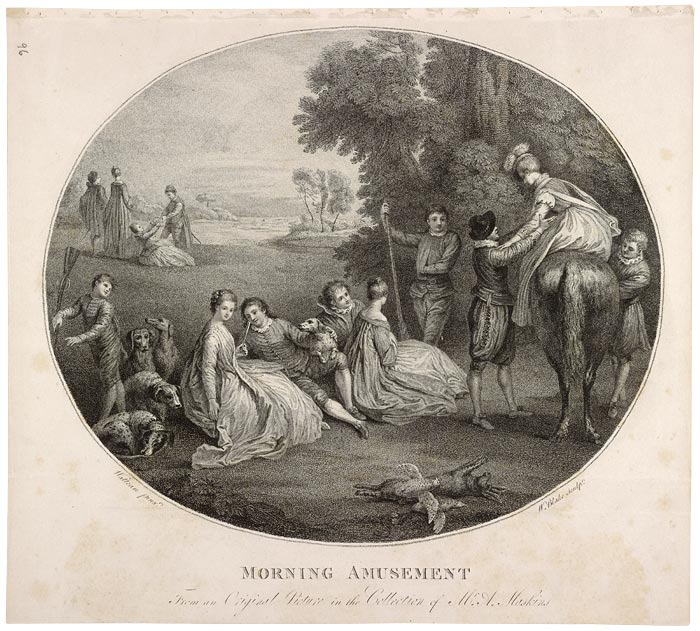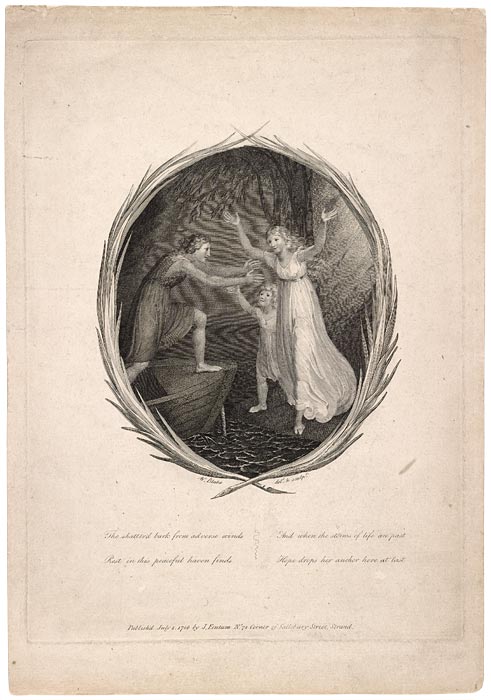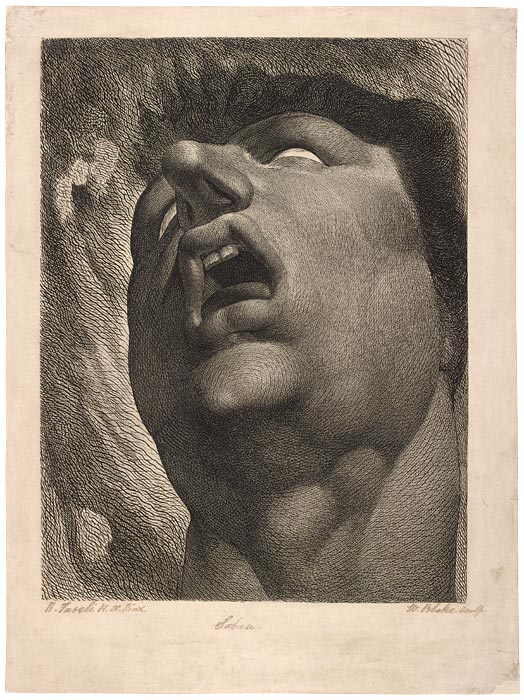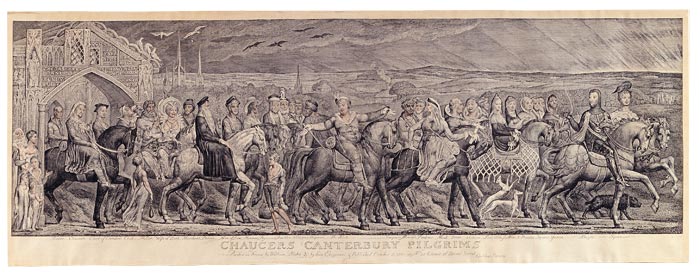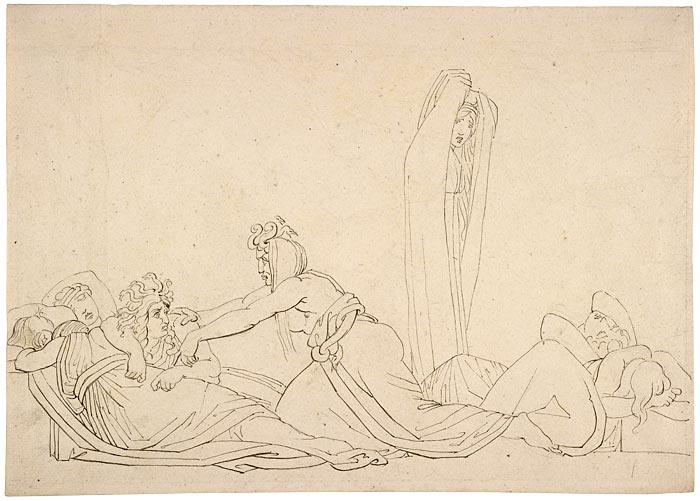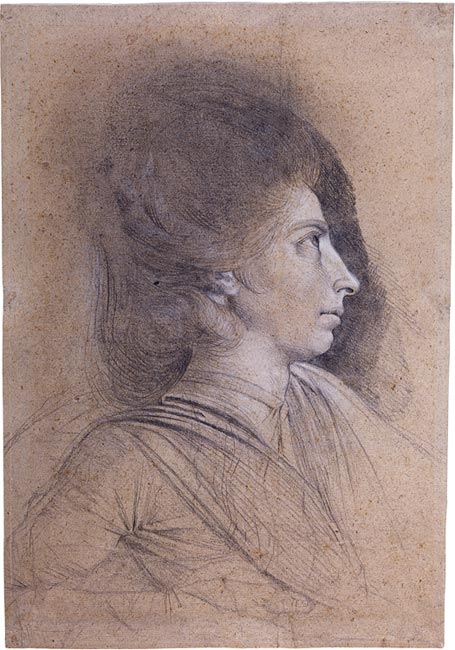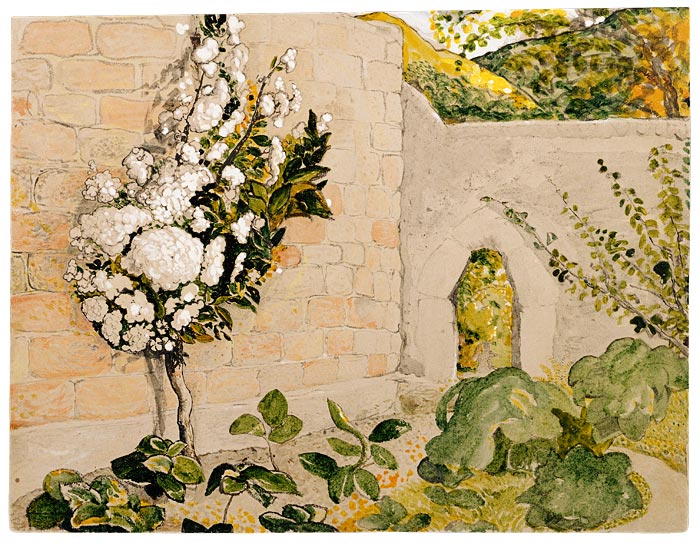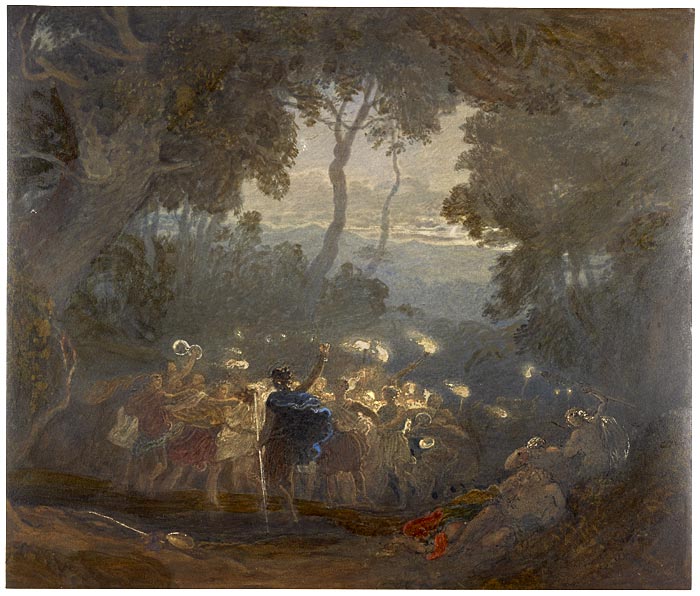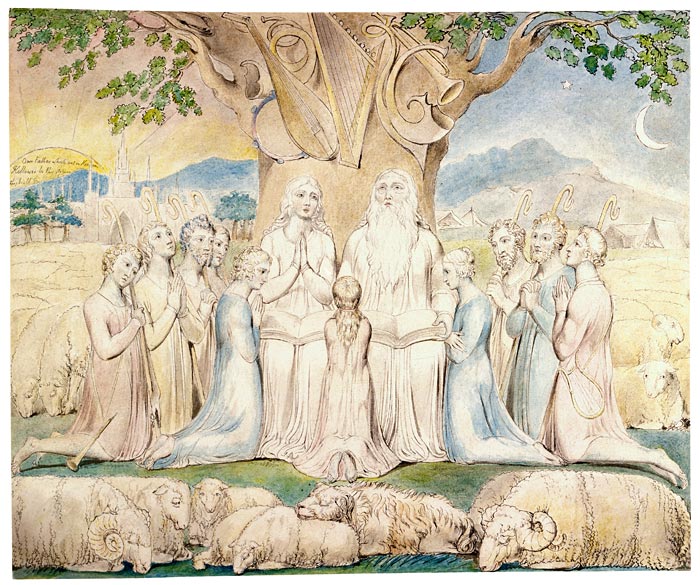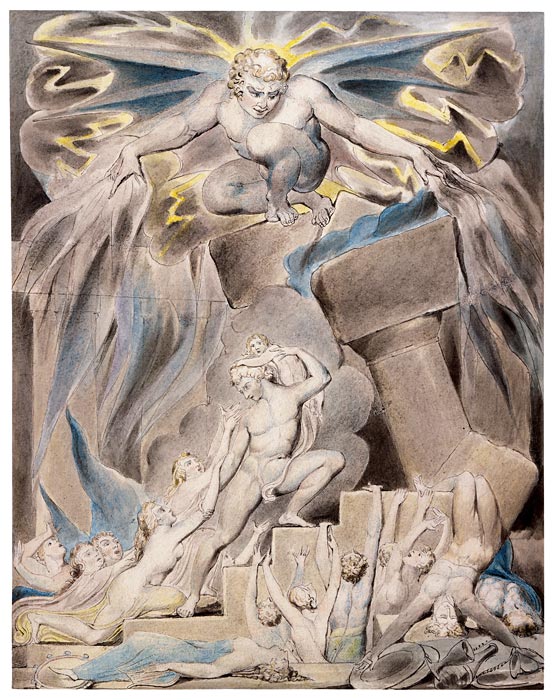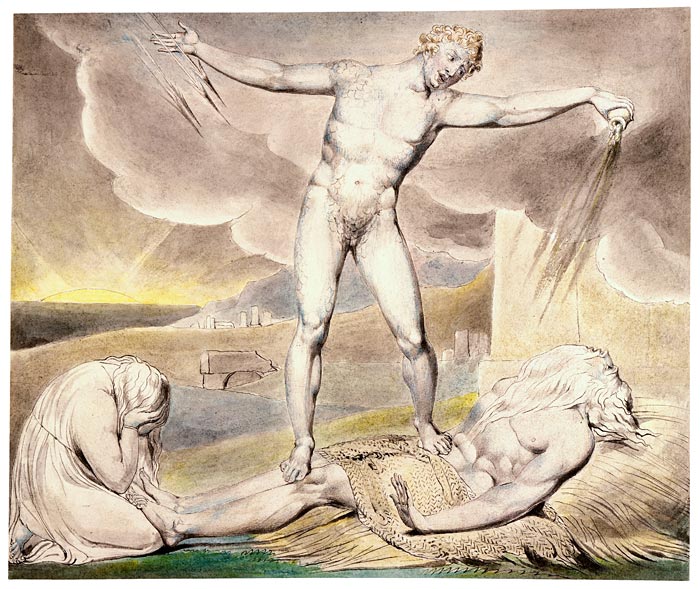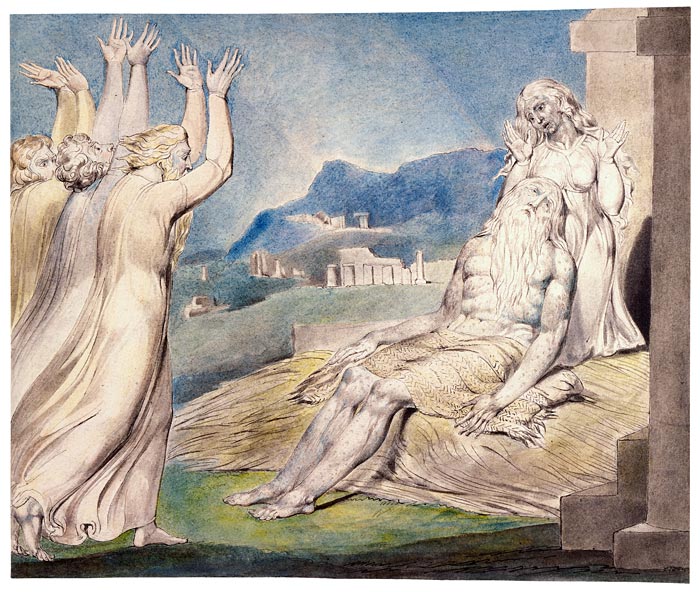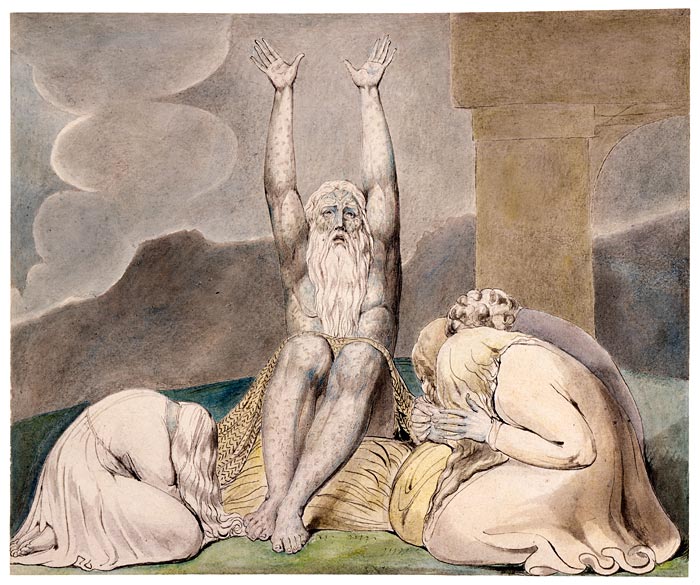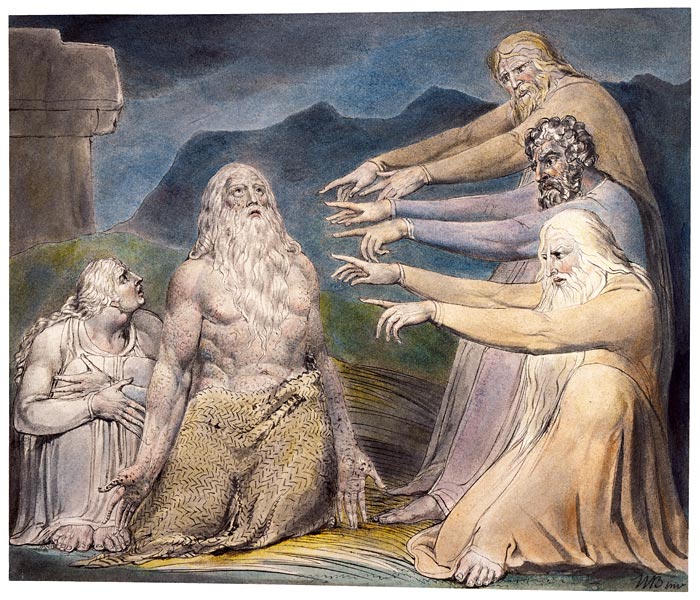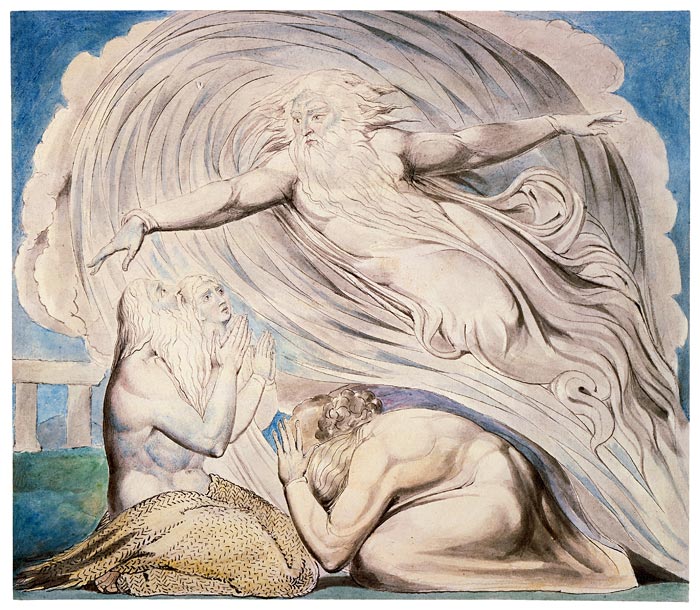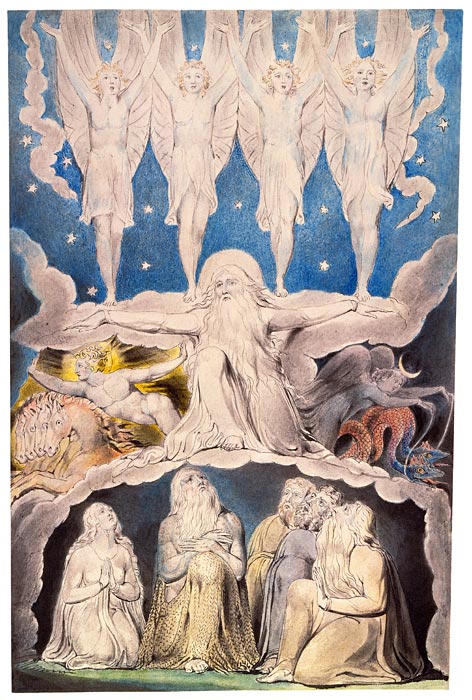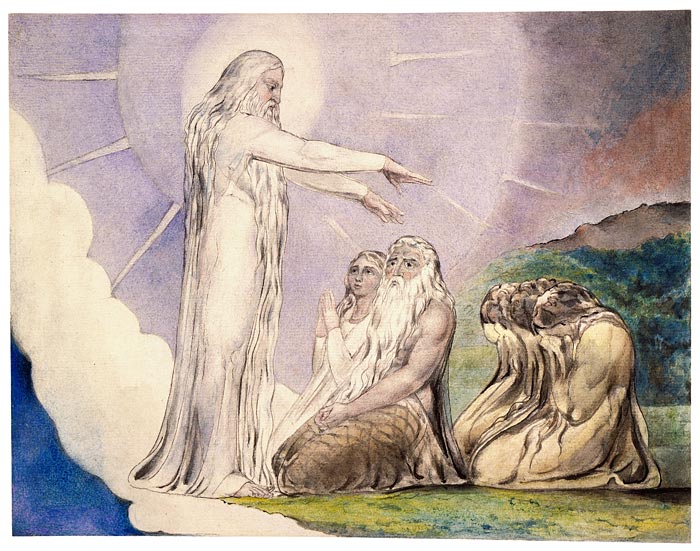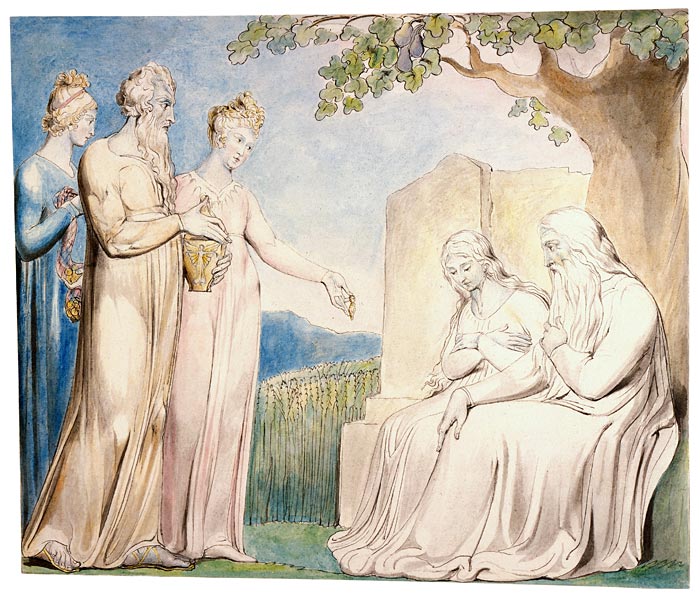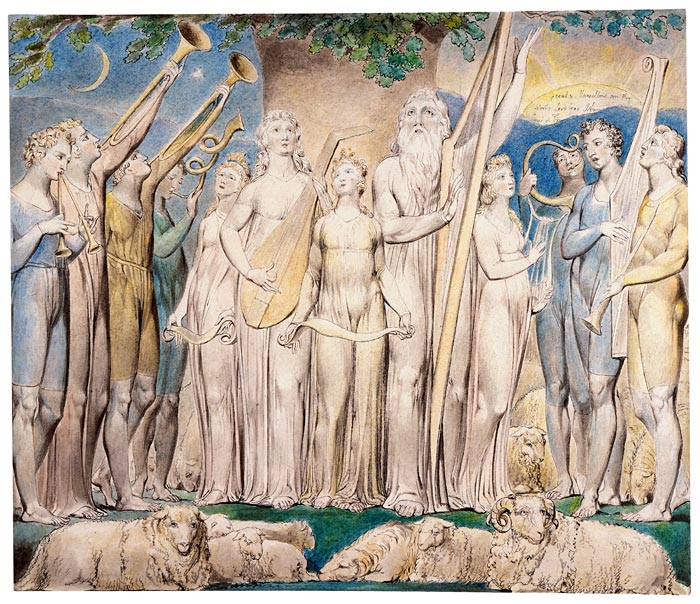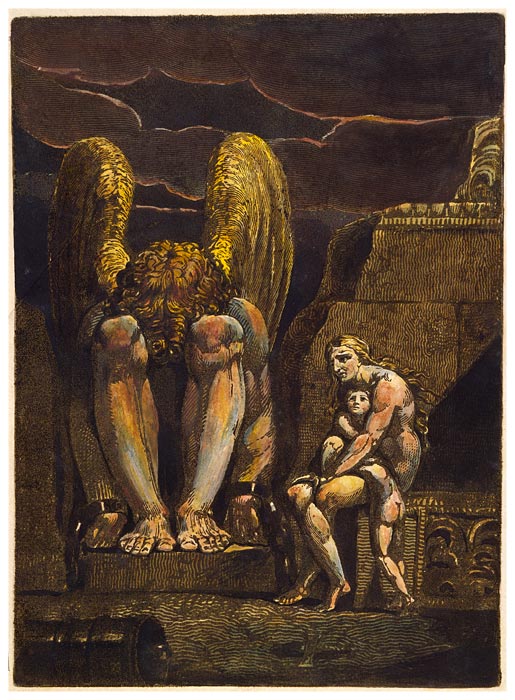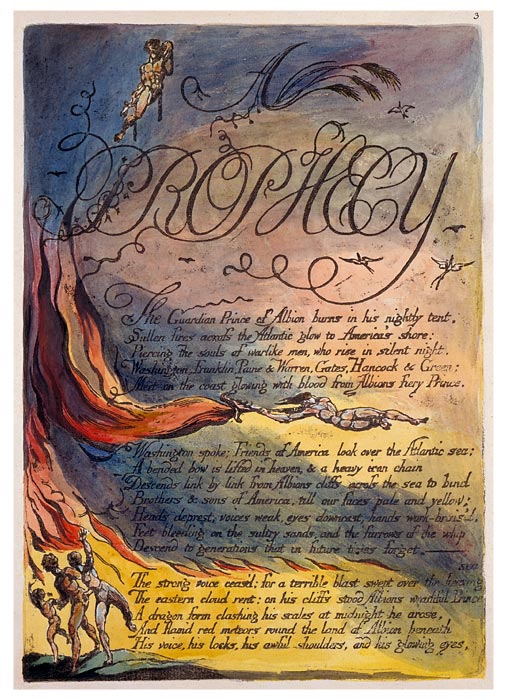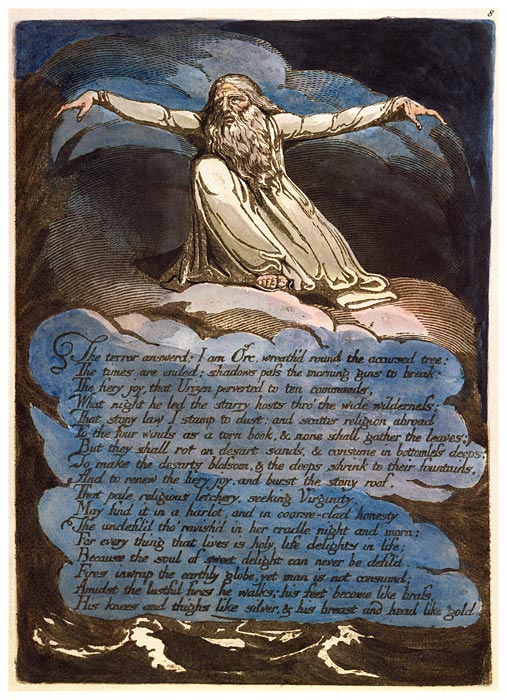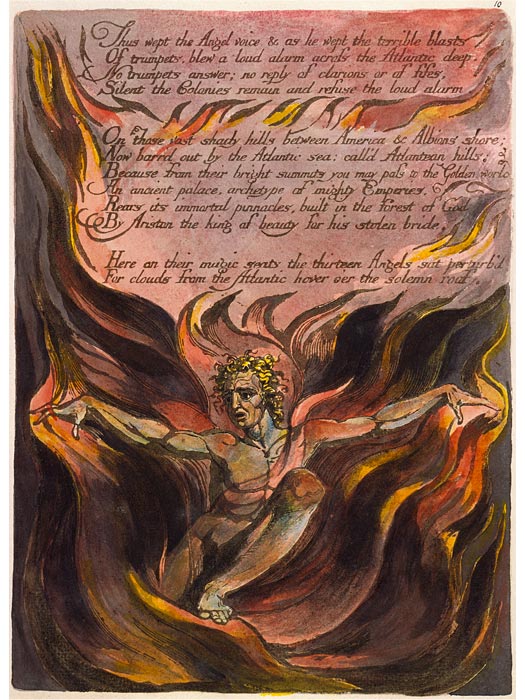William Blake's World: "A New Heaven Is Begun"
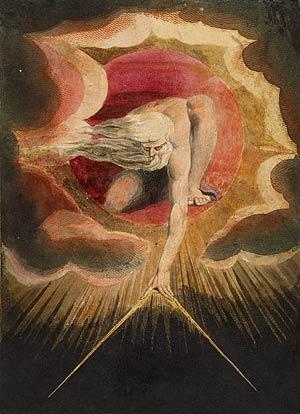
Former director Charles Ryskamp and curator Anna Lou Ashby discuss the Morgan's Blake collection.
"Auguries of Innocence" read by Jeremy Irons »
"The Tyger" read by Jeremy Irons »
Multimedia:
 Collecting William Blake
Collecting William Blake
Former director Charles Ryskamp examines five works from his private collection that he generously donated to the Morgan. All five are on view in the exhibition.
William Blake (1757–1827) occupies a unique place in the history of Western art. His creativity included both the visual and literary arts. In his lifetime he was best known as an engraver; now he is also recognized for his innovative poetry, printmaking, and painting. Blake's keen perception of the political and social climate found expression throughout his work. His strong sense of independence is evident in the complex mythology that he constructed in response to the age of revolution.
Blake was already recognized as an engraver at age twenty-five, when his first volume of poems appeared. At thirty-three, in The Marriage of Heaven and Hell, he audaciously claimed that his birth had marked the origin of a "new heaven" in which his own art would exemplify the creativity prefigured by Milton and Michelangelo. By that time, Blake, in one of his most productive periods, had already produced Songs of Innocence and was at work on a series of illuminated books. In 1818 he met John Linnell, a young painter and engraver, through whom a group of young artists became Blake's followers. Calling themselves the Ancients, they helped perpetuate Blake's influence for generations.
The Morgan's Blake collection—one of this country's most distinguished—began with purchases as early as 1899 by Pierpont Morgan. During the tenure of Charles Ryskamp, director from 1969 to 1986, major gifts almost doubled the size of its Blake holdings. In recent years Ryskamp's own gifts of engravings, letters, and related materials have significantly enriched its scholarly resources.
This online exhibition is presented in conjunction with the exhibition William Blake's World: "A New Heaven Is Begun" on view September 11, 2009, through January 3, 2010.
This exhibition is made possible through the generosity of Fay and Geoffrey Elliott.
Overview
I. Engravings
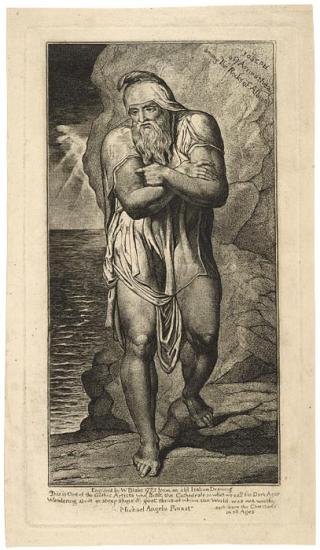
Joseph of Arimathea Among the Rocks of Albion
[London]: Engraved by W. Blake . . . , 1773
Engraving
Second state (of two), ca. 1810–20
Inscribed below the image, Engraved by W Blake 1773 from an old Italian Drawing / This is One of the Gothic Artists who Built the Cathedrals in what we call the Dark Ages / Wandering about in sheep skins & goat skins of whom the World was not worthy / such were the Christians / in all Ages / Michael Angelo Pinxit
Purchased as the gift of the Thorne Family and Fellows Fund in memory of Mrs. Landon K. Thorne, 1976
Joseph of Arimathea––the figure who is supposed to have provided Christ's funeral and perhaps later carried the Holy Grail to England––is the patron saint of gravediggers. His story surely spoke to Blake's interest in early English history and religion. He created this engraving in 1773 while still a sixteen-year-old apprentice to James Basire (1730–1802). This is the reworked state, dating from about 1810, when Blake was in his fifties.
William Blake (1757–1827) occupies a unique place in the history of Western art. His creativity included both the visual and literary arts. In his lifetime he was best known as an engraver; now he is also recognized for his innovative poetry, printmaking, and painting. Blake's keen perception of the political and social climate found expression throughout his work. His strong sense of independence is evident in the complex mythology that he constructed in response to the age of revolution.
Blake was already recognized as an engraver at age twenty-five, when his first volume of poems appeared. At thirty-three, in The Marriage of Heaven and Hell, he audaciously claimed that his birth had marked the origin of a "new heaven" in which his own art would exemplify the creativity prefigured by Milton and Michelangelo. By that time, Blake, in one of his most productive periods, had already produced Songs of Innocence and was at work on a series of illuminated books. In 1818 he met John Linnell, a young painter and engraver, through whom a group of young artists became Blake's followers. Calling themselves the Ancients, they helped perpetuate Blake's influence for generations.
The Morgan's Blake collection—one of this country's most distinguished—began with purchases as early as 1899 by Pierpont Morgan. During the tenure of Charles Ryskamp, director from 1969 to 1986, major gifts almost doubled the size of its Blake holdings. In recent years Ryskamp's own gifts of engravings, letters, and related materials have significantly enriched its scholarly resources.
I. Engravings
William Blake was tutored by his mother, given drawing lessons at the age of ten, and at fifteen apprenticed to James Basire, one of the most prominent engravers of the day. Seven years later, when the apprenticeship was complete, Blake was admitted to study at the Royal Academy. Because of this solid instruction, he was admired for his craftsmanship and often identified as "Mr. Blake, the engraver." Throughout his life, he maintained that engraving was a true art form: "Painting is Drawing on Canvas & Engraving is drawing on Copper & Nothing Else." Blake's prints demonstrate his strong commitment to line, developed through Basire and enhanced by his own creativity. Fortunately his engraver's training would support him, though not well, for the remainder of his life. At forty-six, he wrote, "I curse & bless Engraving alternately because it takes so much time & is so untractable, tho capable of such beauty & perfection."
This online exhibition is presented in conjunction with the exhibition William Blake's World: "A New Heaven Is Begun" on view September 11, 2009, through January 3, 2010.
This exhibition is made possible through the generosity of Fay and Geoffrey Elliott.
Morning Amusement
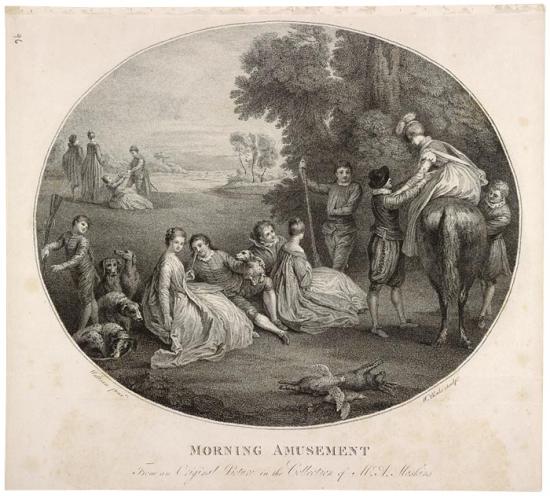
Morning Amusement
Engraving, second state
Inscribed below title, From an Original Picture in the Collection of Mr. A. Maskins.
Imprint: Pubd. August 10th 1782 by Thos. Macklin
No. 39 Fleet Street
Purchased as the gift of the Thorne Family and Fellows Fund in memory of Mrs. Landon K. Thorne, 1976
William Blake (1757–1827) occupies a unique place in the history of Western art. His creativity included both the visual and literary arts. In his lifetime he was best known as an engraver; now he is also recognized for his innovative poetry, printmaking, and painting. Blake's keen perception of the political and social climate found expression throughout his work. His strong sense of independence is evident in the complex mythology that he constructed in response to the age of revolution.
Blake was already recognized as an engraver at age twenty-five, when his first volume of poems appeared. At thirty-three, in The Marriage of Heaven and Hell, he audaciously claimed that his birth had marked the origin of a "new heaven" in which his own art would exemplify the creativity prefigured by Milton and Michelangelo. By that time, Blake, in one of his most productive periods, had already produced Songs of Innocence and was at work on a series of illuminated books. In 1818 he met John Linnell, a young painter and engraver, through whom a group of young artists became Blake's followers. Calling themselves the Ancients, they helped perpetuate Blake's influence for generations.
The Morgan's Blake collection—one of this country's most distinguished—began with purchases as early as 1899 by Pierpont Morgan. During the tenure of Charles Ryskamp, director from 1969 to 1986, major gifts almost doubled the size of its Blake holdings. In recent years Ryskamp's own gifts of engravings, letters, and related materials have significantly enriched its scholarly resources.
I. Engravings
William Blake was tutored by his mother, given drawing lessons at the age of ten, and at fifteen apprenticed to James Basire, one of the most prominent engravers of the day. Seven years later, when the apprenticeship was complete, Blake was admitted to study at the Royal Academy. Because of this solid instruction, he was admired for his craftsmanship and often identified as "Mr. Blake, the engraver." Throughout his life, he maintained that engraving was a true art form: "Painting is Drawing on Canvas & Engraving is drawing on Copper & Nothing Else." Blake's prints demonstrate his strong commitment to line, developed through Basire and enhanced by his own creativity. Fortunately his engraver's training would support him, though not well, for the remainder of his life. At forty-six, he wrote, "I curse & bless Engraving alternately because it takes so much time & is so untractable, tho capable of such beauty & perfection."
This online exhibition is presented in conjunction with the exhibition William Blake's World: "A New Heaven Is Begun" on view September 11, 2009, through January 3, 2010.
This exhibition is made possible through the generosity of Fay and Geoffrey Elliott.
Evening Amusement
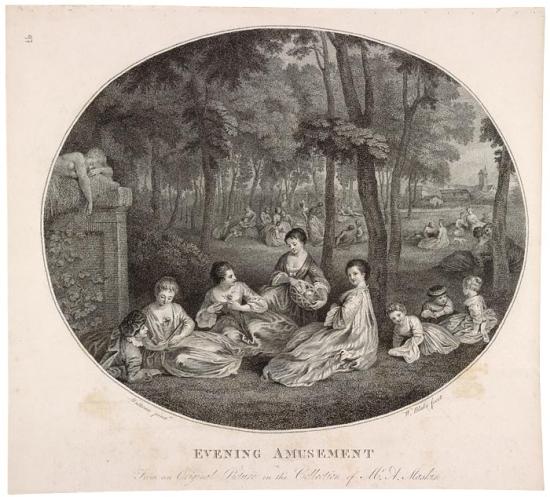
Evening Amusement
Engraving, second state
Imprint: Pubd. as the act directs August 21, 1782 by
T. Macklin, no. 39 Fleet Street
Purchased as the gift of the Thorne Family and Fellows Fund in memory of Mrs. Landon K. Thorne, 1976
Probably modified copies of Le Rendez-vous de Chasse and Les Champs Elysées, these prints were published when Blake was twenty-four years old. They were the first plates created after Blake completed his apprenticeship and demonstrate his great skill as a reproductive engraver. Nevertheless they did not win him commissions for the large print projects of the early nineteenth century. Only seven copies of Morning and six of Evening have been traced.
William Blake (1757–1827) occupies a unique place in the history of Western art. His creativity included both the visual and literary arts. In his lifetime he was best known as an engraver; now he is also recognized for his innovative poetry, printmaking, and painting. Blake's keen perception of the political and social climate found expression throughout his work. His strong sense of independence is evident in the complex mythology that he constructed in response to the age of revolution.
Blake was already recognized as an engraver at age twenty-five, when his first volume of poems appeared. At thirty-three, in The Marriage of Heaven and Hell, he audaciously claimed that his birth had marked the origin of a "new heaven" in which his own art would exemplify the creativity prefigured by Milton and Michelangelo. By that time, Blake, in one of his most productive periods, had already produced Songs of Innocence and was at work on a series of illuminated books. In 1818 he met John Linnell, a young painter and engraver, through whom a group of young artists became Blake's followers. Calling themselves the Ancients, they helped perpetuate Blake's influence for generations.
The Morgan's Blake collection—one of this country's most distinguished—began with purchases as early as 1899 by Pierpont Morgan. During the tenure of Charles Ryskamp, director from 1969 to 1986, major gifts almost doubled the size of its Blake holdings. In recent years Ryskamp's own gifts of engravings, letters, and related materials have significantly enriched its scholarly resources.
I. Engravings
William Blake was tutored by his mother, given drawing lessons at the age of ten, and at fifteen apprenticed to James Basire, one of the most prominent engravers of the day. Seven years later, when the apprenticeship was complete, Blake was admitted to study at the Royal Academy. Because of this solid instruction, he was admired for his craftsmanship and often identified as "Mr. Blake, the engraver." Throughout his life, he maintained that engraving was a true art form: "Painting is Drawing on Canvas & Engraving is drawing on Copper & Nothing Else." Blake's prints demonstrate his strong commitment to line, developed through Basire and enhanced by his own creativity. Fortunately his engraver's training would support him, though not well, for the remainder of his life. At forty-six, he wrote, "I curse & bless Engraving alternately because it takes so much time & is so untractable, tho capable of such beauty & perfection."
This online exhibition is presented in conjunction with the exhibition William Blake's World: "A New Heaven Is Begun" on view September 11, 2009, through January 3, 2010.
This exhibition is made possible through the generosity of Fay and Geoffrey Elliott.
Man Sweeping the Interpreter's Parlour
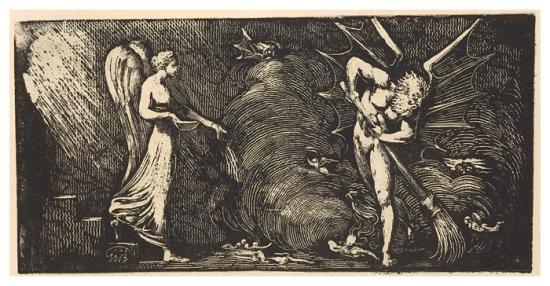
Man Sweeping the Interpreter's Parlour
White-line metalcut, printed in relief
Second state (of two), ca. 1822
Copy 2J
Gift of Mrs. Landon K. Thorne
Blake probably created this metalcut during the first half of the 1820s. This second impression is printed on paper watermarked 1821. It illustrates a story from John Bunyan's Pilgrim's Progress. The man sweeping only stirs up dust, while the woman sprinkles water to settle it and sweeten the room. The Interpreter explains that the parlour represents the heart of man, whose original sin and corruption cannot be settled by the sweeper (the law) but rather can be by the soothing blessing of the woman (the Gospel).
The theme repeats one of Blake's major beliefs that "the Letter Killeth The Spirit giveth Life" (pl. 1 of Job). The Ancients frequently called Blake "the Interpreter."
William Blake (1757–1827) occupies a unique place in the history of Western art. His creativity included both the visual and literary arts. In his lifetime he was best known as an engraver; now he is also recognized for his innovative poetry, printmaking, and painting. Blake's keen perception of the political and social climate found expression throughout his work. His strong sense of independence is evident in the complex mythology that he constructed in response to the age of revolution.
Blake was already recognized as an engraver at age twenty-five, when his first volume of poems appeared. At thirty-three, in The Marriage of Heaven and Hell, he audaciously claimed that his birth had marked the origin of a "new heaven" in which his own art would exemplify the creativity prefigured by Milton and Michelangelo. By that time, Blake, in one of his most productive periods, had already produced Songs of Innocence and was at work on a series of illuminated books. In 1818 he met John Linnell, a young painter and engraver, through whom a group of young artists became Blake's followers. Calling themselves the Ancients, they helped perpetuate Blake's influence for generations.
The Morgan's Blake collection—one of this country's most distinguished—began with purchases as early as 1899 by Pierpont Morgan. During the tenure of Charles Ryskamp, director from 1969 to 1986, major gifts almost doubled the size of its Blake holdings. In recent years Ryskamp's own gifts of engravings, letters, and related materials have significantly enriched its scholarly resources.
I. Engravings
William Blake was tutored by his mother, given drawing lessons at the age of ten, and at fifteen apprenticed to James Basire, one of the most prominent engravers of the day. Seven years later, when the apprenticeship was complete, Blake was admitted to study at the Royal Academy. Because of this solid instruction, he was admired for his craftsmanship and often identified as "Mr. Blake, the engraver." Throughout his life, he maintained that engraving was a true art form: "Painting is Drawing on Canvas & Engraving is drawing on Copper & Nothing Else." Blake's prints demonstrate his strong commitment to line, developed through Basire and enhanced by his own creativity. Fortunately his engraver's training would support him, though not well, for the remainder of his life. At forty-six, he wrote, "I curse & bless Engraving alternately because it takes so much time & is so untractable, tho capable of such beauty & perfection."
This online exhibition is presented in conjunction with the exhibition William Blake's World: "A New Heaven Is Begun" on view September 11, 2009, through January 3, 2010.
This exhibition is made possible through the generosity of Fay and Geoffrey Elliott.
Thomas Commins
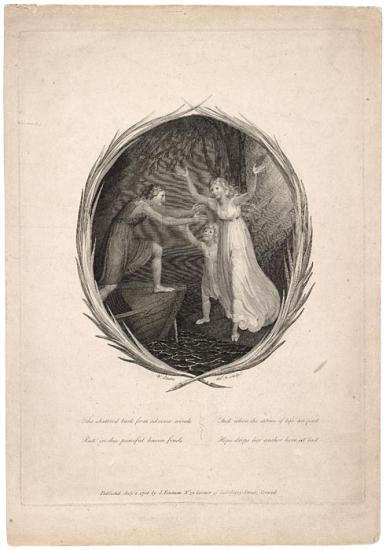
Design for the Cover Leaf of the Sheet Music An Elegy Set to Music by Thomas Commins
[London]: Published by J. Fentum, July 1, 1786
Intaglio copperplate engraving
Inscribed below image, The shatter'd bark from adverse winds / Rest in this peaceful haven finds / And when the storms of life are past / Hope drops her anchor here at last.
Gift of Charles Ryskamp in memory of Michael S. Currier
When he was about twenty-nine years old, Blake designed and engraved this cover leaf for music composed by Thomas Commins (1775–1859), the organist of Penzance, Cornwall. The stanza below the engraving is from the poem "Elegy" by Anne Home Hunter (1742–1821). The engraving depicts a returning sailor lunging into the welcoming arms of his wife and child. Only two or three copies are known.
William Blake (1757–1827) occupies a unique place in the history of Western art. His creativity included both the visual and literary arts. In his lifetime he was best known as an engraver; now he is also recognized for his innovative poetry, printmaking, and painting. Blake's keen perception of the political and social climate found expression throughout his work. His strong sense of independence is evident in the complex mythology that he constructed in response to the age of revolution.
Blake was already recognized as an engraver at age twenty-five, when his first volume of poems appeared. At thirty-three, in The Marriage of Heaven and Hell, he audaciously claimed that his birth had marked the origin of a "new heaven" in which his own art would exemplify the creativity prefigured by Milton and Michelangelo. By that time, Blake, in one of his most productive periods, had already produced Songs of Innocence and was at work on a series of illuminated books. In 1818 he met John Linnell, a young painter and engraver, through whom a group of young artists became Blake's followers. Calling themselves the Ancients, they helped perpetuate Blake's influence for generations.
The Morgan's Blake collection—one of this country's most distinguished—began with purchases as early as 1899 by Pierpont Morgan. During the tenure of Charles Ryskamp, director from 1969 to 1986, major gifts almost doubled the size of its Blake holdings. In recent years Ryskamp's own gifts of engravings, letters, and related materials have significantly enriched its scholarly resources.
I. Engravings
William Blake was tutored by his mother, given drawing lessons at the age of ten, and at fifteen apprenticed to James Basire, one of the most prominent engravers of the day. Seven years later, when the apprenticeship was complete, Blake was admitted to study at the Royal Academy. Because of this solid instruction, he was admired for his craftsmanship and often identified as "Mr. Blake, the engraver." Throughout his life, he maintained that engraving was a true art form: "Painting is Drawing on Canvas & Engraving is drawing on Copper & Nothing Else." Blake's prints demonstrate his strong commitment to line, developed through Basire and enhanced by his own creativity. Fortunately his engraver's training would support him, though not well, for the remainder of his life. At forty-six, he wrote, "I curse & bless Engraving alternately because it takes so much time & is so untractable, tho capable of such beauty & perfection."
This online exhibition is presented in conjunction with the exhibition William Blake's World: "A New Heaven Is Begun" on view September 11, 2009, through January 3, 2010.
This exhibition is made possible through the generosity of Fay and Geoffrey Elliott.
Satan
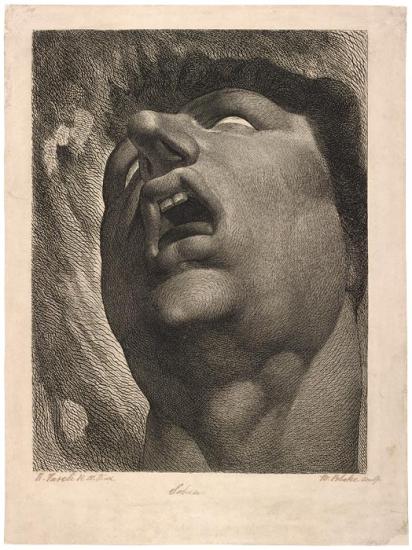
Satan
Inscribed below in pen and ink, H. Fuseli R. A. Pi Satan W. Blake sculp.
Gift of Charles Ryskamp in memory of Sir Geoffrey Keynes
This hideous head of a man howling in torment is also known as "Head of a Damned Soul in Dante's Inferno." Impressions of the print are very rare—only five known proofs of a single state are extant—and the general lack of lettering on known examples suggests that the print was never properly published.
Blake likely executed this large-scale print ca. 1790 as an experiment to entertain his friend Henry Fuseli. This copy once belonged to the great Blake scholar Sir Geoffrey Keynes (1887–1982), who gave it to his friend Charles Ryskamp.
William Blake (1757–1827) occupies a unique place in the history of Western art. His creativity included both the visual and literary arts. In his lifetime he was best known as an engraver; now he is also recognized for his innovative poetry, printmaking, and painting. Blake's keen perception of the political and social climate found expression throughout his work. His strong sense of independence is evident in the complex mythology that he constructed in response to the age of revolution.
Blake was already recognized as an engraver at age twenty-five, when his first volume of poems appeared. At thirty-three, in The Marriage of Heaven and Hell, he audaciously claimed that his birth had marked the origin of a "new heaven" in which his own art would exemplify the creativity prefigured by Milton and Michelangelo. By that time, Blake, in one of his most productive periods, had already produced Songs of Innocence and was at work on a series of illuminated books. In 1818 he met John Linnell, a young painter and engraver, through whom a group of young artists became Blake's followers. Calling themselves the Ancients, they helped perpetuate Blake's influence for generations.
The Morgan's Blake collection—one of this country's most distinguished—began with purchases as early as 1899 by Pierpont Morgan. During the tenure of Charles Ryskamp, director from 1969 to 1986, major gifts almost doubled the size of its Blake holdings. In recent years Ryskamp's own gifts of engravings, letters, and related materials have significantly enriched its scholarly resources.
I. Engravings
William Blake was tutored by his mother, given drawing lessons at the age of ten, and at fifteen apprenticed to James Basire, one of the most prominent engravers of the day. Seven years later, when the apprenticeship was complete, Blake was admitted to study at the Royal Academy. Because of this solid instruction, he was admired for his craftsmanship and often identified as "Mr. Blake, the engraver." Throughout his life, he maintained that engraving was a true art form: "Painting is Drawing on Canvas & Engraving is drawing on Copper & Nothing Else." Blake's prints demonstrate his strong commitment to line, developed through Basire and enhanced by his own creativity. Fortunately his engraver's training would support him, though not well, for the remainder of his life. At forty-six, he wrote, "I curse & bless Engraving alternately because it takes so much time & is so untractable, tho capable of such beauty & perfection."
This online exhibition is presented in conjunction with the exhibition William Blake's World: "A New Heaven Is Begun" on view September 11, 2009, through January 3, 2010.
This exhibition is made possible through the generosity of Fay and Geoffrey Elliott.
Chaucer's Canterbury Pilgrims
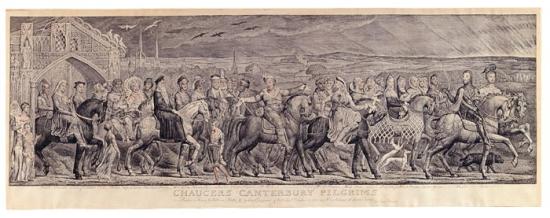
Chaucer's Canterbury Pilgrims
Copper engraving, with additions in watercolor by the artist
Third state, 1810–20
Copy 3P
Signature and imprint, Painted in Fresco by William Blake & by him Engraved & Published October 8. 1810, at No 28. Corner of Broad Street Golden Square; inscribed below: Chaucers Canterbury Pilgrims, and with the names of the pilgrims, Reeve, Chaucer, Clerk of Oxenford, Cook, Miller, Wife of Bath, Merchant, Parson, Man of Law, Plowman, Physician, Franklin, 2 Citizens, Shipman, The Host, Sompnour, Manciple, Pardoner, Monk, Friar, a Citizen, Lady Abbess, Nun, 3 Priests, Squires, Yeoman, Knight, Squire.
Gift of Charles Ryskamp in memory of Grace Lansing Lambert
This is a magnificent example of Blake's largest print, one of only three known impressions to which he added watercolor. The engraving is known in five states, and the present sheet is the only hand-colored example of the third state of the image. Blake's use of line engraving, emulating the styles of early printmakers Albrecht Dürer and Lucas van Leyden, evokes the character of Chaucer's poetry.
Blake painted the pilgrims after a quarrel with R. H. Cromek and Thomas Stothard regarding whether the commission had originally been Blake's. The painting was exhibited at his brother's Soho shop in 1809, and this engraving was created from it.
William Blake (1757–1827) occupies a unique place in the history of Western art. His creativity included both the visual and literary arts. In his lifetime he was best known as an engraver; now he is also recognized for his innovative poetry, printmaking, and painting. Blake's keen perception of the political and social climate found expression throughout his work. His strong sense of independence is evident in the complex mythology that he constructed in response to the age of revolution.
Blake was already recognized as an engraver at age twenty-five, when his first volume of poems appeared. At thirty-three, in The Marriage of Heaven and Hell, he audaciously claimed that his birth had marked the origin of a "new heaven" in which his own art would exemplify the creativity prefigured by Milton and Michelangelo. By that time, Blake, in one of his most productive periods, had already produced Songs of Innocence and was at work on a series of illuminated books. In 1818 he met John Linnell, a young painter and engraver, through whom a group of young artists became Blake's followers. Calling themselves the Ancients, they helped perpetuate Blake's influence for generations.
The Morgan's Blake collection—one of this country's most distinguished—began with purchases as early as 1899 by Pierpont Morgan. During the tenure of Charles Ryskamp, director from 1969 to 1986, major gifts almost doubled the size of its Blake holdings. In recent years Ryskamp's own gifts of engravings, letters, and related materials have significantly enriched its scholarly resources.
I. Engravings
William Blake was tutored by his mother, given drawing lessons at the age of ten, and at fifteen apprenticed to James Basire, one of the most prominent engravers of the day. Seven years later, when the apprenticeship was complete, Blake was admitted to study at the Royal Academy. Because of this solid instruction, he was admired for his craftsmanship and often identified as "Mr. Blake, the engraver." Throughout his life, he maintained that engraving was a true art form: "Painting is Drawing on Canvas & Engraving is drawing on Copper & Nothing Else." Blake's prints demonstrate his strong commitment to line, developed through Basire and enhanced by his own creativity. Fortunately his engraver's training would support him, though not well, for the remainder of his life. At forty-six, he wrote, "I curse & bless Engraving alternately because it takes so much time & is so untractable, tho capable of such beauty & perfection."
This online exhibition is presented in conjunction with the exhibition William Blake's World: "A New Heaven Is Begun" on view September 11, 2009, through January 3, 2010.
This exhibition is made possible through the generosity of Fay and Geoffrey Elliott.
Portrait of Wilson Lowry
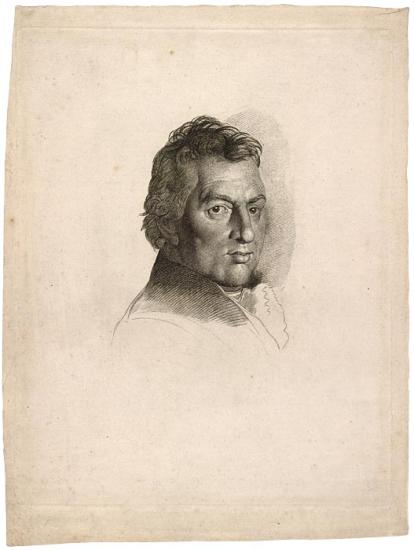
Portrait of Wilson Lowry
Engraving with traces of graphite
Second state (of five), 1824–25
Gift of Charles Ryskamp in memory of Michael S. Currier
This portrait––one of only two impressions of this second state––depicts Wilson Lowry (1762–1824), a British engraver and illustrator who developed several printing innovations, including the corrosive solution used to etch lines into steel plates. The inscription on the fourth state reads Drawn from Life by J. Linnell, & Engraved by J. Linnell, & W. Blake. By the time that Blake was at work on his Job engravings, he had acquired many of Linnell's engraving techniques, so their styles meshed smoothly. The traces of graphite might indicate Blake's corrections for a subsequent state.
William Blake (1757–1827) occupies a unique place in the history of Western art. His creativity included both the visual and literary arts. In his lifetime he was best known as an engraver; now he is also recognized for his innovative poetry, printmaking, and painting. Blake's keen perception of the political and social climate found expression throughout his work. His strong sense of independence is evident in the complex mythology that he constructed in response to the age of revolution.
Blake was already recognized as an engraver at age twenty-five, when his first volume of poems appeared. At thirty-three, in The Marriage of Heaven and Hell, he audaciously claimed that his birth had marked the origin of a "new heaven" in which his own art would exemplify the creativity prefigured by Milton and Michelangelo. By that time, Blake, in one of his most productive periods, had already produced Songs of Innocence and was at work on a series of illuminated books. In 1818 he met John Linnell, a young painter and engraver, through whom a group of young artists became Blake's followers. Calling themselves the Ancients, they helped perpetuate Blake's influence for generations.
The Morgan's Blake collection—one of this country's most distinguished—began with purchases as early as 1899 by Pierpont Morgan. During the tenure of Charles Ryskamp, director from 1969 to 1986, major gifts almost doubled the size of its Blake holdings. In recent years Ryskamp's own gifts of engravings, letters, and related materials have significantly enriched its scholarly resources.
I. Engravings
William Blake was tutored by his mother, given drawing lessons at the age of ten, and at fifteen apprenticed to James Basire, one of the most prominent engravers of the day. Seven years later, when the apprenticeship was complete, Blake was admitted to study at the Royal Academy. Because of this solid instruction, he was admired for his craftsmanship and often identified as "Mr. Blake, the engraver." Throughout his life, he maintained that engraving was a true art form: "Painting is Drawing on Canvas & Engraving is drawing on Copper & Nothing Else." Blake's prints demonstrate his strong commitment to line, developed through Basire and enhanced by his own creativity. Fortunately his engraver's training would support him, though not well, for the remainder of his life. At forty-six, he wrote, "I curse & bless Engraving alternately because it takes so much time & is so untractable, tho capable of such beauty & perfection."
This online exhibition is presented in conjunction with the exhibition William Blake's World: "A New Heaven Is Begun" on view September 11, 2009, through January 3, 2010.
This exhibition is made possible through the generosity of Fay and Geoffrey Elliott.
II. Friends and Followers
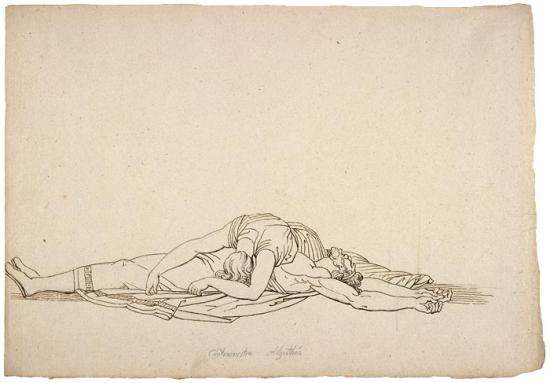
"Awake, arise, rouse her as I rose thee. The Furies"
Gift of Louise Crane in memory of her mother, Mrs. W. Murray Crane
Flaxman received a commission to illustrate Homer's Iliad and Odyssey while in Rome in 1792. Shortly thereafter he received another commission to illustrate the works of Aeschylus, which were engraved by Thomas Piroli and published in 1795, after Flaxman's return to London. The present design illustrates a scene from Clytemnestra, with the heroine mourning the death of Aegisthus.
Flaxman's crisply linear illustrations achieved international acclaim. Artist George Romney described them as "outlines without shadow, but in the style of ancient art. They are simple, grand, and pure."
William Blake (1757–1827) occupies a unique place in the history of Western art. His creativity included both the visual and literary arts. In his lifetime he was best known as an engraver; now he is also recognized for his innovative poetry, printmaking, and painting. Blake's keen perception of the political and social climate found expression throughout his work. His strong sense of independence is evident in the complex mythology that he constructed in response to the age of revolution.
Blake was already recognized as an engraver at age twenty-five, when his first volume of poems appeared. At thirty-three, in The Marriage of Heaven and Hell, he audaciously claimed that his birth had marked the origin of a "new heaven" in which his own art would exemplify the creativity prefigured by Milton and Michelangelo. By that time, Blake, in one of his most productive periods, had already produced Songs of Innocence and was at work on a series of illuminated books. In 1818 he met John Linnell, a young painter and engraver, through whom a group of young artists became Blake's followers. Calling themselves the Ancients, they helped perpetuate Blake's influence for generations.
The Morgan's Blake collection—one of this country's most distinguished—began with purchases as early as 1899 by Pierpont Morgan. During the tenure of Charles Ryskamp, director from 1969 to 1986, major gifts almost doubled the size of its Blake holdings. In recent years Ryskamp's own gifts of engravings, letters, and related materials have significantly enriched its scholarly resources.
II. Friends and Followers
Among Blake's early friends were professors and other students at the Royal Academy, many of whom became leading figures of the age. He frequently engraved works by Thomas Stothard, Henry Fuseli, and John Flaxman, for example, as will be seen in this gallery. In his day Blake was more widely esteemed as a fine engraver than as a painter, his own imaginative work having been produced primarily on speculation or for patrons. Only nine years before Blake's death, the young artist John Linnell (1792–1882) became both a patron and friend. Through him Blake became acquainted with several youthful artists who came to call themselves the Ancients, after Blake's frequent reference to earlier artists as "ancients." They were inspired by Blake's imaginative spirit and his love for the art of Michelangelo as well as for the poetry of Milton. These men––Edward Calvert, Samuel Palmer, George Richmond, Francis Oliver Finch, George Cumberland, Frederick Tatham, and Henry Walter––are represented in the Morgan's collections.
This online exhibition is presented in conjunction with the exhibition William Blake's World: "A New Heaven Is Begun" on view September 11, 2009, through January 3, 2010.
This exhibition is made possible through the generosity of Fay and Geoffrey Elliott.
John Flaxman
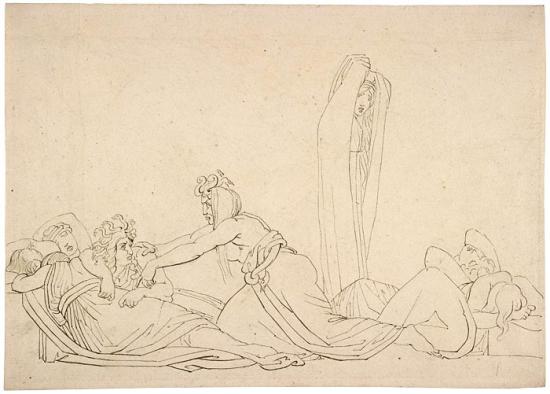
"Behold this proud oppressor of my country; Choephora"
Inscribed at lower center in graphite, Clÿtemnestra and Aegisthus.
Gift of Louise Crane in memory of her mother, Mrs. W. Murray Crane
Flaxman received a commission to illustrate Homer's Iliad and Odyssey while in Rome in 1792. Shortly thereafter he received another commission to illustrate the works of Aeschylus, which were engraved by Thomas Piroli and published in 1795, after Flaxman's return to London. The present design illustrates a scene from Clytemnestra, with the heroine mourning the death of Aegisthus.
Flaxman's crisply linear illustrations achieved international acclaim. Artist George Romney described them as "outlines without shadow, but in the style of ancient art. They are simple, grand, and pure."
William Blake (1757–1827) occupies a unique place in the history of Western art. His creativity included both the visual and literary arts. In his lifetime he was best known as an engraver; now he is also recognized for his innovative poetry, printmaking, and painting. Blake's keen perception of the political and social climate found expression throughout his work. His strong sense of independence is evident in the complex mythology that he constructed in response to the age of revolution.
Blake was already recognized as an engraver at age twenty-five, when his first volume of poems appeared. At thirty-three, in The Marriage of Heaven and Hell, he audaciously claimed that his birth had marked the origin of a "new heaven" in which his own art would exemplify the creativity prefigured by Milton and Michelangelo. By that time, Blake, in one of his most productive periods, had already produced Songs of Innocence and was at work on a series of illuminated books. In 1818 he met John Linnell, a young painter and engraver, through whom a group of young artists became Blake's followers. Calling themselves the Ancients, they helped perpetuate Blake's influence for generations.
The Morgan's Blake collection—one of this country's most distinguished—began with purchases as early as 1899 by Pierpont Morgan. During the tenure of Charles Ryskamp, director from 1969 to 1986, major gifts almost doubled the size of its Blake holdings. In recent years Ryskamp's own gifts of engravings, letters, and related materials have significantly enriched its scholarly resources.
II. Friends and Followers
Among Blake's early friends were professors and other students at the Royal Academy, many of whom became leading figures of the age. He frequently engraved works by Thomas Stothard, Henry Fuseli, and John Flaxman, for example, as will be seen in this gallery. In his day Blake was more widely esteemed as a fine engraver than as a painter, his own imaginative work having been produced primarily on speculation or for patrons. Only nine years before Blake's death, the young artist John Linnell (1792–1882) became both a patron and friend. Through him Blake became acquainted with several youthful artists who came to call themselves the Ancients, after Blake's frequent reference to earlier artists as "ancients." They were inspired by Blake's imaginative spirit and his love for the art of Michelangelo as well as for the poetry of Milton. These men––Edward Calvert, Samuel Palmer, George Richmond, Francis Oliver Finch, George Cumberland, Frederick Tatham, and Henry Walter––are represented in the Morgan's collections.
This online exhibition is presented in conjunction with the exhibition William Blake's World: "A New Heaven Is Begun" on view September 11, 2009, through January 3, 2010.
This exhibition is made possible through the generosity of Fay and Geoffrey Elliott.
Thomas Stothard
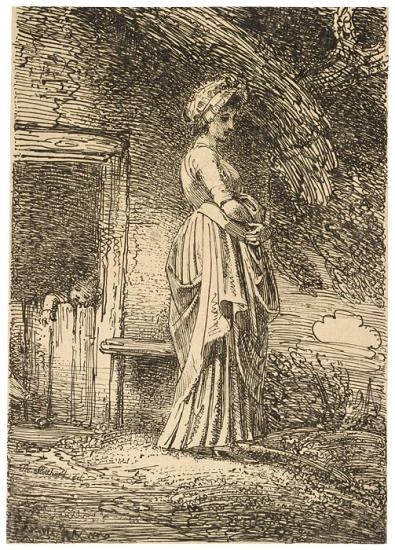
The Lost Apple from Specimens of Polyautography
London: Published . . . by P. Andre, [April 1803]
Gift of Paul Mellon, 1979
Perhaps the most prolific book illustrator of the period, Stothard had apprenticed as a fabric pattern designer. He, Blake, Flaxman, and Cumberland frequently sketched together in their youth. During the period from 1782 to 1783, Blake engraved twenty-eight plates after Stothard's designs. Important in its own right, The Lost Apple is one of the first, small group of illustrations by English artists using the new technology of lithography.
William Blake (1757–1827) occupies a unique place in the history of Western art. His creativity included both the visual and literary arts. In his lifetime he was best known as an engraver; now he is also recognized for his innovative poetry, printmaking, and painting. Blake's keen perception of the political and social climate found expression throughout his work. His strong sense of independence is evident in the complex mythology that he constructed in response to the age of revolution.
Blake was already recognized as an engraver at age twenty-five, when his first volume of poems appeared. At thirty-three, in The Marriage of Heaven and Hell, he audaciously claimed that his birth had marked the origin of a "new heaven" in which his own art would exemplify the creativity prefigured by Milton and Michelangelo. By that time, Blake, in one of his most productive periods, had already produced Songs of Innocence and was at work on a series of illuminated books. In 1818 he met John Linnell, a young painter and engraver, through whom a group of young artists became Blake's followers. Calling themselves the Ancients, they helped perpetuate Blake's influence for generations.
The Morgan's Blake collection—one of this country's most distinguished—began with purchases as early as 1899 by Pierpont Morgan. During the tenure of Charles Ryskamp, director from 1969 to 1986, major gifts almost doubled the size of its Blake holdings. In recent years Ryskamp's own gifts of engravings, letters, and related materials have significantly enriched its scholarly resources.
II. Friends and Followers
Among Blake's early friends were professors and other students at the Royal Academy, many of whom became leading figures of the age. He frequently engraved works by Thomas Stothard, Henry Fuseli, and John Flaxman, for example, as will be seen in this gallery. In his day Blake was more widely esteemed as a fine engraver than as a painter, his own imaginative work having been produced primarily on speculation or for patrons. Only nine years before Blake's death, the young artist John Linnell (1792–1882) became both a patron and friend. Through him Blake became acquainted with several youthful artists who came to call themselves the Ancients, after Blake's frequent reference to earlier artists as "ancients." They were inspired by Blake's imaginative spirit and his love for the art of Michelangelo as well as for the poetry of Milton. These men––Edward Calvert, Samuel Palmer, George Richmond, Francis Oliver Finch, George Cumberland, Frederick Tatham, and Henry Walter––are represented in the Morgan's collections.
This online exhibition is presented in conjunction with the exhibition William Blake's World: "A New Heaven Is Begun" on view September 11, 2009, through January 3, 2010.
This exhibition is made possible through the generosity of Fay and Geoffrey Elliott.
Henry Fuseli
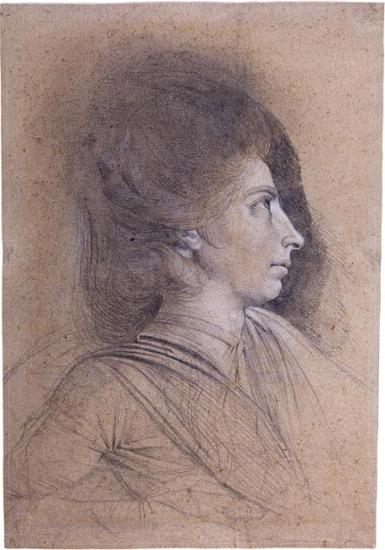
Portrait of Martha Hess, ca. 1778–79
Purchased as the gift of Mrs. W. Murray Crane
Fuseli, who left Switzerland in 1763, returned to his native Zurich only once for a six-month visit in 1778–79. It was during this period that he executed this portrait of Martha Hess, a niece of the artist's friend Johann Kaspar Lavater (1741–1801). Lavater, a scientist and philosopher, eventually incorporated some of Fuseli's drawings of Martha and her sister, Magdalena, and four plates engraved by Blake to illustrate his Essays on Physiognomy. Fuseli was attracted to Martha, who was described as "ethereal" and "inclined toward religious fanaticism." Shortly after she posed for the artist, Martha died from consumption in December 1779.
William Blake (1757–1827) occupies a unique place in the history of Western art. His creativity included both the visual and literary arts. In his lifetime he was best known as an engraver; now he is also recognized for his innovative poetry, printmaking, and painting. Blake's keen perception of the political and social climate found expression throughout his work. His strong sense of independence is evident in the complex mythology that he constructed in response to the age of revolution.
Blake was already recognized as an engraver at age twenty-five, when his first volume of poems appeared. At thirty-three, in The Marriage of Heaven and Hell, he audaciously claimed that his birth had marked the origin of a "new heaven" in which his own art would exemplify the creativity prefigured by Milton and Michelangelo. By that time, Blake, in one of his most productive periods, had already produced Songs of Innocence and was at work on a series of illuminated books. In 1818 he met John Linnell, a young painter and engraver, through whom a group of young artists became Blake's followers. Calling themselves the Ancients, they helped perpetuate Blake's influence for generations.
The Morgan's Blake collection—one of this country's most distinguished—began with purchases as early as 1899 by Pierpont Morgan. During the tenure of Charles Ryskamp, director from 1969 to 1986, major gifts almost doubled the size of its Blake holdings. In recent years Ryskamp's own gifts of engravings, letters, and related materials have significantly enriched its scholarly resources.
II. Friends and Followers
Among Blake's early friends were professors and other students at the Royal Academy, many of whom became leading figures of the age. He frequently engraved works by Thomas Stothard, Henry Fuseli, and John Flaxman, for example, as will be seen in this gallery. In his day Blake was more widely esteemed as a fine engraver than as a painter, his own imaginative work having been produced primarily on speculation or for patrons. Only nine years before Blake's death, the young artist John Linnell (1792–1882) became both a patron and friend. Through him Blake became acquainted with several youthful artists who came to call themselves the Ancients, after Blake's frequent reference to earlier artists as "ancients." They were inspired by Blake's imaginative spirit and his love for the art of Michelangelo as well as for the poetry of Milton. These men––Edward Calvert, Samuel Palmer, George Richmond, Francis Oliver Finch, George Cumberland, Frederick Tatham, and Henry Walter––are represented in the Morgan's collections.
This online exhibition is presented in conjunction with the exhibition William Blake's World: "A New Heaven Is Begun" on view September 11, 2009, through January 3, 2010.
This exhibition is made possible through the generosity of Fay and Geoffrey Elliott.
Henry Fuseli
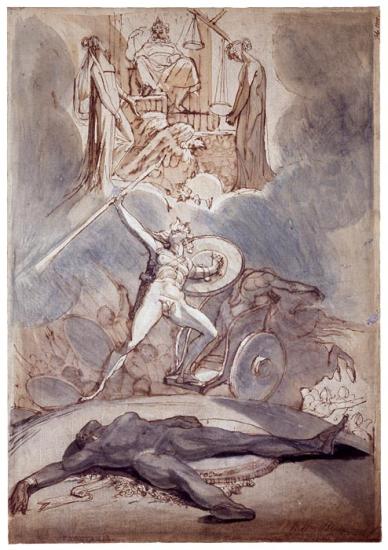
Psychostasy (The Weighing of Souls), 1800
Inscribed at upper right corner in pen and brown ink, Febr. 1800; along with lower margin, PSYCHOSTASIA; perne stratarchou Aidiopon athobon—Memnona Chalkoaran.
Gift of Louise Crane in memory of her mother, Mrs. W. Murray Crane
Based on ancient sources, including Pindar and Plutarch, Psychostasy depicts Achilles as he wages battle in the Trojan War. Achilles gestures victoriously toward Jupiter above, who weighs the warriors' souls. In the foreground, the naked body of the slain Ethiopian king Memnon lies on his upturned shield. This drawing is preparatory for Fuseli's painting of the subject, now lost, commissioned by Sir Thomas Lawrence and exhibited at the Royal Academy in 1803.
William Blake (1757–1827) occupies a unique place in the history of Western art. His creativity included both the visual and literary arts. In his lifetime he was best known as an engraver; now he is also recognized for his innovative poetry, printmaking, and painting. Blake's keen perception of the political and social climate found expression throughout his work. His strong sense of independence is evident in the complex mythology that he constructed in response to the age of revolution.
Blake was already recognized as an engraver at age twenty-five, when his first volume of poems appeared. At thirty-three, in The Marriage of Heaven and Hell, he audaciously claimed that his birth had marked the origin of a "new heaven" in which his own art would exemplify the creativity prefigured by Milton and Michelangelo. By that time, Blake, in one of his most productive periods, had already produced Songs of Innocence and was at work on a series of illuminated books. In 1818 he met John Linnell, a young painter and engraver, through whom a group of young artists became Blake's followers. Calling themselves the Ancients, they helped perpetuate Blake's influence for generations.
The Morgan's Blake collection—one of this country's most distinguished—began with purchases as early as 1899 by Pierpont Morgan. During the tenure of Charles Ryskamp, director from 1969 to 1986, major gifts almost doubled the size of its Blake holdings. In recent years Ryskamp's own gifts of engravings, letters, and related materials have significantly enriched its scholarly resources.
II. Friends and Followers
Among Blake's early friends were professors and other students at the Royal Academy, many of whom became leading figures of the age. He frequently engraved works by Thomas Stothard, Henry Fuseli, and John Flaxman, for example, as will be seen in this gallery. In his day Blake was more widely esteemed as a fine engraver than as a painter, his own imaginative work having been produced primarily on speculation or for patrons. Only nine years before Blake's death, the young artist John Linnell (1792–1882) became both a patron and friend. Through him Blake became acquainted with several youthful artists who came to call themselves the Ancients, after Blake's frequent reference to earlier artists as "ancients." They were inspired by Blake's imaginative spirit and his love for the art of Michelangelo as well as for the poetry of Milton. These men––Edward Calvert, Samuel Palmer, George Richmond, Francis Oliver Finch, George Cumberland, Frederick Tatham, and Henry Walter––are represented in the Morgan's collections.
This online exhibition is presented in conjunction with the exhibition William Blake's World: "A New Heaven Is Begun" on view September 11, 2009, through January 3, 2010.
This exhibition is made possible through the generosity of Fay and Geoffrey Elliott.
Samuel Palmer
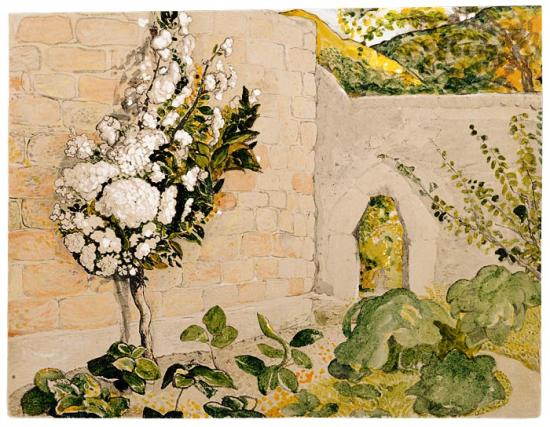
Pear Tree in a Walled Garden
The Thaw Collection, Pierpont Morgan Library
Palmer moved to the village of Shoreham, Kent, in 1826, and his style during this period reflects intense introspection and a communion with nature. He lived at Waterhouse, a Georgian house with a garden that extended to the river. It has been suggested that the artist may have based the present drawing on that garden. The espaliered pear tree so vividly rendered in spring's full bloom is closely related to In a Shoreham Garden (Victoria and Albert Museum, London).
William Blake (1757–1827) occupies a unique place in the history of Western art. His creativity included both the visual and literary arts. In his lifetime he was best known as an engraver; now he is also recognized for his innovative poetry, printmaking, and painting. Blake's keen perception of the political and social climate found expression throughout his work. His strong sense of independence is evident in the complex mythology that he constructed in response to the age of revolution.
Blake was already recognized as an engraver at age twenty-five, when his first volume of poems appeared. At thirty-three, in The Marriage of Heaven and Hell, he audaciously claimed that his birth had marked the origin of a "new heaven" in which his own art would exemplify the creativity prefigured by Milton and Michelangelo. By that time, Blake, in one of his most productive periods, had already produced Songs of Innocence and was at work on a series of illuminated books. In 1818 he met John Linnell, a young painter and engraver, through whom a group of young artists became Blake's followers. Calling themselves the Ancients, they helped perpetuate Blake's influence for generations.
The Morgan's Blake collection—one of this country's most distinguished—began with purchases as early as 1899 by Pierpont Morgan. During the tenure of Charles Ryskamp, director from 1969 to 1986, major gifts almost doubled the size of its Blake holdings. In recent years Ryskamp's own gifts of engravings, letters, and related materials have significantly enriched its scholarly resources.
II. Friends and Followers
Among Blake's early friends were professors and other students at the Royal Academy, many of whom became leading figures of the age. He frequently engraved works by Thomas Stothard, Henry Fuseli, and John Flaxman, for example, as will be seen in this gallery. In his day Blake was more widely esteemed as a fine engraver than as a painter, his own imaginative work having been produced primarily on speculation or for patrons. Only nine years before Blake's death, the young artist John Linnell (1792–1882) became both a patron and friend. Through him Blake became acquainted with several youthful artists who came to call themselves the Ancients, after Blake's frequent reference to earlier artists as "ancients." They were inspired by Blake's imaginative spirit and his love for the art of Michelangelo as well as for the poetry of Milton. These men––Edward Calvert, Samuel Palmer, George Richmond, Francis Oliver Finch, George Cumberland, Frederick Tatham, and Henry Walter––are represented in the Morgan's collections.
This online exhibition is presented in conjunction with the exhibition William Blake's World: "A New Heaven Is Begun" on view September 11, 2009, through January 3, 2010.
This exhibition is made possible through the generosity of Fay and Geoffrey Elliott.
Francis Oliver Finch
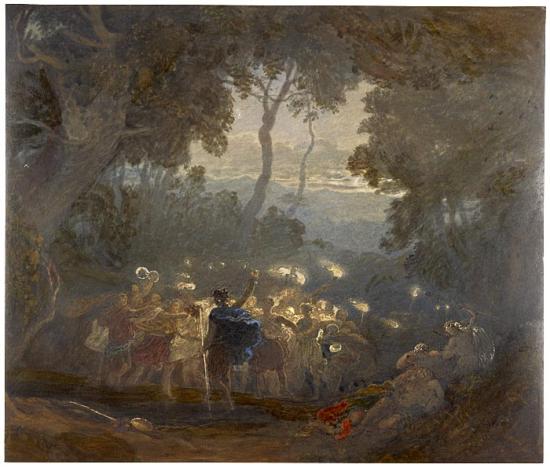
The Dell of Comus
Purchased on the Ryskamp Fund
A pupil of the artist John Varley, Finch was also a poet and musician loosely associated with the Ancients. Finch and other group members admired the same poets and were deeply suspicious of modern, industrial development, turning instead to an idealized rural idyll. Finch exhibited two watercolors illustrating the woodland setting of Milton's Comus at the Old Water-colour Society: one, most likely the present work, in 1835, and a later, possibly larger version of the same subject in 1844.
The present watercolor has been built up using dark pigments enhanced with gum arabic creating a somber but rich effect contrasting with the highlighting achieved through scratching out.
William Blake (1757–1827) occupies a unique place in the history of Western art. His creativity included both the visual and literary arts. In his lifetime he was best known as an engraver; now he is also recognized for his innovative poetry, printmaking, and painting. Blake's keen perception of the political and social climate found expression throughout his work. His strong sense of independence is evident in the complex mythology that he constructed in response to the age of revolution.
Blake was already recognized as an engraver at age twenty-five, when his first volume of poems appeared. At thirty-three, in The Marriage of Heaven and Hell, he audaciously claimed that his birth had marked the origin of a "new heaven" in which his own art would exemplify the creativity prefigured by Milton and Michelangelo. By that time, Blake, in one of his most productive periods, had already produced Songs of Innocence and was at work on a series of illuminated books. In 1818 he met John Linnell, a young painter and engraver, through whom a group of young artists became Blake's followers. Calling themselves the Ancients, they helped perpetuate Blake's influence for generations.
The Morgan's Blake collection—one of this country's most distinguished—began with purchases as early as 1899 by Pierpont Morgan. During the tenure of Charles Ryskamp, director from 1969 to 1986, major gifts almost doubled the size of its Blake holdings. In recent years Ryskamp's own gifts of engravings, letters, and related materials have significantly enriched its scholarly resources.
II. Friends and Followers
Among Blake's early friends were professors and other students at the Royal Academy, many of whom became leading figures of the age. He frequently engraved works by Thomas Stothard, Henry Fuseli, and John Flaxman, for example, as will be seen in this gallery. In his day Blake was more widely esteemed as a fine engraver than as a painter, his own imaginative work having been produced primarily on speculation or for patrons. Only nine years before Blake's death, the young artist John Linnell (1792–1882) became both a patron and friend. Through him Blake became acquainted with several youthful artists who came to call themselves the Ancients, after Blake's frequent reference to earlier artists as "ancients." They were inspired by Blake's imaginative spirit and his love for the art of Michelangelo as well as for the poetry of Milton. These men––Edward Calvert, Samuel Palmer, George Richmond, Francis Oliver Finch, George Cumberland, Frederick Tatham, and Henry Walter––are represented in the Morgan's collections.
This online exhibition is presented in conjunction with the exhibition William Blake's World: "A New Heaven Is Begun" on view September 11, 2009, through January 3, 2010.
This exhibition is made possible through the generosity of Fay and Geoffrey Elliott.
George Richmond
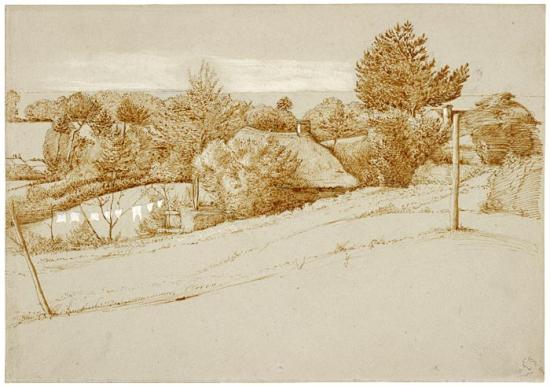
A Wooded Landscape with a Cottage
Purchased on the Ryskamp Fund and on the Edwin H. Herzog Fund
While Richmond would go on to become a highly successful portraitist, his early works were influenced by Blake and the Ancients. Their motto, "Poetry and Sentiment," succinctly sums up their aims and aspirations. This incisive sketch features a gently idyllic quality, which characterizes the most accomplished of the artist's rare pure landscapes. There is a kinship between this work and some of Samuel Palmer's post-Shoreham studies, especially in the way Richmond used pen and brown ink and white highlights.
William Blake (1757–1827) occupies a unique place in the history of Western art. His creativity included both the visual and literary arts. In his lifetime he was best known as an engraver; now he is also recognized for his innovative poetry, printmaking, and painting. Blake's keen perception of the political and social climate found expression throughout his work. His strong sense of independence is evident in the complex mythology that he constructed in response to the age of revolution.
Blake was already recognized as an engraver at age twenty-five, when his first volume of poems appeared. At thirty-three, in The Marriage of Heaven and Hell, he audaciously claimed that his birth had marked the origin of a "new heaven" in which his own art would exemplify the creativity prefigured by Milton and Michelangelo. By that time, Blake, in one of his most productive periods, had already produced Songs of Innocence and was at work on a series of illuminated books. In 1818 he met John Linnell, a young painter and engraver, through whom a group of young artists became Blake's followers. Calling themselves the Ancients, they helped perpetuate Blake's influence for generations.
The Morgan's Blake collection—one of this country's most distinguished—began with purchases as early as 1899 by Pierpont Morgan. During the tenure of Charles Ryskamp, director from 1969 to 1986, major gifts almost doubled the size of its Blake holdings. In recent years Ryskamp's own gifts of engravings, letters, and related materials have significantly enriched its scholarly resources.
II. Friends and Followers
Among Blake's early friends were professors and other students at the Royal Academy, many of whom became leading figures of the age. He frequently engraved works by Thomas Stothard, Henry Fuseli, and John Flaxman, for example, as will be seen in this gallery. In his day Blake was more widely esteemed as a fine engraver than as a painter, his own imaginative work having been produced primarily on speculation or for patrons. Only nine years before Blake's death, the young artist John Linnell (1792–1882) became both a patron and friend. Through him Blake became acquainted with several youthful artists who came to call themselves the Ancients, after Blake's frequent reference to earlier artists as "ancients." They were inspired by Blake's imaginative spirit and his love for the art of Michelangelo as well as for the poetry of Milton. These men––Edward Calvert, Samuel Palmer, George Richmond, Francis Oliver Finch, George Cumberland, Frederick Tatham, and Henry Walter––are represented in the Morgan's collections.
This online exhibition is presented in conjunction with the exhibition William Blake's World: "A New Heaven Is Begun" on view September 11, 2009, through January 3, 2010.
This exhibition is made possible through the generosity of Fay and Geoffrey Elliott.
John Linnell
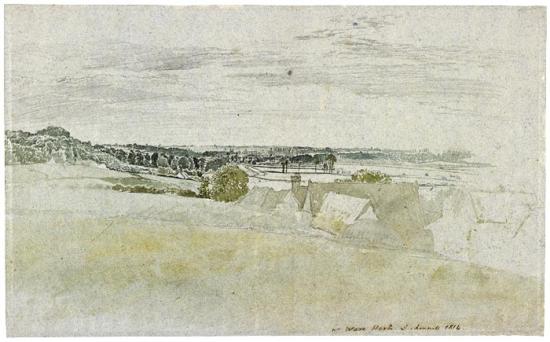
View of Amwell Hill, near Ware, in Hertfordshire
Signed and dated at lower right in pen and brown ink, Nr Ware Herts J. Linnell 1814.
Purchased on the Baker Fund
In 1805 Linnell entered the Royal Academy Schools, where he became a pupil of John Varley, who encouraged his students to draw directly from nature. The simplicity and purity of Linnell's observations are evident in this delicate watercolor, which was commissioned by Samuel Bagster to illustrate his 1815 edition of Izaak Walton and Charles Cotton's The Complete Angler, or Contemplative Man's Recreation.
William Blake (1757–1827) occupies a unique place in the history of Western art. His creativity included both the visual and literary arts. In his lifetime he was best known as an engraver; now he is also recognized for his innovative poetry, printmaking, and painting. Blake's keen perception of the political and social climate found expression throughout his work. His strong sense of independence is evident in the complex mythology that he constructed in response to the age of revolution.
Blake was already recognized as an engraver at age twenty-five, when his first volume of poems appeared. At thirty-three, in The Marriage of Heaven and Hell, he audaciously claimed that his birth had marked the origin of a "new heaven" in which his own art would exemplify the creativity prefigured by Milton and Michelangelo. By that time, Blake, in one of his most productive periods, had already produced Songs of Innocence and was at work on a series of illuminated books. In 1818 he met John Linnell, a young painter and engraver, through whom a group of young artists became Blake's followers. Calling themselves the Ancients, they helped perpetuate Blake's influence for generations.
The Morgan's Blake collection—one of this country's most distinguished—began with purchases as early as 1899 by Pierpont Morgan. During the tenure of Charles Ryskamp, director from 1969 to 1986, major gifts almost doubled the size of its Blake holdings. In recent years Ryskamp's own gifts of engravings, letters, and related materials have significantly enriched its scholarly resources.
II. Friends and Followers
Among Blake's early friends were professors and other students at the Royal Academy, many of whom became leading figures of the age. He frequently engraved works by Thomas Stothard, Henry Fuseli, and John Flaxman, for example, as will be seen in this gallery. In his day Blake was more widely esteemed as a fine engraver than as a painter, his own imaginative work having been produced primarily on speculation or for patrons. Only nine years before Blake's death, the young artist John Linnell (1792–1882) became both a patron and friend. Through him Blake became acquainted with several youthful artists who came to call themselves the Ancients, after Blake's frequent reference to earlier artists as "ancients." They were inspired by Blake's imaginative spirit and his love for the art of Michelangelo as well as for the poetry of Milton. These men––Edward Calvert, Samuel Palmer, George Richmond, Francis Oliver Finch, George Cumberland, Frederick Tatham, and Henry Walter––are represented in the Morgan's collections.
This online exhibition is presented in conjunction with the exhibition William Blake's World: "A New Heaven Is Begun" on view September 11, 2009, through January 3, 2010.
This exhibition is made possible through the generosity of Fay and Geoffrey Elliott.
III. The Book of Job
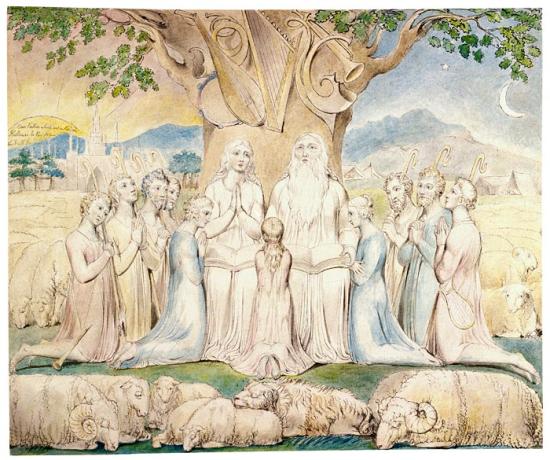
Job and His Family
Purchased by Pierpont Morgan, 1903
William Blake (1757–1827) occupies a unique place in the history of Western art. His creativity included both the visual and literary arts. In his lifetime he was best known as an engraver; now he is also recognized for his innovative poetry, printmaking, and painting. Blake's keen perception of the political and social climate found expression throughout his work. His strong sense of independence is evident in the complex mythology that he constructed in response to the age of revolution.
Blake was already recognized as an engraver at age twenty-five, when his first volume of poems appeared. At thirty-three, in The Marriage of Heaven and Hell, he audaciously claimed that his birth had marked the origin of a "new heaven" in which his own art would exemplify the creativity prefigured by Milton and Michelangelo. By that time, Blake, in one of his most productive periods, had already produced Songs of Innocence and was at work on a series of illuminated books. In 1818 he met John Linnell, a young painter and engraver, through whom a group of young artists became Blake's followers. Calling themselves the Ancients, they helped perpetuate Blake's influence for generations.
The Morgan's Blake collection—one of this country's most distinguished—began with purchases as early as 1899 by Pierpont Morgan. During the tenure of Charles Ryskamp, director from 1969 to 1986, major gifts almost doubled the size of its Blake holdings. In recent years Ryskamp's own gifts of engravings, letters, and related materials have significantly enriched its scholarly resources.
III. The Book of Job
These watercolors constitute Blake's first set of illustrations for the Book of Job, which the artist produced between 1805 and 1810 for his most important patron, Thomas Butts, plus two (plates 17 and 20) that he added after 1821 when he borrowed the set to copy for John Linnell.
The story of Job is of a good man sorely tested in order to understand the relationship between the evil of suffering and the existence of God. In Blake's version, Job's major flaw is attending to the letter, rather than the spirit, of God's law. In doing so, Job falls under Satan's spell and his suffering progresses into the horrible vision of a cloven-hoofed demon in the eleventh plate, Job's Evil Dreams. Elihu and Eliphaz, two of Job's friends, express particular arguments regarding his unidentified sin; however, his constant faith in God prevails. The remaining plates recount Job's spiritual growth— including the image where God shows him the Behemoth and Leviathan, the monsters of earth and sea—culminating in his family's celebration in the final image.
All drawings in pen and black ink, gray wash, and watercolor, over traces of graphite
Purchased by Pierpont Morgan, 1903; 2001.63–83
This online exhibition is presented in conjunction with the exhibition William Blake's World: "A New Heaven Is Begun" on view September 11, 2009, through January 3, 2010.
This exhibition is made possible through the generosity of Fay and Geoffrey Elliott.
Job's Comforters
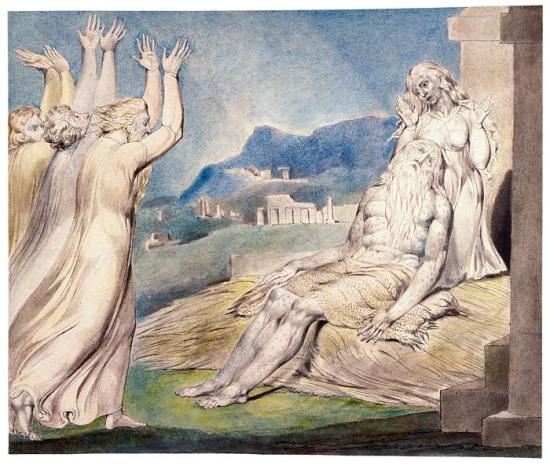
Job's Comforters
Purchased by Pierpont Morgan, 1903
William Blake (1757–1827) occupies a unique place in the history of Western art. His creativity included both the visual and literary arts. In his lifetime he was best known as an engraver; now he is also recognized for his innovative poetry, printmaking, and painting. Blake's keen perception of the political and social climate found expression throughout his work. His strong sense of independence is evident in the complex mythology that he constructed in response to the age of revolution.
Blake was already recognized as an engraver at age twenty-five, when his first volume of poems appeared. At thirty-three, in The Marriage of Heaven and Hell, he audaciously claimed that his birth had marked the origin of a "new heaven" in which his own art would exemplify the creativity prefigured by Milton and Michelangelo. By that time, Blake, in one of his most productive periods, had already produced Songs of Innocence and was at work on a series of illuminated books. In 1818 he met John Linnell, a young painter and engraver, through whom a group of young artists became Blake's followers. Calling themselves the Ancients, they helped perpetuate Blake's influence for generations.
The Morgan's Blake collection—one of this country's most distinguished—began with purchases as early as 1899 by Pierpont Morgan. During the tenure of Charles Ryskamp, director from 1969 to 1986, major gifts almost doubled the size of its Blake holdings. In recent years Ryskamp's own gifts of engravings, letters, and related materials have significantly enriched its scholarly resources.
III. The Book of Job
These watercolors constitute Blake's first set of illustrations for the Book of Job, which the artist produced between 1805 and 1810 for his most important patron, Thomas Butts, plus two (plates 17 and 20) that he added after 1821 when he borrowed the set to copy for John Linnell.
The story of Job is of a good man sorely tested in order to understand the relationship between the evil of suffering and the existence of God. In Blake's version, Job's major flaw is attending to the letter, rather than the spirit, of God's law. In doing so, Job falls under Satan's spell and his suffering progresses into the horrible vision of a cloven-hoofed demon in the eleventh plate, Job's Evil Dreams. Elihu and Eliphaz, two of Job's friends, express particular arguments regarding his unidentified sin; however, his constant faith in God prevails. The remaining plates recount Job's spiritual growth— including the image where God shows him the Behemoth and Leviathan, the monsters of earth and sea—culminating in his family's celebration in the final image.
This online exhibition is presented in conjunction with the exhibition William Blake's World: "A New Heaven Is Begun" on view September 11, 2009, through January 3, 2010.
This exhibition is made possible through the generosity of Fay and Geoffrey Elliott.
Satan Before the Throne of God
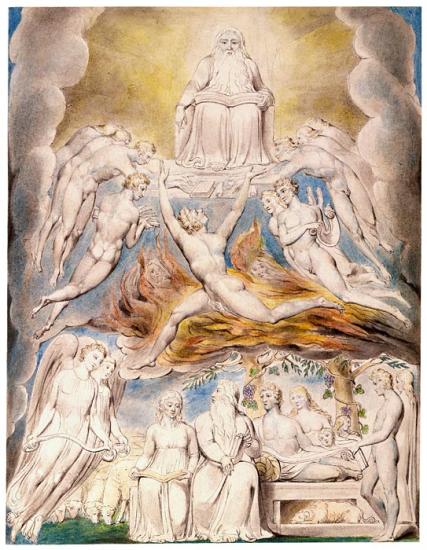
Satan Before the Throne of God
Purchased by Pierpont Morgan, 1903
William Blake (1757–1827) occupies a unique place in the history of Western art. His creativity included both the visual and literary arts. In his lifetime he was best known as an engraver; now he is also recognized for his innovative poetry, printmaking, and painting. Blake's keen perception of the political and social climate found expression throughout his work. His strong sense of independence is evident in the complex mythology that he constructed in response to the age of revolution.
Blake was already recognized as an engraver at age twenty-five, when his first volume of poems appeared. At thirty-three, in The Marriage of Heaven and Hell, he audaciously claimed that his birth had marked the origin of a "new heaven" in which his own art would exemplify the creativity prefigured by Milton and Michelangelo. By that time, Blake, in one of his most productive periods, had already produced Songs of Innocence and was at work on a series of illuminated books. In 1818 he met John Linnell, a young painter and engraver, through whom a group of young artists became Blake's followers. Calling themselves the Ancients, they helped perpetuate Blake's influence for generations.
The Morgan's Blake collection—one of this country's most distinguished—began with purchases as early as 1899 by Pierpont Morgan. During the tenure of Charles Ryskamp, director from 1969 to 1986, major gifts almost doubled the size of its Blake holdings. In recent years Ryskamp's own gifts of engravings, letters, and related materials have significantly enriched its scholarly resources.
III. The Book of Job
These watercolors constitute Blake's first set of illustrations for the Book of Job, which the artist produced between 1805 and 1810 for his most important patron, Thomas Butts, plus two (plates 17 and 20) that he added after 1821 when he borrowed the set to copy for John Linnell.
The story of Job is of a good man sorely tested in order to understand the relationship between the evil of suffering and the existence of God. In Blake's version, Job's major flaw is attending to the letter, rather than the spirit, of God's law. In doing so, Job falls under Satan's spell and his suffering progresses into the horrible vision of a cloven-hoofed demon in the eleventh plate, Job's Evil Dreams. Elihu and Eliphaz, two of Job's friends, express particular arguments regarding his unidentified sin; however, his constant faith in God prevails. The remaining plates recount Job's spiritual growth— including the image where God shows him the Behemoth and Leviathan, the monsters of earth and sea—culminating in his family's celebration in the final image.
All drawings in pen and black ink, gray wash, and watercolor, over traces of graphite.
This online exhibition is presented in conjunction with the exhibition William Blake's World: "A New Heaven Is Begun" on view September 11, 2009, through January 3, 2010.
This exhibition is made possible through the generosity of Fay and Geoffrey Elliott.
Job's Despair
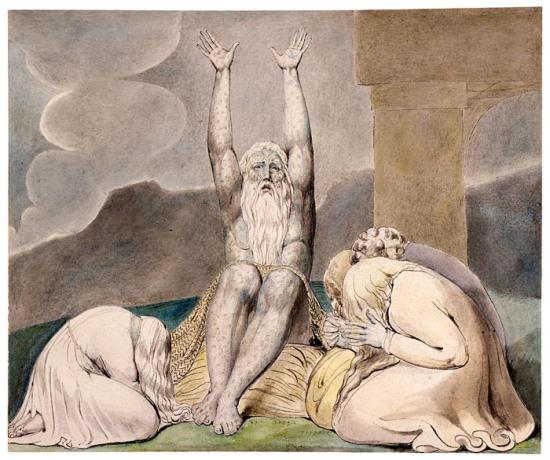
Job's Despair
Purchased by Pierpont Morgan, 1903
William Blake (1757–1827) occupies a unique place in the history of Western art. His creativity included both the visual and literary arts. In his lifetime he was best known as an engraver; now he is also recognized for his innovative poetry, printmaking, and painting. Blake's keen perception of the political and social climate found expression throughout his work. His strong sense of independence is evident in the complex mythology that he constructed in response to the age of revolution.
Blake was already recognized as an engraver at age twenty-five, when his first volume of poems appeared. At thirty-three, in The Marriage of Heaven and Hell, he audaciously claimed that his birth had marked the origin of a "new heaven" in which his own art would exemplify the creativity prefigured by Milton and Michelangelo. By that time, Blake, in one of his most productive periods, had already produced Songs of Innocence and was at work on a series of illuminated books. In 1818 he met John Linnell, a young painter and engraver, through whom a group of young artists became Blake's followers. Calling themselves the Ancients, they helped perpetuate Blake's influence for generations.
The Morgan's Blake collection—one of this country's most distinguished—began with purchases as early as 1899 by Pierpont Morgan. During the tenure of Charles Ryskamp, director from 1969 to 1986, major gifts almost doubled the size of its Blake holdings. In recent years Ryskamp's own gifts of engravings, letters, and related materials have significantly enriched its scholarly resources.
III. The Book of Job
These watercolors constitute Blake's first set of illustrations for the Book of Job, which the artist produced between 1805 and 1810 for his most important patron, Thomas Butts, plus two (plates 17 and 20) that he added after 1821 when he borrowed the set to copy for John Linnell.
The story of Job is of a good man sorely tested in order to understand the relationship between the evil of suffering and the existence of God. In Blake's version, Job's major flaw is attending to the letter, rather than the spirit, of God's law. In doing so, Job falls under Satan's spell and his suffering progresses into the horrible vision of a cloven-hoofed demon in the eleventh plate, Job's Evil Dreams. Elihu and Eliphaz, two of Job's friends, express particular arguments regarding his unidentified sin; however, his constant faith in God prevails. The remaining plates recount Job's spiritual growth— including the image where God shows him the Behemoth and Leviathan, the monsters of earth and sea—culminating in his family's celebration in the final image.
This online exhibition is presented in conjunction with the exhibition William Blake's World: "A New Heaven Is Begun" on view September 11, 2009, through January 3, 2010.
This exhibition is made possible through the generosity of Fay and Geoffrey Elliott.
Job's Sons and Daughters Overwhelmed by Satan

Job's Sons and Daughters Overwhelmed by Satan
Purchased by Pierpont Morgan, 1903
William Blake (1757–1827) occupies a unique place in the history of Western art. His creativity included both the visual and literary arts. In his lifetime he was best known as an engraver; now he is also recognized for his innovative poetry, printmaking, and painting. Blake's keen perception of the political and social climate found expression throughout his work. His strong sense of independence is evident in the complex mythology that he constructed in response to the age of revolution.
Blake was already recognized as an engraver at age twenty-five, when his first volume of poems appeared. At thirty-three, in The Marriage of Heaven and Hell, he audaciously claimed that his birth had marked the origin of a "new heaven" in which his own art would exemplify the creativity prefigured by Milton and Michelangelo. By that time, Blake, in one of his most productive periods, had already produced Songs of Innocence and was at work on a series of illuminated books. In 1818 he met John Linnell, a young painter and engraver, through whom a group of young artists became Blake's followers. Calling themselves the Ancients, they helped perpetuate Blake's influence for generations.
The Morgan's Blake collection—one of this country's most distinguished—began with purchases as early as 1899 by Pierpont Morgan. During the tenure of Charles Ryskamp, director from 1969 to 1986, major gifts almost doubled the size of its Blake holdings. In recent years Ryskamp's own gifts of engravings, letters, and related materials have significantly enriched its scholarly resources.
III. The Book of Job
These watercolors constitute Blake's first set of illustrations for the Book of Job, which the artist produced between 1805 and 1810 for his most important patron, Thomas Butts, plus two (plates 17 and 20) that he added after 1821 when he borrowed the set to copy for John Linnell.
The story of Job is of a good man sorely tested in order to understand the relationship between the evil of suffering and the existence of God. In Blake's version, Job's major flaw is attending to the letter, rather than the spirit, of God's law. In doing so, Job falls under Satan's spell and his suffering progresses into the horrible vision of a cloven-hoofed demon in the eleventh plate, Job's Evil Dreams. Elihu and Eliphaz, two of Job's friends, express particular arguments regarding his unidentified sin; however, his constant faith in God prevails. The remaining plates recount Job's spiritual growth— including the image where God shows him the Behemoth and Leviathan, the monsters of earth and sea—culminating in his family's celebration in the final image.
This online exhibition is presented in conjunction with the exhibition William Blake's World: "A New Heaven Is Begun" on view September 11, 2009, through January 3, 2010.
This exhibition is made possible through the generosity of Fay and Geoffrey Elliott.
The Messengers Tell Job of His Misfortunes
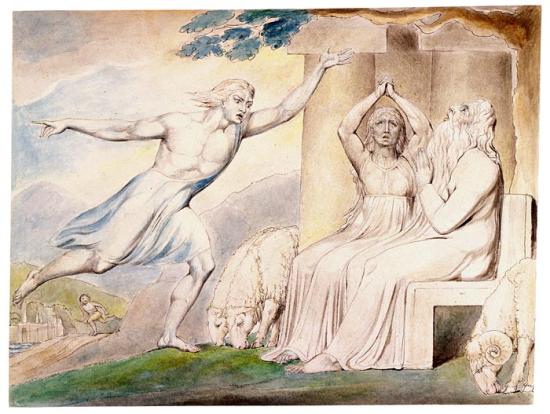
The Messengers Tell Job of His Misfortunes
Purchased by Pierpont Morgan, 1903
William Blake (1757–1827) occupies a unique place in the history of Western art. His creativity included both the visual and literary arts. In his lifetime he was best known as an engraver; now he is also recognized for his innovative poetry, printmaking, and painting. Blake's keen perception of the political and social climate found expression throughout his work. His strong sense of independence is evident in the complex mythology that he constructed in response to the age of revolution.
Blake was already recognized as an engraver at age twenty-five, when his first volume of poems appeared. At thirty-three, in The Marriage of Heaven and Hell, he audaciously claimed that his birth had marked the origin of a "new heaven" in which his own art would exemplify the creativity prefigured by Milton and Michelangelo. By that time, Blake, in one of his most productive periods, had already produced Songs of Innocence and was at work on a series of illuminated books. In 1818 he met John Linnell, a young painter and engraver, through whom a group of young artists became Blake's followers. Calling themselves the Ancients, they helped perpetuate Blake's influence for generations.
The Morgan's Blake collection—one of this country's most distinguished—began with purchases as early as 1899 by Pierpont Morgan. During the tenure of Charles Ryskamp, director from 1969 to 1986, major gifts almost doubled the size of its Blake holdings. In recent years Ryskamp's own gifts of engravings, letters, and related materials have significantly enriched its scholarly resources.
This online exhibition is presented in conjunction with the exhibition William Blake's World: "A New Heaven Is Begun" on view September 11, 2009, through January 3, 2010.
This exhibition is made possible through the generosity of Fay and Geoffrey Elliott.
The Vision of Eliphaz

The Vision of Eliphaz
Purchased by Pierpont Morgan, 1903
William Blake (1757–1827) occupies a unique place in the history of Western art. His creativity included both the visual and literary arts. In his lifetime he was best known as an engraver; now he is also recognized for his innovative poetry, printmaking, and painting. Blake's keen perception of the political and social climate found expression throughout his work. His strong sense of independence is evident in the complex mythology that he constructed in response to the age of revolution.
Blake was already recognized as an engraver at age twenty-five, when his first volume of poems appeared. At thirty-three, in The Marriage of Heaven and Hell, he audaciously claimed that his birth had marked the origin of a "new heaven" in which his own art would exemplify the creativity prefigured by Milton and Michelangelo. By that time, Blake, in one of his most productive periods, had already produced Songs of Innocence and was at work on a series of illuminated books. In 1818 he met John Linnell, a young painter and engraver, through whom a group of young artists became Blake's followers. Calling themselves the Ancients, they helped perpetuate Blake's influence for generations.
The Morgan's Blake collection—one of this country's most distinguished—began with purchases as early as 1899 by Pierpont Morgan. During the tenure of Charles Ryskamp, director from 1969 to 1986, major gifts almost doubled the size of its Blake holdings. In recent years Ryskamp's own gifts of engravings, letters, and related materials have significantly enriched its scholarly resources.
III. The Book of Job
These watercolors constitute Blake's first set of illustrations for the Book of Job, which the artist produced between 1805 and 1810 for his most important patron, Thomas Butts, plus two (plates 17 and 20) that he added after 1821 when he borrowed the set to copy for John Linnell.
The story of Job is of a good man sorely tested in order to understand the relationship between the evil of suffering and the existence of God. In Blake's version, Job's major flaw is attending to the letter, rather than the spirit, of God's law. In doing so, Job falls under Satan's spell and his suffering progresses into the horrible vision of a cloven-hoofed demon in the eleventh plate, Job's Evil Dreams. Elihu and Eliphaz, two of Job's friends, express particular arguments regarding his unidentified sin; however, his constant faith in God prevails. The remaining plates recount Job's spiritual growth— including the image where God shows him the Behemoth and Leviathan, the monsters of earth and sea—culminating in his family's celebration in the final image.
This online exhibition is presented in conjunction with the exhibition William Blake's World: "A New Heaven Is Begun" on view September 11, 2009, through January 3, 2010.
This exhibition is made possible through the generosity of Fay and Geoffrey Elliott.
Job Rebuked by His Friends
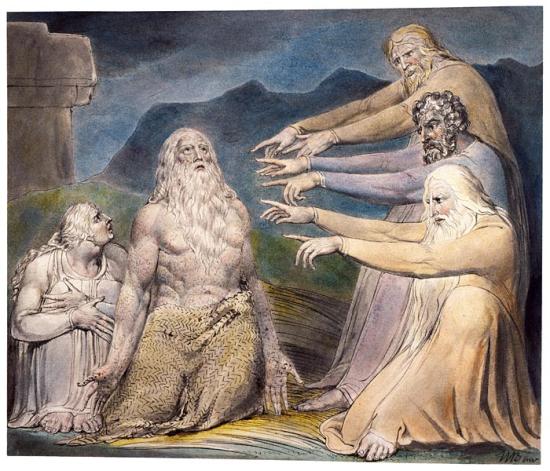
Job Rebuked by His Friends
Purchased by Pierpont Morgan, 1903
William Blake (1757–1827) occupies a unique place in the history of Western art. His creativity included both the visual and literary arts. In his lifetime he was best known as an engraver; now he is also recognized for his innovative poetry, printmaking, and painting. Blake's keen perception of the political and social climate found expression throughout his work. His strong sense of independence is evident in the complex mythology that he constructed in response to the age of revolution.
Blake was already recognized as an engraver at age twenty-five, when his first volume of poems appeared. At thirty-three, in The Marriage of Heaven and Hell, he audaciously claimed that his birth had marked the origin of a "new heaven" in which his own art would exemplify the creativity prefigured by Milton and Michelangelo. By that time, Blake, in one of his most productive periods, had already produced Songs of Innocence and was at work on a series of illuminated books. In 1818 he met John Linnell, a young painter and engraver, through whom a group of young artists became Blake's followers. Calling themselves the Ancients, they helped perpetuate Blake's influence for generations.
The Morgan's Blake collection—one of this country's most distinguished—began with purchases as early as 1899 by Pierpont Morgan. During the tenure of Charles Ryskamp, director from 1969 to 1986, major gifts almost doubled the size of its Blake holdings. In recent years Ryskamp's own gifts of engravings, letters, and related materials have significantly enriched its scholarly resources.
III. The Book of Job
These watercolors constitute Blake's first set of illustrations for the Book of Job, which the artist produced between 1805 and 1810 for his most important patron, Thomas Butts, plus two (plates 17 and 20) that he added after 1821 when he borrowed the set to copy for John Linnell.
The story of Job is of a good man sorely tested in order to understand the relationship between the evil of suffering and the existence of God. In Blake's version, Job's major flaw is attending to the letter, rather than the spirit, of God's law. In doing so, Job falls under Satan's spell and his suffering progresses into the horrible vision of a cloven-hoofed demon in the eleventh plate, Job's Evil Dreams. Elihu and Eliphaz, two of Job's friends, express particular arguments regarding his unidentified sin; however, his constant faith in God prevails. The remaining plates recount Job's spiritual growth— including the image where God shows him the Behemoth and Leviathan, the monsters of earth and sea—culminating in his family's celebration in the final image.
This online exhibition is presented in conjunction with the exhibition William Blake's World: "A New Heaven Is Begun" on view September 11, 2009, through January 3, 2010.
This exhibition is made possible through the generosity of Fay and Geoffrey Elliott.
Satan Going Forth from the Presence of the Lord
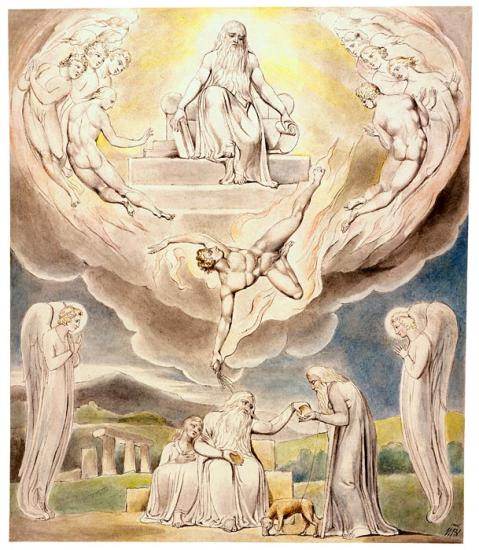
Satan Going Forth from the Presence of the Lord
Purchased by Pierpont Morgan, 1903
William Blake (1757–1827) occupies a unique place in the history of Western art. His creativity included both the visual and literary arts. In his lifetime he was best known as an engraver; now he is also recognized for his innovative poetry, printmaking, and painting. Blake's keen perception of the political and social climate found expression throughout his work. His strong sense of independence is evident in the complex mythology that he constructed in response to the age of revolution.
Blake was already recognized as an engraver at age twenty-five, when his first volume of poems appeared. At thirty-three, in The Marriage of Heaven and Hell, he audaciously claimed that his birth had marked the origin of a "new heaven" in which his own art would exemplify the creativity prefigured by Milton and Michelangelo. By that time, Blake, in one of his most productive periods, had already produced Songs of Innocence and was at work on a series of illuminated books. In 1818 he met John Linnell, a young painter and engraver, through whom a group of young artists became Blake's followers. Calling themselves the Ancients, they helped perpetuate Blake's influence for generations.
The Morgan's Blake collection—one of this country's most distinguished—began with purchases as early as 1899 by Pierpont Morgan. During the tenure of Charles Ryskamp, director from 1969 to 1986, major gifts almost doubled the size of its Blake holdings. In recent years Ryskamp's own gifts of engravings, letters, and related materials have significantly enriched its scholarly resources.
III. The Book of Job
These watercolors constitute Blake's first set of illustrations for the Book of Job, which the artist produced between 1805 and 1810 for his most important patron, Thomas Butts, plus two (plates 17 and 20) that he added after 1821 when he borrowed the set to copy for John Linnell.
The story of Job is of a good man sorely tested in order to understand the relationship between the evil of suffering and the existence of God. In Blake's version, Job's major flaw is attending to the letter, rather than the spirit, of God's law. In doing so, Job falls under Satan's spell and his suffering progresses into the horrible vision of a cloven-hoofed demon in the eleventh plate, Job's Evil Dreams. Elihu and Eliphaz, two of Job's friends, express particular arguments regarding his unidentified sin; however, his constant faith in God prevails. The remaining plates recount Job's spiritual growth— including the image where God shows him the Behemoth and Leviathan, the monsters of earth and sea—culminating in his family's celebration in the final image.
This online exhibition is presented in conjunction with the exhibition William Blake's World: "A New Heaven Is Begun" on view September 11, 2009, through January 3, 2010.
This exhibition is made possible through the generosity of Fay and Geoffrey Elliott.
Job's Evil Dreams
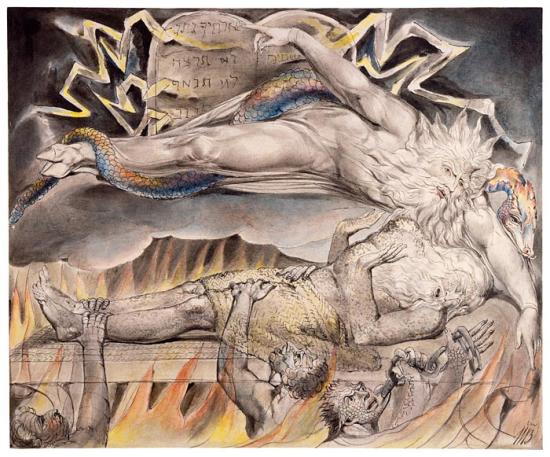
Job's Evil Dreams
Purchased by Pierpont Morgan, 1903
William Blake (1757–1827) occupies a unique place in the history of Western art. His creativity included both the visual and literary arts. In his lifetime he was best known as an engraver; now he is also recognized for his innovative poetry, printmaking, and painting. Blake's keen perception of the political and social climate found expression throughout his work. His strong sense of independence is evident in the complex mythology that he constructed in response to the age of revolution.
Blake was already recognized as an engraver at age twenty-five, when his first volume of poems appeared. At thirty-three, in The Marriage of Heaven and Hell, he audaciously claimed that his birth had marked the origin of a "new heaven" in which his own art would exemplify the creativity prefigured by Milton and Michelangelo. By that time, Blake, in one of his most productive periods, had already produced Songs of Innocence and was at work on a series of illuminated books. In 1818 he met John Linnell, a young painter and engraver, through whom a group of young artists became Blake's followers. Calling themselves the Ancients, they helped perpetuate Blake's influence for generations.
The Morgan's Blake collection—one of this country's most distinguished—began with purchases as early as 1899 by Pierpont Morgan. During the tenure of Charles Ryskamp, director from 1969 to 1986, major gifts almost doubled the size of its Blake holdings. In recent years Ryskamp's own gifts of engravings, letters, and related materials have significantly enriched its scholarly resources.
III. The Book of Job
These watercolors constitute Blake's first set of illustrations for the Book of Job, which the artist produced between 1805 and 1810 for his most important patron, Thomas Butts, plus two (plates 17 and 20) that he added after 1821 when he borrowed the set to copy for John Linnell.
The story of Job is of a good man sorely tested in order to understand the relationship between the evil of suffering and the existence of God. In Blake's version, Job's major flaw is attending to the letter, rather than the spirit, of God's law. In doing so, Job falls under Satan's spell and his suffering progresses into the horrible vision of a cloven-hoofed demon in the eleventh plate, Job's Evil Dreams. Elihu and Eliphaz, two of Job's friends, express particular arguments regarding his unidentified sin; however, his constant faith in God prevails. The remaining plates recount Job's spiritual growth— including the image where God shows him the Behemoth and Leviathan, the monsters of earth and sea—culminating in his family's celebration in the final image.
This online exhibition is presented in conjunction with the exhibition William Blake's World: "A New Heaven Is Begun" on view September 11, 2009, through January 3, 2010.
This exhibition is made possible through the generosity of Fay and Geoffrey Elliott.
Satan Smiting Job with Boils
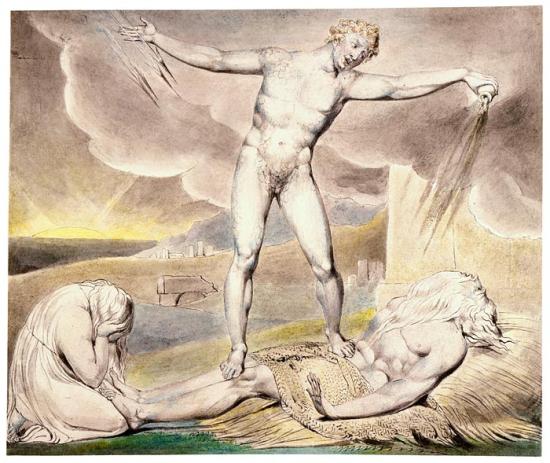
Satan Smiting Job with Boils
This online exhibition is presented in conjunction with the exhibition William Blake's World: "A New Heaven Is Begun" on view September 11, 2009, through January 3, 2010.
This exhibition is made possible through the generosity of Fay and Geoffrey Elliott.
William Blake (1757–1827) occupies a unique place in the history of Western art. His creativity included both the visual and literary arts. In his lifetime he was best known as an engraver; now he is also recognized for his innovative poetry, printmaking, and painting. Blake's keen perception of the political and social climate found expression throughout his work. His strong sense of independence is evident in the complex mythology that he constructed in response to the age of revolution.
Blake was already recognized as an engraver at age twenty-five, when his first volume of poems appeared. At thirty-three, in The Marriage of Heaven and Hell, he audaciously claimed that his birth had marked the origin of a "new heaven" in which his own art would exemplify the creativity prefigured by Milton and Michelangelo. By that time, Blake, in one of his most productive periods, had already produced Songs of Innocence and was at work on a series of illuminated books. In 1818 he met John Linnell, a young painter and engraver, through whom a group of young artists became Blake's followers. Calling themselves the Ancients, they helped perpetuate Blake's influence for generations.
The Morgan's Blake collection—one of this country's most distinguished—began with purchases as early as 1899 by Pierpont Morgan. During the tenure of Charles Ryskamp, director from 1969 to 1986, major gifts almost doubled the size of its Blake holdings. In recent years Ryskamp's own gifts of engravings, letters, and related materials have significantly enriched its scholarly resources.
III. The Book of Job
These watercolors constitute Blake's first set of illustrations for the Book of Job, which the artist produced between 1805 and 1810 for his most important patron, Thomas Butts, plus two (plates 17 and 20) that he added after 1821 when he borrowed the set to copy for John Linnell.
The story of Job is of a good man sorely tested in order to understand the relationship between the evil of suffering and the existence of God. In Blake's version, Job's major flaw is attending to the letter, rather than the spirit, of God's law. In doing so, Job falls under Satan's spell and his suffering progresses into the horrible vision of a cloven-hoofed demon in the eleventh plate, Job's Evil Dreams. Elihu and Eliphaz, two of Job's friends, express particular arguments regarding his unidentified sin; however, his constant faith in God prevails. The remaining plates recount Job's spiritual growth— including the image where God shows him the Behemoth and Leviathan, the monsters of earth and sea—culminating in his family's celebration in the final image.
This online exhibition is presented in conjunction with the exhibition William Blake's World: "A New Heaven Is Begun" on view September 11, 2009, through January 3, 2010.
This exhibition is made possible through the generosity of Fay and Geoffrey Elliott.
The Lord Answering Job Out of the Whirlwind
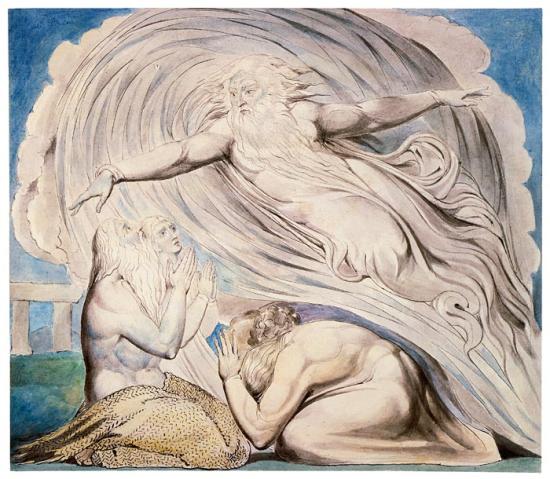
The Lord Answering Job Out of the Whirlwind
Purchased by Pierpont Morgan, 1903
William Blake (1757–1827) occupies a unique place in the history of Western art. His creativity included both the visual and literary arts. In his lifetime he was best known as an engraver; now he is also recognized for his innovative poetry, printmaking, and painting. Blake's keen perception of the political and social climate found expression throughout his work. His strong sense of independence is evident in the complex mythology that he constructed in response to the age of revolution.
Blake was already recognized as an engraver at age twenty-five, when his first volume of poems appeared. At thirty-three, in The Marriage of Heaven and Hell, he audaciously claimed that his birth had marked the origin of a "new heaven" in which his own art would exemplify the creativity prefigured by Milton and Michelangelo. By that time, Blake, in one of his most productive periods, had already produced Songs of Innocence and was at work on a series of illuminated books. In 1818 he met John Linnell, a young painter and engraver, through whom a group of young artists became Blake's followers. Calling themselves the Ancients, they helped perpetuate Blake's influence for generations.
The Morgan's Blake collection—one of this country's most distinguished—began with purchases as early as 1899 by Pierpont Morgan. During the tenure of Charles Ryskamp, director from 1969 to 1986, major gifts almost doubled the size of its Blake holdings. In recent years Ryskamp's own gifts of engravings, letters, and related materials have significantly enriched its scholarly resources.
III. The Book of Job
These watercolors constitute Blake's first set of illustrations for the Book of Job, which the artist produced between 1805 and 1810 for his most important patron, Thomas Butts, plus two (plates 17 and 20) that he added after 1821 when he borrowed the set to copy for John Linnell.
The story of Job is of a good man sorely tested in order to understand the relationship between the evil of suffering and the existence of God. In Blake's version, Job's major flaw is attending to the letter, rather than the spirit, of God's law. In doing so, Job falls under Satan's spell and his suffering progresses into the horrible vision of a cloven-hoofed demon in the eleventh plate, Job's Evil Dreams. Elihu and Eliphaz, two of Job's friends, express particular arguments regarding his unidentified sin; however, his constant faith in God prevails. The remaining plates recount Job's spiritual growth— including the image where God shows him the Behemoth and Leviathan, the monsters of earth and sea—culminating in his family's celebration in the final image.
This online exhibition is presented in conjunction with the exhibition William Blake's World: "A New Heaven Is Begun" on view September 11, 2009, through January 3, 2010.
This exhibition is made possible through the generosity of Fay and Geoffrey Elliott.
The Wrath of Elihu
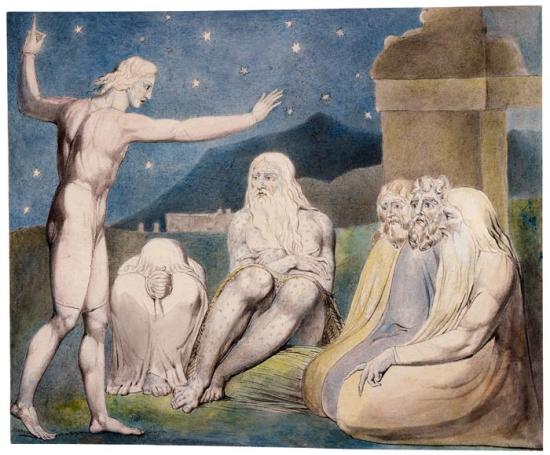
The Wrath of Elihu
Purchased by Pierpont Morgan, 1903
William Blake (1757–1827) occupies a unique place in the history of Western art. His creativity included both the visual and literary arts. In his lifetime he was best known as an engraver; now he is also recognized for his innovative poetry, printmaking, and painting. Blake's keen perception of the political and social climate found expression throughout his work. His strong sense of independence is evident in the complex mythology that he constructed in response to the age of revolution.
Blake was already recognized as an engraver at age twenty-five, when his first volume of poems appeared. At thirty-three, in The Marriage of Heaven and Hell, he audaciously claimed that his birth had marked the origin of a "new heaven" in which his own art would exemplify the creativity prefigured by Milton and Michelangelo. By that time, Blake, in one of his most productive periods, had already produced Songs of Innocence and was at work on a series of illuminated books. In 1818 he met John Linnell, a young painter and engraver, through whom a group of young artists became Blake's followers. Calling themselves the Ancients, they helped perpetuate Blake's influence for generations.
The Morgan's Blake collection—one of this country's most distinguished—began with purchases as early as 1899 by Pierpont Morgan. During the tenure of Charles Ryskamp, director from 1969 to 1986, major gifts almost doubled the size of its Blake holdings. In recent years Ryskamp's own gifts of engravings, letters, and related materials have significantly enriched its scholarly resources.
The Book of Job
These watercolors constitute Blake's first set of illustrations for the Book of Job, which the artist produced between 1805 and 1810 for his most important patron, Thomas Butts, plus two (plates 17 and 20) that he added after 1821 when he borrowed the set to copy for John Linnell.
The story of Job is of a good man sorely tested in order to understand the relationship between the evil of suffering and the existence of God. In Blake's version, Job's major flaw is attending to the letter, rather than the spirit, of God's law. In doing so, Job falls under Satan's spell and his suffering progresses into the horrible vision of a cloven-hoofed demon in the eleventh plate, Job's Evil Dreams. Elihu and Eliphaz, two of Job's friends, express particular arguments regarding his unidentified sin; however, his constant faith in God prevails. The remaining plates recount Job's spiritual growth— including the image where God shows him the Behemoth and Leviathan, the monsters of earth and sea—culminating in his family's celebration in the final image.
This online exhibition is presented in conjunction with the exhibition William Blake's World: "A New Heaven Is Begun" on view September 11, 2009, through January 3, 2010.
This exhibition is made possible through the generosity of Fay and Geoffrey Elliott.
William Blake
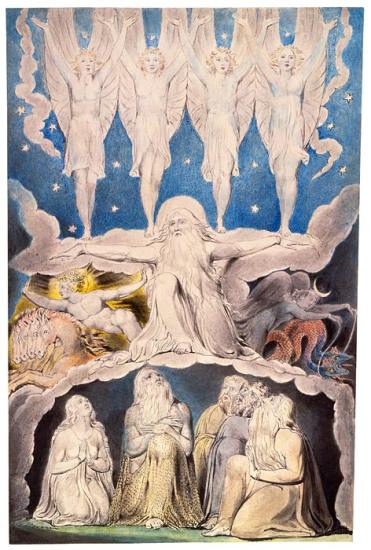
"When the Morning Stars Sang Together"
[Book of Job, no. 14]
Gift of J. P. Morgan, Jr. 1924
The series of twenty-one watercolor illustrations for the Book of Job are one of Blake's supreme achievements. Here, God reenacts the creation of the world, while Job and his wife kneel below. The scene follows the moment in which Job challenged God to appear and explain why he deserved the succession of evils that devastated him. "Then the Lord answered Job out of the whirlwind . . . Where wast thou when I laid the foundations of the earth? . . . When the morning stars sang together, and all the sons of God shouted for joy?"
William Blake (1757–1827) occupies a unique place in the history of Western art. His creativity included both the visual and literary arts. In his lifetime he was best known as an engraver; now he is also recognized for his innovative poetry, printmaking, and painting. Blake's keen perception of the political and social climate found expression throughout his work. His strong sense of independence is evident in the complex mythology that he constructed in response to the age of revolution.
Blake was already recognized as an engraver at age twenty-five, when his first volume of poems appeared. At thirty-three, in The Marriage of Heaven and Hell, he audaciously claimed that his birth had marked the origin of a "new heaven" in which his own art would exemplify the creativity prefigured by Milton and Michelangelo. By that time, Blake, in one of his most productive periods, had already produced Songs of Innocence and was at work on a series of illuminated books. In 1818 he met John Linnell, a young painter and engraver, through whom a group of young artists became Blake's followers. Calling themselves the Ancients, they helped perpetuate Blake's influence for generations.
The Morgan's Blake collection—one of this country's most distinguished—began with purchases as early as 1899 by Pierpont Morgan. During the tenure of Charles Ryskamp, director from 1969 to 1986, major gifts almost doubled the size of its Blake holdings. In recent years Ryskamp's own gifts of engravings, letters, and related materials have significantly enriched its scholarly resources.
III. The Book of Job
These watercolors constitute Blake's first set of illustrations for the Book of Job, which the artist produced between 1805 and 1810 for his most important patron, Thomas Butts, plus two (plates 17 and 20) that he added after 1821 when he borrowed the set to copy for John Linnell.
The story of Job is of a good man sorely tested in order to understand the relationship between the evil of suffering and the existence of God. In Blake's version, Job's major flaw is attending to the letter, rather than the spirit, of God's law. In doing so, Job falls under Satan's spell and his suffering progresses into the horrible vision of a cloven-hoofed demon in the eleventh plate, Job's Evil Dreams. Elihu and Eliphaz, two of Job's friends, express particular arguments regarding his unidentified sin; however, his constant faith in God prevails. The remaining plates recount Job's spiritual growth— including the image where God shows him the Behemoth and Leviathan, the monsters of earth and sea—culminating in his family's celebration in the final image.
All drawings in pen and black ink, gray wash, and watercolor, over traces of graphite
This online exhibition is presented in conjunction with the exhibition William Blake's World: "A New Heaven Is Begun" on view September 11, 2009, through January 3, 2010.
This exhibition is made possible through the generosity of Fay and Geoffrey Elliott.
Behemoth and Leviathan
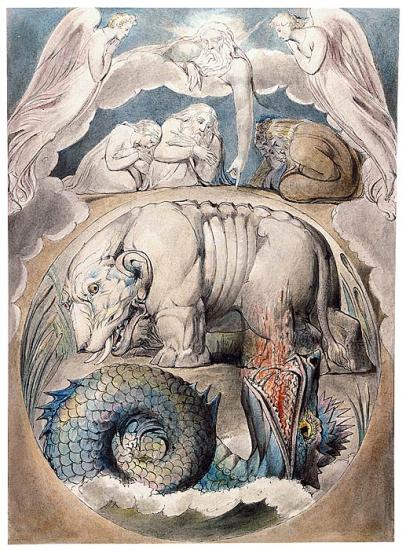
Behemoth and Leviathan
Purchased by Pierpont Morgan, 1903
William Blake (1757–1827) occupies a unique place in the history of Western art. His creativity included both the visual and literary arts. In his lifetime he was best known as an engraver; now he is also recognized for his innovative poetry, printmaking, and painting. Blake's keen perception of the political and social climate found expression throughout his work. His strong sense of independence is evident in the complex mythology that he constructed in response to the age of revolution.
Blake was already recognized as an engraver at age twenty-five, when his first volume of poems appeared. At thirty-three, in The Marriage of Heaven and Hell, he audaciously claimed that his birth had marked the origin of a "new heaven" in which his own art would exemplify the creativity prefigured by Milton and Michelangelo. By that time, Blake, in one of his most productive periods, had already produced Songs of Innocence and was at work on a series of illuminated books. In 1818 he met John Linnell, a young painter and engraver, through whom a group of young artists became Blake's followers. Calling themselves the Ancients, they helped perpetuate Blake's influence for generations.
The Morgan's Blake collection—one of this country's most distinguished—began with purchases as early as 1899 by Pierpont Morgan. During the tenure of Charles Ryskamp, director from 1969 to 1986, major gifts almost doubled the size of its Blake holdings. In recent years Ryskamp's own gifts of engravings, letters, and related materials have significantly enriched its scholarly resources.
III. The Book of Job
These watercolors constitute Blake's first set of illustrations for the Book of Job, which the artist produced between 1805 and 1810 for his most important patron, Thomas Butts, plus two (plates 17 and 20) that he added after 1821 when he borrowed the set to copy for John Linnell.
The story of Job is of a good man sorely tested in order to understand the relationship between the evil of suffering and the existence of God. In Blake's version, Job's major flaw is attending to the letter, rather than the spirit, of God's law. In doing so, Job falls under Satan's spell and his suffering progresses into the horrible vision of a cloven-hoofed demon in the eleventh plate, Job's Evil Dreams. Elihu and Eliphaz, two of Job's friends, express particular arguments regarding his unidentified sin; however, his constant faith in God prevails. The remaining plates recount Job's spiritual growth— including the image where God shows him the Behemoth and Leviathan, the monsters of earth and sea—culminating in his family's celebration in the final image.
This online exhibition is presented in conjunction with the exhibition William Blake's World: "A New Heaven Is Begun" on view September 11, 2009, through January 3, 2010.
This exhibition is made possible through the generosity of Fay and Geoffrey Elliott.
The Fall of Satan
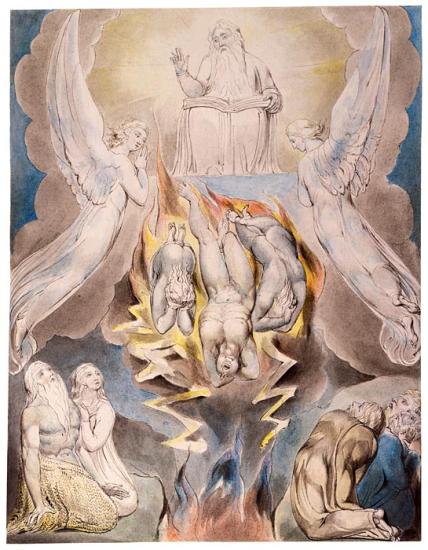
The Fall of Satan
Purchased by Pierpont Morgan, 1903
William Blake (1757–1827) occupies a unique place in the history of Western art. His creativity included both the visual and literary arts. In his lifetime he was best known as an engraver; now he is also recognized for his innovative poetry, printmaking, and painting. Blake's keen perception of the political and social climate found expression throughout his work. His strong sense of independence is evident in the complex mythology that he constructed in response to the age of revolution.
Blake was already recognized as an engraver at age twenty-five, when his first volume of poems appeared. At thirty-three, in The Marriage of Heaven and Hell, he audaciously claimed that his birth had marked the origin of a "new heaven" in which his own art would exemplify the creativity prefigured by Milton and Michelangelo. By that time, Blake, in one of his most productive periods, had already produced Songs of Innocence and was at work on a series of illuminated books. In 1818 he met John Linnell, a young painter and engraver, through whom a group of young artists became Blake's followers. Calling themselves the Ancients, they helped perpetuate Blake's influence for generations.
The Morgan's Blake collection—one of this country's most distinguished—began with purchases as early as 1899 by Pierpont Morgan. During the tenure of Charles Ryskamp, director from 1969 to 1986, major gifts almost doubled the size of its Blake holdings. In recent years Ryskamp's own gifts of engravings, letters, and related materials have significantly enriched its scholarly resources.
III. The Book of Job
These watercolors constitute Blake's first set of illustrations for the Book of Job, which the artist produced between 1805 and 1810 for his most important patron, Thomas Butts, plus two (plates 17 and 20) that he added after 1821 when he borrowed the set to copy for John Linnell.
The story of Job is of a good man sorely tested in order to understand the relationship between the evil of suffering and the existence of God. In Blake's version, Job's major flaw is attending to the letter, rather than the spirit, of God's law. In doing so, Job falls under Satan's spell and his suffering progresses into the horrible vision of a cloven-hoofed demon in the eleventh plate, Job's Evil Dreams. Elihu and Eliphaz, two of Job's friends, express particular arguments regarding his unidentified sin; however, his constant faith in God prevails. The remaining plates recount Job's spiritual growth— including the image where God shows him the Behemoth and Leviathan, the monsters of earth and sea—culminating in his family's celebration in the final image.
This online exhibition is presented in conjunction with the exhibition William Blake's World: "A New Heaven Is Begun" on view September 11, 2009, through January 3, 2010.
This exhibition is made possible through the generosity of Fay and Geoffrey Elliott.
The Vision of Christ
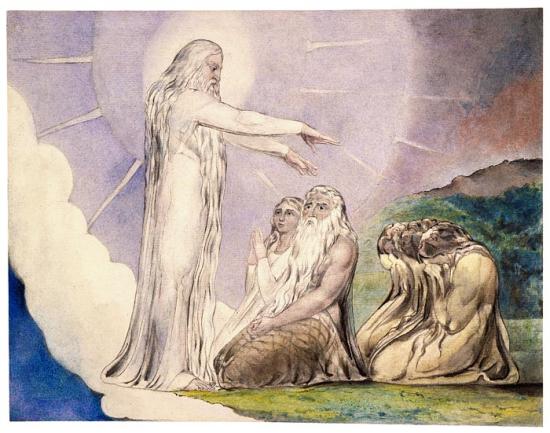
The Vision of Christ
Purchased by Pierpont Morgan, 1903
William Blake (1757–1827) occupies a unique place in the history of Western art. His creativity included both the visual and literary arts. In his lifetime he was best known as an engraver; now he is also recognized for his innovative poetry, printmaking, and painting. Blake's keen perception of the political and social climate found expression throughout his work. His strong sense of independence is evident in the complex mythology that he constructed in response to the age of revolution.
Blake was already recognized as an engraver at age twenty-five, when his first volume of poems appeared. At thirty-three, in The Marriage of Heaven and Hell, he audaciously claimed that his birth had marked the origin of a "new heaven" in which his own art would exemplify the creativity prefigured by Milton and Michelangelo. By that time, Blake, in one of his most productive periods, had already produced Songs of Innocence and was at work on a series of illuminated books. In 1818 he met John Linnell, a young painter and engraver, through whom a group of young artists became Blake's followers. Calling themselves the Ancients, they helped perpetuate Blake's influence for generations.
The Morgan's Blake collection—one of this country's most distinguished—began with purchases as early as 1899 by Pierpont Morgan. During the tenure of Charles Ryskamp, director from 1969 to 1986, major gifts almost doubled the size of its Blake holdings. In recent years Ryskamp's own gifts of engravings, letters, and related materials have significantly enriched its scholarly resources.
III. The Book of Job
These watercolors constitute Blake's first set of illustrations for the Book of Job, which the artist produced between 1805 and 1810 for his most important patron, Thomas Butts, plus two (plates 17 and 20) that he added after 1821 when he borrowed the set to copy for John Linnell.
The story of Job is of a good man sorely tested in order to understand the relationship between the evil of suffering and the existence of God. In Blake's version, Job's major flaw is attending to the letter, rather than the spirit, of God's law. In doing so, Job falls under Satan's spell and his suffering progresses into the horrible vision of a cloven-hoofed demon in the eleventh plate, Job's Evil Dreams. Elihu and Eliphaz, two of Job's friends, express particular arguments regarding his unidentified sin; however, his constant faith in God prevails. The remaining plates recount Job's spiritual growth— including the image where God shows him the Behemoth and Leviathan, the monsters of earth and sea—culminating in his family's celebration in the final image.
This online exhibition is presented in conjunction with the exhibition William Blake's World: "A New Heaven Is Begun" on view September 11, 2009, through January 3, 2010.
This exhibition is made possible through the generosity of Fay and Geoffrey Elliott.
Job's Sacrifice
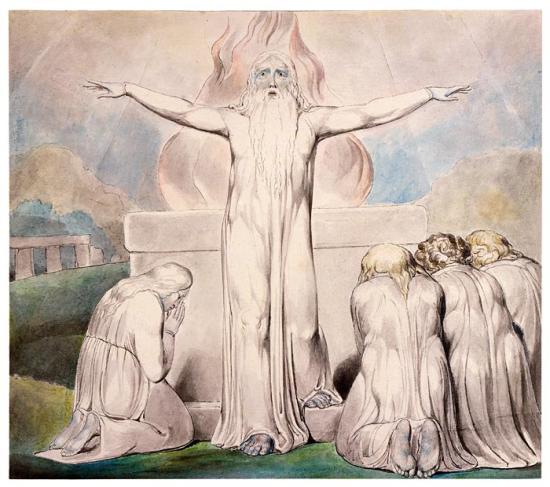
Job's Sacrifice
Purchased by Pierpont Morgan, 1903
William Blake (1757–1827) occupies a unique place in the history of Western art. His creativity included both the visual and literary arts. In his lifetime he was best known as an engraver; now he is also recognized for his innovative poetry, printmaking, and painting. Blake's keen perception of the political and social climate found expression throughout his work. His strong sense of independence is evident in the complex mythology that he constructed in response to the age of revolution.
Blake was already recognized as an engraver at age twenty-five, when his first volume of poems appeared. At thirty-three, in The Marriage of Heaven and Hell, he audaciously claimed that his birth had marked the origin of a "new heaven" in which his own art would exemplify the creativity prefigured by Milton and Michelangelo. By that time, Blake, in one of his most productive periods, had already produced Songs of Innocence and was at work on a series of illuminated books. In 1818 he met John Linnell, a young painter and engraver, through whom a group of young artists became Blake's followers. Calling themselves the Ancients, they helped perpetuate Blake's influence for generations.
The Morgan's Blake collection—one of this country's most distinguished—began with purchases as early as 1899 by Pierpont Morgan. During the tenure of Charles Ryskamp, director from 1969 to 1986, major gifts almost doubled the size of its Blake holdings. In recent years Ryskamp's own gifts of engravings, letters, and related materials have significantly enriched its scholarly resources.
III. The Book of Job
These watercolors constitute Blake's first set of illustrations for the Book of Job, which the artist produced between 1805 and 1810 for his most important patron, Thomas Butts, plus two (plates 17 and 20) that he added after 1821 when he borrowed the set to copy for John Linnell.
The story of Job is of a good man sorely tested in order to understand the relationship between the evil of suffering and the existence of God. In Blake's version, Job's major flaw is attending to the letter, rather than the spirit, of God's law. In doing so, Job falls under Satan's spell and his suffering progresses into the horrible vision of a cloven-hoofed demon in the eleventh plate, Job's Evil Dreams. Elihu and Eliphaz, two of Job's friends, express particular arguments regarding his unidentified sin; however, his constant faith in God prevails. The remaining plates recount Job's spiritual growth— including the image where God shows him the Behemoth and Leviathan, the monsters of earth and sea—culminating in his family's celebration in the final image.
This online exhibition is presented in conjunction with the exhibition William Blake's World: "A New Heaven Is Begun" on view September 11, 2009, through January 3, 2010.
This exhibition is made possible through the generosity of Fay and Geoffrey Elliott.
Every Man Also Gave Him a Piece of Money
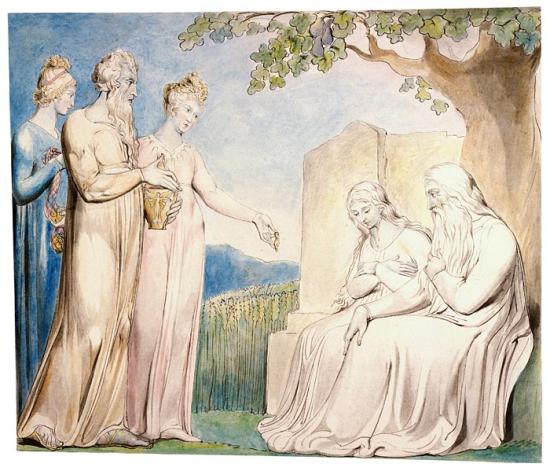
Every Man Also Gave Him a Piece of Money
Purchased by Pierpont Morgan, 1903
William Blake (1757–1827) occupies a unique place in the history of Western art. His creativity included both the visual and literary arts. In his lifetime he was best known as an engraver; now he is also recognized for his innovative poetry, printmaking, and painting. Blake's keen perception of the political and social climate found expression throughout his work. His strong sense of independence is evident in the complex mythology that he constructed in response to the age of revolution.
Blake was already recognized as an engraver at age twenty-five, when his first volume of poems appeared. At thirty-three, in The Marriage of Heaven and Hell, he audaciously claimed that his birth had marked the origin of a "new heaven" in which his own art would exemplify the creativity prefigured by Milton and Michelangelo. By that time, Blake, in one of his most productive periods, had already produced Songs of Innocence and was at work on a series of illuminated books. In 1818 he met John Linnell, a young painter and engraver, through whom a group of young artists became Blake's followers. Calling themselves the Ancients, they helped perpetuate Blake's influence for generations.
The Morgan's Blake collection—one of this country's most distinguished—began with purchases as early as 1899 by Pierpont Morgan. During the tenure of Charles Ryskamp, director from 1969 to 1986, major gifts almost doubled the size of its Blake holdings. In recent years Ryskamp's own gifts of engravings, letters, and related materials have significantly enriched its scholarly resources.
III. The Book of Job
These watercolors constitute Blake's first set of illustrations for the Book of Job, which the artist produced between 1805 and 1810 for his most important patron, Thomas Butts, plus two (plates 17 and 20) that he added after 1821 when he borrowed the set to copy for John Linnell.
The story of Job is of a good man sorely tested in order to understand the relationship between the evil of suffering and the existence of God. In Blake's version, Job's major flaw is attending to the letter, rather than the spirit, of God's law. In doing so, Job falls under Satan's spell and his suffering progresses into the horrible vision of a cloven-hoofed demon in the eleventh plate, Job's Evil Dreams. Elihu and Eliphaz, two of Job's friends, express particular arguments regarding his unidentified sin; however, his constant faith in God prevails. The remaining plates recount Job's spiritual growth— including the image where God shows him the Behemoth and Leviathan, the monsters of earth and sea—culminating in his family's celebration in the final image.
This online exhibition is presented in conjunction with the exhibition William Blake's World: "A New Heaven Is Begun" on view September 11, 2009, through January 3, 2010.
This exhibition is made possible through the generosity of Fay and Geoffrey Elliott.
Job and His Daughters
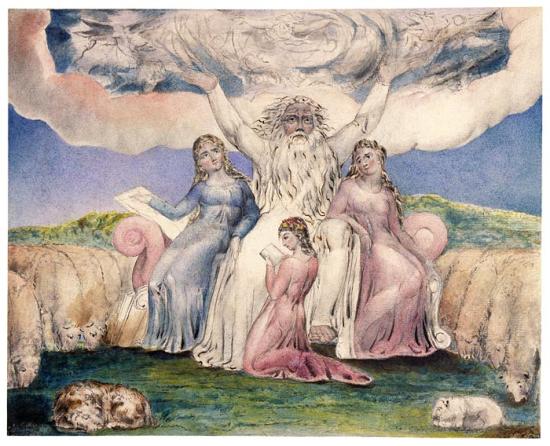
Job and His Daughters
Purchased by Pierpont Morgan, 1903
William Blake (1757–1827) occupies a unique place in the history of Western art. His creativity included both the visual and literary arts. In his lifetime he was best known as an engraver; now he is also recognized for his innovative poetry, printmaking, and painting. Blake's keen perception of the political and social climate found expression throughout his work. His strong sense of independence is evident in the complex mythology that he constructed in response to the age of revolution.
Blake was already recognized as an engraver at age twenty-five, when his first volume of poems appeared. At thirty-three, in The Marriage of Heaven and Hell, he audaciously claimed that his birth had marked the origin of a "new heaven" in which his own art would exemplify the creativity prefigured by Milton and Michelangelo. By that time, Blake, in one of his most productive periods, had already produced Songs of Innocence and was at work on a series of illuminated books. In 1818 he met John Linnell, a young painter and engraver, through whom a group of young artists became Blake's followers. Calling themselves the Ancients, they helped perpetuate Blake's influence for generations.
The Morgan's Blake collection—one of this country's most distinguished—began with purchases as early as 1899 by Pierpont Morgan. During the tenure of Charles Ryskamp, director from 1969 to 1986, major gifts almost doubled the size of its Blake holdings. In recent years Ryskamp's own gifts of engravings, letters, and related materials have significantly enriched its scholarly resources.
III. The Book of Job
These watercolors constitute Blake's first set of illustrations for the Book of Job, which the artist produced between 1805 and 1810 for his most important patron, Thomas Butts, plus two (plates 17 and 20) that he added after 1821 when he borrowed the set to copy for John Linnell.
The story of Job is of a good man sorely tested in order to understand the relationship between the evil of suffering and the existence of God. In Blake's version, Job's major flaw is attending to the letter, rather than the spirit, of God's law. In doing so, Job falls under Satan's spell and his suffering progresses into the horrible vision of a cloven-hoofed demon in the eleventh plate, Job's Evil Dreams. Elihu and Eliphaz, two of Job's friends, express particular arguments regarding his unidentified sin; however, his constant faith in God prevails. The remaining plates recount Job's spiritual growth— including the image where God shows him the Behemoth and Leviathan, the monsters of earth and sea—culminating in his family's celebration in the final image.
This online exhibition is presented in conjunction with the exhibition William Blake's World: "A New Heaven Is Begun" on view September 11, 2009, through January 3, 2010.
This exhibition is made possible through the generosity of Fay and Geoffrey Elliott.
Job and His Family Restored to Prosperity
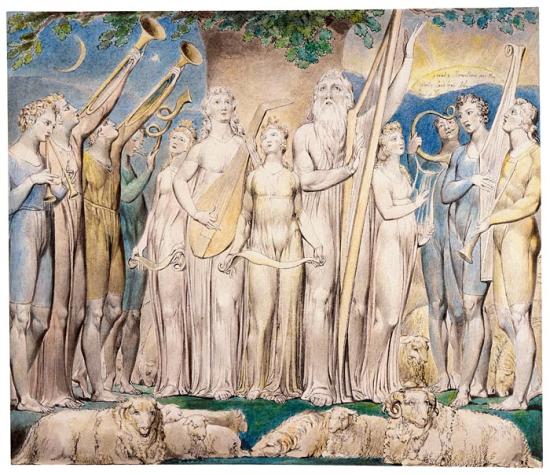
Job and His Family Restored to Prosperity
Purchased by Pierpont Morgan, 1903
William Blake (1757–1827) occupies a unique place in the history of Western art. His creativity included both the visual and literary arts. In his lifetime he was best known as an engraver; now he is also recognized for his innovative poetry, printmaking, and painting. Blake's keen perception of the political and social climate found expression throughout his work. His strong sense of independence is evident in the complex mythology that he constructed in response to the age of revolution.
Blake was already recognized as an engraver at age twenty-five, when his first volume of poems appeared. At thirty-three, in The Marriage of Heaven and Hell, he audaciously claimed that his birth had marked the origin of a "new heaven" in which his own art would exemplify the creativity prefigured by Milton and Michelangelo. By that time, Blake, in one of his most productive periods, had already produced Songs of Innocence and was at work on a series of illuminated books. In 1818 he met John Linnell, a young painter and engraver, through whom a group of young artists became Blake's followers. Calling themselves the Ancients, they helped perpetuate Blake's influence for generations.
The Morgan's Blake collection—one of this country's most distinguished—began with purchases as early as 1899 by Pierpont Morgan. During the tenure of Charles Ryskamp, director from 1969 to 1986, major gifts almost doubled the size of its Blake holdings. In recent years Ryskamp's own gifts of engravings, letters, and related materials have significantly enriched its scholarly resources.
III. The Book of Job
These watercolors constitute Blake's first set of illustrations for the Book of Job, which the artist produced between 1805 and 1810 for his most important patron, Thomas Butts, plus two (plates 17 and 20) that he added after 1821 when he borrowed the set to copy for John Linnell.
The story of Job is of a good man sorely tested in order to understand the relationship between the evil of suffering and the existence of God. In Blake's version, Job's major flaw is attending to the letter, rather than the spirit, of God's law. In doing so, Job falls under Satan's spell and his suffering progresses into the horrible vision of a cloven-hoofed demon in the eleventh plate, Job's Evil Dreams. Elihu and Eliphaz, two of Job's friends, express particular arguments regarding his unidentified sin; however, his constant faith in God prevails. The remaining plates recount Job's spiritual growth— including the image where God shows him the Behemoth and Leviathan, the monsters of earth and sea—culminating in his family's celebration in the final image.
This online exhibition is presented in conjunction with the exhibition William Blake's World: "A New Heaven Is Begun" on view September 11, 2009, through January 3, 2010.
This exhibition is made possible through the generosity of Fay and Geoffrey Elliott.
Portrait of William Blake
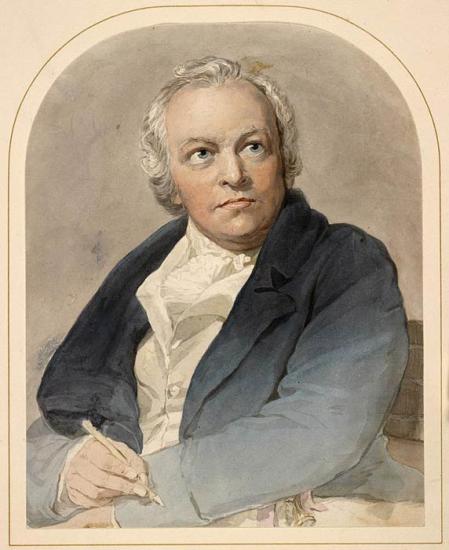
Portrait of William Blake
Purchased by Pierpont Morgan, 1903
This watercolor copy after Phillips's portrait of Blake, now in the National Portrait Gallery, London, was included by Thomas Butts in his portfolio containing Blake's twenty-one illustrations to the Book of Job.
William Blake (1757–1827) occupies a unique place in the history of Western art. His creativity included both the visual and literary arts. In his lifetime he was best known as an engraver; now he is also recognized for his innovative poetry, printmaking, and painting. Blake's keen perception of the political and social climate found expression throughout his work. His strong sense of independence is evident in the complex mythology that he constructed in response to the age of revolution.
Blake was already recognized as an engraver at age twenty-five, when his first volume of poems appeared. At thirty-three, in The Marriage of Heaven and Hell, he audaciously claimed that his birth had marked the origin of a "new heaven" in which his own art would exemplify the creativity prefigured by Milton and Michelangelo. By that time, Blake, in one of his most productive periods, had already produced Songs of Innocence and was at work on a series of illuminated books. In 1818 he met John Linnell, a young painter and engraver, through whom a group of young artists became Blake's followers. Calling themselves the Ancients, they helped perpetuate Blake's influence for generations.
The Morgan's Blake collection—one of this country's most distinguished—began with purchases as early as 1899 by Pierpont Morgan. During the tenure of Charles Ryskamp, director from 1969 to 1986, major gifts almost doubled the size of its Blake holdings. In recent years Ryskamp's own gifts of engravings, letters, and related materials have significantly enriched its scholarly resources.
This online exhibition is presented in conjunction with the exhibition William Blake's World: "A New Heaven Is Begun" on view September 11, 2009, through January 3, 2010.
This exhibition is made possible through the generosity of Fay and Geoffrey Elliott.
IV. The Continental Prophecies

America: A Prophecy
Lambeth: Printed by William Blake, 1793
Relief etchings with hand coloring and white line etching
Copy A, printed ca. 1795
Purchased by Pierpont Morgan, 1909
William Blake (1757–1827) occupies a unique place in the history of Western art. His creativity included both the visual and literary arts. In his lifetime he was best known as an engraver; now he is also recognized for his innovative poetry, printmaking, and painting. Blake's keen perception of the political and social climate found expression throughout his work. His strong sense of independence is evident in the complex mythology that he constructed in response to the age of revolution.
Blake was already recognized as an engraver at age twenty-five, when his first volume of poems appeared. At thirty-three, in The Marriage of Heaven and Hell, he audaciously claimed that his birth had marked the origin of a "new heaven" in which his own art would exemplify the creativity prefigured by Milton and Michelangelo. By that time, Blake, in one of his most productive periods, had already produced Songs of Innocence and was at work on a series of illuminated books. In 1818 he met John Linnell, a young painter and engraver, through whom a group of young artists became Blake's followers. Calling themselves the Ancients, they helped perpetuate Blake's influence for generations.
The Morgan's Blake collection—one of this country's most distinguished—began with purchases as early as 1899 by Pierpont Morgan. During the tenure of Charles Ryskamp, director from 1969 to 1986, major gifts almost doubled the size of its Blake holdings. In recent years Ryskamp's own gifts of engravings, letters, and related materials have significantly enriched its scholarly resources.
IV. The Continental Prophecies
In 1790, Blake moved to Lambeth, where he produced a trilogy of illuminated books called the Continental Prophecies that addressed the politically charged spirit of his age, embodied by the American and French revolutions. Along with Europe and The Song of Los, America depicts the oppression exercised by monarchies and religions represented by Urizen. Although godlike in appearance, Urizen is a legalistic, despotic figure.
Another central figure is Orc, representing the spirit of revolt, who is frequently associated with images of fire. The frontispiece represents the destruction of war, while the text refers to George Washington, Thomas Paine, and other contemporary figures. America exists in only fourteen copies, five of which were colored and printed during Blake's lifetime. The Morgan also owns an uncolored copy.
This online exhibition is presented in conjunction with the exhibition William Blake's World: "A New Heaven Is Begun" on view September 11, 2009, through January 3, 2010.
This exhibition is made possible through the generosity of Fay and Geoffrey Elliott.
America: A Prophecy 4

America: A Prophecy
Lambeth: Printed by William Blake, 1793
Relief etchings with hand coloring and white line etching
Copy A, printed ca. 1795
Purchased by Pierpont Morgan, 1909
William Blake (1757–1827) occupies a unique place in the history of Western art. His creativity included both the visual and literary arts. In his lifetime he was best known as an engraver; now he is also recognized for his innovative poetry, printmaking, and painting. Blake's keen perception of the political and social climate found expression throughout his work. His strong sense of independence is evident in the complex mythology that he constructed in response to the age of revolution.
Blake was already recognized as an engraver at age twenty-five, when his first volume of poems appeared. At thirty-three, in The Marriage of Heaven and Hell, he audaciously claimed that his birth had marked the origin of a "new heaven" in which his own art would exemplify the creativity prefigured by Milton and Michelangelo. By that time, Blake, in one of his most productive periods, had already produced Songs of Innocence and was at work on a series of illuminated books. In 1818 he met John Linnell, a young painter and engraver, through whom a group of young artists became Blake's followers. Calling themselves the Ancients, they helped perpetuate Blake's influence for generations.
The Morgan's Blake collection—one of this country's most distinguished—began with purchases as early as 1899 by Pierpont Morgan. During the tenure of Charles Ryskamp, director from 1969 to 1986, major gifts almost doubled the size of its Blake holdings. In recent years Ryskamp's own gifts of engravings, letters, and related materials have significantly enriched its scholarly resources.
IV. The Continental Prophecies
In 1790, Blake moved to Lambeth, where he produced a trilogy of illuminated books called the Continental Prophecies that addressed the politically charged spirit of his age, embodied by the American and French revolutions. Along with Europe and The Song of Los, America depicts the oppression exercised by monarchies and religions represented by Urizen. Although godlike in appearance, Urizen is a legalistic, despotic figure.
Another central figure is Orc, representing the spirit of revolt, who is frequently associated with images of fire. The frontispiece represents the destruction of war, while the text refers to George Washington, Thomas Paine, and other contemporary figures. America exists in only fourteen copies, five of which were colored and printed during Blake's lifetime. The Morgan also owns an uncolored copy.
This online exhibition is presented in conjunction with the exhibition William Blake's World: "A New Heaven Is Begun" on view September 11, 2009, through January 3, 2010.
This exhibition is made possible through the generosity of Fay and Geoffrey Elliott.
America: A Prophecy 2
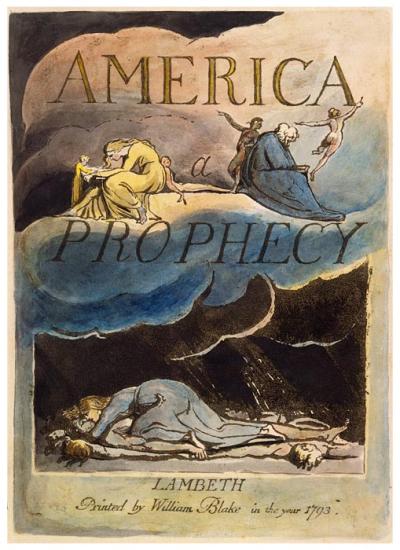
America: A Prophecy
Lambeth: Printed by William Blake, 1793
Relief etchings with hand coloring and white line etching
Copy A, printed ca. 1795
Purchased by Pierpont Morgan, 1909
William Blake (1757–1827) occupies a unique place in the history of Western art. His creativity included both the visual and literary arts. In his lifetime he was best known as an engraver; now he is also recognized for his innovative poetry, printmaking, and painting. Blake's keen perception of the political and social climate found expression throughout his work. His strong sense of independence is evident in the complex mythology that he constructed in response to the age of revolution.
Blake was already recognized as an engraver at age twenty-five, when his first volume of poems appeared. At thirty-three, in The Marriage of Heaven and Hell, he audaciously claimed that his birth had marked the origin of a "new heaven" in which his own art would exemplify the creativity prefigured by Milton and Michelangelo. By that time, Blake, in one of his most productive periods, had already produced Songs of Innocence and was at work on a series of illuminated books. In 1818 he met John Linnell, a young painter and engraver, through whom a group of young artists became Blake's followers. Calling themselves the Ancients, they helped perpetuate Blake's influence for generations.
The Morgan's Blake collection—one of this country's most distinguished—began with purchases as early as 1899 by Pierpont Morgan. During the tenure of Charles Ryskamp, director from 1969 to 1986, major gifts almost doubled the size of its Blake holdings. In recent years Ryskamp's own gifts of engravings, letters, and related materials have significantly enriched its scholarly resources.
IV. The Continental Prophecies
In 1790, Blake moved to Lambeth, where he produced a trilogy of illuminated books called the Continental Prophecies that addressed the politically charged spirit of his age, embodied by the American and French revolutions. Along with Europe and The Song of Los, America depicts the oppression exercised by monarchies and religions represented by Urizen. Although godlike in appearance, Urizen is a legalistic, despotic figure.
Another central figure is Orc, representing the spirit of revolt, who is frequently associated with images of fire. The frontispiece represents the destruction of war, while the text refers to George Washington, Thomas Paine, and other contemporary figures. America exists in only fourteen copies, five of which were colored and printed during Blake's lifetime. The Morgan also owns an uncolored copy.
This online exhibition is presented in conjunction with the exhibition William Blake's World: "A New Heaven Is Begun" on view September 11, 2009, through January 3, 2010.
This exhibition is made possible through the generosity of Fay and Geoffrey Elliott.
America: A Prophecy 5
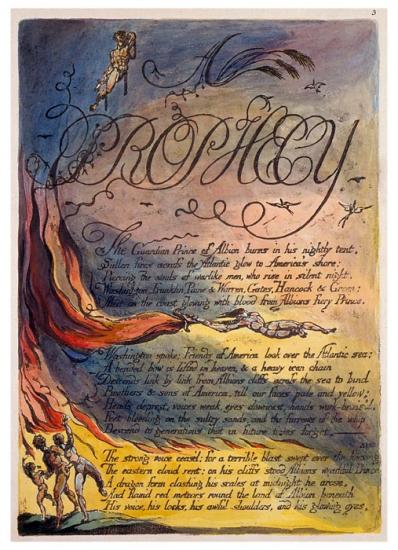
America: A Prophecy
Lambeth: Printed by William Blake, 1793
Relief etchings with hand coloring and white line etching
Copy A, printed ca. 1795
Purchased by Pierpont Morgan, 1909
William Blake (1757–1827) occupies a unique place in the history of Western art. His creativity included both the visual and literary arts. In his lifetime he was best known as an engraver; now he is also recognized for his innovative poetry, printmaking, and painting. Blake's keen perception of the political and social climate found expression throughout his work. His strong sense of independence is evident in the complex mythology that he constructed in response to the age of revolution.
Blake was already recognized as an engraver at age twenty-five, when his first volume of poems appeared. At thirty-three, in The Marriage of Heaven and Hell, he audaciously claimed that his birth had marked the origin of a "new heaven" in which his own art would exemplify the creativity prefigured by Milton and Michelangelo. By that time, Blake, in one of his most productive periods, had already produced Songs of Innocence and was at work on a series of illuminated books. In 1818 he met John Linnell, a young painter and engraver, through whom a group of young artists became Blake's followers. Calling themselves the Ancients, they helped perpetuate Blake's influence for generations.
The Morgan's Blake collection—one of this country's most distinguished—began with purchases as early as 1899 by Pierpont Morgan. During the tenure of Charles Ryskamp, director from 1969 to 1986, major gifts almost doubled the size of its Blake holdings. In recent years Ryskamp's own gifts of engravings, letters, and related materials have significantly enriched its scholarly resources.
IV. The Continental Prophecies
In 1790, Blake moved to Lambeth, where he produced a trilogy of illuminated books called the Continental Prophecies that addressed the politically charged spirit of his age, embodied by the American and French revolutions. Along with Europe and The Song of Los, America depicts the oppression exercised by monarchies and religions represented by Urizen. Although godlike in appearance, Urizen is a legalistic, despotic figure.
Another central figure is Orc, representing the spirit of revolt, who is frequently associated with images of fire. The frontispiece represents the destruction of war, while the text refers to George Washington, Thomas Paine, and other contemporary figures. America exists in only fourteen copies, five of which were colored and printed during Blake's lifetime. The Morgan also owns an uncolored copy.
This online exhibition is presented in conjunction with the exhibition William Blake's World: "A New Heaven Is Begun" on view September 11, 2009, through January 3, 2010.
This exhibition is made possible through the generosity of Fay and Geoffrey Elliott.
America: A Prophecy 3
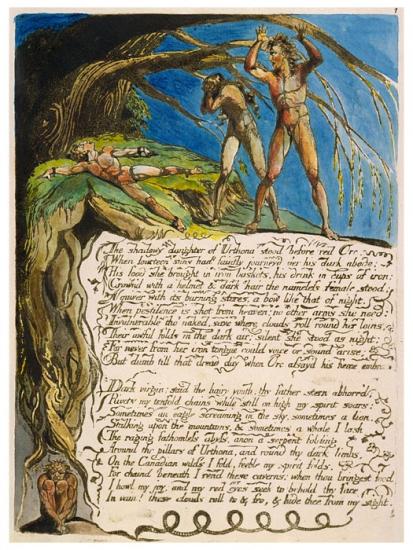
America: A Prophecy
Lambeth: Printed by William Blake, 1793
Relief etchings with hand coloring and white line etching
Copy A, printed ca. 1795
Purchased by Pierpont Morgan, 1909
William Blake (1757–1827) occupies a unique place in the history of Western art. His creativity included both the visual and literary arts. In his lifetime he was best known as an engraver; now he is also recognized for his innovative poetry, printmaking, and painting. Blake's keen perception of the political and social climate found expression throughout his work. His strong sense of independence is evident in the complex mythology that he constructed in response to the age of revolution.
Blake was already recognized as an engraver at age twenty-five, when his first volume of poems appeared. At thirty-three, in The Marriage of Heaven and Hell, he audaciously claimed that his birth had marked the origin of a "new heaven" in which his own art would exemplify the creativity prefigured by Milton and Michelangelo. By that time, Blake, in one of his most productive periods, had already produced Songs of Innocence and was at work on a series of illuminated books. In 1818 he met John Linnell, a young painter and engraver, through whom a group of young artists became Blake's followers. Calling themselves the Ancients, they helped perpetuate Blake's influence for generations.
The Morgan's Blake collection—one of this country's most distinguished—began with purchases as early as 1899 by Pierpont Morgan. During the tenure of Charles Ryskamp, director from 1969 to 1986, major gifts almost doubled the size of its Blake holdings. In recent years Ryskamp's own gifts of engravings, letters, and related materials have significantly enriched its scholarly resources.
IV. The Continental Prophecies
In 1790, Blake moved to Lambeth, where he produced a trilogy of illuminated books called the Continental Prophecies that addressed the politically charged spirit of his age, embodied by the American and French revolutions. Along with Europe and The Song of Los, America depicts the oppression exercised by monarchies and religions represented by Urizen. Although godlike in appearance, Urizen is a legalistic, despotic figure.
Another central figure is Orc, representing the spirit of revolt, who is frequently associated with images of fire. The frontispiece represents the destruction of war, while the text refers to George Washington, Thomas Paine, and other contemporary figures. America exists in only fourteen copies, five of which were colored and printed during Blake's lifetime. The Morgan also owns an uncolored copy.
This online exhibition is presented in conjunction with the exhibition William Blake's World: "A New Heaven Is Begun" on view September 11, 2009, through January 3, 2010.
This exhibition is made possible through the generosity of Fay and Geoffrey Elliott.
America: A Prophecy 6
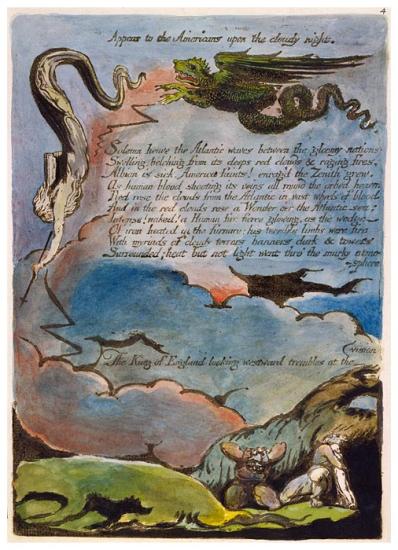
America: A Prophecy
Lambeth: Printed by William Blake, 1793
Relief etchings with hand coloring and white line etching
Copy A, printed ca. 1795
Purchased by Pierpont Morgan, 1909
William Blake (1757–1827) occupies a unique place in the history of Western art. His creativity included both the visual and literary arts. In his lifetime he was best known as an engraver; now he is also recognized for his innovative poetry, printmaking, and painting. Blake's keen perception of the political and social climate found expression throughout his work. His strong sense of independence is evident in the complex mythology that he constructed in response to the age of revolution.
Blake was already recognized as an engraver at age twenty-five, when his first volume of poems appeared. At thirty-three, in The Marriage of Heaven and Hell, he audaciously claimed that his birth had marked the origin of a "new heaven" in which his own art would exemplify the creativity prefigured by Milton and Michelangelo. By that time, Blake, in one of his most productive periods, had already produced Songs of Innocence and was at work on a series of illuminated books. In 1818 he met John Linnell, a young painter and engraver, through whom a group of young artists became Blake's followers. Calling themselves the Ancients, they helped perpetuate Blake's influence for generations.
The Morgan's Blake collection—one of this country's most distinguished—began with purchases as early as 1899 by Pierpont Morgan. During the tenure of Charles Ryskamp, director from 1969 to 1986, major gifts almost doubled the size of its Blake holdings. In recent years Ryskamp's own gifts of engravings, letters, and related materials have significantly enriched its scholarly resources.
IV. The Continental Prophecies
In 1790, Blake moved to Lambeth, where he produced a trilogy of illuminated books called the Continental Prophecies that addressed the politically charged spirit of his age, embodied by the American and French revolutions. Along with Europe and The Song of Los, America depicts the oppression exercised by monarchies and religions represented by Urizen. Although godlike in appearance, Urizen is a legalistic, despotic figure.
Another central figure is Orc, representing the spirit of revolt, who is frequently associated with images of fire. The frontispiece represents the destruction of war, while the text refers to George Washington, Thomas Paine, and other contemporary figures. America exists in only fourteen copies, five of which were colored and printed during Blake's lifetime. The Morgan also owns an uncolored copy.
This online exhibition is presented in conjunction with the exhibition William Blake's World: "A New Heaven Is Begun" on view September 11, 2009, through January 3, 2010.
This exhibition is made possible through the generosity of Fay and Geoffrey Elliott.
America: A Prophecy 7

America: A Prophecy
Lambeth: Printed by William Blake, 1793
Relief etchings with hand coloring and white line etching
Copy A, printed ca. 1795
Purchased by Pierpont Morgan, 1909
William Blake (1757–1827) occupies a unique place in the history of Western art. His creativity included both the visual and literary arts. In his lifetime he was best known as an engraver; now he is also recognized for his innovative poetry, printmaking, and painting. Blake's keen perception of the political and social climate found expression throughout his work. His strong sense of independence is evident in the complex mythology that he constructed in response to the age of revolution.
Blake was already recognized as an engraver at age twenty-five, when his first volume of poems appeared. At thirty-three, in The Marriage of Heaven and Hell, he audaciously claimed that his birth had marked the origin of a "new heaven" in which his own art would exemplify the creativity prefigured by Milton and Michelangelo. By that time, Blake, in one of his most productive periods, had already produced Songs of Innocence and was at work on a series of illuminated books. In 1818 he met John Linnell, a young painter and engraver, through whom a group of young artists became Blake's followers. Calling themselves the Ancients, they helped perpetuate Blake's influence for generations.
The Morgan's Blake collection—one of this country's most distinguished—began with purchases as early as 1899 by Pierpont Morgan. During the tenure of Charles Ryskamp, director from 1969 to 1986, major gifts almost doubled the size of its Blake holdings. In recent years Ryskamp's own gifts of engravings, letters, and related materials have significantly enriched its scholarly resources.
IV. The Continental Prophecies
In 1790, Blake moved to Lambeth, where he produced a trilogy of illuminated books called the Continental Prophecies that addressed the politically charged spirit of his age, embodied by the American and French revolutions. Along with Europe and The Song of Los, America depicts the oppression exercised by monarchies and religions represented by Urizen. Although godlike in appearance, Urizen is a legalistic, despotic figure.
Another central figure is Orc, representing the spirit of revolt, who is frequently associated with images of fire. The frontispiece represents the destruction of war, while the text refers to George Washington, Thomas Paine, and other contemporary figures. America exists in only fourteen copies, five of which were colored and printed during Blake's lifetime. The Morgan also owns an uncolored copy.
This online exhibition is presented in conjunction with the exhibition William Blake's World: "A New Heaven Is Begun" on view September 11, 2009, through January 3, 2010.
This exhibition is made possible through the generosity of Fay and Geoffrey Elliott.
America: A Prophecy 8
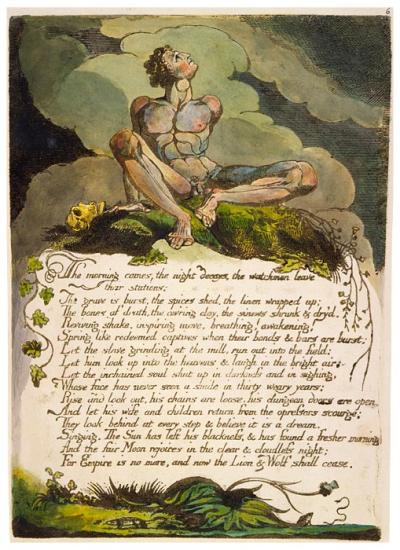
America: A Prophecy
Lambeth: Printed by William Blake, 1793
Relief etchings with hand coloring and white line etching
Copy A, printed ca. 1795
Purchased by Pierpont Morgan, 1909
William Blake (1757–1827) occupies a unique place in the history of Western art. His creativity included both the visual and literary arts. In his lifetime he was best known as an engraver; now he is also recognized for his innovative poetry, printmaking, and painting. Blake's keen perception of the political and social climate found expression throughout his work. His strong sense of independence is evident in the complex mythology that he constructed in response to the age of revolution.
Blake was already recognized as an engraver at age twenty-five, when his first volume of poems appeared. At thirty-three, in The Marriage of Heaven and Hell, he audaciously claimed that his birth had marked the origin of a "new heaven" in which his own art would exemplify the creativity prefigured by Milton and Michelangelo. By that time, Blake, in one of his most productive periods, had already produced Songs of Innocence and was at work on a series of illuminated books. In 1818 he met John Linnell, a young painter and engraver, through whom a group of young artists became Blake's followers. Calling themselves the Ancients, they helped perpetuate Blake's influence for generations.
The Morgan's Blake collection—one of this country's most distinguished—began with purchases as early as 1899 by Pierpont Morgan. During the tenure of Charles Ryskamp, director from 1969 to 1986, major gifts almost doubled the size of its Blake holdings. In recent years Ryskamp's own gifts of engravings, letters, and related materials have significantly enriched its scholarly resources.
IV. The Continental Prophecies
In 1790, Blake moved to Lambeth, where he produced a trilogy of illuminated books called the Continental Prophecies that addressed the politically charged spirit of his age, embodied by the American and French revolutions. Along with Europe and The Song of Los, America depicts the oppression exercised by monarchies and religions represented by Urizen. Although godlike in appearance, Urizen is a legalistic, despotic figure.
Another central figure is Orc, representing the spirit of revolt, who is frequently associated with images of fire. The frontispiece represents the destruction of war, while the text refers to George Washington, Thomas Paine, and other contemporary figures. America exists in only fourteen copies, five of which were colored and printed during Blake's lifetime. The Morgan also owns an uncolored copy.
This online exhibition is presented in conjunction with the exhibition William Blake's World: "A New Heaven Is Begun" on view September 11, 2009, through January 3, 2010.
This exhibition is made possible through the generosity of Fay and Geoffrey Elliott.
America, a Prophecy 9
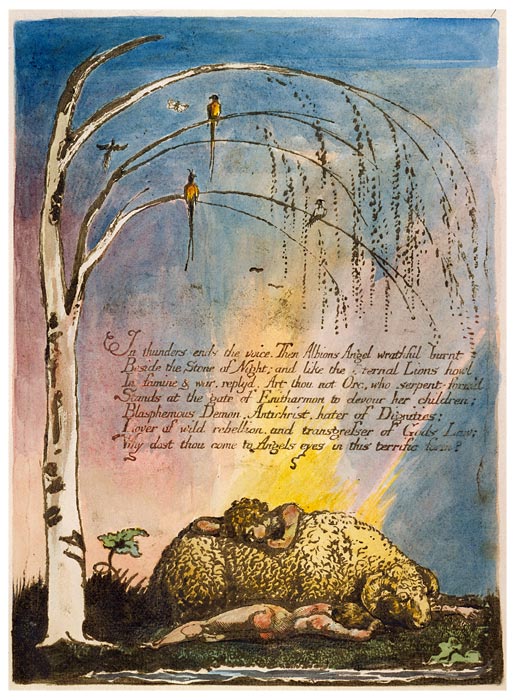
America, a Prophecy
Copy A
Lambeth, 1793 (i.e., 1795)
Purchased by Pierpont Morgan in 1909
IV. The Continental Prophecies
In 1790, Blake moved to Lambeth, where he produced a trilogy of illuminated books called the Continental Prophecies that addressed the politically charged spirit of his age, embodied by the American and French revolutions. Along with Europe and The Song of Los, America depicts the oppression exercised by monarchies and religions represented by Urizen. Although godlike in appearance, Urizen is a legalistic, despotic figure.
Another central figure is Orc, representing the spirit of revolt, who is frequently associated with images of fire. The frontispiece represents the destruction of war, while the text refers to George Washington, Thomas Paine, and other contemporary figures. America exists in only fourteen copies, five of which were colored and printed during Blake's lifetime. The Morgan also owns an uncolored copy.
This online exhibition is presented in conjunction with the exhibition William Blake's World: "A New Heaven Is Begun" on view September 11, 2009, through January 3, 2010.
This exhibition is made possible through the generosity of Fay and Geoffrey Elliott.
America: A Prophecy 10
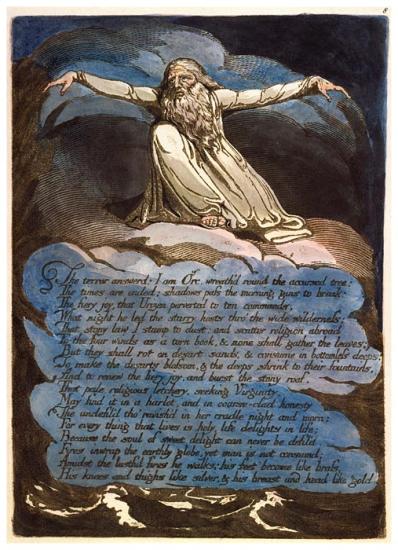
America: A Prophecy
Lambeth: Printed by William Blake, 1793
Relief etchings with hand coloring and white line etching
Copy A, printed ca. 1795
Purchased by Pierpont Morgan, 1909
William Blake (1757–1827) occupies a unique place in the history of Western art. His creativity included both the visual and literary arts. In his lifetime he was best known as an engraver; now he is also recognized for his innovative poetry, printmaking, and painting. Blake's keen perception of the political and social climate found expression throughout his work. His strong sense of independence is evident in the complex mythology that he constructed in response to the age of revolution.
Blake was already recognized as an engraver at age twenty-five, when his first volume of poems appeared. At thirty-three, in The Marriage of Heaven and Hell, he audaciously claimed that his birth had marked the origin of a "new heaven" in which his own art would exemplify the creativity prefigured by Milton and Michelangelo. By that time, Blake, in one of his most productive periods, had already produced Songs of Innocence and was at work on a series of illuminated books. In 1818 he met John Linnell, a young painter and engraver, through whom a group of young artists became Blake's followers. Calling themselves the Ancients, they helped perpetuate Blake's influence for generations.
The Morgan's Blake collection—one of this country's most distinguished—began with purchases as early as 1899 by Pierpont Morgan. During the tenure of Charles Ryskamp, director from 1969 to 1986, major gifts almost doubled the size of its Blake holdings. In recent years Ryskamp's own gifts of engravings, letters, and related materials have significantly enriched its scholarly resources.
IV. The Continental Prophecies
In 1790, Blake moved to Lambeth, where he produced a trilogy of illuminated books called the Continental Prophecies that addressed the politically charged spirit of his age, embodied by the American and French revolutions. Along with Europe and The Song of Los, America depicts the oppression exercised by monarchies and religions represented by Urizen. Although godlike in appearance, Urizen is a legalistic, despotic figure.
Another central figure is Orc, representing the spirit of revolt, who is frequently associated with images of fire. The frontispiece represents the destruction of war, while the text refers to George Washington, Thomas Paine, and other contemporary figures. America exists in only fourteen copies, five of which were colored and printed during Blake's lifetime. The Morgan also owns an uncolored copy.
This online exhibition is presented in conjunction with the exhibition William Blake's World: "A New Heaven Is Begun" on view September 11, 2009, through January 3, 2010.
This exhibition is made possible through the generosity of Fay and Geoffrey Elliott.
America: A Prophecy 11

America: A Prophecy
Lambeth: Printed by William Blake, 1793
Relief etchings with hand coloring and white line etching
Copy A, printed ca. 1795
Purchased by Pierpont Morgan, 1909
William Blake (1757–1827) occupies a unique place in the history of Western art. His creativity included both the visual and literary arts. In his lifetime he was best known as an engraver; now he is also recognized for his innovative poetry, printmaking, and painting. Blake's keen perception of the political and social climate found expression throughout his work. His strong sense of independence is evident in the complex mythology that he constructed in response to the age of revolution.
Blake was already recognized as an engraver at age twenty-five, when his first volume of poems appeared. At thirty-three, in The Marriage of Heaven and Hell, he audaciously claimed that his birth had marked the origin of a "new heaven" in which his own art would exemplify the creativity prefigured by Milton and Michelangelo. By that time, Blake, in one of his most productive periods, had already produced Songs of Innocence and was at work on a series of illuminated books. In 1818 he met John Linnell, a young painter and engraver, through whom a group of young artists became Blake's followers. Calling themselves the Ancients, they helped perpetuate Blake's influence for generations.
The Morgan's Blake collection—one of this country's most distinguished—began with purchases as early as 1899 by Pierpont Morgan. During the tenure of Charles Ryskamp, director from 1969 to 1986, major gifts almost doubled the size of its Blake holdings. In recent years Ryskamp's own gifts of engravings, letters, and related materials have significantly enriched its scholarly resources.
IV. The Continental Prophecies
In 1790, Blake moved to Lambeth, where he produced a trilogy of illuminated books called the Continental Prophecies that addressed the politically charged spirit of his age, embodied by the American and French revolutions. Along with Europe and The Song of Los, America depicts the oppression exercised by monarchies and religions represented by Urizen. Although godlike in appearance, Urizen is a legalistic, despotic figure.
Another central figure is Orc, representing the spirit of revolt, who is frequently associated with images of fire. The frontispiece represents the destruction of war, while the text refers to George Washington, Thomas Paine, and other contemporary figures. America exists in only fourteen copies, five of which were colored and printed during Blake's lifetime. The Morgan also owns an uncolored copy.
This online exhibition is presented in conjunction with the exhibition William Blake's World: "A New Heaven Is Begun" on view September 11, 2009, through January 3, 2010.
This exhibition is made possible through the generosity of Fay and Geoffrey Elliott.
America: A Prophecy 12
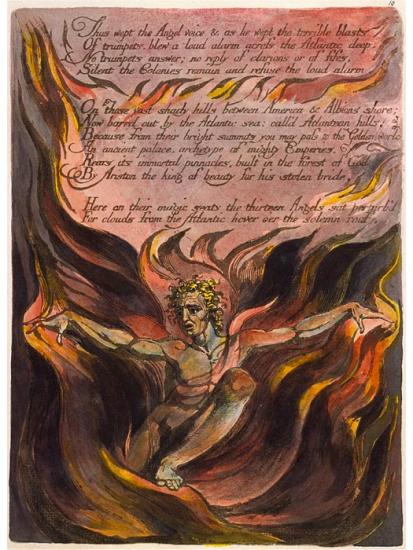
America: A Prophecy
Lambeth: Printed by William Blake, 1793
Relief etchings with hand coloring and white line etching
Copy A, printed ca. 1795
Purchased by Pierpont Morgan, 1909
William Blake (1757–1827) occupies a unique place in the history of Western art. His creativity included both the visual and literary arts. In his lifetime he was best known as an engraver; now he is also recognized for his innovative poetry, printmaking, and painting. Blake's keen perception of the political and social climate found expression throughout his work. His strong sense of independence is evident in the complex mythology that he constructed in response to the age of revolution.
Blake was already recognized as an engraver at age twenty-five, when his first volume of poems appeared. At thirty-three, in The Marriage of Heaven and Hell, he audaciously claimed that his birth had marked the origin of a "new heaven" in which his own art would exemplify the creativity prefigured by Milton and Michelangelo. By that time, Blake, in one of his most productive periods, had already produced Songs of Innocence and was at work on a series of illuminated books. In 1818 he met John Linnell, a young painter and engraver, through whom a group of young artists became Blake's followers. Calling themselves the Ancients, they helped perpetuate Blake's influence for generations.
The Morgan's Blake collection—one of this country's most distinguished—began with purchases as early as 1899 by Pierpont Morgan. During the tenure of Charles Ryskamp, director from 1969 to 1986, major gifts almost doubled the size of its Blake holdings. In recent years Ryskamp's own gifts of engravings, letters, and related materials have significantly enriched its scholarly resources.
IV. The Continental Prophecies
In 1790, Blake moved to Lambeth, where he produced a trilogy of illuminated books called the Continental Prophecies that addressed the politically charged spirit of his age, embodied by the American and French revolutions. Along with Europe and The Song of Los, America depicts the oppression exercised by monarchies and religions represented by Urizen. Although godlike in appearance, Urizen is a legalistic, despotic figure.
Another central figure is Orc, representing the spirit of revolt, who is frequently associated with images of fire. The frontispiece represents the destruction of war, while the text refers to George Washington, Thomas Paine, and other contemporary figures. America exists in only fourteen copies, five of which were colored and printed during Blake's lifetime. The Morgan also owns an uncolored copy.
This online exhibition is presented in conjunction with the exhibition William Blake's World: "A New Heaven Is Begun" on view September 11, 2009, through January 3, 2010.
This exhibition is made possible through the generosity of Fay and Geoffrey Elliott.
America: A Prophecy 13
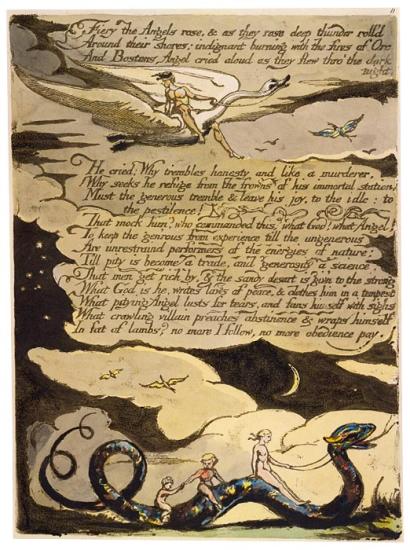
America: A Prophecy
Lambeth: Printed by William Blake, 1793
Relief etchings with hand coloring and white line etching
Copy A, printed ca. 1795
Purchased by Pierpont Morgan, 1909
William Blake (1757–1827) occupies a unique place in the history of Western art. His creativity included both the visual and literary arts. In his lifetime he was best known as an engraver; now he is also recognized for his innovative poetry, printmaking, and painting. Blake's keen perception of the political and social climate found expression throughout his work. His strong sense of independence is evident in the complex mythology that he constructed in response to the age of revolution.
Blake was already recognized as an engraver at age twenty-five, when his first volume of poems appeared. At thirty-three, in The Marriage of Heaven and Hell, he audaciously claimed that his birth had marked the origin of a "new heaven" in which his own art would exemplify the creativity prefigured by Milton and Michelangelo. By that time, Blake, in one of his most productive periods, had already produced Songs of Innocence and was at work on a series of illuminated books. In 1818 he met John Linnell, a young painter and engraver, through whom a group of young artists became Blake's followers. Calling themselves the Ancients, they helped perpetuate Blake's influence for generations.
The Morgan's Blake collection—one of this country's most distinguished—began with purchases as early as 1899 by Pierpont Morgan. During the tenure of Charles Ryskamp, director from 1969 to 1986, major gifts almost doubled the size of its Blake holdings. In recent years Ryskamp's own gifts of engravings, letters, and related materials have significantly enriched its scholarly resources.
IV. The Continental Prophecies
In 1790, Blake moved to Lambeth, where he produced a trilogy of illuminated books called the Continental Prophecies that addressed the politically charged spirit of his age, embodied by the American and French revolutions. Along with Europe and The Song of Los, America depicts the oppression exercised by monarchies and religions represented by Urizen. Although godlike in appearance, Urizen is a legalistic, despotic figure.
Another central figure is Orc, representing the spirit of revolt, who is frequently associated with images of fire. The frontispiece represents the destruction of war, while the text refers to George Washington, Thomas Paine, and other contemporary figures. America exists in only fourteen copies, five of which were colored and printed during Blake's lifetime. The Morgan also owns an uncolored copy.
This online exhibition is presented in conjunction with the exhibition William Blake's World: "A New Heaven Is Begun" on view September 11, 2009, through January 3, 2010.
This exhibition is made possible through the generosity of Fay and Geoffrey Elliott.
America: A Prophecy 14

America: A Prophecy
Lambeth: Printed by William Blake, 1793
Relief etchings with hand coloring and white line etching
Copy A, printed ca. 1795
Purchased by Pierpont Morgan, 1909
William Blake (1757–1827) occupies a unique place in the history of Western art. His creativity included both the visual and literary arts. In his lifetime he was best known as an engraver; now he is also recognized for his innovative poetry, printmaking, and painting. Blake's keen perception of the political and social climate found expression throughout his work. His strong sense of independence is evident in the complex mythology that he constructed in response to the age of revolution.
Blake was already recognized as an engraver at age twenty-five, when his first volume of poems appeared. At thirty-three, in The Marriage of Heaven and Hell, he audaciously claimed that his birth had marked the origin of a "new heaven" in which his own art would exemplify the creativity prefigured by Milton and Michelangelo. By that time, Blake, in one of his most productive periods, had already produced Songs of Innocence and was at work on a series of illuminated books. In 1818 he met John Linnell, a young painter and engraver, through whom a group of young artists became Blake's followers. Calling themselves the Ancients, they helped perpetuate Blake's influence for generations.
The Morgan's Blake collection—one of this country's most distinguished—began with purchases as early as 1899 by Pierpont Morgan. During the tenure of Charles Ryskamp, director from 1969 to 1986, major gifts almost doubled the size of its Blake holdings. In recent years Ryskamp's own gifts of engravings, letters, and related materials have significantly enriched its scholarly resources.
IV. The Continental Prophecies
In 1790, Blake moved to Lambeth, where he produced a trilogy of illuminated books called the Continental Prophecies that addressed the politically charged spirit of his age, embodied by the American and French revolutions. Along with Europe and The Song of Los, America depicts the oppression exercised by monarchies and religions represented by Urizen. Although godlike in appearance, Urizen is a legalistic, despotic figure.
Another central figure is Orc, representing the spirit of revolt, who is frequently associated with images of fire. The frontispiece represents the destruction of war, while the text refers to George Washington, Thomas Paine, and other contemporary figures. America exists in only fourteen copies, five of which were colored and printed during Blake's lifetime. The Morgan also owns an uncolored copy.
This online exhibition is presented in conjunction with the exhibition William Blake's World: "A New Heaven Is Begun" on view September 11, 2009, through January 3, 2010.
This exhibition is made possible through the generosity of Fay and Geoffrey Elliott.
America: A Prophecy 15
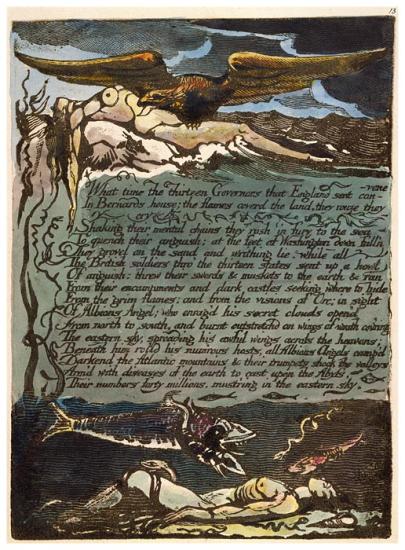
America: A Prophecy
Lambeth: Printed by William Blake, 1793
Relief etchings with hand coloring and white line etching
Copy A, printed ca. 1795
Purchased by Pierpont Morgan, 1909
William Blake (1757–1827) occupies a unique place in the history of Western art. His creativity included both the visual and literary arts. In his lifetime he was best known as an engraver; now he is also recognized for his innovative poetry, printmaking, and painting. Blake's keen perception of the political and social climate found expression throughout his work. His strong sense of independence is evident in the complex mythology that he constructed in response to the age of revolution.
Blake was already recognized as an engraver at age twenty-five, when his first volume of poems appeared. At thirty-three, in The Marriage of Heaven and Hell, he audaciously claimed that his birth had marked the origin of a "new heaven" in which his own art would exemplify the creativity prefigured by Milton and Michelangelo. By that time, Blake, in one of his most productive periods, had already produced Songs of Innocence and was at work on a series of illuminated books. In 1818 he met John Linnell, a young painter and engraver, through whom a group of young artists became Blake's followers. Calling themselves the Ancients, they helped perpetuate Blake's influence for generations.
The Morgan's Blake collection—one of this country's most distinguished—began with purchases as early as 1899 by Pierpont Morgan. During the tenure of Charles Ryskamp, director from 1969 to 1986, major gifts almost doubled the size of its Blake holdings. In recent years Ryskamp's own gifts of engravings, letters, and related materials have significantly enriched its scholarly resources.
IV. The Continental Prophecies
In 1790, Blake moved to Lambeth, where he produced a trilogy of illuminated books called the Continental Prophecies that addressed the politically charged spirit of his age, embodied by the American and French revolutions. Along with Europe and The Song of Los, America depicts the oppression exercised by monarchies and religions represented by Urizen. Although godlike in appearance, Urizen is a legalistic, despotic figure.
Another central figure is Orc, representing the spirit of revolt, who is frequently associated with images of fire. The frontispiece represents the destruction of war, while the text refers to George Washington, Thomas Paine, and other contemporary figures. America exists in only fourteen copies, five of which were colored and printed during Blake's lifetime. The Morgan also owns an uncolored copy.
This online exhibition is presented in conjunction with the exhibition William Blake's World: "A New Heaven Is Begun" on view September 11, 2009, through January 3, 2010.
This exhibition is made possible through the generosity of Fay and Geoffrey Elliott.
America: A Prophecy 16
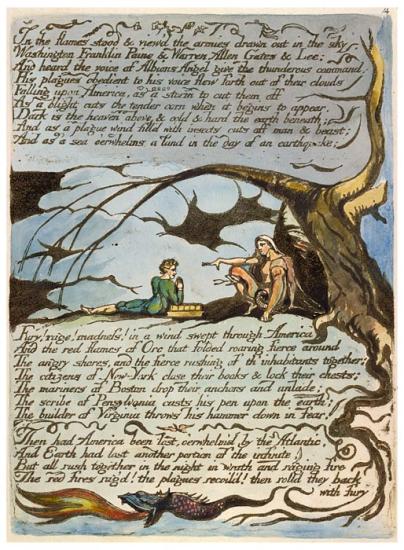
America: A Prophecy
Lambeth: Printed by William Blake, 1793
Relief etchings with hand coloring and white line etching
Copy A, printed ca. 1795
Purchased by Pierpont Morgan, 1909
William Blake (1757–1827) occupies a unique place in the history of Western art. His creativity included both the visual and literary arts. In his lifetime he was best known as an engraver; now he is also recognized for his innovative poetry, printmaking, and painting. Blake's keen perception of the political and social climate found expression throughout his work. His strong sense of independence is evident in the complex mythology that he constructed in response to the age of revolution.
Blake was already recognized as an engraver at age twenty-five, when his first volume of poems appeared. At thirty-three, in The Marriage of Heaven and Hell, he audaciously claimed that his birth had marked the origin of a "new heaven" in which his own art would exemplify the creativity prefigured by Milton and Michelangelo. By that time, Blake, in one of his most productive periods, had already produced Songs of Innocence and was at work on a series of illuminated books. In 1818 he met John Linnell, a young painter and engraver, through whom a group of young artists became Blake's followers. Calling themselves the Ancients, they helped perpetuate Blake's influence for generations.
The Morgan's Blake collection—one of this country's most distinguished—began with purchases as early as 1899 by Pierpont Morgan. During the tenure of Charles Ryskamp, director from 1969 to 1986, major gifts almost doubled the size of its Blake holdings. In recent years Ryskamp's own gifts of engravings, letters, and related materials have significantly enriched its scholarly resources.
IV. The Continental Prophecies
In 1790, Blake moved to Lambeth, where he produced a trilogy of illuminated books called the Continental Prophecies that addressed the politically charged spirit of his age, embodied by the American and French revolutions. Along with Europe and The Song of Los, America depicts the oppression exercised by monarchies and religions represented by Urizen. Although godlike in appearance, Urizen is a legalistic, despotic figure.
Another central figure is Orc, representing the spirit of revolt, who is frequently associated with images of fire. The frontispiece represents the destruction of war, while the text refers to George Washington, Thomas Paine, and other contemporary figures. America exists in only fourteen copies, five of which were colored and printed during Blake's lifetime. The Morgan also owns an uncolored copy.
This online exhibition is presented in conjunction with the exhibition William Blake's World: "A New Heaven Is Begun" on view September 11, 2009, through January 3, 2010.
This exhibition is made possible through the generosity of Fay and Geoffrey Elliott.
America: A Prophecy 17
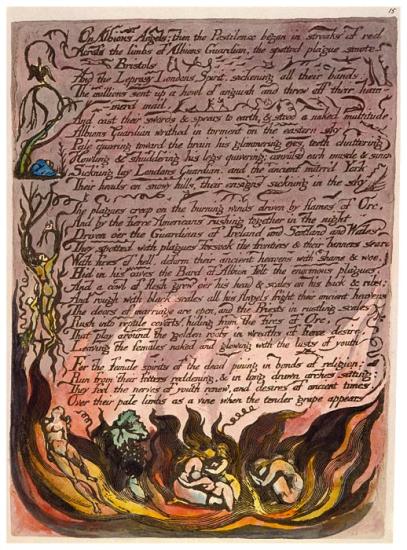
America: A Prophecy
Lambeth: Printed by William Blake, 1793
Relief etchings with hand coloring and white line etching
Copy A, printed ca. 1795
Purchased by Pierpont Morgan, 1909
William Blake (1757–1827) occupies a unique place in the history of Western art. His creativity included both the visual and literary arts. In his lifetime he was best known as an engraver; now he is also recognized for his innovative poetry, printmaking, and painting. Blake's keen perception of the political and social climate found expression throughout his work. His strong sense of independence is evident in the complex mythology that he constructed in response to the age of revolution.
Blake was already recognized as an engraver at age twenty-five, when his first volume of poems appeared. At thirty-three, in The Marriage of Heaven and Hell, he audaciously claimed that his birth had marked the origin of a "new heaven" in which his own art would exemplify the creativity prefigured by Milton and Michelangelo. By that time, Blake, in one of his most productive periods, had already produced Songs of Innocence and was at work on a series of illuminated books. In 1818 he met John Linnell, a young painter and engraver, through whom a group of young artists became Blake's followers. Calling themselves the Ancients, they helped perpetuate Blake's influence for generations.
The Morgan's Blake collection—one of this country's most distinguished—began with purchases as early as 1899 by Pierpont Morgan. During the tenure of Charles Ryskamp, director from 1969 to 1986, major gifts almost doubled the size of its Blake holdings. In recent years Ryskamp's own gifts of engravings, letters, and related materials have significantly enriched its scholarly resources.
IV. The Continental Prophecies
In 1790, Blake moved to Lambeth, where he produced a trilogy of illuminated books called the Continental Prophecies that addressed the politically charged spirit of his age, embodied by the American and French revolutions. Along with Europe and The Song of Los, America depicts the oppression exercised by monarchies and religions represented by Urizen. Although godlike in appearance, Urizen is a legalistic, despotic figure.
Another central figure is Orc, representing the spirit of revolt, who is frequently associated with images of fire. The frontispiece represents the destruction of war, while the text refers to George Washington, Thomas Paine, and other contemporary figures. America exists in only fourteen copies, five of which were colored and printed during Blake's lifetime. The Morgan also owns an uncolored copy.
This online exhibition is presented in conjunction with the exhibition William Blake's World: "A New Heaven Is Begun" on view September 11, 2009, through January 3, 2010.
This exhibition is made possible through the generosity of Fay and Geoffrey Elliott.
America: A Prophecy 18
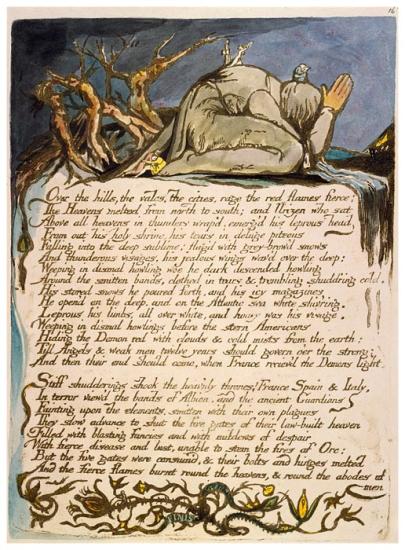
America: A Prophecy
Lambeth: Printed by William Blake, 1793
Relief etchings with hand coloring and white line etching
Copy A, printed ca. 1795
Purchased by Pierpont Morgan, 1909
William Blake (1757–1827) occupies a unique place in the history of Western art. His creativity included both the visual and literary arts. In his lifetime he was best known as an engraver; now he is also recognized for his innovative poetry, printmaking, and painting. Blake's keen perception of the political and social climate found expression throughout his work. His strong sense of independence is evident in the complex mythology that he constructed in response to the age of revolution.
Blake was already recognized as an engraver at age twenty-five, when his first volume of poems appeared. At thirty-three, in The Marriage of Heaven and Hell, he audaciously claimed that his birth had marked the origin of a "new heaven" in which his own art would exemplify the creativity prefigured by Milton and Michelangelo. By that time, Blake, in one of his most productive periods, had already produced Songs of Innocence and was at work on a series of illuminated books. In 1818 he met John Linnell, a young painter and engraver, through whom a group of young artists became Blake's followers. Calling themselves the Ancients, they helped perpetuate Blake's influence for generations.
The Morgan's Blake collection—one of this country's most distinguished—began with purchases as early as 1899 by Pierpont Morgan. During the tenure of Charles Ryskamp, director from 1969 to 1986, major gifts almost doubled the size of its Blake holdings. In recent years Ryskamp's own gifts of engravings, letters, and related materials have significantly enriched its scholarly resources.
IV. The Continental Prophecies
In 1790, Blake moved to Lambeth, where he produced a trilogy of illuminated books called the Continental Prophecies that addressed the politically charged spirit of his age, embodied by the American and French revolutions. Along with Europe and The Song of Los, America depicts the oppression exercised by monarchies and religions represented by Urizen. Although godlike in appearance, Urizen is a legalistic, despotic figure.
Another central figure is Orc, representing the spirit of revolt, who is frequently associated with images of fire. The frontispiece represents the destruction of war, while the text refers to George Washington, Thomas Paine, and other contemporary figures. America exists in only fourteen copies, five of which were colored and printed during Blake's lifetime. The Morgan also owns an uncolored copy.
This online exhibition is presented in conjunction with the exhibition William Blake's World: "A New Heaven Is Begun" on view September 11, 2009, through January 3, 2010.
This exhibition is made possible through the generosity of Fay and Geoffrey Elliott.
Europe: A Prophecy 1
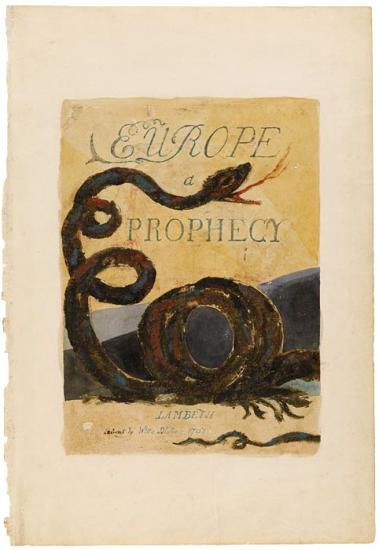
Europe: A Prophecy
Lambeth: Printed by Will: Blake, 1794
Relief and white line etching with color
Copy G, printed 1794
Purchased on The Thorne Family and Fellows Fund in memory of Mrs. Landon K. Thorne, 1976
Europe is the second of Blake's great illuminated books concerning the revolutionary spirit of his age. Rather than examining the New World, this Continental Prophecy looks eastward to consider cultures subjected to the strictures of authority embodied by Urizen, who, despite his appearance, represents tyranny.
The frontispiece depicting Urizen dividing the deep with a compass is one of Blake's best–known images. It also exists as a separate print called The Ancient of Days. The Morgan's copy of Europe, one of only nine, was printed in 1794.
William Blake (1757–1827) occupies a unique place in the history of Western art. His creativity included both the visual and literary arts. In his lifetime he was best known as an engraver; now he is also recognized for his innovative poetry, printmaking, and painting. Blake's keen perception of the political and social climate found expression throughout his work. His strong sense of independence is evident in the complex mythology that he constructed in response to the age of revolution.
Blake was already recognized as an engraver at age twenty-five, when his first volume of poems appeared. At thirty-three, in The Marriage of Heaven and Hell, he audaciously claimed that his birth had marked the origin of a "new heaven" in which his own art would exemplify the creativity prefigured by Milton and Michelangelo. By that time, Blake, in one of his most productive periods, had already produced Songs of Innocence and was at work on a series of illuminated books. In 1818 he met John Linnell, a young painter and engraver, through whom a group of young artists became Blake's followers. Calling themselves the Ancients, they helped perpetuate Blake's influence for generations.
The Morgan's Blake collection—one of this country's most distinguished—began with purchases as early as 1899 by Pierpont Morgan. During the tenure of Charles Ryskamp, director from 1969 to 1986, major gifts almost doubled the size of its Blake holdings. In recent years Ryskamp's own gifts of engravings, letters, and related materials have significantly enriched its scholarly resources.
IV. The Continental Prophecies
In 1790, Blake moved to Lambeth, where he produced a trilogy of illuminated books called the Continental Prophecies that addressed the politically charged spirit of his age, embodied by the American and French revolutions. Along with Europe and The Song of Los, America depicts the oppression exercised by monarchies and religions represented by Urizen. Although godlike in appearance, Urizen is a legalistic, despotic figure.
Another central figure is Orc, representing the spirit of revolt, who is frequently associated with images of fire. The frontispiece represents the destruction of war, while the text refers to George Washington, Thomas Paine, and other contemporary figures. America exists in only fourteen copies, five of which were colored and printed during Blake's lifetime. The Morgan also owns an uncolored copy.
This online exhibition is presented in conjunction with the exhibition William Blake's World: "A New Heaven Is Begun" on view September 11, 2009, through January 3, 2010.
This exhibition is made possible through the generosity of Fay and Geoffrey Elliott.
Europe: A Prophecy 3
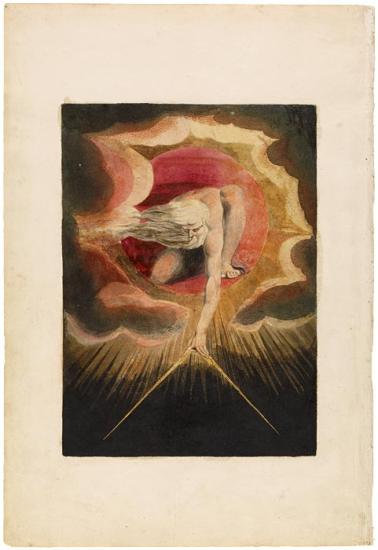
Europe: A Prophecy
Lambeth: Printed by Will: Blake, 1794
Relief and white line etching with color
Copy G, printed 1794
Purchased on The Thorne Family and Fellows Fund in memory of Mrs. Landon K. Thorne, 1976
Europe is the second of Blake's great illuminated books concerning the revolutionary spirit of his age. Rather than examining the New World, this Continental Prophecy looks eastward to consider cultures subjected to the strictures of authority embodied by Urizen, who, despite his appearance, represents tyranny.
The frontispiece depicting Urizen dividing the deep with a compass is one of Blake's best–known images. It also exists as a separate print called The Ancient of Days. The Morgan's copy of Europe, one of only nine, was printed in 1794.
William Blake (1757–1827) occupies a unique place in the history of Western art. His creativity included both the visual and literary arts. In his lifetime he was best known as an engraver; now he is also recognized for his innovative poetry, printmaking, and painting. Blake's keen perception of the political and social climate found expression throughout his work. His strong sense of independence is evident in the complex mythology that he constructed in response to the age of revolution.
Blake was already recognized as an engraver at age twenty-five, when his first volume of poems appeared. At thirty-three, in The Marriage of Heaven and Hell, he audaciously claimed that his birth had marked the origin of a "new heaven" in which his own art would exemplify the creativity prefigured by Milton and Michelangelo. By that time, Blake, in one of his most productive periods, had already produced Songs of Innocence and was at work on a series of illuminated books. In 1818 he met John Linnell, a young painter and engraver, through whom a group of young artists became Blake's followers. Calling themselves the Ancients, they helped perpetuate Blake's influence for generations.
The Morgan's Blake collection—one of this country's most distinguished—began with purchases as early as 1899 by Pierpont Morgan. During the tenure of Charles Ryskamp, director from 1969 to 1986, major gifts almost doubled the size of its Blake holdings. In recent years Ryskamp's own gifts of engravings, letters, and related materials have significantly enriched its scholarly resources.
IV. The Continental Prophecies
In 1790, Blake moved to Lambeth, where he produced a trilogy of illuminated books called the Continental Prophecies that addressed the politically charged spirit of his age, embodied by the American and French revolutions. Along with Europe and The Song of Los, America depicts the oppression exercised by monarchies and religions represented by Urizen. Although godlike in appearance, Urizen is a legalistic, despotic figure.
Another central figure is Orc, representing the spirit of revolt, who is frequently associated with images of fire. The frontispiece represents the destruction of war, while the text refers to George Washington, Thomas Paine, and other contemporary figures. America exists in only fourteen copies, five of which were colored and printed during Blake's lifetime. The Morgan also owns an uncolored copy.
This online exhibition is presented in conjunction with the exhibition William Blake's World: "A New Heaven Is Begun" on view September 11, 2009, through January 3, 2010.
This exhibition is made possible through the generosity of Fay and Geoffrey Elliott.
Europe: A Prophecy 4

Europe: A Prophecy
Lambeth: Printed by Will: Blake, 1794
Relief and white line etching with color
Copy G, printed 1794
Purchased on The Thorne Family and Fellows Fund in memory of Mrs. Landon K. Thorne, 1976
Europe is the second of Blake's great illuminated books concerning the revolutionary spirit of his age. Rather than examining the New World, this Continental Prophecy looks eastward to consider cultures subjected to the strictures of authority embodied by Urizen, who, despite his appearance, represents tyranny.
The frontispiece depicting Urizen dividing the deep with a compass is one of Blake's best–known images. It also exists as a separate print called The Ancient of Days. The Morgan's copy of Europe, one of only nine, was printed in 1794.
William Blake (1757–1827) occupies a unique place in the history of Western art. His creativity included both the visual and literary arts. In his lifetime he was best known as an engraver; now he is also recognized for his innovative poetry, printmaking, and painting. Blake's keen perception of the political and social climate found expression throughout his work. His strong sense of independence is evident in the complex mythology that he constructed in response to the age of revolution.
Blake was already recognized as an engraver at age twenty-five, when his first volume of poems appeared. At thirty-three, in The Marriage of Heaven and Hell, he audaciously claimed that his birth had marked the origin of a "new heaven" in which his own art would exemplify the creativity prefigured by Milton and Michelangelo. By that time, Blake, in one of his most productive periods, had already produced Songs of Innocence and was at work on a series of illuminated books. In 1818 he met John Linnell, a young painter and engraver, through whom a group of young artists became Blake's followers. Calling themselves the Ancients, they helped perpetuate Blake's influence for generations.
The Morgan's Blake collection—one of this country's most distinguished—began with purchases as early as 1899 by Pierpont Morgan. During the tenure of Charles Ryskamp, director from 1969 to 1986, major gifts almost doubled the size of its Blake holdings. In recent years Ryskamp's own gifts of engravings, letters, and related materials have significantly enriched its scholarly resources.
IV. The Continental Prophecies
In 1790, Blake moved to Lambeth, where he produced a trilogy of illuminated books called the Continental Prophecies that addressed the politically charged spirit of his age, embodied by the American and French revolutions. Along with Europe and The Song of Los, America depicts the oppression exercised by monarchies and religions represented by Urizen. Although godlike in appearance, Urizen is a legalistic, despotic figure.
Another central figure is Orc, representing the spirit of revolt, who is frequently associated with images of fire. The frontispiece represents the destruction of war, while the text refers to George Washington, Thomas Paine, and other contemporary figures. America exists in only fourteen copies, five of which were colored and printed during Blake's lifetime. The Morgan also owns an uncolored copy.
This online exhibition is presented in conjunction with the exhibition William Blake's World: "A New Heaven Is Begun" on view September 11, 2009, through January 3, 2010.
This exhibition is made possible through the generosity of Fay and Geoffrey Elliott.
Europe: A Prophecy 5
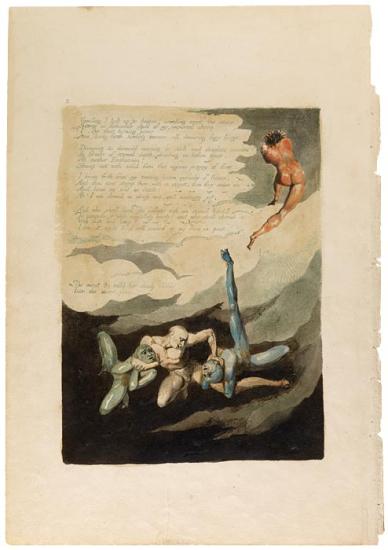
Europe: A Prophecy
Lambeth: Printed by Will: Blake, 1794
Relief and white line etching with color
Copy G, printed 1794
Purchased on The Thorne Family and Fellows Fund in memory of Mrs. Landon K. Thorne, 1976
Europe is the second of Blake's great illuminated books concerning the revolutionary spirit of his age. Rather than examining the New World, this Continental Prophecy looks eastward to consider cultures subjected to the strictures of authority embodied by Urizen, who, despite his appearance, represents tyranny.
The frontispiece depicting Urizen dividing the deep with a compass is one of Blake's best–known images. It also exists as a separate print called The Ancient of Days. The Morgan's copy of Europe, one of only nine, was printed in 1794.
William Blake (1757–1827) occupies a unique place in the history of Western art. His creativity included both the visual and literary arts. In his lifetime he was best known as an engraver; now he is also recognized for his innovative poetry, printmaking, and painting. Blake's keen perception of the political and social climate found expression throughout his work. His strong sense of independence is evident in the complex mythology that he constructed in response to the age of revolution.
Blake was already recognized as an engraver at age twenty-five, when his first volume of poems appeared. At thirty-three, in The Marriage of Heaven and Hell, he audaciously claimed that his birth had marked the origin of a "new heaven" in which his own art would exemplify the creativity prefigured by Milton and Michelangelo. By that time, Blake, in one of his most productive periods, had already produced Songs of Innocence and was at work on a series of illuminated books. In 1818 he met John Linnell, a young painter and engraver, through whom a group of young artists became Blake's followers. Calling themselves the Ancients, they helped perpetuate Blake's influence for generations.
The Morgan's Blake collection—one of this country's most distinguished—began with purchases as early as 1899 by Pierpont Morgan. During the tenure of Charles Ryskamp, director from 1969 to 1986, major gifts almost doubled the size of its Blake holdings. In recent years Ryskamp's own gifts of engravings, letters, and related materials have significantly enriched its scholarly resources.
IV. The Continental Prophecies
In 1790, Blake moved to Lambeth, where he produced a trilogy of illuminated books called the Continental Prophecies that addressed the politically charged spirit of his age, embodied by the American and French revolutions. Along with Europe and The Song of Los, America depicts the oppression exercised by monarchies and religions represented by Urizen. Although godlike in appearance, Urizen is a legalistic, despotic figure.
Another central figure is Orc, representing the spirit of revolt, who is frequently associated with images of fire. The frontispiece represents the destruction of war, while the text refers to George Washington, Thomas Paine, and other contemporary figures. America exists in only fourteen copies, five of which were colored and printed during Blake's lifetime. The Morgan also owns an uncolored copy.
This online exhibition is presented in conjunction with the exhibition William Blake's World: "A New Heaven Is Begun" on view September 11, 2009, through January 3, 2010.
This exhibition is made possible through the generosity of Fay and Geoffrey Elliott.
Europe: A Prophecy 6
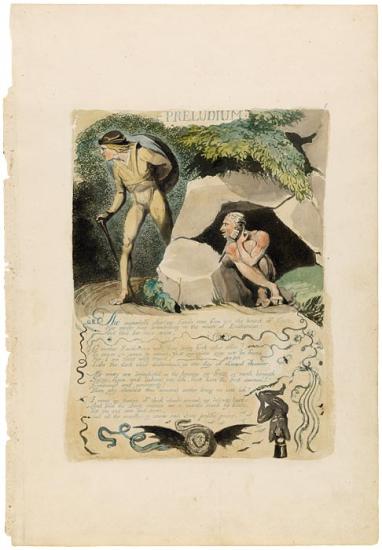
Europe: A Prophecy
Lambeth: Printed by Will: Blake, 1794
Relief and white line etching with color
Copy G, printed 1794
Purchased on The Thorne Family and Fellows Fund in memory of Mrs. Landon K. Thorne, 1976
Europe is the second of Blake's great illuminated books concerning the revolutionary spirit of his age. Rather than examining the New World, this Continental Prophecy looks eastward to consider cultures subjected to the strictures of authority embodied by Urizen, who, despite his appearance, represents tyranny.
The frontispiece depicting Urizen dividing the deep with a compass is one of Blake's best–known images. It also exists as a separate print called The Ancient of Days. The Morgan's copy of Europe, one of only nine, was printed in 1794.
William Blake (1757–1827) occupies a unique place in the history of Western art. His creativity included both the visual and literary arts. In his lifetime he was best known as an engraver; now he is also recognized for his innovative poetry, printmaking, and painting. Blake's keen perception of the political and social climate found expression throughout his work. His strong sense of independence is evident in the complex mythology that he constructed in response to the age of revolution.
Blake was already recognized as an engraver at age twenty-five, when his first volume of poems appeared. At thirty-three, in The Marriage of Heaven and Hell, he audaciously claimed that his birth had marked the origin of a "new heaven" in which his own art would exemplify the creativity prefigured by Milton and Michelangelo. By that time, Blake, in one of his most productive periods, had already produced Songs of Innocence and was at work on a series of illuminated books. In 1818 he met John Linnell, a young painter and engraver, through whom a group of young artists became Blake's followers. Calling themselves the Ancients, they helped perpetuate Blake's influence for generations.
The Morgan's Blake collection—one of this country's most distinguished—began with purchases as early as 1899 by Pierpont Morgan. During the tenure of Charles Ryskamp, director from 1969 to 1986, major gifts almost doubled the size of its Blake holdings. In recent years Ryskamp's own gifts of engravings, letters, and related materials have significantly enriched its scholarly resources.
IV. The Continental Prophecies
In 1790, Blake moved to Lambeth, where he produced a trilogy of illuminated books called the Continental Prophecies that addressed the politically charged spirit of his age, embodied by the American and French revolutions. Along with Europe and The Song of Los, America depicts the oppression exercised by monarchies and religions represented by Urizen. Although godlike in appearance, Urizen is a legalistic, despotic figure.
Another central figure is Orc, representing the spirit of revolt, who is frequently associated with images of fire. The frontispiece represents the destruction of war, while the text refers to George Washington, Thomas Paine, and other contemporary figures. America exists in only fourteen copies, five of which were colored and printed during Blake's lifetime. The Morgan also owns an uncolored copy.
This online exhibition is presented in conjunction with the exhibition William Blake's World: "A New Heaven Is Begun" on view September 11, 2009, through January 3, 2010.
This exhibition is made possible through the generosity of Fay and Geoffrey Elliott.
Europe: A Prophecy 7
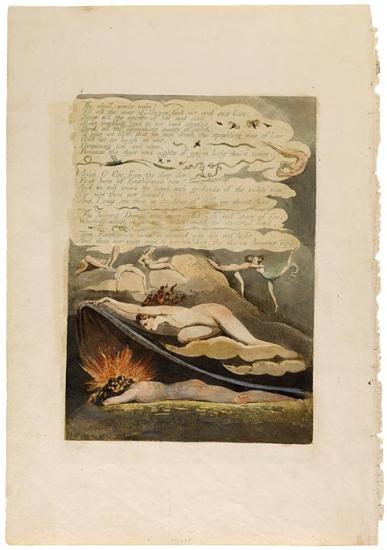
Europe: A Prophecy
Lambeth: Printed by Will: Blake, 1794
Relief and white line etching with color
Copy G, printed 1794
Purchased on The Thorne Family and Fellows Fund in memory of Mrs. Landon K. Thorne, 1976
Europe is the second of Blake's great illuminated books concerning the revolutionary spirit of his age. Rather than examining the New World, this Continental Prophecy looks eastward to consider cultures subjected to the strictures of authority embodied by Urizen, who, despite his appearance, represents tyranny.
The frontispiece depicting Urizen dividing the deep with a compass is one of Blake's best–known images. It also exists as a separate print called The Ancient of Days. The Morgan's copy of Europe, one of only nine, was printed in 1794.
William Blake (1757–1827) occupies a unique place in the history of Western art. His creativity included both the visual and literary arts. In his lifetime he was best known as an engraver; now he is also recognized for his innovative poetry, printmaking, and painting. Blake's keen perception of the political and social climate found expression throughout his work. His strong sense of independence is evident in the complex mythology that he constructed in response to the age of revolution.
Blake was already recognized as an engraver at age twenty-five, when his first volume of poems appeared. At thirty-three, in The Marriage of Heaven and Hell, he audaciously claimed that his birth had marked the origin of a "new heaven" in which his own art would exemplify the creativity prefigured by Milton and Michelangelo. By that time, Blake, in one of his most productive periods, had already produced Songs of Innocence and was at work on a series of illuminated books. In 1818 he met John Linnell, a young painter and engraver, through whom a group of young artists became Blake's followers. Calling themselves the Ancients, they helped perpetuate Blake's influence for generations.
The Morgan's Blake collection—one of this country's most distinguished—began with purchases as early as 1899 by Pierpont Morgan. During the tenure of Charles Ryskamp, director from 1969 to 1986, major gifts almost doubled the size of its Blake holdings. In recent years Ryskamp's own gifts of engravings, letters, and related materials have significantly enriched its scholarly resources.
IV. The Continental Prophecies
In 1790, Blake moved to Lambeth, where he produced a trilogy of illuminated books called the Continental Prophecies that addressed the politically charged spirit of his age, embodied by the American and French revolutions. Along with Europe and The Song of Los, America depicts the oppression exercised by monarchies and religions represented by Urizen. Although godlike in appearance, Urizen is a legalistic, despotic figure.
Another central figure is Orc, representing the spirit of revolt, who is frequently associated with images of fire. The frontispiece represents the destruction of war, while the text refers to George Washington, Thomas Paine, and other contemporary figures. America exists in only fourteen copies, five of which were colored and printed during Blake's lifetime. The Morgan also owns an uncolored copy.
This online exhibition is presented in conjunction with the exhibition William Blake's World: "A New Heaven Is Begun" on view September 11, 2009, through January 3, 2010.
This exhibition is made possible through the generosity of Fay and Geoffrey Elliott.
Europe: A Prophecy 8
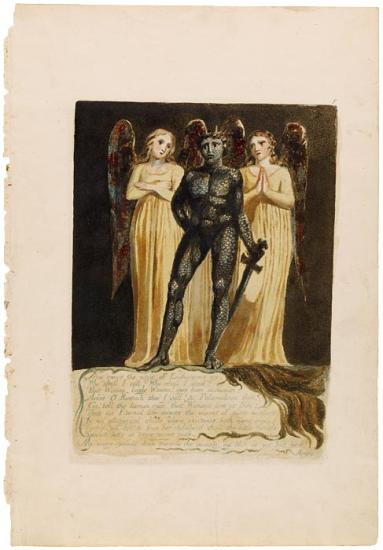
Europe: A Prophecy
Lambeth: Printed by Will: Blake, 1794
Relief and white line etching with color
Copy G, printed 1794
Purchased on The Thorne Family and Fellows Fund in memory of Mrs. Landon K. Thorne, 1976
Europe is the second of Blake's great illuminated books concerning the revolutionary spirit of his age. Rather than examining the New World, this Continental Prophecy looks eastward to consider cultures subjected to the strictures of authority embodied by Urizen, who, despite his appearance, represents tyranny.
The frontispiece depicting Urizen dividing the deep with a compass is one of Blake's best–known images. It also exists as a separate print called The Ancient of Days. The Morgan's copy of Europe, one of only nine, was printed in 1794.
William Blake (1757–1827) occupies a unique place in the history of Western art. His creativity included both the visual and literary arts. In his lifetime he was best known as an engraver; now he is also recognized for his innovative poetry, printmaking, and painting. Blake's keen perception of the political and social climate found expression throughout his work. His strong sense of independence is evident in the complex mythology that he constructed in response to the age of revolution.
Blake was already recognized as an engraver at age twenty-five, when his first volume of poems appeared. At thirty-three, in The Marriage of Heaven and Hell, he audaciously claimed that his birth had marked the origin of a "new heaven" in which his own art would exemplify the creativity prefigured by Milton and Michelangelo. By that time, Blake, in one of his most productive periods, had already produced Songs of Innocence and was at work on a series of illuminated books. In 1818 he met John Linnell, a young painter and engraver, through whom a group of young artists became Blake's followers. Calling themselves the Ancients, they helped perpetuate Blake's influence for generations.
The Morgan's Blake collection—one of this country's most distinguished—began with purchases as early as 1899 by Pierpont Morgan. During the tenure of Charles Ryskamp, director from 1969 to 1986, major gifts almost doubled the size of its Blake holdings. In recent years Ryskamp's own gifts of engravings, letters, and related materials have significantly enriched its scholarly resources.
IV. The Continental Prophecies
In 1790, Blake moved to Lambeth, where he produced a trilogy of illuminated books called the Continental Prophecies that addressed the politically charged spirit of his age, embodied by the American and French revolutions. Along with Europe and The Song of Los, America depicts the oppression exercised by monarchies and religions represented by Urizen. Although godlike in appearance, Urizen is a legalistic, despotic figure.
Another central figure is Orc, representing the spirit of revolt, who is frequently associated with images of fire. The frontispiece represents the destruction of war, while the text refers to George Washington, Thomas Paine, and other contemporary figures. America exists in only fourteen copies, five of which were colored and printed during Blake's lifetime. The Morgan also owns an uncolored copy.
This online exhibition is presented in conjunction with the exhibition William Blake's World: "A New Heaven Is Begun" on view September 11, 2009, through January 3, 2010.
This exhibition is made possible through the generosity of Fay and Geoffrey Elliott.
Europe: A Prophecy 9
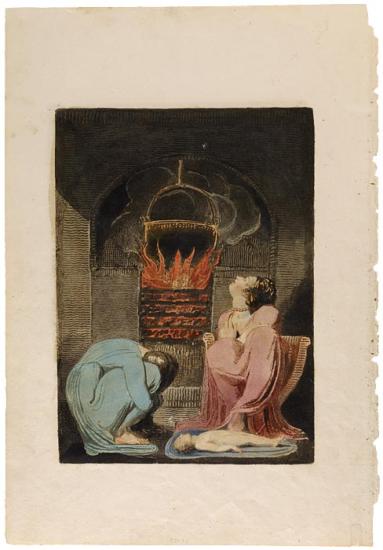
Europe: A Prophecy
Lambeth: Printed by Will: Blake, 1794
Relief and white line etching with color
Copy G, printed 1794
Purchased on The Thorne Family and Fellows Fund in memory of Mrs. Landon K. Thorne, 1976
Europe is the second of Blake's great illuminated books concerning the revolutionary spirit of his age. Rather than examining the New World, this Continental Prophecy looks eastward to consider cultures subjected to the strictures of authority embodied by Urizen, who, despite his appearance, represents tyranny.
The frontispiece depicting Urizen dividing the deep with a compass is one of Blake's best–known images. It also exists as a separate print called The Ancient of Days. The Morgan's copy of Europe, one of only nine, was printed in 1794.
William Blake (1757–1827) occupies a unique place in the history of Western art. His creativity included both the visual and literary arts. In his lifetime he was best known as an engraver; now he is also recognized for his innovative poetry, printmaking, and painting. Blake's keen perception of the political and social climate found expression throughout his work. His strong sense of independence is evident in the complex mythology that he constructed in response to the age of revolution.
Blake was already recognized as an engraver at age twenty-five, when his first volume of poems appeared. At thirty-three, in The Marriage of Heaven and Hell, he audaciously claimed that his birth had marked the origin of a "new heaven" in which his own art would exemplify the creativity prefigured by Milton and Michelangelo. By that time, Blake, in one of his most productive periods, had already produced Songs of Innocence and was at work on a series of illuminated books. In 1818 he met John Linnell, a young painter and engraver, through whom a group of young artists became Blake's followers. Calling themselves the Ancients, they helped perpetuate Blake's influence for generations.
The Morgan's Blake collection—one of this country's most distinguished—began with purchases as early as 1899 by Pierpont Morgan. During the tenure of Charles Ryskamp, director from 1969 to 1986, major gifts almost doubled the size of its Blake holdings. In recent years Ryskamp's own gifts of engravings, letters, and related materials have significantly enriched its scholarly resources.
IV. The Continental Prophecies
In 1790, Blake moved to Lambeth, where he produced a trilogy of illuminated books called the Continental Prophecies that addressed the politically charged spirit of his age, embodied by the American and French revolutions. Along with Europe and The Song of Los, America depicts the oppression exercised by monarchies and religions represented by Urizen. Although godlike in appearance, Urizen is a legalistic, despotic figure.
Another central figure is Orc, representing the spirit of revolt, who is frequently associated with images of fire. The frontispiece represents the destruction of war, while the text refers to George Washington, Thomas Paine, and other contemporary figures. America exists in only fourteen copies, five of which were colored and printed during Blake's lifetime. The Morgan also owns an uncolored copy.
This online exhibition is presented in conjunction with the exhibition William Blake's World: "A New Heaven Is Begun" on view September 11, 2009, through January 3, 2010.
This exhibition is made possible through the generosity of Fay and Geoffrey Elliott.
Europe: A Prophecy 10
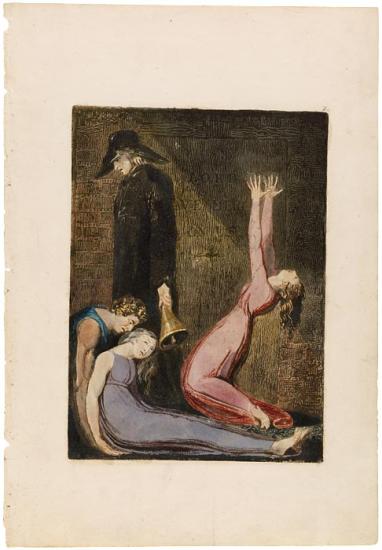
Europe: A Prophecy
Lambeth: Printed by Will: Blake, 1794
Relief and white line etching with color
Copy G, printed 1794
Purchased on The Thorne Family and Fellows Fund in memory of Mrs. Landon K. Thorne, 1976
Europe is the second of Blake's great illuminated books concerning the revolutionary spirit of his age. Rather than examining the New World, this Continental Prophecy looks eastward to consider cultures subjected to the strictures of authority embodied by Urizen, who, despite his appearance, represents tyranny.
The frontispiece depicting Urizen dividing the deep with a compass is one of Blake's best–known images. It also exists as a separate print called The Ancient of Days. The Morgan's copy of Europe, one of only nine, was printed in 1794.
William Blake (1757–1827) occupies a unique place in the history of Western art. His creativity included both the visual and literary arts. In his lifetime he was best known as an engraver; now he is also recognized for his innovative poetry, printmaking, and painting. Blake's keen perception of the political and social climate found expression throughout his work. His strong sense of independence is evident in the complex mythology that he constructed in response to the age of revolution.
Blake was already recognized as an engraver at age twenty-five, when his first volume of poems appeared. At thirty-three, in The Marriage of Heaven and Hell, he audaciously claimed that his birth had marked the origin of a "new heaven" in which his own art would exemplify the creativity prefigured by Milton and Michelangelo. By that time, Blake, in one of his most productive periods, had already produced Songs of Innocence and was at work on a series of illuminated books. In 1818 he met John Linnell, a young painter and engraver, through whom a group of young artists became Blake's followers. Calling themselves the Ancients, they helped perpetuate Blake's influence for generations.
The Morgan's Blake collection—one of this country's most distinguished—began with purchases as early as 1899 by Pierpont Morgan. During the tenure of Charles Ryskamp, director from 1969 to 1986, major gifts almost doubled the size of its Blake holdings. In recent years Ryskamp's own gifts of engravings, letters, and related materials have significantly enriched its scholarly resources.
IV. The Continental Prophecies
In 1790, Blake moved to Lambeth, where he produced a trilogy of illuminated books called the Continental Prophecies that addressed the politically charged spirit of his age, embodied by the American and French revolutions. Along with Europe and The Song of Los, America depicts the oppression exercised by monarchies and religions represented by Urizen. Although godlike in appearance, Urizen is a legalistic, despotic figure.
Another central figure is Orc, representing the spirit of revolt, who is frequently associated with images of fire. The frontispiece represents the destruction of war, while the text refers to George Washington, Thomas Paine, and other contemporary figures. America exists in only fourteen copies, five of which were colored and printed during Blake's lifetime. The Morgan also owns an uncolored copy.
This online exhibition is presented in conjunction with the exhibition William Blake's World: "A New Heaven Is Begun" on view September 11, 2009, through January 3, 2010.
This exhibition is made possible through the generosity of Fay and Geoffrey Elliott.
Europe: A Prophecy 11
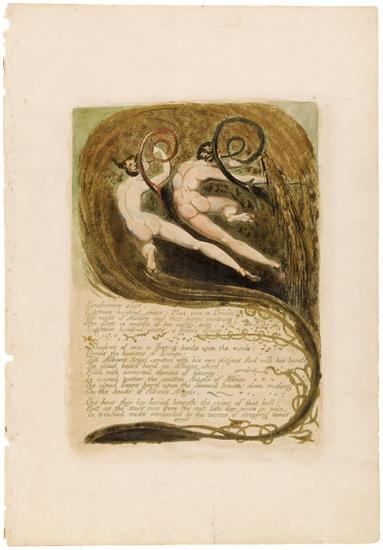
Europe: A Prophecy
Lambeth: Printed by Will: Blake, 1794
Relief and white line etching with color
Copy G, printed 1794
Purchased on The Thorne Family and Fellows Fund in memory of Mrs. Landon K. Thorne, 1976
Europe is the second of Blake's great illuminated books concerning the revolutionary spirit of his age. Rather than examining the New World, this Continental Prophecy looks eastward to consider cultures subjected to the strictures of authority embodied by Urizen, who, despite his appearance, represents tyranny.
The frontispiece depicting Urizen dividing the deep with a compass is one of Blake's best–known images. It also exists as a separate print called The Ancient of Days. The Morgan's copy of Europe, one of only nine, was printed in 1794.
William Blake (1757–1827) occupies a unique place in the history of Western art. His creativity included both the visual and literary arts. In his lifetime he was best known as an engraver; now he is also recognized for his innovative poetry, printmaking, and painting. Blake's keen perception of the political and social climate found expression throughout his work. His strong sense of independence is evident in the complex mythology that he constructed in response to the age of revolution.
Blake was already recognized as an engraver at age twenty-five, when his first volume of poems appeared. At thirty-three, in The Marriage of Heaven and Hell, he audaciously claimed that his birth had marked the origin of a "new heaven" in which his own art would exemplify the creativity prefigured by Milton and Michelangelo. By that time, Blake, in one of his most productive periods, had already produced Songs of Innocence and was at work on a series of illuminated books. In 1818 he met John Linnell, a young painter and engraver, through whom a group of young artists became Blake's followers. Calling themselves the Ancients, they helped perpetuate Blake's influence for generations.
The Morgan's Blake collection—one of this country's most distinguished—began with purchases as early as 1899 by Pierpont Morgan. During the tenure of Charles Ryskamp, director from 1969 to 1986, major gifts almost doubled the size of its Blake holdings. In recent years Ryskamp's own gifts of engravings, letters, and related materials have significantly enriched its scholarly resources.
IV. The Continental Prophecies
In 1790, Blake moved to Lambeth, where he produced a trilogy of illuminated books called the Continental Prophecies that addressed the politically charged spirit of his age, embodied by the American and French revolutions. Along with Europe and The Song of Los, America depicts the oppression exercised by monarchies and religions represented by Urizen. Although godlike in appearance, Urizen is a legalistic, despotic figure.
Another central figure is Orc, representing the spirit of revolt, who is frequently associated with images of fire. The frontispiece represents the destruction of war, while the text refers to George Washington, Thomas Paine, and other contemporary figures. America exists in only fourteen copies, five of which were colored and printed during Blake's lifetime. The Morgan also owns an uncolored copy.
This online exhibition is presented in conjunction with the exhibition William Blake's World: "A New Heaven Is Begun" on view September 11, 2009, through January 3, 2010.
This exhibition is made possible through the generosity of Fay and Geoffrey Elliott.
Europe: A Prophecy 12
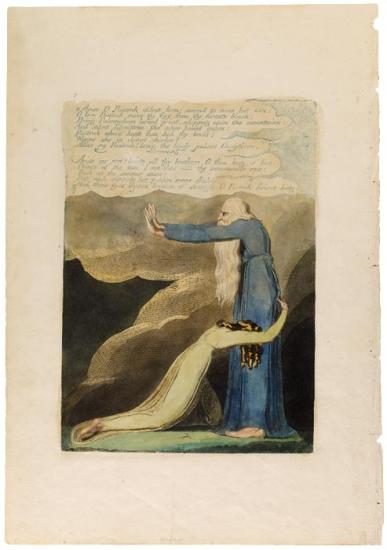
Europe: A Prophecy
Lambeth: Printed by Will: Blake, 1794
Relief and white line etching with color
Copy G, printed 1794
Purchased on The Thorne Family and Fellows Fund in memory of Mrs. Landon K. Thorne, 1976
Europe is the second of Blake's great illuminated books concerning the revolutionary spirit of his age. Rather than examining the New World, this Continental Prophecy looks eastward to consider cultures subjected to the strictures of authority embodied by Urizen, who, despite his appearance, represents tyranny.
The frontispiece depicting Urizen dividing the deep with a compass is one of Blake's best–known images. It also exists as a separate print called The Ancient of Days. The Morgan's copy of Europe, one of only nine, was printed in 1794.
William Blake (1757–1827) occupies a unique place in the history of Western art. His creativity included both the visual and literary arts. In his lifetime he was best known as an engraver; now he is also recognized for his innovative poetry, printmaking, and painting. Blake's keen perception of the political and social climate found expression throughout his work. His strong sense of independence is evident in the complex mythology that he constructed in response to the age of revolution.
Blake was already recognized as an engraver at age twenty-five, when his first volume of poems appeared. At thirty-three, in The Marriage of Heaven and Hell, he audaciously claimed that his birth had marked the origin of a "new heaven" in which his own art would exemplify the creativity prefigured by Milton and Michelangelo. By that time, Blake, in one of his most productive periods, had already produced Songs of Innocence and was at work on a series of illuminated books. In 1818 he met John Linnell, a young painter and engraver, through whom a group of young artists became Blake's followers. Calling themselves the Ancients, they helped perpetuate Blake's influence for generations.
The Morgan's Blake collection—one of this country's most distinguished—began with purchases as early as 1899 by Pierpont Morgan. During the tenure of Charles Ryskamp, director from 1969 to 1986, major gifts almost doubled the size of its Blake holdings. In recent years Ryskamp's own gifts of engravings, letters, and related materials have significantly enriched its scholarly resources.
IV. The Continental Prophecies
In 1790, Blake moved to Lambeth, where he produced a trilogy of illuminated books called the Continental Prophecies that addressed the politically charged spirit of his age, embodied by the American and French revolutions. Along with Europe and The Song of Los, America depicts the oppression exercised by monarchies and religions represented by Urizen. Although godlike in appearance, Urizen is a legalistic, despotic figure.
Another central figure is Orc, representing the spirit of revolt, who is frequently associated with images of fire. The frontispiece represents the destruction of war, while the text refers to George Washington, Thomas Paine, and other contemporary figures. America exists in only fourteen copies, five of which were colored and printed during Blake's lifetime. The Morgan also owns an uncolored copy.
This online exhibition is presented in conjunction with the exhibition William Blake's World: "A New Heaven Is Begun" on view September 11, 2009, through January 3, 2010.
This exhibition is made possible through the generosity of Fay and Geoffrey Elliott.
Europe: A Prophecy 13
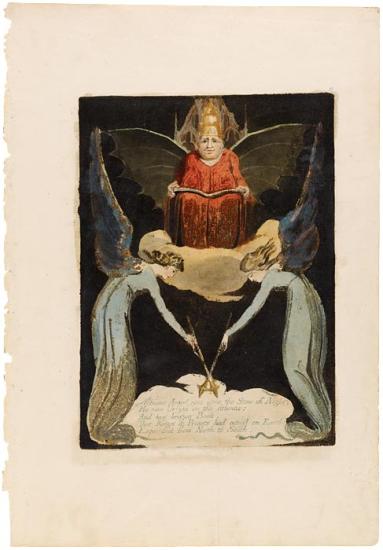
Europe: A Prophecy
Lambeth: Printed by Will: Blake, 1794
Relief and white line etching with color
Copy G, printed 1794
Purchased on The Thorne Family and Fellows Fund in memory of Mrs. Landon K. Thorne, 1976
Europe is the second of Blake's great illuminated books concerning the revolutionary spirit of his age. Rather than examining the New World, this Continental Prophecy looks eastward to consider cultures subjected to the strictures of authority embodied by Urizen, who, despite his appearance, represents tyranny.
The frontispiece depicting Urizen dividing the deep with a compass is one of Blake's best–known images. It also exists as a separate print called The Ancient of Days. The Morgan's copy of Europe, one of only nine, was printed in 1794.
William Blake (1757–1827) occupies a unique place in the history of Western art. His creativity included both the visual and literary arts. In his lifetime he was best known as an engraver; now he is also recognized for his innovative poetry, printmaking, and painting. Blake's keen perception of the political and social climate found expression throughout his work. His strong sense of independence is evident in the complex mythology that he constructed in response to the age of revolution.
Blake was already recognized as an engraver at age twenty-five, when his first volume of poems appeared. At thirty-three, in The Marriage of Heaven and Hell, he audaciously claimed that his birth had marked the origin of a "new heaven" in which his own art would exemplify the creativity prefigured by Milton and Michelangelo. By that time, Blake, in one of his most productive periods, had already produced Songs of Innocence and was at work on a series of illuminated books. In 1818 he met John Linnell, a young painter and engraver, through whom a group of young artists became Blake's followers. Calling themselves the Ancients, they helped perpetuate Blake's influence for generations.
The Morgan's Blake collection—one of this country's most distinguished—began with purchases as early as 1899 by Pierpont Morgan. During the tenure of Charles Ryskamp, director from 1969 to 1986, major gifts almost doubled the size of its Blake holdings. In recent years Ryskamp's own gifts of engravings, letters, and related materials have significantly enriched its scholarly resources.
IV. The Continental Prophecies
In 1790, Blake moved to Lambeth, where he produced a trilogy of illuminated books called the Continental Prophecies that addressed the politically charged spirit of his age, embodied by the American and French revolutions. Along with Europe and The Song of Los, America depicts the oppression exercised by monarchies and religions represented by Urizen. Although godlike in appearance, Urizen is a legalistic, despotic figure.
Another central figure is Orc, representing the spirit of revolt, who is frequently associated with images of fire. The frontispiece represents the destruction of war, while the text refers to George Washington, Thomas Paine, and other contemporary figures. America exists in only fourteen copies, five of which were colored and printed during Blake's lifetime. The Morgan also owns an uncolored copy.
This online exhibition is presented in conjunction with the exhibition William Blake's World: "A New Heaven Is Begun" on view September 11, 2009, through January 3, 2010.
This exhibition is made possible through the generosity of Fay and Geoffrey Elliott.
Europe: A Prophecy 14

Europe: A Prophecy
Lambeth: Printed by Will: Blake, 1794
Relief and white line etching with color
Copy G, printed 1794
Purchased on The Thorne Family and Fellows Fund in memory of Mrs. Landon K. Thorne, 1976
Europe is the second of Blake's great illuminated books concerning the revolutionary spirit of his age. Rather than examining the New World, this Continental Prophecy looks eastward to consider cultures subjected to the strictures of authority embodied by Urizen, who, despite his appearance, represents tyranny.
The frontispiece depicting Urizen dividing the deep with a compass is one of Blake's best–known images. It also exists as a separate print called The Ancient of Days. The Morgan's copy of Europe, one of only nine, was printed in 1794.
William Blake (1757–1827) occupies a unique place in the history of Western art. His creativity included both the visual and literary arts. In his lifetime he was best known as an engraver; now he is also recognized for his innovative poetry, printmaking, and painting. Blake's keen perception of the political and social climate found expression throughout his work. His strong sense of independence is evident in the complex mythology that he constructed in response to the age of revolution.
Blake was already recognized as an engraver at age twenty-five, when his first volume of poems appeared. At thirty-three, in The Marriage of Heaven and Hell, he audaciously claimed that his birth had marked the origin of a "new heaven" in which his own art would exemplify the creativity prefigured by Milton and Michelangelo. By that time, Blake, in one of his most productive periods, had already produced Songs of Innocence and was at work on a series of illuminated books. In 1818 he met John Linnell, a young painter and engraver, through whom a group of young artists became Blake's followers. Calling themselves the Ancients, they helped perpetuate Blake's influence for generations.
The Morgan's Blake collection—one of this country's most distinguished—began with purchases as early as 1899 by Pierpont Morgan. During the tenure of Charles Ryskamp, director from 1969 to 1986, major gifts almost doubled the size of its Blake holdings. In recent years Ryskamp's own gifts of engravings, letters, and related materials have significantly enriched its scholarly resources.
IV. The Continental Prophecies
In 1790, Blake moved to Lambeth, where he produced a trilogy of illuminated books called the Continental Prophecies that addressed the politically charged spirit of his age, embodied by the American and French revolutions. Along with Europe and The Song of Los, America depicts the oppression exercised by monarchies and religions represented by Urizen. Although godlike in appearance, Urizen is a legalistic, despotic figure.
Another central figure is Orc, representing the spirit of revolt, who is frequently associated with images of fire. The frontispiece represents the destruction of war, while the text refers to George Washington, Thomas Paine, and other contemporary figures. America exists in only fourteen copies, five of which were colored and printed during Blake's lifetime. The Morgan also owns an uncolored copy.
This online exhibition is presented in conjunction with the exhibition William Blake's World: "A New Heaven Is Begun" on view September 11, 2009, through January 3, 2010.
This exhibition is made possible through the generosity of Fay and Geoffrey Elliott.
Europe: A Prophecy 15
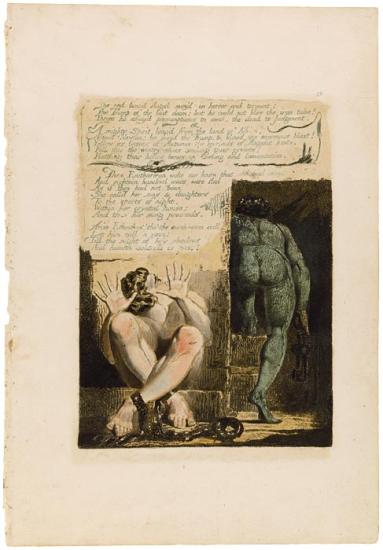
Europe: A Prophecy
Lambeth: Printed by Will: Blake, 1794
Relief and white line etching with color
Copy G, printed 1794
Purchased on The Thorne Family and Fellows Fund in memory of Mrs. Landon K. Thorne, 1976
Europe is the second of Blake's great illuminated books concerning the revolutionary spirit of his age. Rather than examining the New World, this Continental Prophecy looks eastward to consider cultures subjected to the strictures of authority embodied by Urizen, who, despite his appearance, represents tyranny.
The frontispiece depicting Urizen dividing the deep with a compass is one of Blake's best–known images. It also exists as a separate print called The Ancient of Days. The Morgan's copy of Europe, one of only nine, was printed in 1794.
William Blake (1757–1827) occupies a unique place in the history of Western art. His creativity included both the visual and literary arts. In his lifetime he was best known as an engraver; now he is also recognized for his innovative poetry, printmaking, and painting. Blake's keen perception of the political and social climate found expression throughout his work. His strong sense of independence is evident in the complex mythology that he constructed in response to the age of revolution.
Blake was already recognized as an engraver at age twenty-five, when his first volume of poems appeared. At thirty-three, in The Marriage of Heaven and Hell, he audaciously claimed that his birth had marked the origin of a "new heaven" in which his own art would exemplify the creativity prefigured by Milton and Michelangelo. By that time, Blake, in one of his most productive periods, had already produced Songs of Innocence and was at work on a series of illuminated books. In 1818 he met John Linnell, a young painter and engraver, through whom a group of young artists became Blake's followers. Calling themselves the Ancients, they helped perpetuate Blake's influence for generations.
The Morgan's Blake collection—one of this country's most distinguished—began with purchases as early as 1899 by Pierpont Morgan. During the tenure of Charles Ryskamp, director from 1969 to 1986, major gifts almost doubled the size of its Blake holdings. In recent years Ryskamp's own gifts of engravings, letters, and related materials have significantly enriched its scholarly resources.
IV. The Continental Prophecies
In 1790, Blake moved to Lambeth, where he produced a trilogy of illuminated books called the Continental Prophecies that addressed the politically charged spirit of his age, embodied by the American and French revolutions. Along with Europe and The Song of Los, America depicts the oppression exercised by monarchies and religions represented by Urizen. Although godlike in appearance, Urizen is a legalistic, despotic figure.
Another central figure is Orc, representing the spirit of revolt, who is frequently associated with images of fire. The frontispiece represents the destruction of war, while the text refers to George Washington, Thomas Paine, and other contemporary figures. America exists in only fourteen copies, five of which were colored and printed during Blake's lifetime. The Morgan also owns an uncolored copy.
This online exhibition is presented in conjunction with the exhibition William Blake's World: "A New Heaven Is Begun" on view September 11, 2009, through January 3, 2010.
This exhibition is made possible through the generosity of Fay and Geoffrey Elliott.
Europe: A Prophecy 16
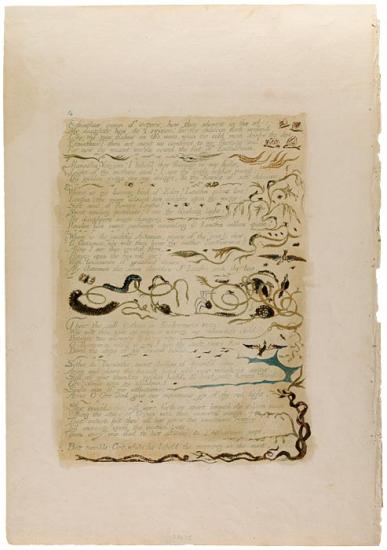
Europe: A Prophecy
Lambeth: Printed by Will: Blake, 1794
Relief and white line etching with color
Copy G, printed 1794
Purchased on The Thorne Family and Fellows Fund in memory of Mrs. Landon K. Thorne, 1976
Europe is the second of Blake's great illuminated books concerning the revolutionary spirit of his age. Rather than examining the New World, this Continental Prophecy looks eastward to consider cultures subjected to the strictures of authority embodied by Urizen, who, despite his appearance, represents tyranny.
The frontispiece depicting Urizen dividing the deep with a compass is one of Blake's best–known images. It also exists as a separate print called The Ancient of Days. The Morgan's copy of Europe, one of only nine, was printed in 1794.
William Blake (1757–1827) occupies a unique place in the history of Western art. His creativity included both the visual and literary arts. In his lifetime he was best known as an engraver; now he is also recognized for his innovative poetry, printmaking, and painting. Blake's keen perception of the political and social climate found expression throughout his work. His strong sense of independence is evident in the complex mythology that he constructed in response to the age of revolution.
Blake was already recognized as an engraver at age twenty-five, when his first volume of poems appeared. At thirty-three, in The Marriage of Heaven and Hell, he audaciously claimed that his birth had marked the origin of a "new heaven" in which his own art would exemplify the creativity prefigured by Milton and Michelangelo. By that time, Blake, in one of his most productive periods, had already produced Songs of Innocence and was at work on a series of illuminated books. In 1818 he met John Linnell, a young painter and engraver, through whom a group of young artists became Blake's followers. Calling themselves the Ancients, they helped perpetuate Blake's influence for generations.
The Morgan's Blake collection—one of this country's most distinguished—began with purchases as early as 1899 by Pierpont Morgan. During the tenure of Charles Ryskamp, director from 1969 to 1986, major gifts almost doubled the size of its Blake holdings. In recent years Ryskamp's own gifts of engravings, letters, and related materials have significantly enriched its scholarly resources.
IV. The Continental Prophecies
In 1790, Blake moved to Lambeth, where he produced a trilogy of illuminated books called the Continental Prophecies that addressed the politically charged spirit of his age, embodied by the American and French revolutions. Along with Europe and The Song of Los, America depicts the oppression exercised by monarchies and religions represented by Urizen. Although godlike in appearance, Urizen is a legalistic, despotic figure.
Another central figure is Orc, representing the spirit of revolt, who is frequently associated with images of fire. The frontispiece represents the destruction of war, while the text refers to George Washington, Thomas Paine, and other contemporary figures. America exists in only fourteen copies, five of which were colored and printed during Blake's lifetime. The Morgan also owns an uncolored copy.
This online exhibition is presented in conjunction with the exhibition William Blake's World: "A New Heaven Is Begun" on view September 11, 2009, through January 3, 2010.
This exhibition is made possible through the generosity of Fay and Geoffrey Elliott.
The Song of Los, Plate 2
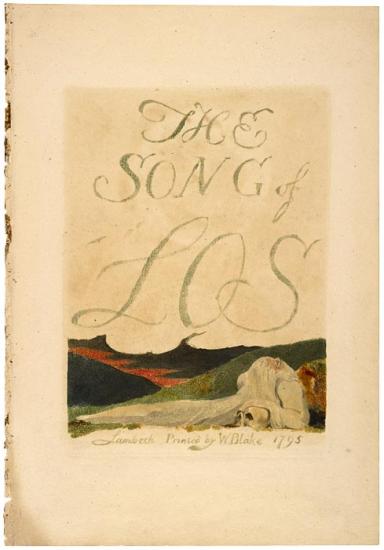
The Song of Los
Lambeth: Printed by W. Blake, 1795
Plates 2 and 5, planographic printing; plates 3 and 6, relief etching with color printing 4 of 8 plate
Copy C
Gift of Mrs. Landon K. Thorne, 1972
This final Continental Prophecy is a more general analysis of religious and governmental powers than is Europe. The expanded scope of continents under consideration includes Africa and Asia. This is one of six copies.
William Blake (1757–1827) occupies a unique place in the history of Western art. His creativity included both the visual and literary arts. In his lifetime he was best known as an engraver; now he is also recognized for his innovative poetry, printmaking, and painting. Blake's keen perception of the political and social climate found expression throughout his work. His strong sense of independence is evident in the complex mythology that he constructed in response to the age of revolution.
Blake was already recognized as an engraver at age twenty-five, when his first volume of poems appeared. At thirty-three, in The Marriage of Heaven and Hell, he audaciously claimed that his birth had marked the origin of a "new heaven" in which his own art would exemplify the creativity prefigured by Milton and Michelangelo. By that time, Blake, in one of his most productive periods, had already produced Songs of Innocence and was at work on a series of illuminated books. In 1818 he met John Linnell, a young painter and engraver, through whom a group of young artists became Blake's followers. Calling themselves the Ancients, they helped perpetuate Blake's influence for generations.
The Morgan's Blake collection—one of this country's most distinguished—began with purchases as early as 1899 by Pierpont Morgan. During the tenure of Charles Ryskamp, director from 1969 to 1986, major gifts almost doubled the size of its Blake holdings. In recent years Ryskamp's own gifts of engravings, letters, and related materials have significantly enriched its scholarly resources.
IV. The Continental Prophecies
In 1790, Blake moved to Lambeth, where he produced a trilogy of illuminated books called the Continental Prophecies that addressed the politically charged spirit of his age, embodied by the American and French revolutions. Along with Europe and The Song of Los, America depicts the oppression exercised by monarchies and religions represented by Urizen. Although godlike in appearance, Urizen is a legalistic, despotic figure.
Another central figure is Orc, representing the spirit of revolt, who is frequently associated with images of fire. The frontispiece represents the destruction of war, while the text refers to George Washington, Thomas Paine, and other contemporary figures. America exists in only fourteen copies, five of which were colored and printed during Blake's lifetime. The Morgan also owns an uncolored copy.
This online exhibition is presented in conjunction with the exhibition William Blake's World: "A New Heaven Is Begun" on view September 11, 2009, through January 3, 2010.
This exhibition is made possible through the generosity of Fay and Geoffrey Elliott.
The Song of Los, Plate 3

The Song of Los
Lambeth: Printed by W. Blake, 1795
Plates 2 and 5, planographic printing; plates 3 and 6, relief etching with color printing 4 of 8 plate
Copy C
Gift of Mrs. Landon K. Thorne, 1972
This final Continental Prophecy is a more general analysis of religious and governmental powers than is Europe. The expanded scope of continents under consideration includes Africa and Asia. This is one of six copies.
William Blake (1757–1827) occupies a unique place in the history of Western art. His creativity included both the visual and literary arts. In his lifetime he was best known as an engraver; now he is also recognized for his innovative poetry, printmaking, and painting. Blake's keen perception of the political and social climate found expression throughout his work. His strong sense of independence is evident in the complex mythology that he constructed in response to the age of revolution.
Blake was already recognized as an engraver at age twenty-five, when his first volume of poems appeared. At thirty-three, in The Marriage of Heaven and Hell, he audaciously claimed that his birth had marked the origin of a "new heaven" in which his own art would exemplify the creativity prefigured by Milton and Michelangelo. By that time, Blake, in one of his most productive periods, had already produced Songs of Innocence and was at work on a series of illuminated books. In 1818 he met John Linnell, a young painter and engraver, through whom a group of young artists became Blake's followers. Calling themselves the Ancients, they helped perpetuate Blake's influence for generations.
The Morgan's Blake collection—one of this country's most distinguished—began with purchases as early as 1899 by Pierpont Morgan. During the tenure of Charles Ryskamp, director from 1969 to 1986, major gifts almost doubled the size of its Blake holdings. In recent years Ryskamp's own gifts of engravings, letters, and related materials have significantly enriched its scholarly resources.
IV. The Continental Prophecies
In 1790, Blake moved to Lambeth, where he produced a trilogy of illuminated books called the Continental Prophecies that addressed the politically charged spirit of his age, embodied by the American and French revolutions. Along with Europe and The Song of Los, America depicts the oppression exercised by monarchies and religions represented by Urizen. Although godlike in appearance, Urizen is a legalistic, despotic figure.
Another central figure is Orc, representing the spirit of revolt, who is frequently associated with images of fire. The frontispiece represents the destruction of war, while the text refers to George Washington, Thomas Paine, and other contemporary figures. America exists in only fourteen copies, five of which were colored and printed during Blake's lifetime. The Morgan also owns an uncolored copy.
This online exhibition is presented in conjunction with the exhibition William Blake's World: "A New Heaven Is Begun" on view September 11, 2009, through January 3, 2010.
This exhibition is made possible through the generosity of Fay and Geoffrey Elliott.
The Song of Los, Plate 5
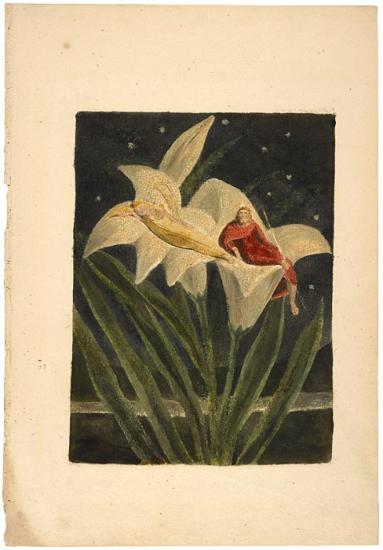
The Song of Los
Lambeth: Printed by W. Blake, 1795
Plates 2 and 5, planographic printing; plates 3 and 6, relief etching with color printing 4 of 8 plate
Copy C
Gift of Mrs. Landon K. Thorne, 1972
This final Continental Prophecy is a more general analysis of religious and governmental powers than is Europe. The expanded scope of continents under consideration includes Africa and Asia. This is one of six copies.
William Blake (1757–1827) occupies a unique place in the history of Western art. His creativity included both the visual and literary arts. In his lifetime he was best known as an engraver; now he is also recognized for his innovative poetry, printmaking, and painting. Blake's keen perception of the political and social climate found expression throughout his work. His strong sense of independence is evident in the complex mythology that he constructed in response to the age of revolution.
Blake was already recognized as an engraver at age twenty-five, when his first volume of poems appeared. At thirty-three, in The Marriage of Heaven and Hell, he audaciously claimed that his birth had marked the origin of a "new heaven" in which his own art would exemplify the creativity prefigured by Milton and Michelangelo. By that time, Blake, in one of his most productive periods, had already produced Songs of Innocence and was at work on a series of illuminated books. In 1818 he met John Linnell, a young painter and engraver, through whom a group of young artists became Blake's followers. Calling themselves the Ancients, they helped perpetuate Blake's influence for generations.
The Morgan's Blake collection—one of this country's most distinguished—began with purchases as early as 1899 by Pierpont Morgan. During the tenure of Charles Ryskamp, director from 1969 to 1986, major gifts almost doubled the size of its Blake holdings. In recent years Ryskamp's own gifts of engravings, letters, and related materials have significantly enriched its scholarly resources.
IV. The Continental Prophecies
In 1790, Blake moved to Lambeth, where he produced a trilogy of illuminated books called the Continental Prophecies that addressed the politically charged spirit of his age, embodied by the American and French revolutions. Along with Europe and The Song of Los, America depicts the oppression exercised by monarchies and religions represented by Urizen. Although godlike in appearance, Urizen is a legalistic, despotic figure.
Another central figure is Orc, representing the spirit of revolt, who is frequently associated with images of fire. The frontispiece represents the destruction of war, while the text refers to George Washington, Thomas Paine, and other contemporary figures. America exists in only fourteen copies, five of which were colored and printed during Blake's lifetime. The Morgan also owns an uncolored copy.
This online exhibition is presented in conjunction with the exhibition William Blake's World: "A New Heaven Is Begun" on view September 11, 2009, through January 3, 2010.
This exhibition is made possible through the generosity of Fay and Geoffrey Elliott.
The Song of Los, Plate 6
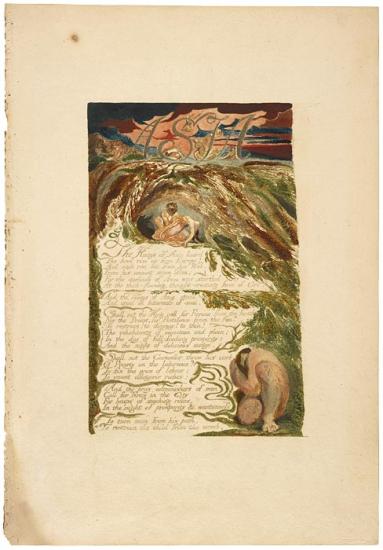
The Song of Los
Lambeth: Printed by W. Blake, 1795
Plates 2 and 5, planographic printing; plates 3 and 6, relief etching with color printing 4 of 8 plate
Copy C
Gift of Mrs. Landon K. Thorne, 1972
This final Continental Prophecy is a more general analysis of religious and governmental powers than is Europe. The expanded scope of continents under consideration includes Africa and Asia. This is one of six copies.
William Blake (1757–1827) occupies a unique place in the history of Western art. His creativity included both the visual and literary arts. In his lifetime he was best known as an engraver; now he is also recognized for his innovative poetry, printmaking, and painting. Blake's keen perception of the political and social climate found expression throughout his work. His strong sense of independence is evident in the complex mythology that he constructed in response to the age of revolution.
Blake was already recognized as an engraver at age twenty-five, when his first volume of poems appeared. At thirty-three, in The Marriage of Heaven and Hell, he audaciously claimed that his birth had marked the origin of a "new heaven" in which his own art would exemplify the creativity prefigured by Milton and Michelangelo. By that time, Blake, in one of his most productive periods, had already produced Songs of Innocence and was at work on a series of illuminated books. In 1818 he met John Linnell, a young painter and engraver, through whom a group of young artists became Blake's followers. Calling themselves the Ancients, they helped perpetuate Blake's influence for generations.
The Morgan's Blake collection—one of this country's most distinguished—began with purchases as early as 1899 by Pierpont Morgan. During the tenure of Charles Ryskamp, director from 1969 to 1986, major gifts almost doubled the size of its Blake holdings. In recent years Ryskamp's own gifts of engravings, letters, and related materials have significantly enriched its scholarly resources.
IV. The Continental Prophecies
In 1790, Blake moved to Lambeth, where he produced a trilogy of illuminated books called the Continental Prophecies that addressed the politically charged spirit of his age, embodied by the American and French revolutions. Along with Europe and The Song of Los, America depicts the oppression exercised by monarchies and religions represented by Urizen. Although godlike in appearance, Urizen is a legalistic, despotic figure.
Another central figure is Orc, representing the spirit of revolt, who is frequently associated with images of fire. The frontispiece represents the destruction of war, while the text refers to George Washington, Thomas Paine, and other contemporary figures. America exists in only fourteen copies, five of which were colored and printed during Blake's lifetime. The Morgan also owns an uncolored copy.
This online exhibition is presented in conjunction with the exhibition William Blake's World: "A New Heaven Is Begun" on view September 11, 2009, through January 3, 2010.
This exhibition is made possible through the generosity of Fay and Geoffrey Elliott.
Fire
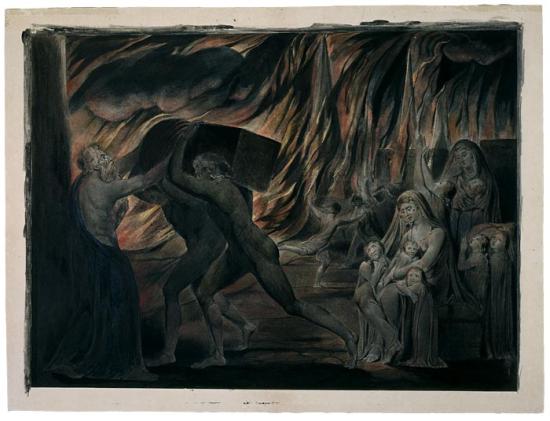
Fire, ca. 1805
Signed with monogram at lower right in pen and black ink, W. B.
Gift of Mrs. Landon K. Thorne
From about 1779 to 1805, Blake was occupied with the theme of war and the misfortunes associated with it. Fire, one of four watercolors commissioned by Thomas Butts, shows Blake's development of these themes. The three other drawings depict War (Fogg Art Museum, Harvard University, Cambridge, Massachusetts), Pestilence, and Famine (both in the Museum of Fine Arts, Boston). While it has been suggested that the series seems to refer not to the Bible but to the Litany—with Fire symbolizing "lightning and tempest"—it may also point to such contemporary events as the French Revolution, which Blake initially supported but shortly found appalling.
William Blake (1757–1827) occupies a unique place in the history of Western art. His creativity included both the visual and literary arts. In his lifetime he was best known as an engraver; now he is also recognized for his innovative poetry, printmaking, and painting. Blake's keen perception of the political and social climate found expression throughout his work. His strong sense of independence is evident in the complex mythology that he constructed in response to the age of revolution.
Blake was already recognized as an engraver at age twenty-five, when his first volume of poems appeared. At thirty-three, in The Marriage of Heaven and Hell, he audaciously claimed that his birth had marked the origin of a "new heaven" in which his own art would exemplify the creativity prefigured by Milton and Michelangelo. By that time, Blake, in one of his most productive periods, had already produced Songs of Innocence and was at work on a series of illuminated books. In 1818 he met John Linnell, a young painter and engraver, through whom a group of young artists became Blake's followers. Calling themselves the Ancients, they helped perpetuate Blake's influence for generations.
The Morgan's Blake collection—one of this country's most distinguished—began with purchases as early as 1899 by Pierpont Morgan. During the tenure of Charles Ryskamp, director from 1969 to 1986, major gifts almost doubled the size of its Blake holdings. In recent years Ryskamp's own gifts of engravings, letters, and related materials have significantly enriched its scholarly resources.
IV. The Continental Prophecies
In 1790, Blake moved to Lambeth, where he produced a trilogy of illuminated books called the Continental Prophecies that addressed the politically charged spirit of his age, embodied by the American and French revolutions. Along with Europe and The Song of Los, America depicts the oppression exercised by monarchies and religions represented by Urizen. Although godlike in appearance, Urizen is a legalistic, despotic figure.
Another central figure is Orc, representing the spirit of revolt, who is frequently associated with images of fire. The frontispiece represents the destruction of war, while the text refers to George Washington, Thomas Paine, and other contemporary figures. America exists in only fourteen copies, five of which were colored and printed during Blake's lifetime. The Morgan also owns an uncolored copy.
This online exhibition is presented in conjunction with the exhibition William Blake's World: "A New Heaven Is Begun" on view September 11, 2009, through January 3, 2010.
This exhibition is made possible through the generosity of Fay and Geoffrey Elliott.
V. Milton's L'Allegro and Il Penseroso
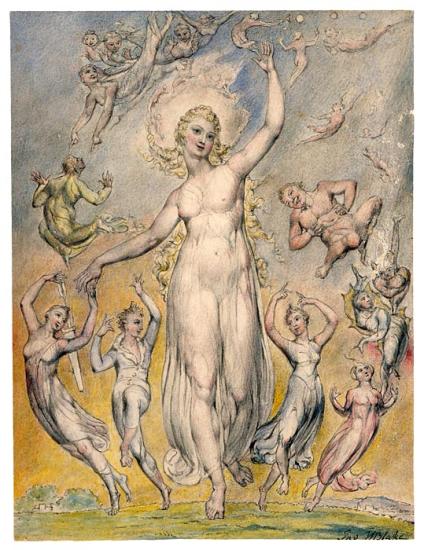
Mirth, illustration to Milton's L'Allegro
Signed in pen and black ink at lower right, Inv. W. Blake
Purchased with the assistance of the Fellows with the special support of Mrs, Landon K. Thorne and Mr. Paul Mellon
This drawing is the first of a series of twelve watercolors executed by Blake around 1816–20 as illustrations to L'Allegro and Il Penseroso, two poems by John Milton (1608–1674), the Romantics' favorite poet. Blake accompanied each watercolor with a transcription of Milton's text as well as an interpretation of the imagery.
Illustrating lines from L'Allegro, this drawing depicts the title figure of Mirth surrounded by the personifications of, among others, "Laughter holding both his sides" at center right; "Jest" and "Youthful Jollity," the boy and girl to the left and right of Mirth; and "Wreathed Smiles," the small spirits encircling Mirth's halo.
William Blake (1757–1827) occupies a unique place in the history of Western art. His creativity included both the visual and literary arts. In his lifetime he was best known as an engraver; now he is also recognized for his innovative poetry, printmaking, and painting. Blake's keen perception of the political and social climate found expression throughout his work. His strong sense of independence is evident in the complex mythology that he constructed in response to the age of revolution.
Blake was already recognized as an engraver at age twenty-five, when his first volume of poems appeared. At thirty-three, in The Marriage of Heaven and Hell, he audaciously claimed that his birth had marked the origin of a "new heaven" in which his own art would exemplify the creativity prefigured by Milton and Michelangelo. By that time, Blake, in one of his most productive periods, had already produced Songs of Innocence and was at work on a series of illuminated books. In 1818 he met John Linnell, a young painter and engraver, through whom a group of young artists became Blake's followers. Calling themselves the Ancients, they helped perpetuate Blake's influence for generations.
The Morgan's Blake collection—one of this country's most distinguished—began with purchases as early as 1899 by Pierpont Morgan. During the tenure of Charles Ryskamp, director from 1969 to 1986, major gifts almost doubled the size of its Blake holdings. In recent years Ryskamp's own gifts of engravings, letters, and related materials have significantly enriched its scholarly resources.
Milton's L'Allegro and Il Penseroso
The Morgan preserves Blake's twelve watercolor designs for Milton's early poems L'Allegro and Il Penseroso that contrast the cheerful man with the melancholic, thoughtful one. Like the illustrations for the Book of Job, Blake created them on commission for Thomas Butts about 1816–20. The two series were separated in 1903 and not reunited until 1949, when they were acquired as the first purchase by the Morgan's newly formed Association of Fellows.
Milton, along with Dante and the Bible, was one of Blake's great inspirations. Blake wrote a long and mystical poem, Milton, and executed several other series of illustrations for Milton's works.
Each of the watercolors in this series is accompanied by Blake's transcription of the relevant portion of the poem as well as his notes on his design.
Mirth. Allegro
1
Heart easing Mirth.
Haste thee Nymph & bring with thee
Jest & Youthful Jollity
Quips & Cranks & Wanton Wiles
Nods & Becks & wreathed smiles
Sport that wrinkled Care derides
And Laughter holding both his sides
Come & trip it as you go
On the light phantastic toe
And in thy right hand lead with thee
The Mountain Nymph Sweet Liberty
These Personifications are all brought together in the First Design. Surrounding the Principal Figure which is Mirth herself
This online exhibition is presented in conjunction with the exhibition William Blake's World: "A New Heaven Is Begun" on view September 11, 2009, through January 3, 2010.
This exhibition is made possible through the generosity of Fay and Geoffrey Elliott.
Melancholy
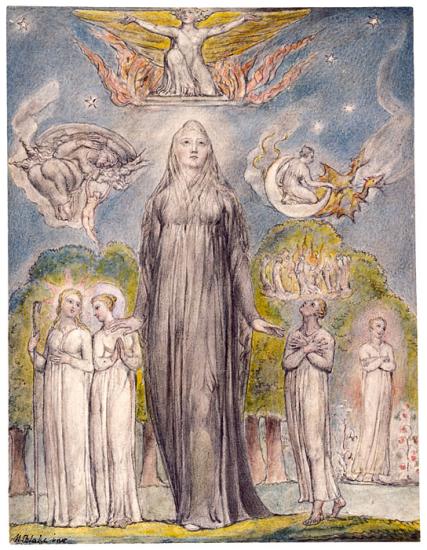
Melancholy
Signed at lower right in pen and black ink, W. Blake inv
Purchased with the support of the Fellows with the special assistance of Mrs. Landon K. Thorne and Paul Mellon
William Blake (1757–1827) occupies a unique place in the history of Western art. His creativity included both the visual and literary arts. In his lifetime he was best known as an engraver; now he is also recognized for his innovative poetry, printmaking, and painting. Blake's keen perception of the political and social climate found expression throughout his work. His strong sense of independence is evident in the complex mythology that he constructed in response to the age of revolution.
Blake was already recognized as an engraver at age twenty-five, when his first volume of poems appeared. At thirty-three, in The Marriage of Heaven and Hell, he audaciously claimed that his birth had marked the origin of a "new heaven" in which his own art would exemplify the creativity prefigured by Milton and Michelangelo. By that time, Blake, in one of his most productive periods, had already produced Songs of Innocence and was at work on a series of illuminated books. In 1818 he met John Linnell, a young painter and engraver, through whom a group of young artists became Blake's followers. Calling themselves the Ancients, they helped perpetuate Blake's influence for generations.
The Morgan's Blake collection—one of this country's most distinguished—began with purchases as early as 1899 by Pierpont Morgan. During the tenure of Charles Ryskamp, director from 1969 to 1986, major gifts almost doubled the size of its Blake holdings. In recent years Ryskamp's own gifts of engravings, letters, and related materials have significantly enriched its scholarly resources.
V. Milton's L'Allegro and Il Penseroso
The Morgan preserves Blake's twelve watercolor designs for Milton's early poems L'Allegro and Il Penseroso that contrast the cheerful man with the melancholic, thoughtful one. Like the illustrations for the Book of Job, Blake created them on commission for Thomas Butts about 1816–20. The two series were separated in 1903 and not reunited until 1949, when they were acquired as the first purchase by the Morgan's newly formed Association of Fellows.
Milton, along with Dante and the Bible, was one of Blake's great inspirations. Blake wrote a long and mystical poem, Milton, and executed several other series of illustrations for Milton's works.
Each of the watercolors in this series is accompanied by Blake's transcription of the relevant portion of the poem as well as his notes on his design.
This online exhibition is presented in conjunction with the exhibition William Blake's World: "A New Heaven Is Begun" on view September 11, 2009, through January 3, 2010.
This exhibition is made possible through the generosity of Fay and Geoffrey Elliott.
The Lark
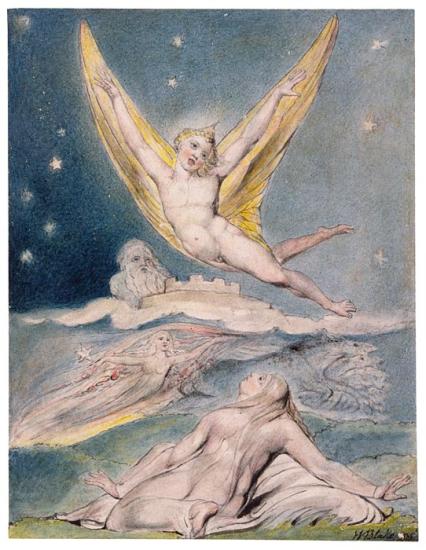
The Lark
Signed at lower right in pen and black ink, W. Blake inv
Purchased with the support of the Fellows with the special assistance of Mrs. Landon K. Thorne and Paul Mellon
William Blake (1757–1827) occupies a unique place in the history of Western art. His creativity included both the visual and literary arts. In his lifetime he was best known as an engraver; now he is also recognized for his innovative poetry, printmaking, and painting. Blake's keen perception of the political and social climate found expression throughout his work. His strong sense of independence is evident in the complex mythology that he constructed in response to the age of revolution.
Blake was already recognized as an engraver at age twenty-five, when his first volume of poems appeared. At thirty-three, in The Marriage of Heaven and Hell, he audaciously claimed that his birth had marked the origin of a "new heaven" in which his own art would exemplify the creativity prefigured by Milton and Michelangelo. By that time, Blake, in one of his most productive periods, had already produced Songs of Innocence and was at work on a series of illuminated books. In 1818 he met John Linnell, a young painter and engraver, through whom a group of young artists became Blake's followers. Calling themselves the Ancients, they helped perpetuate Blake's influence for generations.
The Morgan's Blake collection—one of this country's most distinguished—began with purchases as early as 1899 by Pierpont Morgan. During the tenure of Charles Ryskamp, director from 1969 to 1986, major gifts almost doubled the size of its Blake holdings. In recent years Ryskamp's own gifts of engravings, letters, and related materials have significantly enriched its scholarly resources.
V. Milton's L'Allegro and Il Penseroso
The Morgan preserves Blake's twelve watercolor designs for Milton's early poems L'Allegro and Il Penseroso that contrast the cheerful man with the melancholic, thoughtful one. Like the illustrations for the Book of Job, Blake created them on commission for Thomas Butts about 1816–20. The two series were separated in 1903 and not reunited until 1949, when they were acquired as the first purchase by the Morgan's newly formed Association of Fellows.
Milton, along with Dante and the Bible, was one of Blake's great inspirations. Blake wrote a long and mystical poem, Milton, and executed several other series of illustrations for Milton's works.
Each of the watercolors in this series is accompanied by Blake's transcription of the relevant portion of the poem as well as his notes on his design.
This online exhibition is presented in conjunction with the exhibition William Blake's World: "A New Heaven Is Begun" on view September 11, 2009, through January 3, 2010.
This exhibition is made possible through the generosity of Fay and Geoffrey Elliott.
The Sun at His Eastern Gate
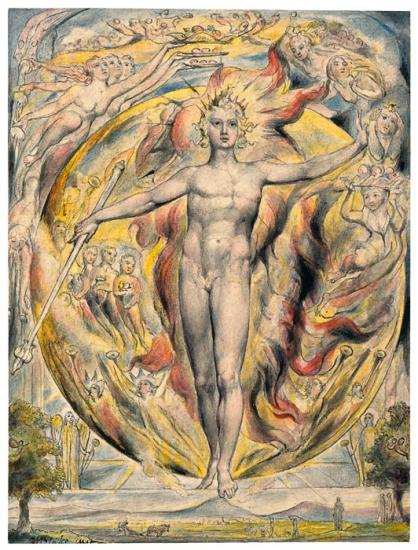
The Sun at His Eastern Gate
Signed at lower right in pen and black ink, W. Blake inv
Purchased with the support of the Fellows with the special assistance of Mrs. Landon K. Thorne and Paul Mellon
William Blake (1757–1827) occupies a unique place in the history of Western art. His creativity included both the visual and literary arts. In his lifetime he was best known as an engraver; now he is also recognized for his innovative poetry, printmaking, and painting. Blake's keen perception of the political and social climate found expression throughout his work. His strong sense of independence is evident in the complex mythology that he constructed in response to the age of revolution.
Blake was already recognized as an engraver at age twenty-five, when his first volume of poems appeared. At thirty-three, in The Marriage of Heaven and Hell, he audaciously claimed that his birth had marked the origin of a "new heaven" in which his own art would exemplify the creativity prefigured by Milton and Michelangelo. By that time, Blake, in one of his most productive periods, had already produced Songs of Innocence and was at work on a series of illuminated books. In 1818 he met John Linnell, a young painter and engraver, through whom a group of young artists became Blake's followers. Calling themselves the Ancients, they helped perpetuate Blake's influence for generations.
The Morgan's Blake collection—one of this country's most distinguished—began with purchases as early as 1899 by Pierpont Morgan. During the tenure of Charles Ryskamp, director from 1969 to 1986, major gifts almost doubled the size of its Blake holdings. In recent years Ryskamp's own gifts of engravings, letters, and related materials have significantly enriched its scholarly resources.
V. Milton's L'Allegro and Il Penseroso
The Morgan preserves Blake's twelve watercolor designs for Milton's early poems L'Allegro and Il Penseroso that contrast the cheerful man with the melancholic, thoughtful one. Like the illustrations for the Book of Job, Blake created them on commission for Thomas Butts about 1816–20. The two series were separated in 1903 and not reunited until 1949, when they were acquired as the first purchase by the Morgan's newly formed Association of Fellows.
Milton, along with Dante and the Bible, was one of Blake's great inspirations. Blake wrote a long and mystical poem, Milton, and executed several other series of illustrations for Milton's works.
Each of the watercolors in this series is accompanied by Blake's transcription of the relevant portion of the poem as well as his notes on his design.
This online exhibition is presented in conjunction with the exhibition William Blake's World: "A New Heaven Is Begun" on view September 11, 2009, through January 3, 2010.
This exhibition is made possible through the generosity of Fay and Geoffrey Elliott.
The Wandring Moon
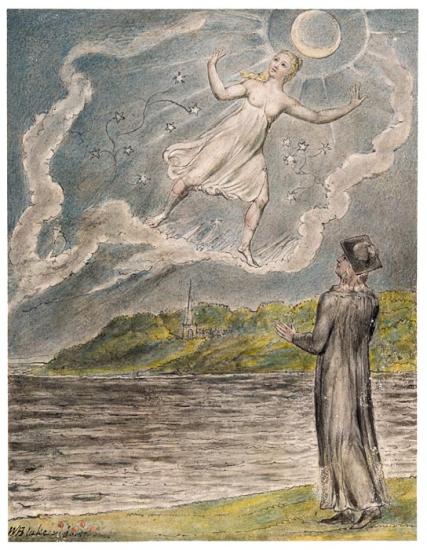
The Wandring Moon
Signed at lower right in pen and black ink, W. Blake inv
Purchased with the support of the Fellows with the special assistance of Mrs. Landon K. Thorne and Paul Mellon
William Blake (1757–1827) occupies a unique place in the history of Western art. His creativity included both the visual and literary arts. In his lifetime he was best known as an engraver; now he is also recognized for his innovative poetry, printmaking, and painting. Blake's keen perception of the political and social climate found expression throughout his work. His strong sense of independence is evident in the complex mythology that he constructed in response to the age of revolution.
Blake was already recognized as an engraver at age twenty-five, when his first volume of poems appeared. At thirty-three, in The Marriage of Heaven and Hell, he audaciously claimed that his birth had marked the origin of a "new heaven" in which his own art would exemplify the creativity prefigured by Milton and Michelangelo. By that time, Blake, in one of his most productive periods, had already produced Songs of Innocence and was at work on a series of illuminated books. In 1818 he met John Linnell, a young painter and engraver, through whom a group of young artists became Blake's followers. Calling themselves the Ancients, they helped perpetuate Blake's influence for generations.
The Morgan's Blake collection—one of this country's most distinguished—began with purchases as early as 1899 by Pierpont Morgan. During the tenure of Charles Ryskamp, director from 1969 to 1986, major gifts almost doubled the size of its Blake holdings. In recent years Ryskamp's own gifts of engravings, letters, and related materials have significantly enriched its scholarly resources.
V. Milton's L'Allegro and Il Penseroso
The Morgan preserves Blake's twelve watercolor designs for Milton's early poems L'Allegro and Il Penseroso that contrast the cheerful man with the melancholic, thoughtful one. Like the illustrations for the Book of Job, Blake created them on commission for Thomas Butts about 1816–20. The two series were separated in 1903 and not reunited until 1949, when they were acquired as the first purchase by the Morgan's newly formed Association of Fellows.
Milton, along with Dante and the Bible, was one of Blake's great inspirations. Blake wrote a long and mystical poem, Milton, and executed several other series of illustrations for Milton's works.
Each of the watercolors in this series is accompanied by Blake's transcription of the relevant portion of the poem as well as his notes on his design.
This online exhibition is presented in conjunction with the exhibition William Blake's World: "A New Heaven Is Begun" on view September 11, 2009, through January 3, 2010.
This exhibition is made possible through the generosity of Fay and Geoffrey Elliott.
A Sunshine Holiday
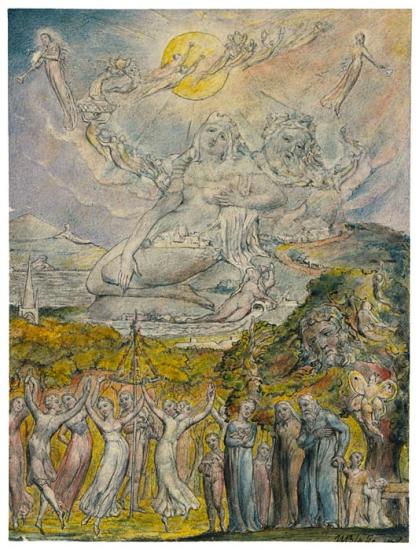
A Sunshine Holiday
Signed at lower right in pen and black ink, W. Blake inv
Purchased with the support of the Fellows with the special assistance of Mrs. Landon K. Thorne and Paul Mellon
William Blake (1757–1827) occupies a unique place in the history of Western art. His creativity included both the visual and literary arts. In his lifetime he was best known as an engraver; now he is also recognized for his innovative poetry, printmaking, and painting. Blake's keen perception of the political and social climate found expression throughout his work. His strong sense of independence is evident in the complex mythology that he constructed in response to the age of revolution.
Blake was already recognized as an engraver at age twenty-five, when his first volume of poems appeared. At thirty-three, in The Marriage of Heaven and Hell, he audaciously claimed that his birth had marked the origin of a "new heaven" in which his own art would exemplify the creativity prefigured by Milton and Michelangelo. By that time, Blake, in one of his most productive periods, had already produced Songs of Innocence and was at work on a series of illuminated books. In 1818 he met John Linnell, a young painter and engraver, through whom a group of young artists became Blake's followers. Calling themselves the Ancients, they helped perpetuate Blake's influence for generations.
The Morgan's Blake collection—one of this country's most distinguished—began with purchases as early as 1899 by Pierpont Morgan. During the tenure of Charles Ryskamp, director from 1969 to 1986, major gifts almost doubled the size of its Blake holdings. In recent years Ryskamp's own gifts of engravings, letters, and related materials have significantly enriched its scholarly resources.
V. Milton's L'Allegro and Il Penseroso
The Morgan preserves Blake's twelve watercolor designs for Milton's early poems L'Allegro and Il Penseroso that contrast the cheerful man with the melancholic, thoughtful one. Like the illustrations for the Book of Job, Blake created them on commission for Thomas Butts about 1816–20. The two series were separated in 1903 and not reunited until 1949, when they were acquired as the first purchase by the Morgan's newly formed Association of Fellows.
Milton, along with Dante and the Bible, was one of Blake's great inspirations. Blake wrote a long and mystical poem, Milton, and executed several other series of illustrations for Milton's works.
Each of the watercolors in this series is accompanied by Blake's transcription of the relevant portion of the poem as well as his notes on his design.
This online exhibition is presented in conjunction with the exhibition William Blake's World: "A New Heaven Is Begun" on view September 11, 2009, through January 3, 2010.
This exhibition is made possible through the generosity of Fay and Geoffrey Elliott.
The Spirit of Plato

The Spirit of Plato
Signed at lower right in pen and black ink, W. Blake inv
Purchased with the support of the Fellows with the special assistance of Mrs. Landon K. Thorne and Paul Mellon
William Blake (1757–1827) occupies a unique place in the history of Western art. His creativity included both the visual and literary arts. In his lifetime he was best known as an engraver; now he is also recognized for his innovative poetry, printmaking, and painting. Blake's keen perception of the political and social climate found expression throughout his work. His strong sense of independence is evident in the complex mythology that he constructed in response to the age of revolution.
Blake was already recognized as an engraver at age twenty-five, when his first volume of poems appeared. At thirty-three, in The Marriage of Heaven and Hell, he audaciously claimed that his birth had marked the origin of a "new heaven" in which his own art would exemplify the creativity prefigured by Milton and Michelangelo. By that time, Blake, in one of his most productive periods, had already produced Songs of Innocence and was at work on a series of illuminated books. In 1818 he met John Linnell, a young painter and engraver, through whom a group of young artists became Blake's followers. Calling themselves the Ancients, they helped perpetuate Blake's influence for generations.
The Morgan's Blake collection—one of this country's most distinguished—began with purchases as early as 1899 by Pierpont Morgan. During the tenure of Charles Ryskamp, director from 1969 to 1986, major gifts almost doubled the size of its Blake holdings. In recent years Ryskamp's own gifts of engravings, letters, and related materials have significantly enriched its scholarly resources.
V. Milton's L'Allegro and Il Penseroso
The Morgan preserves Blake's twelve watercolor designs for Milton's early poems L'Allegro and Il Penseroso that contrast the cheerful man with the melancholic, thoughtful one. Like the illustrations for the Book of Job, Blake created them on commission for Thomas Butts about 1816–20. The two series were separated in 1903 and not reunited until 1949, when they were acquired as the first purchase by the Morgan's newly formed Association of Fellows.
Milton, along with Dante and the Bible, was one of Blake's great inspirations. Blake wrote a long and mystical poem, Milton, and executed several other series of illustrations for Milton's works.
Each of the watercolors in this series is accompanied by Blake's transcription of the relevant portion of the poem as well as his notes on his design.
This online exhibition is presented in conjunction with the exhibition William Blake's World: "A New Heaven Is Begun" on view September 11, 2009, through January 3, 2010.
This exhibition is made possible through the generosity of Fay and Geoffrey Elliott.
The Goblin
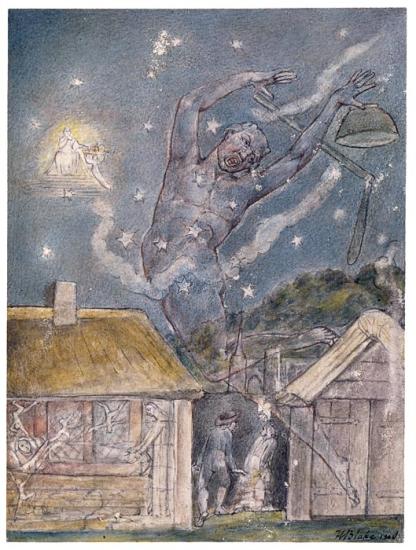
The Goblin
Signed at lower right in pen and black ink, W. Blake inv
Purchased with the support of the Fellows with the special assistance of Mrs. Landon K. Thorne and Paul Mellon
William Blake (1757–1827) occupies a unique place in the history of Western art. His creativity included both the visual and literary arts. In his lifetime he was best known as an engraver; now he is also recognized for his innovative poetry, printmaking, and painting. Blake's keen perception of the political and social climate found expression throughout his work. His strong sense of independence is evident in the complex mythology that he constructed in response to the age of revolution.
Blake was already recognized as an engraver at age twenty-five, when his first volume of poems appeared. At thirty-three, in The Marriage of Heaven and Hell, he audaciously claimed that his birth had marked the origin of a "new heaven" in which his own art would exemplify the creativity prefigured by Milton and Michelangelo. By that time, Blake, in one of his most productive periods, had already produced Songs of Innocence and was at work on a series of illuminated books. In 1818 he met John Linnell, a young painter and engraver, through whom a group of young artists became Blake's followers. Calling themselves the Ancients, they helped perpetuate Blake's influence for generations.
The Morgan's Blake collection—one of this country's most distinguished—began with purchases as early as 1899 by Pierpont Morgan. During the tenure of Charles Ryskamp, director from 1969 to 1986, major gifts almost doubled the size of its Blake holdings. In recent years Ryskamp's own gifts of engravings, letters, and related materials have significantly enriched its scholarly resources.
V. Milton's L'Allegro and Il Penseroso
The Morgan preserves Blake's twelve watercolor designs for Milton's early poems L'Allegro and Il Penseroso that contrast the cheerful man with the melancholic, thoughtful one. Like the illustrations for the Book of Job, Blake created them on commission for Thomas Butts about 1816–20. The two series were separated in 1903 and not reunited until 1949, when they were acquired as the first purchase by the Morgan's newly formed Association of Fellows.
Milton, along with Dante and the Bible, was one of Blake's great inspirations. Blake wrote a long and mystical poem, Milton, and executed several other series of illustrations for Milton's works.
Each of the watercolors in this series is accompanied by Blake's transcription of the relevant portion of the poem as well as his notes on his design.
This online exhibition is presented in conjunction with the exhibition William Blake's World: "A New Heaven Is Begun" on view September 11, 2009, through January 3, 2010.
This exhibition is made possible through the generosity of Fay and Geoffrey Elliott.
The Sun in His Wrath
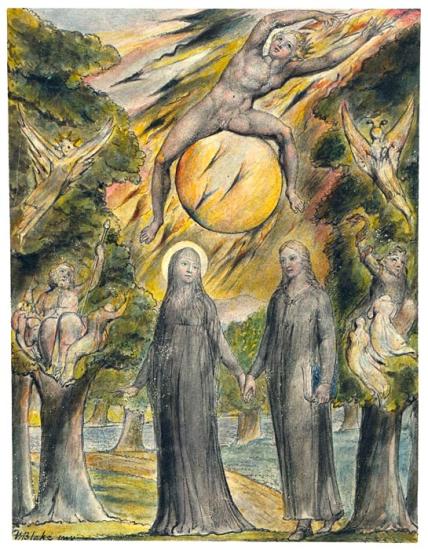
The Sun in His Wrath
Signed at lower right in pen and black ink, W. Blake inv
Purchased with the support of the Fellows with the special assistance of Mrs. Landon K. Thorne and Paul Mellon
William Blake (1757–1827) occupies a unique place in the history of Western art. His creativity included both the visual and literary arts. In his lifetime he was best known as an engraver; now he is also recognized for his innovative poetry, printmaking, and painting. Blake's keen perception of the political and social climate found expression throughout his work. His strong sense of independence is evident in the complex mythology that he constructed in response to the age of revolution.
Blake was already recognized as an engraver at age twenty-five, when his first volume of poems appeared. At thirty-three, in The Marriage of Heaven and Hell, he audaciously claimed that his birth had marked the origin of a "new heaven" in which his own art would exemplify the creativity prefigured by Milton and Michelangelo. By that time, Blake, in one of his most productive periods, had already produced Songs of Innocence and was at work on a series of illuminated books. In 1818 he met John Linnell, a young painter and engraver, through whom a group of young artists became Blake's followers. Calling themselves the Ancients, they helped perpetuate Blake's influence for generations.
The Morgan's Blake collection—one of this country's most distinguished—began with purchases as early as 1899 by Pierpont Morgan. During the tenure of Charles Ryskamp, director from 1969 to 1986, major gifts almost doubled the size of its Blake holdings. In recent years Ryskamp's own gifts of engravings, letters, and related materials have significantly enriched its scholarly resources.
V. Milton's L'Allegro and Il Penseroso
The Morgan preserves Blake's twelve watercolor designs for Milton's early poems L'Allegro and Il Penseroso that contrast the cheerful man with the melancholic, thoughtful one. Like the illustrations for the Book of Job, Blake created them on commission for Thomas Butts about 1816–20. The two series were separated in 1903 and not reunited until 1949, when they were acquired as the first purchase by the Morgan's newly formed Association of Fellows.
Milton, along with Dante and the Bible, was one of Blake's great inspirations. Blake wrote a long and mystical poem, Milton, and executed several other series of illustrations for Milton's works.
Each of the watercolors in this series is accompanied by Blake's transcription of the relevant portion of the poem as well as his notes on his design.
This online exhibition is presented in conjunction with the exhibition William Blake's World: "A New Heaven Is Begun" on view September 11, 2009, through January 3, 2010.
This exhibition is made possible through the generosity of Fay and Geoffrey Elliott.
Mysterious Dream
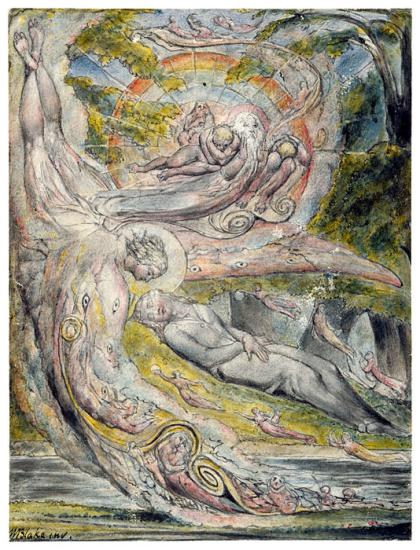
Mysterious Dream
Signed at lower right in pen and black ink, W. Blake inv
Purchased with the support of the Fellows with the special assistance of Mrs. Landon K. Thorne and Paul Mellon
William Blake (1757–1827) occupies a unique place in the history of Western art. His creativity included both the visual and literary arts. In his lifetime he was best known as an engraver; now he is also recognized for his innovative poetry, printmaking, and painting. Blake's keen perception of the political and social climate found expression throughout his work. His strong sense of independence is evident in the complex mythology that he constructed in response to the age of revolution.
Blake was already recognized as an engraver at age twenty-five, when his first volume of poems appeared. At thirty-three, in The Marriage of Heaven and Hell, he audaciously claimed that his birth had marked the origin of a "new heaven" in which his own art would exemplify the creativity prefigured by Milton and Michelangelo. By that time, Blake, in one of his most productive periods, had already produced Songs of Innocence and was at work on a series of illuminated books. In 1818 he met John Linnell, a young painter and engraver, through whom a group of young artists became Blake's followers. Calling themselves the Ancients, they helped perpetuate Blake's influence for generations.
The Morgan's Blake collection—one of this country's most distinguished—began with purchases as early as 1899 by Pierpont Morgan. During the tenure of Charles Ryskamp, director from 1969 to 1986, major gifts almost doubled the size of its Blake holdings. In recent years Ryskamp's own gifts of engravings, letters, and related materials have significantly enriched its scholarly resources.
V. Milton's L'Allegro and Il Penseroso
The Morgan preserves Blake's twelve watercolor designs for Milton's early poems L'Allegro and Il Penseroso that contrast the cheerful man with the melancholic, thoughtful one. Like the illustrations for the Book of Job, Blake created them on commission for Thomas Butts about 1816–20. The two series were separated in 1903 and not reunited until 1949, when they were acquired as the first purchase by the Morgan's newly formed Association of Fellows.
Milton, along with Dante and the Bible, was one of Blake's great inspirations. Blake wrote a long and mystical poem, Milton, and executed several other series of illustrations for Milton's works.
Each of the watercolors in this series is accompanied by Blake's transcription of the relevant portion of the poem as well as his notes on his design.
This online exhibition is presented in conjunction with the exhibition William Blake's World: "A New Heaven Is Begun" on view September 11, 2009, through January 3, 2010.
This exhibition is made possible through the generosity of Fay and Geoffrey Elliott.
The Youthful Poet's Dream

The Youthful Poet's Dream
Signed at lower right in pen and black ink, W. Blake inv
Purchased with the support of the Fellows with the special assistance of Mrs. Landon K. Thorne and Paul Mellon
William Blake (1757–1827) occupies a unique place in the history of Western art. His creativity included both the visual and literary arts. In his lifetime he was best known as an engraver; now he is also recognized for his innovative poetry, printmaking, and painting. Blake's keen perception of the political and social climate found expression throughout his work. His strong sense of independence is evident in the complex mythology that he constructed in response to the age of revolution.
Blake was already recognized as an engraver at age twenty-five, when his first volume of poems appeared. At thirty-three, in The Marriage of Heaven and Hell, he audaciously claimed that his birth had marked the origin of a "new heaven" in which his own art would exemplify the creativity prefigured by Milton and Michelangelo. By that time, Blake, in one of his most productive periods, had already produced Songs of Innocence and was at work on a series of illuminated books. In 1818 he met John Linnell, a young painter and engraver, through whom a group of young artists became Blake's followers. Calling themselves the Ancients, they helped perpetuate Blake's influence for generations.
The Morgan's Blake collection—one of this country's most distinguished—began with purchases as early as 1899 by Pierpont Morgan. During the tenure of Charles Ryskamp, director from 1969 to 1986, major gifts almost doubled the size of its Blake holdings. In recent years Ryskamp's own gifts of engravings, letters, and related materials have significantly enriched its scholarly resources.
V. Milton's L'Allegro and Il Penseroso
The Morgan preserves Blake's twelve watercolor designs for Milton's early poems L'Allegro and Il Penseroso that contrast the cheerful man with the melancholic, thoughtful one. Like the illustrations for the Book of Job, Blake created them on commission for Thomas Butts about 1816–20. The two series were separated in 1903 and not reunited until 1949, when they were acquired as the first purchase by the Morgan's newly formed Association of Fellows.
Milton, along with Dante and the Bible, was one of Blake's great inspirations. Blake wrote a long and mystical poem, Milton, and executed several other series of illustrations for Milton's works.
Each of the watercolors in this series is accompanied by Blake's transcription of the relevant portion of the poem as well as his notes on his design.
This online exhibition is presented in conjunction with the exhibition William Blake's World: "A New Heaven Is Begun" on view September 11, 2009, through January 3, 2010.
This exhibition is made possible through the generosity of Fay and Geoffrey Elliott.
Milton, Old Age
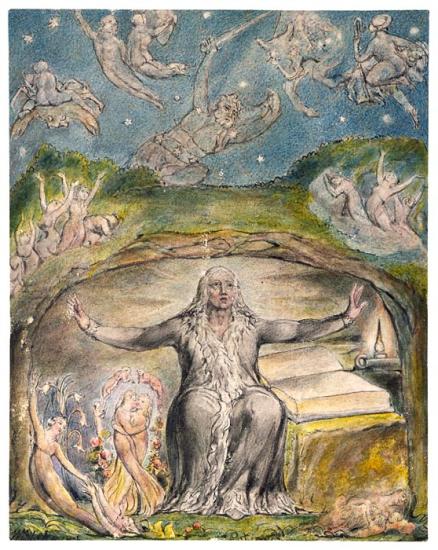
Milton, Old Age
Signed at lower right in pen and black ink, W. Blake inv
Purchased with the support of the Fellows with the special assistance of Mrs. Landon K. Thorne and Paul Mellon
William Blake (1757–1827) occupies a unique place in the history of Western art. His creativity included both the visual and literary arts. In his lifetime he was best known as an engraver; now he is also recognized for his innovative poetry, printmaking, and painting. Blake's keen perception of the political and social climate found expression throughout his work. His strong sense of independence is evident in the complex mythology that he constructed in response to the age of revolution.
Blake was already recognized as an engraver at age twenty-five, when his first volume of poems appeared. At thirty-three, in The Marriage of Heaven and Hell, he audaciously claimed that his birth had marked the origin of a "new heaven" in which his own art would exemplify the creativity prefigured by Milton and Michelangelo. By that time, Blake, in one of his most productive periods, had already produced Songs of Innocence and was at work on a series of illuminated books. In 1818 he met John Linnell, a young painter and engraver, through whom a group of young artists became Blake's followers. Calling themselves the Ancients, they helped perpetuate Blake's influence for generations.
The Morgan's Blake collection—one of this country's most distinguished—began with purchases as early as 1899 by Pierpont Morgan. During the tenure of Charles Ryskamp, director from 1969 to 1986, major gifts almost doubled the size of its Blake holdings. In recent years Ryskamp's own gifts of engravings, letters, and related materials have significantly enriched its scholarly resources.
V. Milton's L'Allegro and Il Penseroso
The Morgan preserves Blake's twelve watercolor designs for Milton's early poems L'Allegro and Il Penseroso that contrast the cheerful man with the melancholic, thoughtful one. Like the illustrations for the Book of Job, Blake created them on commission for Thomas Butts about 1816–20. The two series were separated in 1903 and not reunited until 1949, when they were acquired as the first purchase by the Morgan's newly formed Association of Fellows.
Milton, along with Dante and the Bible, was one of Blake's great inspirations. Blake wrote a long and mystical poem, Milton, and executed several other series of illustrations for Milton's works.
Each of the watercolors in this series is accompanied by Blake's transcription of the relevant portion of the poem as well as his notes on his design.
This online exhibition is presented in conjunction with the exhibition William Blake's World: "A New Heaven Is Begun" on view September 11, 2009, through January 3, 2010.
This exhibition is made possible through the generosity of Fay and Geoffrey Elliott.
Illustrations of the Book of Job

Pl. 2. Satan Before the Throne of God
Illustrations of the Book of Job
London: Published . . . by William Blake, [1826]
Engravings
Gift of Mrs. Landon K. Thorne, 1973
Job's tribulations engaged Blake's imagination early. A tempera painting called Job and His Daughters, executed about 1799 or 1800 for Thomas Butts, is an example. Butts also commissioned the watercolor series that you see behind you, which was produced between 1805 and 1810 and comprised nineteen drawings. In 1821, Blake borrowed them to copy for John Linnell. At that time two new drawings (pls. 17 and 20) were added, extending the group to twenty-one. In 1823, with Linnell's encouragement and financial support, Blake re-created the images as a series of magnificent engravings that were published in 1826. The border motifs were designed directly on the plate.
At his death, Blake was working on another brilliant series of engravings, this time devoted to Dante. Copies of that work are also in the Morgan's collections.
William Blake (1757–1827) occupies a unique place in the history of Western art. His creativity included both the visual and literary arts. In his lifetime he was best known as an engraver; now he is also recognized for his innovative poetry, printmaking, and painting. Blake's keen perception of the political and social climate found expression throughout his work. His strong sense of independence is evident in the complex mythology that he constructed in response to the age of revolution.
Blake was already recognized as an engraver at age twenty-five, when his first volume of poems appeared. At thirty-three, in The Marriage of Heaven and Hell, he audaciously claimed that his birth had marked the origin of a "new heaven" in which his own art would exemplify the creativity prefigured by Milton and Michelangelo. By that time, Blake, in one of his most productive periods, had already produced Songs of Innocence and was at work on a series of illuminated books. In 1818 he met John Linnell, a young painter and engraver, through whom a group of young artists became Blake's followers. Calling themselves the Ancients, they helped perpetuate Blake's influence for generations.
The Morgan's Blake collection—one of this country's most distinguished—began with purchases as early as 1899 by Pierpont Morgan. During the tenure of Charles Ryskamp, director from 1969 to 1986, major gifts almost doubled the size of its Blake holdings. In recent years Ryskamp's own gifts of engravings, letters, and related materials have significantly enriched its scholarly resources.
This online exhibition is presented in conjunction with the exhibition William Blake's World: "A New Heaven Is Begun" on view September 11, 2009, through January 3, 2010.
This exhibition is made possible through the generosity of Fay and Geoffrey Elliott.
Illustrations of the Book of Job, Pl. 13.
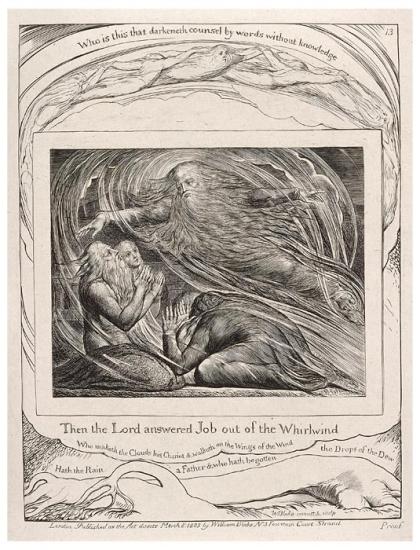
Pl. 13. The Lord Answering Job Out of the Whirlwind
Illustrations of the Book of Job
London: Published . . . by William Blake, [1826]
Engravings
Gift of Mrs. Landon K. Thorne, 1973
Job's tribulations engaged Blake's imagination early. A tempera painting called Job and His Daughters, executed about 1799 or 1800 for Thomas Butts, is an example. Butts also commissioned the watercolor series that you see behind you, which was produced between 1805 and 1810 and comprised nineteen drawings. In 1821, Blake borrowed them to copy for John Linnell. At that time two new drawings (pls. 17 and 20) were added, extending the group to twenty-one. In 1823, with Linnell's encouragement and financial support, Blake re-created the images as a series of magnificent engravings that were published in 1826. The border motifs were designed directly on the plate.
At his death, Blake was working on another brilliant series of engravings, this time devoted to Dante. Copies of that work are also in the Morgan's collections.
William Blake (1757–1827) occupies a unique place in the history of Western art. His creativity included both the visual and literary arts. In his lifetime he was best known as an engraver; now he is also recognized for his innovative poetry, printmaking, and painting. Blake's keen perception of the political and social climate found expression throughout his work. His strong sense of independence is evident in the complex mythology that he constructed in response to the age of revolution.
Blake was already recognized as an engraver at age twenty-five, when his first volume of poems appeared. At thirty-three, in The Marriage of Heaven and Hell, he audaciously claimed that his birth had marked the origin of a "new heaven" in which his own art would exemplify the creativity prefigured by Milton and Michelangelo. By that time, Blake, in one of his most productive periods, had already produced Songs of Innocence and was at work on a series of illuminated books. In 1818 he met John Linnell, a young painter and engraver, through whom a group of young artists became Blake's followers. Calling themselves the Ancients, they helped perpetuate Blake's influence for generations.
The Morgan's Blake collection—one of this country's most distinguished—began with purchases as early as 1899 by Pierpont Morgan. During the tenure of Charles Ryskamp, director from 1969 to 1986, major gifts almost doubled the size of its Blake holdings. In recent years Ryskamp's own gifts of engravings, letters, and related materials have significantly enriched its scholarly resources.
This online exhibition is presented in conjunction with the exhibition William Blake's World: "A New Heaven Is Begun" on view September 11, 2009, through January 3, 2010.
This exhibition is made possible through the generosity of Fay and Geoffrey Elliott.
Illustrations of the Book of Job, Pl. 15.
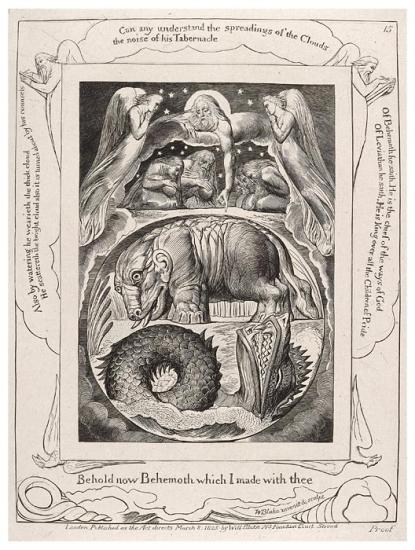
Pl. 15. Behemoth and Leviathan
Illustrations of the Book of Job
London: Published . . . by William Blake, [1826]
Engravings
Gift of Mrs. Landon K. Thorne, 1973
Job's tribulations engaged Blake's imagination early. A tempera painting called Job and His Daughters, executed about 1799 or 1800 for Thomas Butts, is an example. Butts also commissioned the watercolor series that you see behind you, which was produced between 1805 and 1810 and comprised nineteen drawings. In 1821, Blake borrowed them to copy for John Linnell. At that time two new drawings (pls. 17 and 20) were added, extending the group to twenty-one. In 1823, with Linnell's encouragement and financial support, Blake re-created the images as a series of magnificent engravings that were published in 1826. The border motifs were designed directly on the plate.
At his death, Blake was working on another brilliant series of engravings, this time devoted to Dante. Copies of that work are also in the Morgan's collections.
William Blake (1757–1827) occupies a unique place in the history of Western art. His creativity included both the visual and literary arts. In his lifetime he was best known as an engraver; now he is also recognized for his innovative poetry, printmaking, and painting. Blake's keen perception of the political and social climate found expression throughout his work. His strong sense of independence is evident in the complex mythology that he constructed in response to the age of revolution.
Blake was already recognized as an engraver at age twenty-five, when his first volume of poems appeared. At thirty-three, in The Marriage of Heaven and Hell, he audaciously claimed that his birth had marked the origin of a "new heaven" in which his own art would exemplify the creativity prefigured by Milton and Michelangelo. By that time, Blake, in one of his most productive periods, had already produced Songs of Innocence and was at work on a series of illuminated books. In 1818 he met John Linnell, a young painter and engraver, through whom a group of young artists became Blake's followers. Calling themselves the Ancients, they helped perpetuate Blake's influence for generations.
The Morgan's Blake collection—one of this country's most distinguished—began with purchases as early as 1899 by Pierpont Morgan. During the tenure of Charles Ryskamp, director from 1969 to 1986, major gifts almost doubled the size of its Blake holdings. In recent years Ryskamp's own gifts of engravings, letters, and related materials have significantly enriched its scholarly resources.
This online exhibition is presented in conjunction with the exhibition William Blake's World: "A New Heaven Is Begun" on view September 11, 2009, through January 3, 2010.
This exhibition is made possible through the generosity of Fay and Geoffrey Elliott.
Illustrations of the Book of Job, Pl. 22.
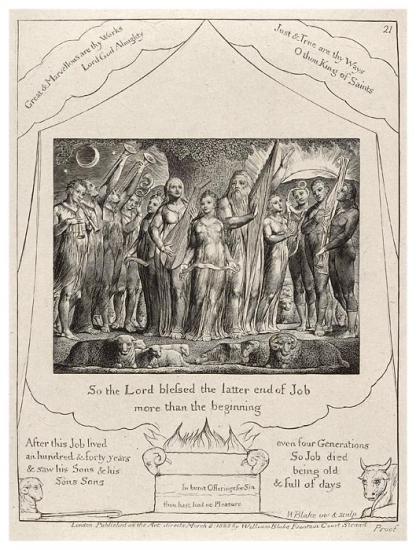
Pl. 21. Job and His Family Restored to Prosperity
Illustrations of the Book of Job
London: Published . . . by William Blake, [1826]
Engravings
Gift of Mrs. Landon K. Thorne, 1973
Job's tribulations engaged Blake's imagination early. A tempera painting called Job and His Daughters, executed about 1799 or 1800 for Thomas Butts, is an example. Butts also commissioned the watercolor series that you see behind you, which was produced between 1805 and 1810 and comprised nineteen drawings. In 1821, Blake borrowed them to copy for John Linnell. At that time two new drawings (pls. 17 and 20) were added, extending the group to twenty-one. In 1823, with Linnell's encouragement and financial support, Blake re-created the images as a series of magnificent engravings that were published in 1826. The border motifs were designed directly on the plate.
At his death, Blake was working on another brilliant series of engravings, this time devoted to Dante. Copies of that work are also in the Morgan's collections.
William Blake (1757–1827) occupies a unique place in the history of Western art. His creativity included both the visual and literary arts. In his lifetime he was best known as an engraver; now he is also recognized for his innovative poetry, printmaking, and painting. Blake's keen perception of the political and social climate found expression throughout his work. His strong sense of independence is evident in the complex mythology that he constructed in response to the age of revolution.
Blake was already recognized as an engraver at age twenty-five, when his first volume of poems appeared. At thirty-three, in The Marriage of Heaven and Hell, he audaciously claimed that his birth had marked the origin of a "new heaven" in which his own art would exemplify the creativity prefigured by Milton and Michelangelo. By that time, Blake, in one of his most productive periods, had already produced Songs of Innocence and was at work on a series of illuminated books. In 1818 he met John Linnell, a young painter and engraver, through whom a group of young artists became Blake's followers. Calling themselves the Ancients, they helped perpetuate Blake's influence for generations.
The Morgan's Blake collection—one of this country's most distinguished—began with purchases as early as 1899 by Pierpont Morgan. During the tenure of Charles Ryskamp, director from 1969 to 1986, major gifts almost doubled the size of its Blake holdings. In recent years Ryskamp's own gifts of engravings, letters, and related materials have significantly enriched its scholarly resources.
This online exhibition is presented in conjunction with the exhibition William Blake's World: "A New Heaven Is Begun" on view September 11, 2009, through January 3, 2010.
This exhibition is made possible through the generosity of Fay and Geoffrey Elliott.
The First Book of Urizen
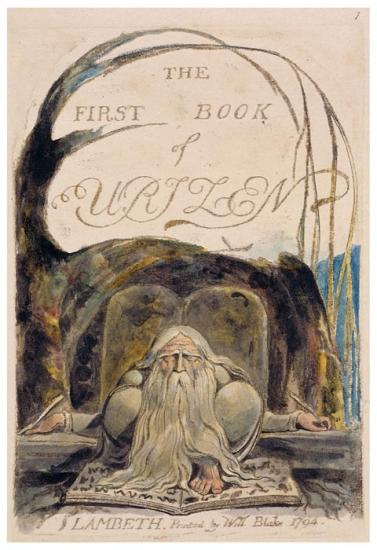
The First Book of Urizen
Lambeth: Printed by William Blake, 1794
Copy B
Gift of Mrs. Landon K. Thorne, 1972
The First Book of Urizen, The Book of Los, and The Book of Ahania constitute an unorthodox rewriting of the Pentateuch. This mythic transformation of the Jewish and Christian Scriptures offers many perspectives, but to highlight the biblical relationships, Blake designed the leaves to contain two columns of text. The work exemplifies his own radical spirit. A total of eight copies exist; this copy is one of only two containing the complete series of twenty-eight plates.
William Blake (1757–1827) occupies a unique place in the history of Western art. His creativity included both the visual and literary arts. In his lifetime he was best known as an engraver; now he is also recognized for his innovative poetry, printmaking, and painting. Blake's keen perception of the political and social climate found expression throughout his work. His strong sense of independence is evident in the complex mythology that he constructed in response to the age of revolution.
Blake was already recognized as an engraver at age twenty-five, when his first volume of poems appeared. At thirty-three, in The Marriage of Heaven and Hell, he audaciously claimed that his birth had marked the origin of a "new heaven" in which his own art would exemplify the creativity prefigured by Milton and Michelangelo. By that time, Blake, in one of his most productive periods, had already produced Songs of Innocence and was at work on a series of illuminated books. In 1818 he met John Linnell, a young painter and engraver, through whom a group of young artists became Blake's followers. Calling themselves the Ancients, they helped perpetuate Blake's influence for generations.
The Morgan's Blake collection—one of this country's most distinguished—began with purchases as early as 1899 by Pierpont Morgan. During the tenure of Charles Ryskamp, director from 1969 to 1986, major gifts almost doubled the size of its Blake holdings. In recent years Ryskamp's own gifts of engravings, letters, and related materials have significantly enriched its scholarly resources.
This online exhibition is presented in conjunction with the exhibition William Blake's World: "A New Heaven Is Begun" on view September 11, 2009, through January 3, 2010.
This exhibition is made possible through the generosity of Fay and Geoffrey Elliott.
The First Book of Urizen 2

The First Book of Urizen
Lambeth: Printed by William Blake, 1794
Copy B
Gift of Mrs. Landon K. Thorne, 1972
The First Book of Urizen, The Book of Los, and The Book of Ahania constitute an unorthodox rewriting of the Pentateuch. This mythic transformation of the Jewish and Christian Scriptures offers many perspectives, but to highlight the biblical relationships, Blake designed the leaves to contain two columns of text. The work exemplifies his own radical spirit. A total of eight copies exist; this copy is one of only two containing the complete series of twenty-eight plates.
William Blake (1757–1827) occupies a unique place in the history of Western art. His creativity included both the visual and literary arts. In his lifetime he was best known as an engraver; now he is also recognized for his innovative poetry, printmaking, and painting. Blake's keen perception of the political and social climate found expression throughout his work. His strong sense of independence is evident in the complex mythology that he constructed in response to the age of revolution.
Blake was already recognized as an engraver at age twenty-five, when his first volume of poems appeared. At thirty-three, in The Marriage of Heaven and Hell, he audaciously claimed that his birth had marked the origin of a "new heaven" in which his own art would exemplify the creativity prefigured by Milton and Michelangelo. By that time, Blake, in one of his most productive periods, had already produced Songs of Innocence and was at work on a series of illuminated books. In 1818 he met John Linnell, a young painter and engraver, through whom a group of young artists became Blake's followers. Calling themselves the Ancients, they helped perpetuate Blake's influence for generations.
The Morgan's Blake collection—one of this country's most distinguished—began with purchases as early as 1899 by Pierpont Morgan. During the tenure of Charles Ryskamp, director from 1969 to 1986, major gifts almost doubled the size of its Blake holdings. In recent years Ryskamp's own gifts of engravings, letters, and related materials have significantly enriched its scholarly resources.
This online exhibition is presented in conjunction with the exhibition William Blake's World: "A New Heaven Is Begun" on view September 11, 2009, through January 3, 2010.
This exhibition is made possible through the generosity of Fay and Geoffrey Elliott.
The First Book of Urizen 7
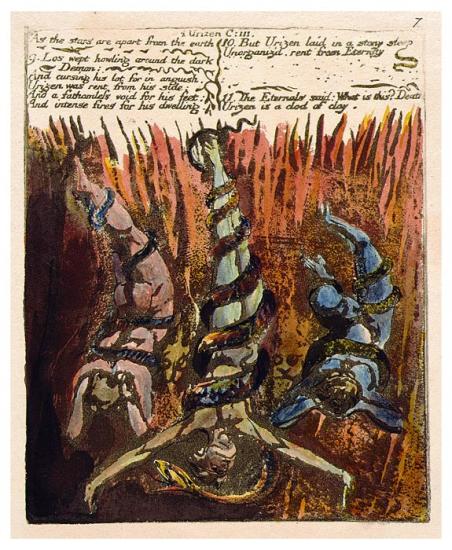
The First Book of Urizen
Lambeth: Printed by William Blake, 1794
Copy B
Gift of Mrs. Landon K. Thorne, 1972
The First Book of Urizen, The Book of Los, and The Book of Ahania constitute an unorthodox rewriting of the Pentateuch. This mythic transformation of the Jewish and Christian Scriptures offers many perspectives, but to highlight the biblical relationships, Blake designed the leaves to contain two columns of text. The work exemplifies his own radical spirit. A total of eight copies exist; this copy is one of only two containing the complete series of twenty-eight plates.
William Blake (1757–1827) occupies a unique place in the history of Western art. His creativity included both the visual and literary arts. In his lifetime he was best known as an engraver; now he is also recognized for his innovative poetry, printmaking, and painting. Blake's keen perception of the political and social climate found expression throughout his work. His strong sense of independence is evident in the complex mythology that he constructed in response to the age of revolution.
Blake was already recognized as an engraver at age twenty-five, when his first volume of poems appeared. At thirty-three, in The Marriage of Heaven and Hell, he audaciously claimed that his birth had marked the origin of a "new heaven" in which his own art would exemplify the creativity prefigured by Milton and Michelangelo. By that time, Blake, in one of his most productive periods, had already produced Songs of Innocence and was at work on a series of illuminated books. In 1818 he met John Linnell, a young painter and engraver, through whom a group of young artists became Blake's followers. Calling themselves the Ancients, they helped perpetuate Blake's influence for generations.
The Morgan's Blake collection—one of this country's most distinguished—began with purchases as early as 1899 by Pierpont Morgan. During the tenure of Charles Ryskamp, director from 1969 to 1986, major gifts almost doubled the size of its Blake holdings. In recent years Ryskamp's own gifts of engravings, letters, and related materials have significantly enriched its scholarly resources.
This online exhibition is presented in conjunction with the exhibition William Blake's World: "A New Heaven Is Begun" on view September 11, 2009, through January 3, 2010.
This exhibition is made possible through the generosity of Fay and Geoffrey Elliott.
The First Book of Urizen 3
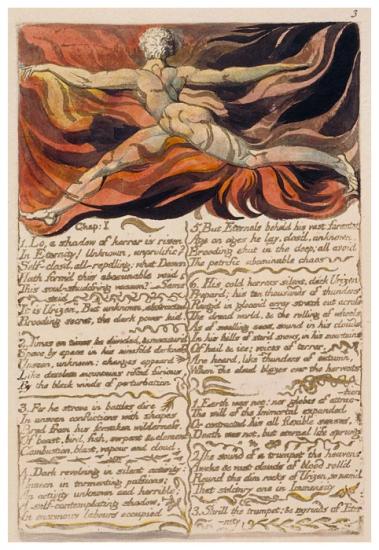
The First Book of Urizen
Lambeth: Printed by William Blake, 1794
Copy B
Gift of Mrs. Landon K. Thorne, 1972
The First Book of Urizen, The Book of Los, and The Book of Ahania constitute an unorthodox rewriting of the Pentateuch. This mythic transformation of the Jewish and Christian Scriptures offers many perspectives, but to highlight the biblical relationships, Blake designed the leaves to contain two columns of text. The work exemplifies his own radical spirit. A total of eight copies exist; this copy is one of only two containing the complete series of twenty-eight plates.
William Blake (1757–1827) occupies a unique place in the history of Western art. His creativity included both the visual and literary arts. In his lifetime he was best known as an engraver; now he is also recognized for his innovative poetry, printmaking, and painting. Blake's keen perception of the political and social climate found expression throughout his work. His strong sense of independence is evident in the complex mythology that he constructed in response to the age of revolution.
Blake was already recognized as an engraver at age twenty-five, when his first volume of poems appeared. At thirty-three, in The Marriage of Heaven and Hell, he audaciously claimed that his birth had marked the origin of a "new heaven" in which his own art would exemplify the creativity prefigured by Milton and Michelangelo. By that time, Blake, in one of his most productive periods, had already produced Songs of Innocence and was at work on a series of illuminated books. In 1818 he met John Linnell, a young painter and engraver, through whom a group of young artists became Blake's followers. Calling themselves the Ancients, they helped perpetuate Blake's influence for generations.
The Morgan's Blake collection—one of this country's most distinguished—began with purchases as early as 1899 by Pierpont Morgan. During the tenure of Charles Ryskamp, director from 1969 to 1986, major gifts almost doubled the size of its Blake holdings. In recent years Ryskamp's own gifts of engravings, letters, and related materials have significantly enriched its scholarly resources.
This online exhibition is presented in conjunction with the exhibition William Blake's World: "A New Heaven Is Begun" on view September 11, 2009, through January 3, 2010.
This exhibition is made possible through the generosity of Fay and Geoffrey Elliott.
The First Book of Urizen 8
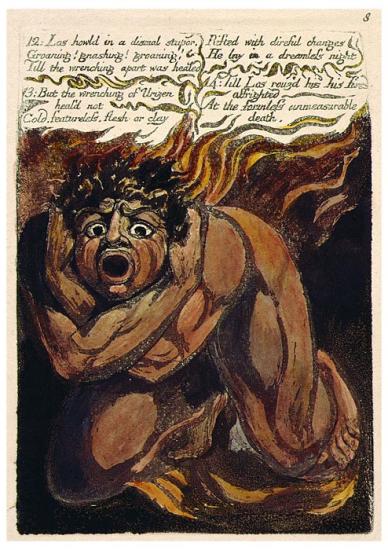
The First Book of Urizen
Lambeth: Printed by William Blake, 1794
Copy B
Gift of Mrs. Landon K. Thorne, 1972
The First Book of Urizen, The Book of Los, and The Book of Ahania constitute an unorthodox rewriting of the Pentateuch. This mythic transformation of the Jewish and Christian Scriptures offers many perspectives, but to highlight the biblical relationships, Blake designed the leaves to contain two columns of text. The work exemplifies his own radical spirit. A total of eight copies exist; this copy is one of only two containing the complete series of twenty-eight plates.
William Blake (1757–1827) occupies a unique place in the history of Western art. His creativity included both the visual and literary arts. In his lifetime he was best known as an engraver; now he is also recognized for his innovative poetry, printmaking, and painting. Blake's keen perception of the political and social climate found expression throughout his work. His strong sense of independence is evident in the complex mythology that he constructed in response to the age of revolution.
Blake was already recognized as an engraver at age twenty-five, when his first volume of poems appeared. At thirty-three, in The Marriage of Heaven and Hell, he audaciously claimed that his birth had marked the origin of a "new heaven" in which his own art would exemplify the creativity prefigured by Milton and Michelangelo. By that time, Blake, in one of his most productive periods, had already produced Songs of Innocence and was at work on a series of illuminated books. In 1818 he met John Linnell, a young painter and engraver, through whom a group of young artists became Blake's followers. Calling themselves the Ancients, they helped perpetuate Blake's influence for generations.
The Morgan's Blake collection—one of this country's most distinguished—began with purchases as early as 1899 by Pierpont Morgan. During the tenure of Charles Ryskamp, director from 1969 to 1986, major gifts almost doubled the size of its Blake holdings. In recent years Ryskamp's own gifts of engravings, letters, and related materials have significantly enriched its scholarly resources.
This online exhibition is presented in conjunction with the exhibition William Blake's World: "A New Heaven Is Begun" on view September 11, 2009, through January 3, 2010.
This exhibition is made possible through the generosity of Fay and Geoffrey Elliott.
The First Book of Urizen 4
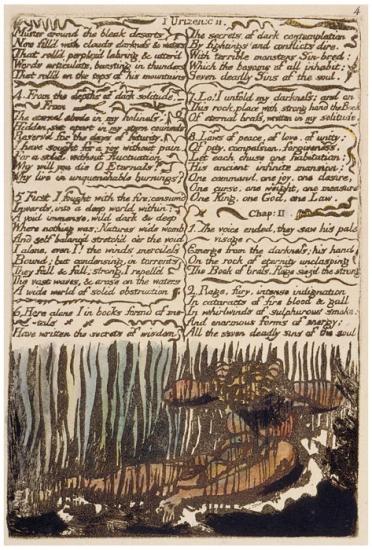
The First Book of Urizen
Lambeth: Printed by William Blake, 1794
Copy B
Gift of Mrs. Landon K. Thorne, 1972
The First Book of Urizen, The Book of Los, and The Book of Ahania constitute an unorthodox rewriting of the Pentateuch. This mythic transformation of the Jewish and Christian Scriptures offers many perspectives, but to highlight the biblical relationships, Blake designed the leaves to contain two columns of text. The work exemplifies his own radical spirit. A total of eight copies exist; this copy is one of only two containing the complete series of twenty-eight plates.
William Blake (1757–1827) occupies a unique place in the history of Western art. His creativity included both the visual and literary arts. In his lifetime he was best known as an engraver; now he is also recognized for his innovative poetry, printmaking, and painting. Blake's keen perception of the political and social climate found expression throughout his work. His strong sense of independence is evident in the complex mythology that he constructed in response to the age of revolution.
Blake was already recognized as an engraver at age twenty-five, when his first volume of poems appeared. At thirty-three, in The Marriage of Heaven and Hell, he audaciously claimed that his birth had marked the origin of a "new heaven" in which his own art would exemplify the creativity prefigured by Milton and Michelangelo. By that time, Blake, in one of his most productive periods, had already produced Songs of Innocence and was at work on a series of illuminated books. In 1818 he met John Linnell, a young painter and engraver, through whom a group of young artists became Blake's followers. Calling themselves the Ancients, they helped perpetuate Blake's influence for generations.
The Morgan's Blake collection—one of this country's most distinguished—began with purchases as early as 1899 by Pierpont Morgan. During the tenure of Charles Ryskamp, director from 1969 to 1986, major gifts almost doubled the size of its Blake holdings. In recent years Ryskamp's own gifts of engravings, letters, and related materials have significantly enriched its scholarly resources.
This online exhibition is presented in conjunction with the exhibition William Blake's World: "A New Heaven Is Begun" on view September 11, 2009, through January 3, 2010.
This exhibition is made possible through the generosity of Fay and Geoffrey Elliott.
The First Book of Urizen 9
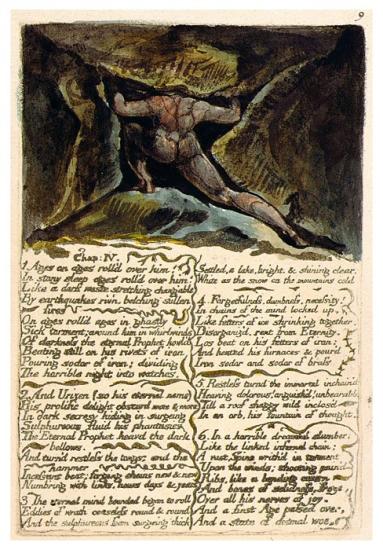
The First Book of Urizen
Lambeth: Printed by William Blake, 1794
Copy B
Gift of Mrs. Landon K. Thorne, 1972
The First Book of Urizen, The Book of Los, and The Book of Ahania constitute an unorthodox rewriting of the Pentateuch. This mythic transformation of the Jewish and Christian Scriptures offers many perspectives, but to highlight the biblical relationships, Blake designed the leaves to contain two columns of text. The work exemplifies his own radical spirit. A total of eight copies exist; this copy is one of only two containing the complete series of twenty-eight plates.
William Blake (1757–1827) occupies a unique place in the history of Western art. His creativity included both the visual and literary arts. In his lifetime he was best known as an engraver; now he is also recognized for his innovative poetry, printmaking, and painting. Blake's keen perception of the political and social climate found expression throughout his work. His strong sense of independence is evident in the complex mythology that he constructed in response to the age of revolution.
Blake was already recognized as an engraver at age twenty-five, when his first volume of poems appeared. At thirty-three, in The Marriage of Heaven and Hell, he audaciously claimed that his birth had marked the origin of a "new heaven" in which his own art would exemplify the creativity prefigured by Milton and Michelangelo. By that time, Blake, in one of his most productive periods, had already produced Songs of Innocence and was at work on a series of illuminated books. In 1818 he met John Linnell, a young painter and engraver, through whom a group of young artists became Blake's followers. Calling themselves the Ancients, they helped perpetuate Blake's influence for generations.
The Morgan's Blake collection—one of this country's most distinguished—began with purchases as early as 1899 by Pierpont Morgan. During the tenure of Charles Ryskamp, director from 1969 to 1986, major gifts almost doubled the size of its Blake holdings. In recent years Ryskamp's own gifts of engravings, letters, and related materials have significantly enriched its scholarly resources.
This online exhibition is presented in conjunction with the exhibition William Blake's World: "A New Heaven Is Begun" on view September 11, 2009, through January 3, 2010.
This exhibition is made possible through the generosity of Fay and Geoffrey Elliott.
The First Book of Urizen 10
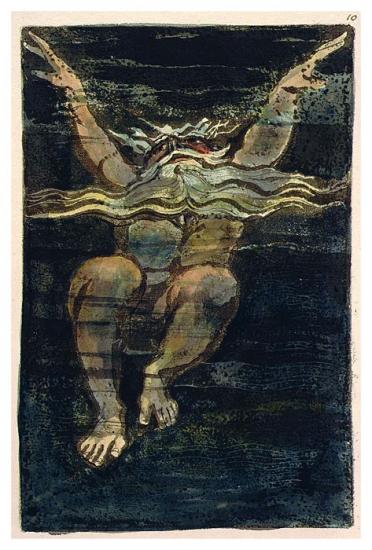
The First Book of Urizen
Lambeth: Printed by William Blake, 1794
Copy B
Gift of Mrs. Landon K. Thorne, 1972
The First Book of Urizen, The Book of Los, and The Book of Ahania constitute an unorthodox rewriting of the Pentateuch. This mythic transformation of the Jewish and Christian Scriptures offers many perspectives, but to highlight the biblical relationships, Blake designed the leaves to contain two columns of text. The work exemplifies his own radical spirit. A total of eight copies exist; this copy is one of only two containing the complete series of twenty-eight plates.
William Blake (1757–1827) occupies a unique place in the history of Western art. His creativity included both the visual and literary arts. In his lifetime he was best known as an engraver; now he is also recognized for his innovative poetry, printmaking, and painting. Blake's keen perception of the political and social climate found expression throughout his work. His strong sense of independence is evident in the complex mythology that he constructed in response to the age of revolution.
Blake was already recognized as an engraver at age twenty-five, when his first volume of poems appeared. At thirty-three, in The Marriage of Heaven and Hell, he audaciously claimed that his birth had marked the origin of a "new heaven" in which his own art would exemplify the creativity prefigured by Milton and Michelangelo. By that time, Blake, in one of his most productive periods, had already produced Songs of Innocence and was at work on a series of illuminated books. In 1818 he met John Linnell, a young painter and engraver, through whom a group of young artists became Blake's followers. Calling themselves the Ancients, they helped perpetuate Blake's influence for generations.
The Morgan's Blake collection—one of this country's most distinguished—began with purchases as early as 1899 by Pierpont Morgan. During the tenure of Charles Ryskamp, director from 1969 to 1986, major gifts almost doubled the size of its Blake holdings. In recent years Ryskamp's own gifts of engravings, letters, and related materials have significantly enriched its scholarly resources.
This online exhibition is presented in conjunction with the exhibition William Blake's World: "A New Heaven Is Begun" on view September 11, 2009, through January 3, 2010.
This exhibition is made possible through the generosity of Fay and Geoffrey Elliott.
The First Book of Urizen 5
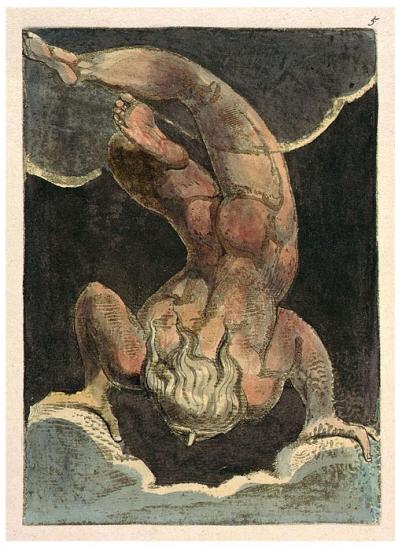
The First Book of Urizen
Lambeth: Printed by William Blake, 1794
Copy B
Gift of Mrs. Landon K. Thorne, 1972
The First Book of Urizen, The Book of Los, and The Book of Ahania constitute an unorthodox rewriting of the Pentateuch. This mythic transformation of the Jewish and Christian Scriptures offers many perspectives, but to highlight the biblical relationships, Blake designed the leaves to contain two columns of text. The work exemplifies his own radical spirit. A total of eight copies exist; this copy is one of only two containing the complete series of twenty-eight plates.
William Blake (1757–1827) occupies a unique place in the history of Western art. His creativity included both the visual and literary arts. In his lifetime he was best known as an engraver; now he is also recognized for his innovative poetry, printmaking, and painting. Blake's keen perception of the political and social climate found expression throughout his work. His strong sense of independence is evident in the complex mythology that he constructed in response to the age of revolution.
Blake was already recognized as an engraver at age twenty-five, when his first volume of poems appeared. At thirty-three, in The Marriage of Heaven and Hell, he audaciously claimed that his birth had marked the origin of a "new heaven" in which his own art would exemplify the creativity prefigured by Milton and Michelangelo. By that time, Blake, in one of his most productive periods, had already produced Songs of Innocence and was at work on a series of illuminated books. In 1818 he met John Linnell, a young painter and engraver, through whom a group of young artists became Blake's followers. Calling themselves the Ancients, they helped perpetuate Blake's influence for generations.
The Morgan's Blake collection—one of this country's most distinguished—began with purchases as early as 1899 by Pierpont Morgan. During the tenure of Charles Ryskamp, director from 1969 to 1986, major gifts almost doubled the size of its Blake holdings. In recent years Ryskamp's own gifts of engravings, letters, and related materials have significantly enriched its scholarly resources.
This online exhibition is presented in conjunction with the exhibition William Blake's World: "A New Heaven Is Begun" on view September 11, 2009, through January 3, 2010.
This exhibition is made possible through the generosity of Fay and Geoffrey Elliott.
The First Book of Urizen 11
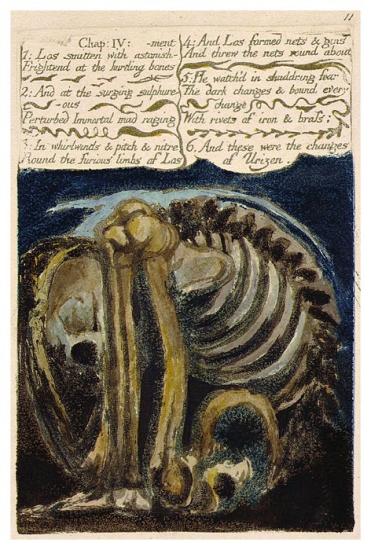
The First Book of Urizen
Lambeth: Printed by William Blake, 1794
Copy B
Gift of Mrs. Landon K. Thorne, 1972
The First Book of Urizen, The Book of Los, and The Book of Ahania constitute an unorthodox rewriting of the Pentateuch. This mythic transformation of the Jewish and Christian Scriptures offers many perspectives, but to highlight the biblical relationships, Blake designed the leaves to contain two columns of text. The work exemplifies his own radical spirit. A total of eight copies exist; this copy is one of only two containing the complete series of twenty-eight plates.
William Blake (1757–1827) occupies a unique place in the history of Western art. His creativity included both the visual and literary arts. In his lifetime he was best known as an engraver; now he is also recognized for his innovative poetry, printmaking, and painting. Blake's keen perception of the political and social climate found expression throughout his work. His strong sense of independence is evident in the complex mythology that he constructed in response to the age of revolution.
Blake was already recognized as an engraver at age twenty-five, when his first volume of poems appeared. At thirty-three, in The Marriage of Heaven and Hell, he audaciously claimed that his birth had marked the origin of a "new heaven" in which his own art would exemplify the creativity prefigured by Milton and Michelangelo. By that time, Blake, in one of his most productive periods, had already produced Songs of Innocence and was at work on a series of illuminated books. In 1818 he met John Linnell, a young painter and engraver, through whom a group of young artists became Blake's followers. Calling themselves the Ancients, they helped perpetuate Blake's influence for generations.
The Morgan's Blake collection—one of this country's most distinguished—began with purchases as early as 1899 by Pierpont Morgan. During the tenure of Charles Ryskamp, director from 1969 to 1986, major gifts almost doubled the size of its Blake holdings. In recent years Ryskamp's own gifts of engravings, letters, and related materials have significantly enriched its scholarly resources.
This online exhibition is presented in conjunction with the exhibition William Blake's World: "A New Heaven Is Begun" on view September 11, 2009, through January 3, 2010.
This exhibition is made possible through the generosity of Fay and Geoffrey Elliott.
The First Book of Urizen 6
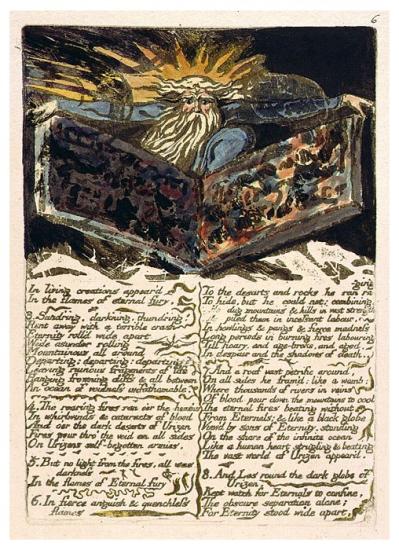
The First Book of Urizen
Lambeth: Printed by William Blake, 1794
Copy B
Gift of Mrs. Landon K. Thorne, 1972
The First Book of Urizen, The Book of Los, and The Book of Ahania constitute an unorthodox rewriting of the Pentateuch. This mythic transformation of the Jewish and Christian Scriptures offers many perspectives, but to highlight the biblical relationships, Blake designed the leaves to contain two columns of text. The work exemplifies his own radical spirit. A total of eight copies exist; this copy is one of only two containing the complete series of twenty-eight plates.
William Blake (1757–1827) occupies a unique place in the history of Western art. His creativity included both the visual and literary arts. In his lifetime he was best known as an engraver; now he is also recognized for his innovative poetry, printmaking, and painting. Blake's keen perception of the political and social climate found expression throughout his work. His strong sense of independence is evident in the complex mythology that he constructed in response to the age of revolution.
Blake was already recognized as an engraver at age twenty-five, when his first volume of poems appeared. At thirty-three, in The Marriage of Heaven and Hell, he audaciously claimed that his birth had marked the origin of a "new heaven" in which his own art would exemplify the creativity prefigured by Milton and Michelangelo. By that time, Blake, in one of his most productive periods, had already produced Songs of Innocence and was at work on a series of illuminated books. In 1818 he met John Linnell, a young painter and engraver, through whom a group of young artists became Blake's followers. Calling themselves the Ancients, they helped perpetuate Blake's influence for generations.
The Morgan's Blake collection—one of this country's most distinguished—began with purchases as early as 1899 by Pierpont Morgan. During the tenure of Charles Ryskamp, director from 1969 to 1986, major gifts almost doubled the size of its Blake holdings. In recent years Ryskamp's own gifts of engravings, letters, and related materials have significantly enriched its scholarly resources.
This online exhibition is presented in conjunction with the exhibition William Blake's World: "A New Heaven Is Begun" on view September 11, 2009, through January 3, 2010.
This exhibition is made possible through the generosity of Fay and Geoffrey Elliott.
The First Book of Urizen 12
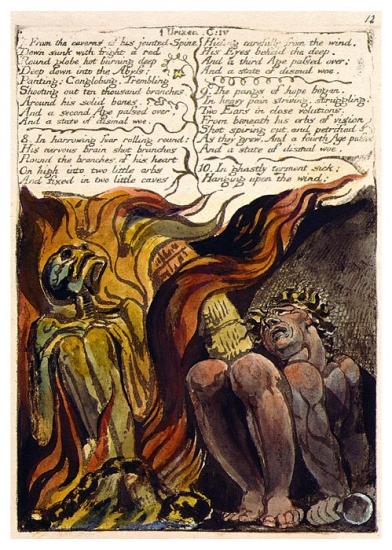
The First Book of Urizen
Lambeth: Printed by William Blake, 1794
Copy B
Gift of Mrs. Landon K. Thorne, 1972
The First Book of Urizen, The Book of Los, and The Book of Ahania constitute an unorthodox rewriting of the Pentateuch. This mythic transformation of the Jewish and Christian Scriptures offers many perspectives, but to highlight the biblical relationships, Blake designed the leaves to contain two columns of text. The work exemplifies his own radical spirit. A total of eight copies exist; this copy is one of only two containing the complete series of twenty-eight plates.
William Blake (1757–1827) occupies a unique place in the history of Western art. His creativity included both the visual and literary arts. In his lifetime he was best known as an engraver; now he is also recognized for his innovative poetry, printmaking, and painting. Blake's keen perception of the political and social climate found expression throughout his work. His strong sense of independence is evident in the complex mythology that he constructed in response to the age of revolution.
Blake was already recognized as an engraver at age twenty-five, when his first volume of poems appeared. At thirty-three, in The Marriage of Heaven and Hell, he audaciously claimed that his birth had marked the origin of a "new heaven" in which his own art would exemplify the creativity prefigured by Milton and Michelangelo. By that time, Blake, in one of his most productive periods, had already produced Songs of Innocence and was at work on a series of illuminated books. In 1818 he met John Linnell, a young painter and engraver, through whom a group of young artists became Blake's followers. Calling themselves the Ancients, they helped perpetuate Blake's influence for generations.
The Morgan's Blake collection—one of this country's most distinguished—began with purchases as early as 1899 by Pierpont Morgan. During the tenure of Charles Ryskamp, director from 1969 to 1986, major gifts almost doubled the size of its Blake holdings. In recent years Ryskamp's own gifts of engravings, letters, and related materials have significantly enriched its scholarly resources.
This online exhibition is presented in conjunction with the exhibition William Blake's World: "A New Heaven Is Begun" on view September 11, 2009, through January 3, 2010.
This exhibition is made possible through the generosity of Fay and Geoffrey Elliott.
The First Book of Urizen 13
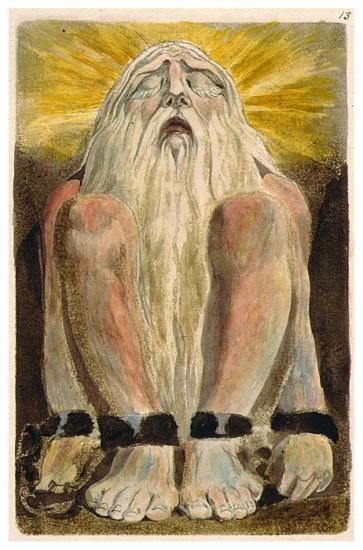
The First Book of Urizen
Lambeth: Printed by William Blake, 1794
Copy B
Gift of Mrs. Landon K. Thorne, 1972
The First Book of Urizen, The Book of Los, and The Book of Ahania constitute an unorthodox rewriting of the Pentateuch. This mythic transformation of the Jewish and Christian Scriptures offers many perspectives, but to highlight the biblical relationships, Blake designed the leaves to contain two columns of text. The work exemplifies his own radical spirit. A total of eight copies exist; this copy is one of only two containing the complete series of twenty-eight plates.
William Blake (1757–1827) occupies a unique place in the history of Western art. His creativity included both the visual and literary arts. In his lifetime he was best known as an engraver; now he is also recognized for his innovative poetry, printmaking, and painting. Blake's keen perception of the political and social climate found expression throughout his work. His strong sense of independence is evident in the complex mythology that he constructed in response to the age of revolution.
Blake was already recognized as an engraver at age twenty-five, when his first volume of poems appeared. At thirty-three, in The Marriage of Heaven and Hell, he audaciously claimed that his birth had marked the origin of a "new heaven" in which his own art would exemplify the creativity prefigured by Milton and Michelangelo. By that time, Blake, in one of his most productive periods, had already produced Songs of Innocence and was at work on a series of illuminated books. In 1818 he met John Linnell, a young painter and engraver, through whom a group of young artists became Blake's followers. Calling themselves the Ancients, they helped perpetuate Blake's influence for generations.
The Morgan's Blake collection—one of this country's most distinguished—began with purchases as early as 1899 by Pierpont Morgan. During the tenure of Charles Ryskamp, director from 1969 to 1986, major gifts almost doubled the size of its Blake holdings. In recent years Ryskamp's own gifts of engravings, letters, and related materials have significantly enriched its scholarly resources.
This online exhibition is presented in conjunction with the exhibition William Blake's World: "A New Heaven Is Begun" on view September 11, 2009, through January 3, 2010.
This exhibition is made possible through the generosity of Fay and Geoffrey Elliott.
The First Book of Urizen 14

The First Book of Urizen
Lambeth: Printed by William Blake, 1794
Copy B
Gift of Mrs. Landon K. Thorne, 1972
The First Book of Urizen, The Book of Los, and The Book of Ahania constitute an unorthodox rewriting of the Pentateuch. This mythic transformation of the Jewish and Christian Scriptures offers many perspectives, but to highlight the biblical relationships, Blake designed the leaves to contain two columns of text. The work exemplifies his own radical spirit. A total of eight copies exist; this copy is one of only two containing the complete series of twenty-eight plates.
William Blake (1757–1827) occupies a unique place in the history of Western art. His creativity included both the visual and literary arts. In his lifetime he was best known as an engraver; now he is also recognized for his innovative poetry, printmaking, and painting. Blake's keen perception of the political and social climate found expression throughout his work. His strong sense of independence is evident in the complex mythology that he constructed in response to the age of revolution.
Blake was already recognized as an engraver at age twenty-five, when his first volume of poems appeared. At thirty-three, in The Marriage of Heaven and Hell, he audaciously claimed that his birth had marked the origin of a "new heaven" in which his own art would exemplify the creativity prefigured by Milton and Michelangelo. By that time, Blake, in one of his most productive periods, had already produced Songs of Innocence and was at work on a series of illuminated books. In 1818 he met John Linnell, a young painter and engraver, through whom a group of young artists became Blake's followers. Calling themselves the Ancients, they helped perpetuate Blake's influence for generations.
The Morgan's Blake collection—one of this country's most distinguished—began with purchases as early as 1899 by Pierpont Morgan. During the tenure of Charles Ryskamp, director from 1969 to 1986, major gifts almost doubled the size of its Blake holdings. In recent years Ryskamp's own gifts of engravings, letters, and related materials have significantly enriched its scholarly resources.
This online exhibition is presented in conjunction with the exhibition William Blake's World: "A New Heaven Is Begun" on view September 11, 2009, through January 3, 2010.
This exhibition is made possible through the generosity of Fay and Geoffrey Elliott.
The First Book of Urizen 15

The First Book of Urizen
Lambeth: Printed by William Blake, 1794
Copy B
Gift of Mrs. Landon K. Thorne, 1972
The First Book of Urizen, The Book of Los, and The Book of Ahania constitute an unorthodox rewriting of the Pentateuch. This mythic transformation of the Jewish and Christian Scriptures offers many perspectives, but to highlight the biblical relationships, Blake designed the leaves to contain two columns of text. The work exemplifies his own radical spirit. A total of eight copies exist; this copy is one of only two containing the complete series of twenty-eight plates.
William Blake (1757–1827) occupies a unique place in the history of Western art. His creativity included both the visual and literary arts. In his lifetime he was best known as an engraver; now he is also recognized for his innovative poetry, printmaking, and painting. Blake's keen perception of the political and social climate found expression throughout his work. His strong sense of independence is evident in the complex mythology that he constructed in response to the age of revolution.
Blake was already recognized as an engraver at age twenty-five, when his first volume of poems appeared. At thirty-three, in The Marriage of Heaven and Hell, he audaciously claimed that his birth had marked the origin of a "new heaven" in which his own art would exemplify the creativity prefigured by Milton and Michelangelo. By that time, Blake, in one of his most productive periods, had already produced Songs of Innocence and was at work on a series of illuminated books. In 1818 he met John Linnell, a young painter and engraver, through whom a group of young artists became Blake's followers. Calling themselves the Ancients, they helped perpetuate Blake's influence for generations.
The Morgan's Blake collection—one of this country's most distinguished—began with purchases as early as 1899 by Pierpont Morgan. During the tenure of Charles Ryskamp, director from 1969 to 1986, major gifts almost doubled the size of its Blake holdings. In recent years Ryskamp's own gifts of engravings, letters, and related materials have significantly enriched its scholarly resources.
This online exhibition is presented in conjunction with the exhibition William Blake's World: "A New Heaven Is Begun" on view September 11, 2009, through January 3, 2010.
This exhibition is made possible through the generosity of Fay and Geoffrey Elliott.
The First Book of Urizen 16

The First Book of Urizen
Lambeth: Printed by William Blake, 1794
Copy B
Gift of Mrs. Landon K. Thorne, 1972
The First Book of Urizen, The Book of Los, and The Book of Ahania constitute an unorthodox rewriting of the Pentateuch. This mythic transformation of the Jewish and Christian Scriptures offers many perspectives, but to highlight the biblical relationships, Blake designed the leaves to contain two columns of text. The work exemplifies his own radical spirit. A total of eight copies exist; this copy is one of only two containing the complete series of twenty-eight plates.
William Blake (1757–1827) occupies a unique place in the history of Western art. His creativity included both the visual and literary arts. In his lifetime he was best known as an engraver; now he is also recognized for his innovative poetry, printmaking, and painting. Blake's keen perception of the political and social climate found expression throughout his work. His strong sense of independence is evident in the complex mythology that he constructed in response to the age of revolution.
Blake was already recognized as an engraver at age twenty-five, when his first volume of poems appeared. At thirty-three, in The Marriage of Heaven and Hell, he audaciously claimed that his birth had marked the origin of a "new heaven" in which his own art would exemplify the creativity prefigured by Milton and Michelangelo. By that time, Blake, in one of his most productive periods, had already produced Songs of Innocence and was at work on a series of illuminated books. In 1818 he met John Linnell, a young painter and engraver, through whom a group of young artists became Blake's followers. Calling themselves the Ancients, they helped perpetuate Blake's influence for generations.
The Morgan's Blake collection—one of this country's most distinguished—began with purchases as early as 1899 by Pierpont Morgan. During the tenure of Charles Ryskamp, director from 1969 to 1986, major gifts almost doubled the size of its Blake holdings. In recent years Ryskamp's own gifts of engravings, letters, and related materials have significantly enriched its scholarly resources.
This online exhibition is presented in conjunction with the exhibition William Blake's World: "A New Heaven Is Begun" on view September 11, 2009, through January 3, 2010.
This exhibition is made possible through the generosity of Fay and Geoffrey Elliott.
The First Book of Urizen 17
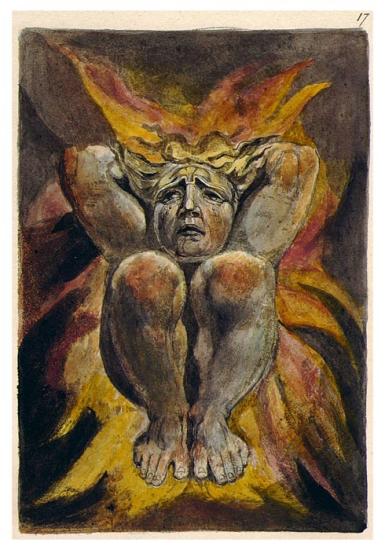
The First Book of Urizen
Lambeth: Printed by William Blake, 1794
Copy B
Gift of Mrs. Landon K. Thorne, 1972
The First Book of Urizen, The Book of Los, and The Book of Ahania constitute an unorthodox rewriting of the Pentateuch. This mythic transformation of the Jewish and Christian Scriptures offers many perspectives, but to highlight the biblical relationships, Blake designed the leaves to contain two columns of text. The work exemplifies his own radical spirit. A total of eight copies exist; this copy is one of only two containing the complete series of twenty-eight plates.
William Blake (1757–1827) occupies a unique place in the history of Western art. His creativity included both the visual and literary arts. In his lifetime he was best known as an engraver; now he is also recognized for his innovative poetry, printmaking, and painting. Blake's keen perception of the political and social climate found expression throughout his work. His strong sense of independence is evident in the complex mythology that he constructed in response to the age of revolution.
Blake was already recognized as an engraver at age twenty-five, when his first volume of poems appeared. At thirty-three, in The Marriage of Heaven and Hell, he audaciously claimed that his birth had marked the origin of a "new heaven" in which his own art would exemplify the creativity prefigured by Milton and Michelangelo. By that time, Blake, in one of his most productive periods, had already produced Songs of Innocence and was at work on a series of illuminated books. In 1818 he met John Linnell, a young painter and engraver, through whom a group of young artists became Blake's followers. Calling themselves the Ancients, they helped perpetuate Blake's influence for generations.
The Morgan's Blake collection—one of this country's most distinguished—began with purchases as early as 1899 by Pierpont Morgan. During the tenure of Charles Ryskamp, director from 1969 to 1986, major gifts almost doubled the size of its Blake holdings. In recent years Ryskamp's own gifts of engravings, letters, and related materials have significantly enriched its scholarly resources.
This online exhibition is presented in conjunction with the exhibition William Blake's World: "A New Heaven Is Begun" on view September 11, 2009, through January 3, 2010.
This exhibition is made possible through the generosity of Fay and Geoffrey Elliott.
The First Book of Urizen 18
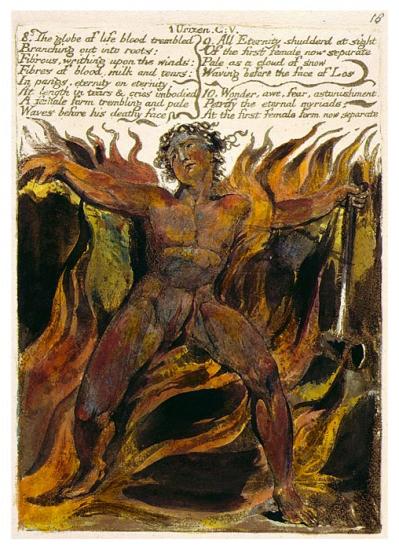
The First Book of Urizen
Lambeth: Printed by William Blake, 1794
Copy B
Gift of Mrs. Landon K. Thorne, 1972
The First Book of Urizen, The Book of Los, and The Book of Ahania constitute an unorthodox rewriting of the Pentateuch. This mythic transformation of the Jewish and Christian Scriptures offers many perspectives, but to highlight the biblical relationships, Blake designed the leaves to contain two columns of text. The work exemplifies his own radical spirit. A total of eight copies exist; this copy is one of only two containing the complete series of twenty-eight plates.
William Blake (1757–1827) occupies a unique place in the history of Western art. His creativity included both the visual and literary arts. In his lifetime he was best known as an engraver; now he is also recognized for his innovative poetry, printmaking, and painting. Blake's keen perception of the political and social climate found expression throughout his work. His strong sense of independence is evident in the complex mythology that he constructed in response to the age of revolution.
Blake was already recognized as an engraver at age twenty-five, when his first volume of poems appeared. At thirty-three, in The Marriage of Heaven and Hell, he audaciously claimed that his birth had marked the origin of a "new heaven" in which his own art would exemplify the creativity prefigured by Milton and Michelangelo. By that time, Blake, in one of his most productive periods, had already produced Songs of Innocence and was at work on a series of illuminated books. In 1818 he met John Linnell, a young painter and engraver, through whom a group of young artists became Blake's followers. Calling themselves the Ancients, they helped perpetuate Blake's influence for generations.
The Morgan's Blake collection—one of this country's most distinguished—began with purchases as early as 1899 by Pierpont Morgan. During the tenure of Charles Ryskamp, director from 1969 to 1986, major gifts almost doubled the size of its Blake holdings. In recent years Ryskamp's own gifts of engravings, letters, and related materials have significantly enriched its scholarly resources.
This online exhibition is presented in conjunction with the exhibition William Blake's World: "A New Heaven Is Begun" on view September 11, 2009, through January 3, 2010.
This exhibition is made possible through the generosity of Fay and Geoffrey Elliott.
The First Book of Urizen 19

The First Book of Urizen
Lambeth: Printed by William Blake, 1794
Copy B
Gift of Mrs. Landon K. Thorne, 1972
The First Book of Urizen, The Book of Los, and The Book of Ahania constitute an unorthodox rewriting of the Pentateuch. This mythic transformation of the Jewish and Christian Scriptures offers many perspectives, but to highlight the biblical relationships, Blake designed the leaves to contain two columns of text. The work exemplifies his own radical spirit. A total of eight copies exist; this copy is one of only two containing the complete series of twenty-eight plates.
William Blake (1757–1827) occupies a unique place in the history of Western art. His creativity included both the visual and literary arts. In his lifetime he was best known as an engraver; now he is also recognized for his innovative poetry, printmaking, and painting. Blake's keen perception of the political and social climate found expression throughout his work. His strong sense of independence is evident in the complex mythology that he constructed in response to the age of revolution.
Blake was already recognized as an engraver at age twenty-five, when his first volume of poems appeared. At thirty-three, in The Marriage of Heaven and Hell, he audaciously claimed that his birth had marked the origin of a "new heaven" in which his own art would exemplify the creativity prefigured by Milton and Michelangelo. By that time, Blake, in one of his most productive periods, had already produced Songs of Innocence and was at work on a series of illuminated books. In 1818 he met John Linnell, a young painter and engraver, through whom a group of young artists became Blake's followers. Calling themselves the Ancients, they helped perpetuate Blake's influence for generations.
The Morgan's Blake collection—one of this country's most distinguished—began with purchases as early as 1899 by Pierpont Morgan. During the tenure of Charles Ryskamp, director from 1969 to 1986, major gifts almost doubled the size of its Blake holdings. In recent years Ryskamp's own gifts of engravings, letters, and related materials have significantly enriched its scholarly resources.
This online exhibition is presented in conjunction with the exhibition William Blake's World: "A New Heaven Is Begun" on view September 11, 2009, through January 3, 2010.
This exhibition is made possible through the generosity of Fay and Geoffrey Elliott.
The First Book of Urizen 20
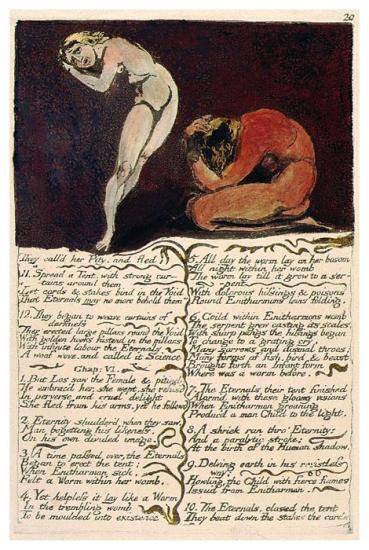
The First Book of Urizen
Lambeth: Printed by William Blake, 1794
Copy B
Gift of Mrs. Landon K. Thorne, 1972
The First Book of Urizen, The Book of Los, and The Book of Ahania constitute an unorthodox rewriting of the Pentateuch. This mythic transformation of the Jewish and Christian Scriptures offers many perspectives, but to highlight the biblical relationships, Blake designed the leaves to contain two columns of text. The work exemplifies his own radical spirit. A total of eight copies exist; this copy is one of only two containing the complete series of twenty-eight plates.
William Blake (1757–1827) occupies a unique place in the history of Western art. His creativity included both the visual and literary arts. In his lifetime he was best known as an engraver; now he is also recognized for his innovative poetry, printmaking, and painting. Blake's keen perception of the political and social climate found expression throughout his work. His strong sense of independence is evident in the complex mythology that he constructed in response to the age of revolution.
Blake was already recognized as an engraver at age twenty-five, when his first volume of poems appeared. At thirty-three, in The Marriage of Heaven and Hell, he audaciously claimed that his birth had marked the origin of a "new heaven" in which his own art would exemplify the creativity prefigured by Milton and Michelangelo. By that time, Blake, in one of his most productive periods, had already produced Songs of Innocence and was at work on a series of illuminated books. In 1818 he met John Linnell, a young painter and engraver, through whom a group of young artists became Blake's followers. Calling themselves the Ancients, they helped perpetuate Blake's influence for generations.
The Morgan's Blake collection—one of this country's most distinguished—began with purchases as early as 1899 by Pierpont Morgan. During the tenure of Charles Ryskamp, director from 1969 to 1986, major gifts almost doubled the size of its Blake holdings. In recent years Ryskamp's own gifts of engravings, letters, and related materials have significantly enriched its scholarly resources.
This online exhibition is presented in conjunction with the exhibition William Blake's World: "A New Heaven Is Begun" on view September 11, 2009, through January 3, 2010.
This exhibition is made possible through the generosity of Fay and Geoffrey Elliott.
The First Book of Urizen 21

The First Book of Urizen
Lambeth: Printed by William Blake, 1794
Copy B
Gift of Mrs. Landon K. Thorne, 1972
The First Book of Urizen, The Book of Los, and The Book of Ahania constitute an unorthodox rewriting of the Pentateuch. This mythic transformation of the Jewish and Christian Scriptures offers many perspectives, but to highlight the biblical relationships, Blake designed the leaves to contain two columns of text. The work exemplifies his own radical spirit. A total of eight copies exist; this copy is one of only two containing the complete series of twenty-eight plates.
William Blake (1757–1827) occupies a unique place in the history of Western art. His creativity included both the visual and literary arts. In his lifetime he was best known as an engraver; now he is also recognized for his innovative poetry, printmaking, and painting. Blake's keen perception of the political and social climate found expression throughout his work. His strong sense of independence is evident in the complex mythology that he constructed in response to the age of revolution.
Blake was already recognized as an engraver at age twenty-five, when his first volume of poems appeared. At thirty-three, in The Marriage of Heaven and Hell, he audaciously claimed that his birth had marked the origin of a "new heaven" in which his own art would exemplify the creativity prefigured by Milton and Michelangelo. By that time, Blake, in one of his most productive periods, had already produced Songs of Innocence and was at work on a series of illuminated books. In 1818 he met John Linnell, a young painter and engraver, through whom a group of young artists became Blake's followers. Calling themselves the Ancients, they helped perpetuate Blake's influence for generations.
The Morgan's Blake collection—one of this country's most distinguished—began with purchases as early as 1899 by Pierpont Morgan. During the tenure of Charles Ryskamp, director from 1969 to 1986, major gifts almost doubled the size of its Blake holdings. In recent years Ryskamp's own gifts of engravings, letters, and related materials have significantly enriched its scholarly resources.
This online exhibition is presented in conjunction with the exhibition William Blake's World: "A New Heaven Is Begun" on view September 11, 2009, through January 3, 2010.
This exhibition is made possible through the generosity of Fay and Geoffrey Elliott.
The First Book of Urizen 22
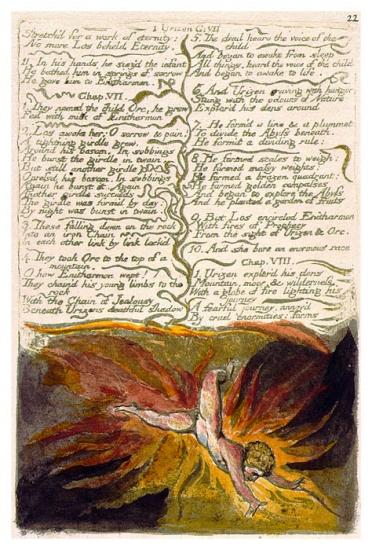
The First Book of Urizen
Lambeth: Printed by William Blake, 1794
Copy B
Gift of Mrs. Landon K. Thorne, 1972
The First Book of Urizen, The Book of Los, and The Book of Ahania constitute an unorthodox rewriting of the Pentateuch. This mythic transformation of the Jewish and Christian Scriptures offers many perspectives, but to highlight the biblical relationships, Blake designed the leaves to contain two columns of text. The work exemplifies his own radical spirit. A total of eight copies exist; this copy is one of only two containing the complete series of twenty-eight plates.
William Blake (1757–1827) occupies a unique place in the history of Western art. His creativity included both the visual and literary arts. In his lifetime he was best known as an engraver; now he is also recognized for his innovative poetry, printmaking, and painting. Blake's keen perception of the political and social climate found expression throughout his work. His strong sense of independence is evident in the complex mythology that he constructed in response to the age of revolution.
Blake was already recognized as an engraver at age twenty-five, when his first volume of poems appeared. At thirty-three, in The Marriage of Heaven and Hell, he audaciously claimed that his birth had marked the origin of a "new heaven" in which his own art would exemplify the creativity prefigured by Milton and Michelangelo. By that time, Blake, in one of his most productive periods, had already produced Songs of Innocence and was at work on a series of illuminated books. In 1818 he met John Linnell, a young painter and engraver, through whom a group of young artists became Blake's followers. Calling themselves the Ancients, they helped perpetuate Blake's influence for generations.
The Morgan's Blake collection—one of this country's most distinguished—began with purchases as early as 1899 by Pierpont Morgan. During the tenure of Charles Ryskamp, director from 1969 to 1986, major gifts almost doubled the size of its Blake holdings. In recent years Ryskamp's own gifts of engravings, letters, and related materials have significantly enriched its scholarly resources.
This online exhibition is presented in conjunction with the exhibition William Blake's World: "A New Heaven Is Begun" on view September 11, 2009, through January 3, 2010.
This exhibition is made possible through the generosity of Fay and Geoffrey Elliott.
The First Book of Urizen 23
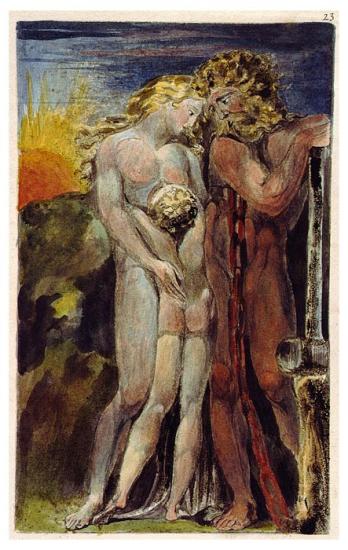
The First Book of Urizen
Lambeth: Printed by William Blake, 1794
Copy B
Gift of Mrs. Landon K. Thorne, 1972
The First Book of Urizen, The Book of Los, and The Book of Ahania constitute an unorthodox rewriting of the Pentateuch. This mythic transformation of the Jewish and Christian Scriptures offers many perspectives, but to highlight the biblical relationships, Blake designed the leaves to contain two columns of text. The work exemplifies his own radical spirit. A total of eight copies exist; this copy is one of only two containing the complete series of twenty-eight plates.
William Blake (1757–1827) occupies a unique place in the history of Western art. His creativity included both the visual and literary arts. In his lifetime he was best known as an engraver; now he is also recognized for his innovative poetry, printmaking, and painting. Blake's keen perception of the political and social climate found expression throughout his work. His strong sense of independence is evident in the complex mythology that he constructed in response to the age of revolution.
Blake was already recognized as an engraver at age twenty-five, when his first volume of poems appeared. At thirty-three, in The Marriage of Heaven and Hell, he audaciously claimed that his birth had marked the origin of a "new heaven" in which his own art would exemplify the creativity prefigured by Milton and Michelangelo. By that time, Blake, in one of his most productive periods, had already produced Songs of Innocence and was at work on a series of illuminated books. In 1818 he met John Linnell, a young painter and engraver, through whom a group of young artists became Blake's followers. Calling themselves the Ancients, they helped perpetuate Blake's influence for generations.
The Morgan's Blake collection—one of this country's most distinguished—began with purchases as early as 1899 by Pierpont Morgan. During the tenure of Charles Ryskamp, director from 1969 to 1986, major gifts almost doubled the size of its Blake holdings. In recent years Ryskamp's own gifts of engravings, letters, and related materials have significantly enriched its scholarly resources.
This online exhibition is presented in conjunction with the exhibition William Blake's World: "A New Heaven Is Begun" on view September 11, 2009, through January 3, 2010.
This exhibition is made possible through the generosity of Fay and Geoffrey Elliott.
The First Book of Urizen 24

The First Book of Urizen
Lambeth: Printed by William Blake, 1794
Copy B
Gift of Mrs. Landon K. Thorne, 1972
The First Book of Urizen, The Book of Los, and The Book of Ahania constitute an unorthodox rewriting of the Pentateuch. This mythic transformation of the Jewish and Christian Scriptures offers many perspectives, but to highlight the biblical relationships, Blake designed the leaves to contain two columns of text. The work exemplifies his own radical spirit. A total of eight copies exist; this copy is one of only two containing the complete series of twenty-eight plates.
William Blake (1757–1827) occupies a unique place in the history of Western art. His creativity included both the visual and literary arts. In his lifetime he was best known as an engraver; now he is also recognized for his innovative poetry, printmaking, and painting. Blake's keen perception of the political and social climate found expression throughout his work. His strong sense of independence is evident in the complex mythology that he constructed in response to the age of revolution.
Blake was already recognized as an engraver at age twenty-five, when his first volume of poems appeared. At thirty-three, in The Marriage of Heaven and Hell, he audaciously claimed that his birth had marked the origin of a "new heaven" in which his own art would exemplify the creativity prefigured by Milton and Michelangelo. By that time, Blake, in one of his most productive periods, had already produced Songs of Innocence and was at work on a series of illuminated books. In 1818 he met John Linnell, a young painter and engraver, through whom a group of young artists became Blake's followers. Calling themselves the Ancients, they helped perpetuate Blake's influence for generations.
The Morgan's Blake collection—one of this country's most distinguished—began with purchases as early as 1899 by Pierpont Morgan. During the tenure of Charles Ryskamp, director from 1969 to 1986, major gifts almost doubled the size of its Blake holdings. In recent years Ryskamp's own gifts of engravings, letters, and related materials have significantly enriched its scholarly resources.
This online exhibition is presented in conjunction with the exhibition William Blake's World: "A New Heaven Is Begun" on view September 11, 2009, through January 3, 2010.
This exhibition is made possible through the generosity of Fay and Geoffrey Elliott.
The First Book of Urizen 25

The First Book of Urizen
Lambeth: Printed by William Blake, 1794
Copy B
Gift of Mrs. Landon K. Thorne, 1972
The First Book of Urizen, The Book of Los, and The Book of Ahania constitute an unorthodox rewriting of the Pentateuch. This mythic transformation of the Jewish and Christian Scriptures offers many perspectives, but to highlight the biblical relationships, Blake designed the leaves to contain two columns of text. The work exemplifies his own radical spirit. A total of eight copies exist; this copy is one of only two containing the complete series of twenty-eight plates.
William Blake (1757–1827) occupies a unique place in the history of Western art. His creativity included both the visual and literary arts. In his lifetime he was best known as an engraver; now he is also recognized for his innovative poetry, printmaking, and painting. Blake's keen perception of the political and social climate found expression throughout his work. His strong sense of independence is evident in the complex mythology that he constructed in response to the age of revolution.
Blake was already recognized as an engraver at age twenty-five, when his first volume of poems appeared. At thirty-three, in The Marriage of Heaven and Hell, he audaciously claimed that his birth had marked the origin of a "new heaven" in which his own art would exemplify the creativity prefigured by Milton and Michelangelo. By that time, Blake, in one of his most productive periods, had already produced Songs of Innocence and was at work on a series of illuminated books. In 1818 he met John Linnell, a young painter and engraver, through whom a group of young artists became Blake's followers. Calling themselves the Ancients, they helped perpetuate Blake's influence for generations.
The Morgan's Blake collection—one of this country's most distinguished—began with purchases as early as 1899 by Pierpont Morgan. During the tenure of Charles Ryskamp, director from 1969 to 1986, major gifts almost doubled the size of its Blake holdings. In recent years Ryskamp's own gifts of engravings, letters, and related materials have significantly enriched its scholarly resources.
This online exhibition is presented in conjunction with the exhibition William Blake's World: "A New Heaven Is Begun" on view September 11, 2009, through January 3, 2010.
This exhibition is made possible through the generosity of Fay and Geoffrey Elliott.
The First Book of Urizen 26

The First Book of Urizen
Lambeth: Printed by William Blake, 1794
Copy B
Gift of Mrs. Landon K. Thorne, 1972
The First Book of Urizen, The Book of Los, and The Book of Ahania constitute an unorthodox rewriting of the Pentateuch. This mythic transformation of the Jewish and Christian Scriptures offers many perspectives, but to highlight the biblical relationships, Blake designed the leaves to contain two columns of text. The work exemplifies his own radical spirit. A total of eight copies exist; this copy is one of only two containing the complete series of twenty-eight plates.
William Blake (1757–1827) occupies a unique place in the history of Western art. His creativity included both the visual and literary arts. In his lifetime he was best known as an engraver; now he is also recognized for his innovative poetry, printmaking, and painting. Blake's keen perception of the political and social climate found expression throughout his work. His strong sense of independence is evident in the complex mythology that he constructed in response to the age of revolution.
Blake was already recognized as an engraver at age twenty-five, when his first volume of poems appeared. At thirty-three, in The Marriage of Heaven and Hell, he audaciously claimed that his birth had marked the origin of a "new heaven" in which his own art would exemplify the creativity prefigured by Milton and Michelangelo. By that time, Blake, in one of his most productive periods, had already produced Songs of Innocence and was at work on a series of illuminated books. In 1818 he met John Linnell, a young painter and engraver, through whom a group of young artists became Blake's followers. Calling themselves the Ancients, they helped perpetuate Blake's influence for generations.
The Morgan's Blake collection—one of this country's most distinguished—began with purchases as early as 1899 by Pierpont Morgan. During the tenure of Charles Ryskamp, director from 1969 to 1986, major gifts almost doubled the size of its Blake holdings. In recent years Ryskamp's own gifts of engravings, letters, and related materials have significantly enriched its scholarly resources.
This online exhibition is presented in conjunction with the exhibition William Blake's World: "A New Heaven Is Begun" on view September 11, 2009, through January 3, 2010.
This exhibition is made possible through the generosity of Fay and Geoffrey Elliott.
The First Book of Urizen 27
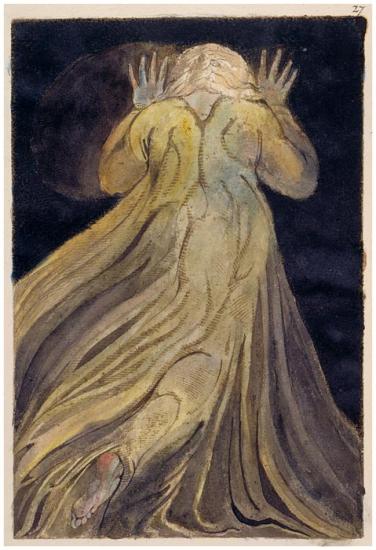
The First Book of Urizen
Lambeth: Printed by William Blake, 1794
Copy B
Gift of Mrs. Landon K. Thorne, 1972
The First Book of Urizen, The Book of Los, and The Book of Ahania constitute an unorthodox rewriting of the Pentateuch. This mythic transformation of the Jewish and Christian Scriptures offers many perspectives, but to highlight the biblical relationships, Blake designed the leaves to contain two columns of text. The work exemplifies his own radical spirit. A total of eight copies exist; this copy is one of only two containing the complete series of twenty-eight plates.
William Blake (1757–1827) occupies a unique place in the history of Western art. His creativity included both the visual and literary arts. In his lifetime he was best known as an engraver; now he is also recognized for his innovative poetry, printmaking, and painting. Blake's keen perception of the political and social climate found expression throughout his work. His strong sense of independence is evident in the complex mythology that he constructed in response to the age of revolution.
Blake was already recognized as an engraver at age twenty-five, when his first volume of poems appeared. At thirty-three, in The Marriage of Heaven and Hell, he audaciously claimed that his birth had marked the origin of a "new heaven" in which his own art would exemplify the creativity prefigured by Milton and Michelangelo. By that time, Blake, in one of his most productive periods, had already produced Songs of Innocence and was at work on a series of illuminated books. In 1818 he met John Linnell, a young painter and engraver, through whom a group of young artists became Blake's followers. Calling themselves the Ancients, they helped perpetuate Blake's influence for generations.
The Morgan's Blake collection—one of this country's most distinguished—began with purchases as early as 1899 by Pierpont Morgan. During the tenure of Charles Ryskamp, director from 1969 to 1986, major gifts almost doubled the size of its Blake holdings. In recent years Ryskamp's own gifts of engravings, letters, and related materials have significantly enriched its scholarly resources.
This online exhibition is presented in conjunction with the exhibition William Blake's World: "A New Heaven Is Begun" on view September 11, 2009, through January 3, 2010.
This exhibition is made possible through the generosity of Fay and Geoffrey Elliott.
The First Book of Urizen 28
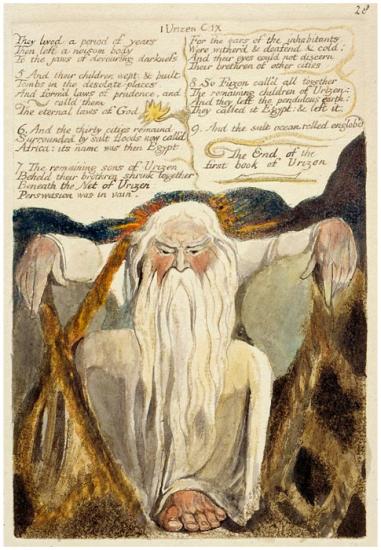
The First Book of Urizen
Lambeth: Printed by William Blake, 1794
Copy B
Gift of Mrs. Landon K. Thorne, 1972
The First Book of Urizen, The Book of Los, and The Book of Ahania constitute an unorthodox rewriting of the Pentateuch. This mythic transformation of the Jewish and Christian Scriptures offers many perspectives, but to highlight the biblical relationships, Blake designed the leaves to contain two columns of text. The work exemplifies his own radical spirit. A total of eight copies exist; this copy is one of only two containing the complete series of twenty-eight plates.
William Blake (1757–1827) occupies a unique place in the history of Western art. His creativity included both the visual and literary arts. In his lifetime he was best known as an engraver; now he is also recognized for his innovative poetry, printmaking, and painting. Blake's keen perception of the political and social climate found expression throughout his work. His strong sense of independence is evident in the complex mythology that he constructed in response to the age of revolution.
Blake was already recognized as an engraver at age twenty-five, when his first volume of poems appeared. At thirty-three, in The Marriage of Heaven and Hell, he audaciously claimed that his birth had marked the origin of a "new heaven" in which his own art would exemplify the creativity prefigured by Milton and Michelangelo. By that time, Blake, in one of his most productive periods, had already produced Songs of Innocence and was at work on a series of illuminated books. In 1818 he met John Linnell, a young painter and engraver, through whom a group of young artists became Blake's followers. Calling themselves the Ancients, they helped perpetuate Blake's influence for generations.
The Morgan's Blake collection—one of this country's most distinguished—began with purchases as early as 1899 by Pierpont Morgan. During the tenure of Charles Ryskamp, director from 1969 to 1986, major gifts almost doubled the size of its Blake holdings. In recent years Ryskamp's own gifts of engravings, letters, and related materials have significantly enriched its scholarly resources.
This online exhibition is presented in conjunction with the exhibition William Blake's World: "A New Heaven Is Begun" on view September 11, 2009, through January 3, 2010.
This exhibition is made possible through the generosity of Fay and Geoffrey Elliott.
Visions of the Daughters of Albion 1
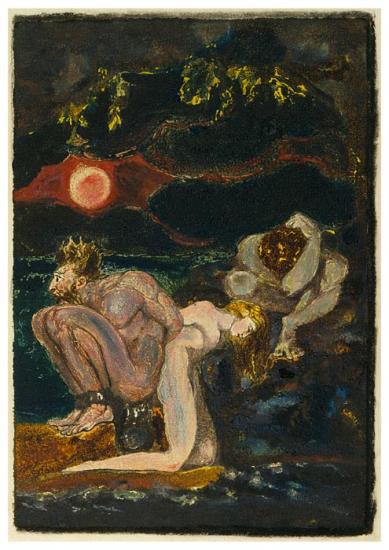
Visions of the Daughters of Albion
[Lambeth] : Printed by Will.m Blake, 1793
Relief etching, color printed
Copy F, printed about 1794
Gift of Mrs. Landon K. Thorne, 1972
This work has been described as Blake's critique not only of sexual oppression, but of slavery and colonialism as well. This is one of nineteen copies, of which only two—the present example and one in Munich—were color printed. When color printing, Blake appears to have used an ink that was more viscous than relief ink, thus creating a more intense, reticulated appearance.
William Blake (1757–1827) occupies a unique place in the history of Western art. His creativity included both the visual and literary arts. In his lifetime he was best known as an engraver; now he is also recognized for his innovative poetry, printmaking, and painting. Blake's keen perception of the political and social climate found expression throughout his work. His strong sense of independence is evident in the complex mythology that he constructed in response to the age of revolution.
Blake was already recognized as an engraver at age twenty-five, when his first volume of poems appeared. At thirty-three, in The Marriage of Heaven and Hell, he audaciously claimed that his birth had marked the origin of a "new heaven" in which his own art would exemplify the creativity prefigured by Milton and Michelangelo. By that time, Blake, in one of his most productive periods, had already produced Songs of Innocence and was at work on a series of illuminated books. In 1818 he met John Linnell, a young painter and engraver, through whom a group of young artists became Blake's followers. Calling themselves the Ancients, they helped perpetuate Blake's influence for generations.
The Morgan's Blake collection—one of this country's most distinguished—began with purchases as early as 1899 by Pierpont Morgan. During the tenure of Charles Ryskamp, director from 1969 to 1986, major gifts almost doubled the size of its Blake holdings. In recent years Ryskamp's own gifts of engravings, letters, and related materials have significantly enriched its scholarly resources.
This online exhibition is presented in conjunction with the exhibition William Blake's World: "A New Heaven Is Begun" on view September 11, 2009, through January 3, 2010.
This exhibition is made possible through the generosity of Fay and Geoffrey Elliott.
Visions of the Daughters of Albion 2
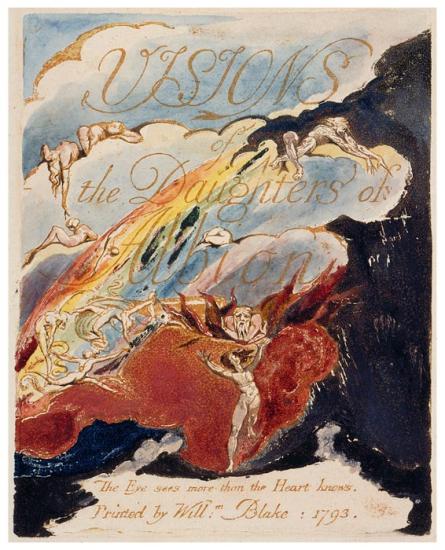
Visions of the Daughters of Albion
[Lambeth] : Printed by Will.m Blake, 1793
Relief etching, color printed
Copy F, printed about 1794
Gift of Mrs. Landon K. Thorne, 1972
This work has been described as Blake's critique not only of sexual oppression, but of slavery and colonialism as well. This is one of nineteen copies, of which only two—the present example and one in Munich—were color printed. When color printing, Blake appears to have used an ink that was more viscous than relief ink, thus creating a more intense, reticulated appearance.
William Blake (1757–1827) occupies a unique place in the history of Western art. His creativity included both the visual and literary arts. In his lifetime he was best known as an engraver; now he is also recognized for his innovative poetry, printmaking, and painting. Blake's keen perception of the political and social climate found expression throughout his work. His strong sense of independence is evident in the complex mythology that he constructed in response to the age of revolution.
Blake was already recognized as an engraver at age twenty-five, when his first volume of poems appeared. At thirty-three, in The Marriage of Heaven and Hell, he audaciously claimed that his birth had marked the origin of a "new heaven" in which his own art would exemplify the creativity prefigured by Milton and Michelangelo. By that time, Blake, in one of his most productive periods, had already produced Songs of Innocence and was at work on a series of illuminated books. In 1818 he met John Linnell, a young painter and engraver, through whom a group of young artists became Blake's followers. Calling themselves the Ancients, they helped perpetuate Blake's influence for generations.
The Morgan's Blake collection—one of this country's most distinguished—began with purchases as early as 1899 by Pierpont Morgan. During the tenure of Charles Ryskamp, director from 1969 to 1986, major gifts almost doubled the size of its Blake holdings. In recent years Ryskamp's own gifts of engravings, letters, and related materials have significantly enriched its scholarly resources.
This online exhibition is presented in conjunction with the exhibition William Blake's World: "A New Heaven Is Begun" on view September 11, 2009, through January 3, 2010.
This exhibition is made possible through the generosity of Fay and Geoffrey Elliott.
Visions of the Daughters of Albion 3

Visions of the Daughters of Albion
[Lambeth] : Printed by Will.m Blake, 1793
Relief etching, color printed
Copy F, printed about 1794
Gift of Mrs. Landon K. Thorne, 1972
This work has been described as Blake's critique not only of sexual oppression, but of slavery and colonialism as well. This is one of nineteen copies, of which only two—the present example and one in Munich—were color printed. When color printing, Blake appears to have used an ink that was more viscous than relief ink, thus creating a more intense, reticulated appearance.
William Blake (1757–1827) occupies a unique place in the history of Western art. His creativity included both the visual and literary arts. In his lifetime he was best known as an engraver; now he is also recognized for his innovative poetry, printmaking, and painting. Blake's keen perception of the political and social climate found expression throughout his work. His strong sense of independence is evident in the complex mythology that he constructed in response to the age of revolution.
Blake was already recognized as an engraver at age twenty-five, when his first volume of poems appeared. At thirty-three, in The Marriage of Heaven and Hell, he audaciously claimed that his birth had marked the origin of a "new heaven" in which his own art would exemplify the creativity prefigured by Milton and Michelangelo. By that time, Blake, in one of his most productive periods, had already produced Songs of Innocence and was at work on a series of illuminated books. In 1818 he met John Linnell, a young painter and engraver, through whom a group of young artists became Blake's followers. Calling themselves the Ancients, they helped perpetuate Blake's influence for generations.
The Morgan's Blake collection—one of this country's most distinguished—began with purchases as early as 1899 by Pierpont Morgan. During the tenure of Charles Ryskamp, director from 1969 to 1986, major gifts almost doubled the size of its Blake holdings. In recent years Ryskamp's own gifts of engravings, letters, and related materials have significantly enriched its scholarly resources.
This online exhibition is presented in conjunction with the exhibition William Blake's World: "A New Heaven Is Begun" on view September 11, 2009, through January 3, 2010.
This exhibition is made possible through the generosity of Fay and Geoffrey Elliott.
Visions of the Daughters of Albion 4

Visions of the Daughters of Albion
[Lambeth] : Printed by Will.m Blake, 1793
Relief etching, color printed
Copy F, printed about 1794
Gift of Mrs. Landon K. Thorne, 1972
This work has been described as Blake's critique not only of sexual oppression, but of slavery and colonialism as well. This is one of nineteen copies, of which only two—the present example and one in Munich—were color printed. When color printing, Blake appears to have used an ink that was more viscous than relief ink, thus creating a more intense, reticulated appearance.
William Blake (1757–1827) occupies a unique place in the history of Western art. His creativity included both the visual and literary arts. In his lifetime he was best known as an engraver; now he is also recognized for his innovative poetry, printmaking, and painting. Blake's keen perception of the political and social climate found expression throughout his work. His strong sense of independence is evident in the complex mythology that he constructed in response to the age of revolution.
Blake was already recognized as an engraver at age twenty-five, when his first volume of poems appeared. At thirty-three, in The Marriage of Heaven and Hell, he audaciously claimed that his birth had marked the origin of a "new heaven" in which his own art would exemplify the creativity prefigured by Milton and Michelangelo. By that time, Blake, in one of his most productive periods, had already produced Songs of Innocence and was at work on a series of illuminated books. In 1818 he met John Linnell, a young painter and engraver, through whom a group of young artists became Blake's followers. Calling themselves the Ancients, they helped perpetuate Blake's influence for generations.
The Morgan's Blake collection—one of this country's most distinguished—began with purchases as early as 1899 by Pierpont Morgan. During the tenure of Charles Ryskamp, director from 1969 to 1986, major gifts almost doubled the size of its Blake holdings. In recent years Ryskamp's own gifts of engravings, letters, and related materials have significantly enriched its scholarly resources.
This online exhibition is presented in conjunction with the exhibition William Blake's World: "A New Heaven Is Begun" on view September 11, 2009, through January 3, 2010.
This exhibition is made possible through the generosity of Fay and Geoffrey Elliott.
Visions of the Daughters of Albion 5
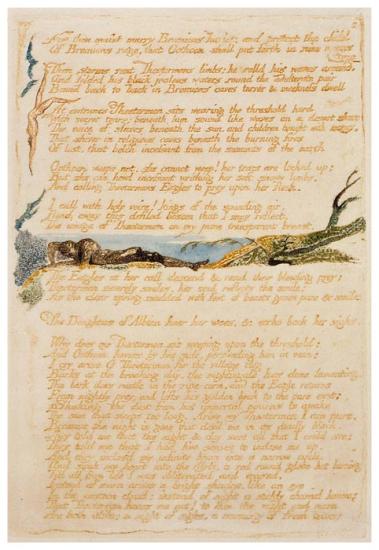
Visions of the Daughters of Albion
[Lambeth] : Printed by Will.m Blake, 1793
Relief etching, color printed
Copy F, printed about 1794
Gift of Mrs. Landon K. Thorne, 1972
This work has been described as Blake's critique not only of sexual oppression, but of slavery and colonialism as well. This is one of nineteen copies, of which only two—the present example and one in Munich—were color printed. When color printing, Blake appears to have used an ink that was more viscous than relief ink, thus creating a more intense, reticulated appearance.
William Blake (1757–1827) occupies a unique place in the history of Western art. His creativity included both the visual and literary arts. In his lifetime he was best known as an engraver; now he is also recognized for his innovative poetry, printmaking, and painting. Blake's keen perception of the political and social climate found expression throughout his work. His strong sense of independence is evident in the complex mythology that he constructed in response to the age of revolution.
Blake was already recognized as an engraver at age twenty-five, when his first volume of poems appeared. At thirty-three, in The Marriage of Heaven and Hell, he audaciously claimed that his birth had marked the origin of a "new heaven" in which his own art would exemplify the creativity prefigured by Milton and Michelangelo. By that time, Blake, in one of his most productive periods, had already produced Songs of Innocence and was at work on a series of illuminated books. In 1818 he met John Linnell, a young painter and engraver, through whom a group of young artists became Blake's followers. Calling themselves the Ancients, they helped perpetuate Blake's influence for generations.
The Morgan's Blake collection—one of this country's most distinguished—began with purchases as early as 1899 by Pierpont Morgan. During the tenure of Charles Ryskamp, director from 1969 to 1986, major gifts almost doubled the size of its Blake holdings. In recent years Ryskamp's own gifts of engravings, letters, and related materials have significantly enriched its scholarly resources.
This online exhibition is presented in conjunction with the exhibition William Blake's World: "A New Heaven Is Begun" on view September 11, 2009, through January 3, 2010.
This exhibition is made possible through the generosity of Fay and Geoffrey Elliott.
Visions of the Daughters of Albion 6

Visions of the Daughters of Albion
[Lambeth] : Printed by Will.m Blake, 1793
Relief etching, color printed
Copy F, printed about 1794
Gift of Mrs. Landon K. Thorne, 1972
This work has been described as Blake's critique not only of sexual oppression, but of slavery and colonialism as well. This is one of nineteen copies, of which only two—the present example and one in Munich—were color printed. When color printing, Blake appears to have used an ink that was more viscous than relief ink, thus creating a more intense, reticulated appearance.
William Blake (1757–1827) occupies a unique place in the history of Western art. His creativity included both the visual and literary arts. In his lifetime he was best known as an engraver; now he is also recognized for his innovative poetry, printmaking, and painting. Blake's keen perception of the political and social climate found expression throughout his work. His strong sense of independence is evident in the complex mythology that he constructed in response to the age of revolution.
Blake was already recognized as an engraver at age twenty-five, when his first volume of poems appeared. At thirty-three, in The Marriage of Heaven and Hell, he audaciously claimed that his birth had marked the origin of a "new heaven" in which his own art would exemplify the creativity prefigured by Milton and Michelangelo. By that time, Blake, in one of his most productive periods, had already produced Songs of Innocence and was at work on a series of illuminated books. In 1818 he met John Linnell, a young painter and engraver, through whom a group of young artists became Blake's followers. Calling themselves the Ancients, they helped perpetuate Blake's influence for generations.
The Morgan's Blake collection—one of this country's most distinguished—began with purchases as early as 1899 by Pierpont Morgan. During the tenure of Charles Ryskamp, director from 1969 to 1986, major gifts almost doubled the size of its Blake holdings. In recent years Ryskamp's own gifts of engravings, letters, and related materials have significantly enriched its scholarly resources.
This online exhibition is presented in conjunction with the exhibition William Blake's World: "A New Heaven Is Begun" on view September 11, 2009, through January 3, 2010.
This exhibition is made possible through the generosity of Fay and Geoffrey Elliott.
Visions of the Daughters of Albion 7
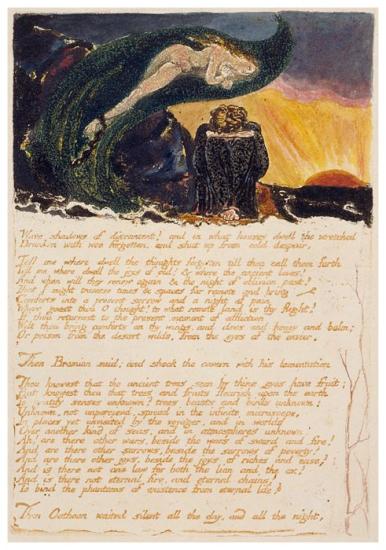
Visions of the Daughters of Albion
[Lambeth] : Printed by Will.m Blake, 1793
Relief etching, color printed
Copy F, printed about 1794
Gift of Mrs. Landon K. Thorne, 1972
This work has been described as Blake's critique not only of sexual oppression, but of slavery and colonialism as well. This is one of nineteen copies, of which only two—the present example and one in Munich—were color printed. When color printing, Blake appears to have used an ink that was more viscous than relief ink, thus creating a more intense, reticulated appearance.
William Blake (1757–1827) occupies a unique place in the history of Western art. His creativity included both the visual and literary arts. In his lifetime he was best known as an engraver; now he is also recognized for his innovative poetry, printmaking, and painting. Blake's keen perception of the political and social climate found expression throughout his work. His strong sense of independence is evident in the complex mythology that he constructed in response to the age of revolution.
Blake was already recognized as an engraver at age twenty-five, when his first volume of poems appeared. At thirty-three, in The Marriage of Heaven and Hell, he audaciously claimed that his birth had marked the origin of a "new heaven" in which his own art would exemplify the creativity prefigured by Milton and Michelangelo. By that time, Blake, in one of his most productive periods, had already produced Songs of Innocence and was at work on a series of illuminated books. In 1818 he met John Linnell, a young painter and engraver, through whom a group of young artists became Blake's followers. Calling themselves the Ancients, they helped perpetuate Blake's influence for generations.
The Morgan's Blake collection—one of this country's most distinguished—began with purchases as early as 1899 by Pierpont Morgan. During the tenure of Charles Ryskamp, director from 1969 to 1986, major gifts almost doubled the size of its Blake holdings. In recent years Ryskamp's own gifts of engravings, letters, and related materials have significantly enriched its scholarly resources.
This online exhibition is presented in conjunction with the exhibition William Blake's World: "A New Heaven Is Begun" on view September 11, 2009, through January 3, 2010.
This exhibition is made possible through the generosity of Fay and Geoffrey Elliott.
Visions of the Daughters of Albion 8

Visions of the Daughters of Albion
[Lambeth] : Printed by Will.m Blake, 1793
Relief etching, color printed
Copy F, printed about 1794
Gift of Mrs. Landon K. Thorne, 1972
This work has been described as Blake's critique not only of sexual oppression, but of slavery and colonialism as well. This is one of nineteen copies, of which only two—the present example and one in Munich—were color printed. When color printing, Blake appears to have used an ink that was more viscous than relief ink, thus creating a more intense, reticulated appearance.
William Blake (1757–1827) occupies a unique place in the history of Western art. His creativity included both the visual and literary arts. In his lifetime he was best known as an engraver; now he is also recognized for his innovative poetry, printmaking, and painting. Blake's keen perception of the political and social climate found expression throughout his work. His strong sense of independence is evident in the complex mythology that he constructed in response to the age of revolution.
Blake was already recognized as an engraver at age twenty-five, when his first volume of poems appeared. At thirty-three, in The Marriage of Heaven and Hell, he audaciously claimed that his birth had marked the origin of a "new heaven" in which his own art would exemplify the creativity prefigured by Milton and Michelangelo. By that time, Blake, in one of his most productive periods, had already produced Songs of Innocence and was at work on a series of illuminated books. In 1818 he met John Linnell, a young painter and engraver, through whom a group of young artists became Blake's followers. Calling themselves the Ancients, they helped perpetuate Blake's influence for generations.
The Morgan's Blake collection—one of this country's most distinguished—began with purchases as early as 1899 by Pierpont Morgan. During the tenure of Charles Ryskamp, director from 1969 to 1986, major gifts almost doubled the size of its Blake holdings. In recent years Ryskamp's own gifts of engravings, letters, and related materials have significantly enriched its scholarly resources.
This online exhibition is presented in conjunction with the exhibition William Blake's World: "A New Heaven Is Begun" on view September 11, 2009, through January 3, 2010.
This exhibition is made possible through the generosity of Fay and Geoffrey Elliott.
Visions of the Daughters of Albion 9
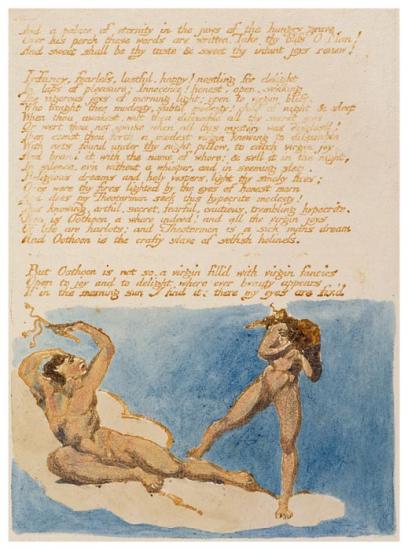
Visions of the Daughters of Albion
[Lambeth] : Printed by Will.m Blake, 1793
Relief etching, color printed
Copy F, printed about 1794
Gift of Mrs. Landon K. Thorne, 1972
This work has been described as Blake's critique not only of sexual oppression, but of slavery and colonialism as well. This is one of nineteen copies, of which only two—the present example and one in Munich—were color printed. When color printing, Blake appears to have used an ink that was more viscous than relief ink, thus creating a more intense, reticulated appearance.
William Blake (1757–1827) occupies a unique place in the history of Western art. His creativity included both the visual and literary arts. In his lifetime he was best known as an engraver; now he is also recognized for his innovative poetry, printmaking, and painting. Blake's keen perception of the political and social climate found expression throughout his work. His strong sense of independence is evident in the complex mythology that he constructed in response to the age of revolution.
Blake was already recognized as an engraver at age twenty-five, when his first volume of poems appeared. At thirty-three, in The Marriage of Heaven and Hell, he audaciously claimed that his birth had marked the origin of a "new heaven" in which his own art would exemplify the creativity prefigured by Milton and Michelangelo. By that time, Blake, in one of his most productive periods, had already produced Songs of Innocence and was at work on a series of illuminated books. In 1818 he met John Linnell, a young painter and engraver, through whom a group of young artists became Blake's followers. Calling themselves the Ancients, they helped perpetuate Blake's influence for generations.
The Morgan's Blake collection—one of this country's most distinguished—began with purchases as early as 1899 by Pierpont Morgan. During the tenure of Charles Ryskamp, director from 1969 to 1986, major gifts almost doubled the size of its Blake holdings. In recent years Ryskamp's own gifts of engravings, letters, and related materials have significantly enriched its scholarly resources.
This online exhibition is presented in conjunction with the exhibition William Blake's World: "A New Heaven Is Begun" on view September 11, 2009, through January 3, 2010.
This exhibition is made possible through the generosity of Fay and Geoffrey Elliott.
Visions of the Daughters of Albion 10

Visions of the Daughters of Albion
[Lambeth] : Printed by Will.m Blake, 1793
Relief etching, color printed
Copy F, printed about 1794
Gift of Mrs. Landon K. Thorne, 1972
This work has been described as Blake's critique not only of sexual oppression, but of slavery and colonialism as well. This is one of nineteen copies, of which only two—the present example and one in Munich—were color printed. When color printing, Blake appears to have used an ink that was more viscous than relief ink, thus creating a more intense, reticulated appearance.
William Blake (1757–1827) occupies a unique place in the history of Western art. His creativity included both the visual and literary arts. In his lifetime he was best known as an engraver; now he is also recognized for his innovative poetry, printmaking, and painting. Blake's keen perception of the political and social climate found expression throughout his work. His strong sense of independence is evident in the complex mythology that he constructed in response to the age of revolution.
Blake was already recognized as an engraver at age twenty-five, when his first volume of poems appeared. At thirty-three, in The Marriage of Heaven and Hell, he audaciously claimed that his birth had marked the origin of a "new heaven" in which his own art would exemplify the creativity prefigured by Milton and Michelangelo. By that time, Blake, in one of his most productive periods, had already produced Songs of Innocence and was at work on a series of illuminated books. In 1818 he met John Linnell, a young painter and engraver, through whom a group of young artists became Blake's followers. Calling themselves the Ancients, they helped perpetuate Blake's influence for generations.
The Morgan's Blake collection—one of this country's most distinguished—began with purchases as early as 1899 by Pierpont Morgan. During the tenure of Charles Ryskamp, director from 1969 to 1986, major gifts almost doubled the size of its Blake holdings. In recent years Ryskamp's own gifts of engravings, letters, and related materials have significantly enriched its scholarly resources.
This online exhibition is presented in conjunction with the exhibition William Blake's World: "A New Heaven Is Begun" on view September 11, 2009, through January 3, 2010.
This exhibition is made possible through the generosity of Fay and Geoffrey Elliott.
Visions of the Daughters of Albion 11
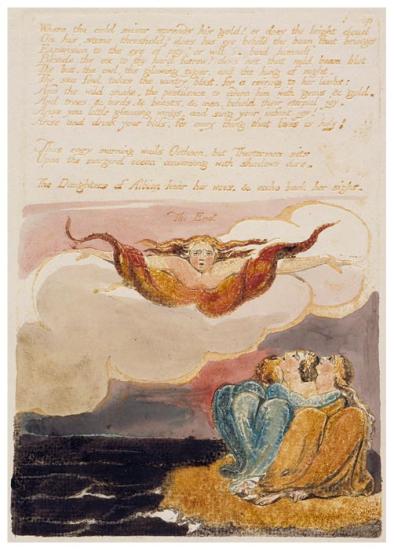
Visions of the Daughters of Albion
[Lambeth] : Printed by Will.m Blake, 1793
Relief etching, color printed
Copy F, printed about 1794
Gift of Mrs. Landon K. Thorne, 1972
This work has been described as Blake's critique not only of sexual oppression, but of slavery and colonialism as well. This is one of nineteen copies, of which only two—the present example and one in Munich—were color printed. When color printing, Blake appears to have used an ink that was more viscous than relief ink, thus creating a more intense, reticulated appearance.
William Blake (1757–1827) occupies a unique place in the history of Western art. His creativity included both the visual and literary arts. In his lifetime he was best known as an engraver; now he is also recognized for his innovative poetry, printmaking, and painting. Blake's keen perception of the political and social climate found expression throughout his work. His strong sense of independence is evident in the complex mythology that he constructed in response to the age of revolution.
Blake was already recognized as an engraver at age twenty-five, when his first volume of poems appeared. At thirty-three, in The Marriage of Heaven and Hell, he audaciously claimed that his birth had marked the origin of a "new heaven" in which his own art would exemplify the creativity prefigured by Milton and Michelangelo. By that time, Blake, in one of his most productive periods, had already produced Songs of Innocence and was at work on a series of illuminated books. In 1818 he met John Linnell, a young painter and engraver, through whom a group of young artists became Blake's followers. Calling themselves the Ancients, they helped perpetuate Blake's influence for generations.
The Morgan's Blake collection—one of this country's most distinguished—began with purchases as early as 1899 by Pierpont Morgan. During the tenure of Charles Ryskamp, director from 1969 to 1986, major gifts almost doubled the size of its Blake holdings. In recent years Ryskamp's own gifts of engravings, letters, and related materials have significantly enriched its scholarly resources.
This online exhibition is presented in conjunction with the exhibition William Blake's World: "A New Heaven Is Begun" on view September 11, 2009, through January 3, 2010.
This exhibition is made possible through the generosity of Fay and Geoffrey Elliott.
Christ Nailed to the Cross: The Third Hour
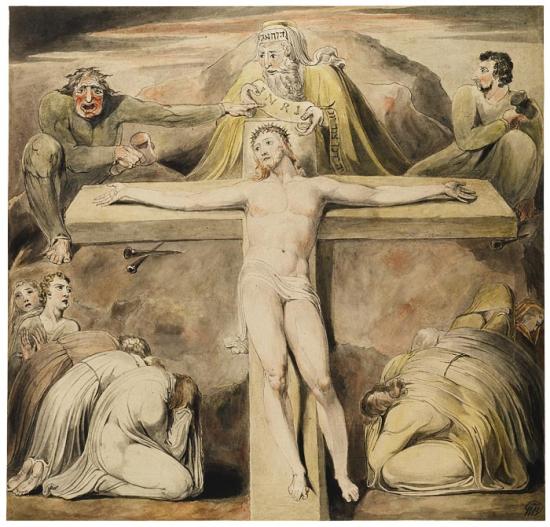
Christ Nailed to the Cross: The Third Hour
Signed with monogram in pen and black ink, W. B.
The Thaw Collection, Pierpont Morgan Library
This highly finished watercolor is one of several drawings Blake made to depict the Passion of Christ for Thomas Butts's 1799 commission to illustrate the Bible. The Passion cycle as a whole is distinguished by the cumulative emotional power derived from the repetition of Christ's form at the center of each sheet.
William Blake (1757–1827) occupies a unique place in the history of Western art. His creativity included both the visual and literary arts. In his lifetime he was best known as an engraver; now he is also recognized for his innovative poetry, printmaking, and painting. Blake's keen perception of the political and social climate found expression throughout his work. His strong sense of independence is evident in the complex mythology that he constructed in response to the age of revolution.
Blake was already recognized as an engraver at age twenty-five, when his first volume of poems appeared. At thirty-three, in The Marriage of Heaven and Hell, he audaciously claimed that his birth had marked the origin of a "new heaven" in which his own art would exemplify the creativity prefigured by Milton and Michelangelo. By that time, Blake, in one of his most productive periods, had already produced Songs of Innocence and was at work on a series of illuminated books. In 1818 he met John Linnell, a young painter and engraver, through whom a group of young artists became Blake's followers. Calling themselves the Ancients, they helped perpetuate Blake's influence for generations.
The Morgan's Blake collection—one of this country's most distinguished—began with purchases as early as 1899 by Pierpont Morgan. During the tenure of Charles Ryskamp, director from 1969 to 1986, major gifts almost doubled the size of its Blake holdings. In recent years Ryskamp's own gifts of engravings, letters, and related materials have significantly enriched its scholarly resources.
This online exhibition is presented in conjunction with the exhibition William Blake's World: "A New Heaven Is Begun" on view September 11, 2009, through January 3, 2010.
This exhibition is made possible through the generosity of Fay and Geoffrey Elliott.
The Complaint, and the Consolation; or Night Thoughts.

The Complaint, and the Consolation; or Night Thoughts.
London: Printed by R. Noble for R. Edwards, 1797.
Designed and engraved by William Blake; hand colored, possibly by Blake and his wife
Copy K
Gift of Mrs. Landon K. Thorne, 1973
One of the two or three works for which Blake was most generally known during his lifetime, Night Thoughts is by one of the widely admired Graveyard poets. Blake painted 537 watercolors for the poem, of which he engraved forty-three for this first, and only, volume. The volume was so expensive to produce that no more were published. It is open to Night the Second on Time, Death, and Friendship, where Time, reaching high, tries to divert the arrow of Death from the two friends. On the left, the soul struggles upward for immortality while confined to the earth by a chain. Mrs. Blake was her husband's assistant for some illuminated works, but for this large project he may have set a pattern for professional colorists to follow.
William Blake (1757–1827) occupies a unique place in the history of Western art. His creativity included both the visual and literary arts. In his lifetime he was best known as an engraver; now he is also recognized for his innovative poetry, printmaking, and painting. Blake's keen perception of the political and social climate found expression throughout his work. His strong sense of independence is evident in the complex mythology that he constructed in response to the age of revolution.
Blake was already recognized as an engraver at age twenty-five, when his first volume of poems appeared. At thirty-three, in The Marriage of Heaven and Hell, he audaciously claimed that his birth had marked the origin of a "new heaven" in which his own art would exemplify the creativity prefigured by Milton and Michelangelo. By that time, Blake, in one of his most productive periods, had already produced Songs of Innocence and was at work on a series of illuminated books. In 1818 he met John Linnell, a young painter and engraver, through whom a group of young artists became Blake's followers. Calling themselves the Ancients, they helped perpetuate Blake's influence for generations.
The Morgan's Blake collection—one of this country's most distinguished—began with purchases as early as 1899 by Pierpont Morgan. During the tenure of Charles Ryskamp, director from 1969 to 1986, major gifts almost doubled the size of its Blake holdings. In recent years Ryskamp's own gifts of engravings, letters, and related materials have significantly enriched its scholarly resources.
This online exhibition is presented in conjunction with the exhibition William Blake's World: "A New Heaven Is Begun" on view September 11, 2009, through January 3, 2010.
This exhibition is made possible through the generosity of Fay and Geoffrey Elliott.
The Marriage of Heaven and Hell 1
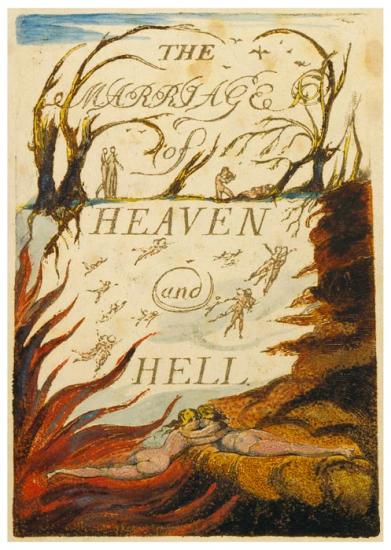
The Marriage of Heaven and Hell
[Lambeth, ca. 1794].
Relief and white line etching, with color printing and hand coloring
Copy F, printed ca. 1794
Gift of Mrs. Landon K. Thorne, 1973
William Blake (1757–1827) occupies a unique place in the history of Western art. His creativity included both the visual and literary arts. In his lifetime he was best known as an engraver; now he is also recognized for his innovative poetry, printmaking, and painting. Blake's keen perception of the political and social climate found expression throughout his work. His strong sense of independence is evident in the complex mythology that he constructed in response to the age of revolution.
Blake was already recognized as an engraver at age twenty-five, when his first volume of poems appeared. At thirty-three, in The Marriage of Heaven and Hell, he audaciously claimed that his birth had marked the origin of a "new heaven" in which his own art would exemplify the creativity prefigured by Milton and Michelangelo. By that time, Blake, in one of his most productive periods, had already produced Songs of Innocence and was at work on a series of illuminated books. In 1818 he met John Linnell, a young painter and engraver, through whom a group of young artists became Blake's followers. Calling themselves the Ancients, they helped perpetuate Blake's influence for generations.
The Morgan's Blake collection—one of this country's most distinguished—began with purchases as early as 1899 by Pierpont Morgan. During the tenure of Charles Ryskamp, director from 1969 to 1986, major gifts almost doubled the size of its Blake holdings. In recent years Ryskamp's own gifts of engravings, letters, and related materials have significantly enriched its scholarly resources.
This online exhibition is presented in conjunction with the exhibition William Blake's World: "A New Heaven Is Begun" on view September 11, 2009, through January 3, 2010.
This exhibition is made possible through the generosity of Fay and Geoffrey Elliott.
The Marriage of Heaven and Hell 2
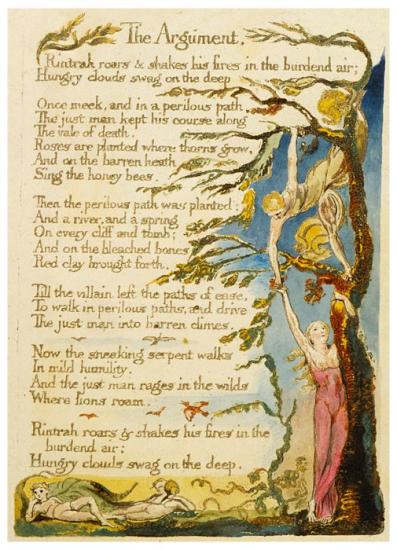
The Marriage of Heaven and Hell
[Lambeth, ca. 1794].
Relief and white line etching, with color printing and hand coloring
Copy F, printed ca. 1794
Gift of Mrs. Landon K. Thorne, 1973
William Blake (1757–1827) occupies a unique place in the history of Western art. His creativity included both the visual and literary arts. In his lifetime he was best known as an engraver; now he is also recognized for his innovative poetry, printmaking, and painting. Blake's keen perception of the political and social climate found expression throughout his work. His strong sense of independence is evident in the complex mythology that he constructed in response to the age of revolution.
Blake was already recognized as an engraver at age twenty-five, when his first volume of poems appeared. At thirty-three, in The Marriage of Heaven and Hell, he audaciously claimed that his birth had marked the origin of a "new heaven" in which his own art would exemplify the creativity prefigured by Milton and Michelangelo. By that time, Blake, in one of his most productive periods, had already produced Songs of Innocence and was at work on a series of illuminated books. In 1818 he met John Linnell, a young painter and engraver, through whom a group of young artists became Blake's followers. Calling themselves the Ancients, they helped perpetuate Blake's influence for generations.
The Morgan's Blake collection—one of this country's most distinguished—began with purchases as early as 1899 by Pierpont Morgan. During the tenure of Charles Ryskamp, director from 1969 to 1986, major gifts almost doubled the size of its Blake holdings. In recent years Ryskamp's own gifts of engravings, letters, and related materials have significantly enriched its scholarly resources.
This online exhibition is presented in conjunction with the exhibition William Blake's World: "A New Heaven Is Begun" on view September 11, 2009, through January 3, 2010.
This exhibition is made possible through the generosity of Fay and Geoffrey Elliott.
The Marriage of Heaven and Hell 7
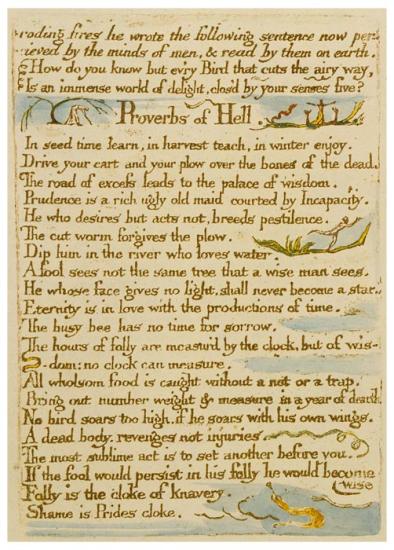
The Marriage of Heaven and Hell
[Lambeth, ca. 1794].
Relief and white line etching, with color printing and hand coloring
Copy F, printed ca. 1794
Gift of Mrs. Landon K. Thorne, 1973
William Blake (1757–1827) occupies a unique place in the history of Western art. His creativity included both the visual and literary arts. In his lifetime he was best known as an engraver; now he is also recognized for his innovative poetry, printmaking, and painting. Blake's keen perception of the political and social climate found expression throughout his work. His strong sense of independence is evident in the complex mythology that he constructed in response to the age of revolution.
Blake was already recognized as an engraver at age twenty-five, when his first volume of poems appeared. At thirty-three, in The Marriage of Heaven and Hell, he audaciously claimed that his birth had marked the origin of a "new heaven" in which his own art would exemplify the creativity prefigured by Milton and Michelangelo. By that time, Blake, in one of his most productive periods, had already produced Songs of Innocence and was at work on a series of illuminated books. In 1818 he met John Linnell, a young painter and engraver, through whom a group of young artists became Blake's followers. Calling themselves the Ancients, they helped perpetuate Blake's influence for generations.
The Morgan's Blake collection—one of this country's most distinguished—began with purchases as early as 1899 by Pierpont Morgan. During the tenure of Charles Ryskamp, director from 1969 to 1986, major gifts almost doubled the size of its Blake holdings. In recent years Ryskamp's own gifts of engravings, letters, and related materials have significantly enriched its scholarly resources.
This online exhibition is presented in conjunction with the exhibition William Blake's World: "A New Heaven Is Begun" on view September 11, 2009, through January 3, 2010.
This exhibition is made possible through the generosity of Fay and Geoffrey Elliott.
The Marriage of Heaven and Hell 3
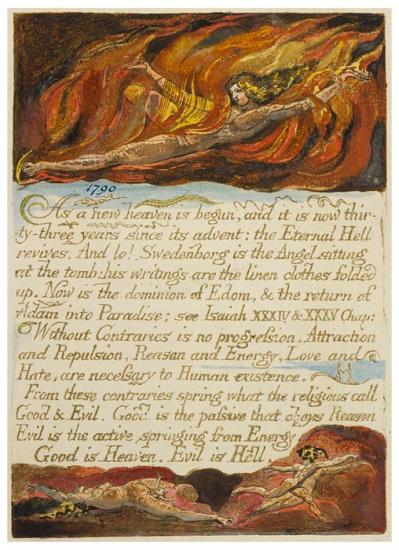
The Marriage of Heaven and Hell
[Lambeth, ca. 1794].
Relief and white line etching, with color printing and hand coloring
Copy F, printed ca. 1794
Gift of Mrs. Landon K. Thorne, 1973
Although the title page is undated, the twenty-seven plates of Marriage were probably created in 1790, as is indicated in ink on this plate of a 1794 printing. The date highlights Blake's claim that at age thirty-three he represented a "new heaven" of artistic creativity. His third illuminated book, Marriage was his first created in Hercules Buildings in Lambeth. This copy, which was once owned by Thomas Butts, Blake's great patron, was "color printed" by applying the pigments for the background directly to the shallow-etched printing plate.
The Morgan also owns Copy C, one of the four copies printed in 1790.
William Blake (1757–1827) occupies a unique place in the history of Western art. His creativity included both the visual and literary arts. In his lifetime he was best known as an engraver; now he is also recognized for his innovative poetry, printmaking, and painting. Blake's keen perception of the political and social climate found expression throughout his work. His strong sense of independence is evident in the complex mythology that he constructed in response to the age of revolution.
Blake was already recognized as an engraver at age twenty-five, when his first volume of poems appeared. At thirty-three, in The Marriage of Heaven and Hell, he audaciously claimed that his birth had marked the origin of a "new heaven" in which his own art would exemplify the creativity prefigured by Milton and Michelangelo. By that time, Blake, in one of his most productive periods, had already produced Songs of Innocence and was at work on a series of illuminated books. In 1818 he met John Linnell, a young painter and engraver, through whom a group of young artists became Blake's followers. Calling themselves the Ancients, they helped perpetuate Blake's influence for generations.
The Morgan's Blake collection—one of this country's most distinguished—began with purchases as early as 1899 by Pierpont Morgan. During the tenure of Charles Ryskamp, director from 1969 to 1986, major gifts almost doubled the size of its Blake holdings. In recent years Ryskamp's own gifts of engravings, letters, and related materials have significantly enriched its scholarly resources.
This online exhibition is presented in conjunction with the exhibition William Blake's World: "A New Heaven Is Begun" on view September 11, 2009, through January 3, 2010.
This exhibition is made possible through the generosity of Fay and Geoffrey Elliott.
The Marriage of Heaven and Hell 8
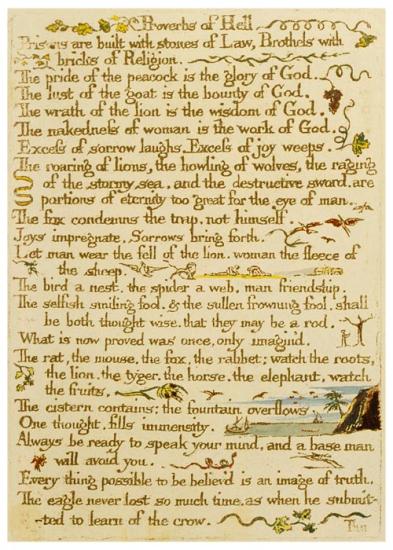
The Marriage of Heaven and Hell
[Lambeth, ca. 1794].
Relief and white line etching, with color printing and hand coloring
Copy F, printed ca. 1794
Gift of Mrs. Landon K. Thorne, 1973
William Blake (1757–1827) occupies a unique place in the history of Western art. His creativity included both the visual and literary arts. In his lifetime he was best known as an engraver; now he is also recognized for his innovative poetry, printmaking, and painting. Blake's keen perception of the political and social climate found expression throughout his work. His strong sense of independence is evident in the complex mythology that he constructed in response to the age of revolution.
Blake was already recognized as an engraver at age twenty-five, when his first volume of poems appeared. At thirty-three, in The Marriage of Heaven and Hell, he audaciously claimed that his birth had marked the origin of a "new heaven" in which his own art would exemplify the creativity prefigured by Milton and Michelangelo. By that time, Blake, in one of his most productive periods, had already produced Songs of Innocence and was at work on a series of illuminated books. In 1818 he met John Linnell, a young painter and engraver, through whom a group of young artists became Blake's followers. Calling themselves the Ancients, they helped perpetuate Blake's influence for generations.
The Morgan's Blake collection—one of this country's most distinguished—began with purchases as early as 1899 by Pierpont Morgan. During the tenure of Charles Ryskamp, director from 1969 to 1986, major gifts almost doubled the size of its Blake holdings. In recent years Ryskamp's own gifts of engravings, letters, and related materials have significantly enriched its scholarly resources.
This online exhibition is presented in conjunction with the exhibition William Blake's World: "A New Heaven Is Begun" on view September 11, 2009, through January 3, 2010.
This exhibition is made possible through the generosity of Fay and Geoffrey Elliott.
The Marriage of Heaven and Hell 4
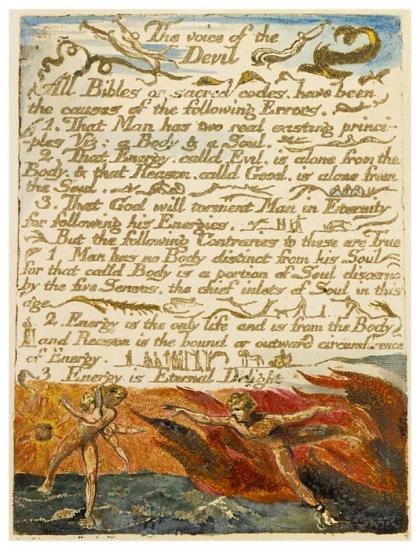
The Marriage of Heaven and Hell
[Lambeth, ca. 1794].
Relief and white line etching, with color printing and hand coloring
Copy F, printed ca. 1794
Gift of Mrs. Landon K. Thorne, 1973
William Blake (1757–1827) occupies a unique place in the history of Western art. His creativity included both the visual and literary arts. In his lifetime he was best known as an engraver; now he is also recognized for his innovative poetry, printmaking, and painting. Blake's keen perception of the political and social climate found expression throughout his work. His strong sense of independence is evident in the complex mythology that he constructed in response to the age of revolution.
Blake was already recognized as an engraver at age twenty-five, when his first volume of poems appeared. At thirty-three, in The Marriage of Heaven and Hell, he audaciously claimed that his birth had marked the origin of a "new heaven" in which his own art would exemplify the creativity prefigured by Milton and Michelangelo. By that time, Blake, in one of his most productive periods, had already produced Songs of Innocence and was at work on a series of illuminated books. In 1818 he met John Linnell, a young painter and engraver, through whom a group of young artists became Blake's followers. Calling themselves the Ancients, they helped perpetuate Blake's influence for generations.
The Morgan's Blake collection—one of this country's most distinguished—began with purchases as early as 1899 by Pierpont Morgan. During the tenure of Charles Ryskamp, director from 1969 to 1986, major gifts almost doubled the size of its Blake holdings. In recent years Ryskamp's own gifts of engravings, letters, and related materials have significantly enriched its scholarly resources.
This online exhibition is presented in conjunction with the exhibition William Blake's World: "A New Heaven Is Begun" on view September 11, 2009, through January 3, 2010.
This exhibition is made possible through the generosity of Fay and Geoffrey Elliott.
The Marriage of Heaven and Hell 9
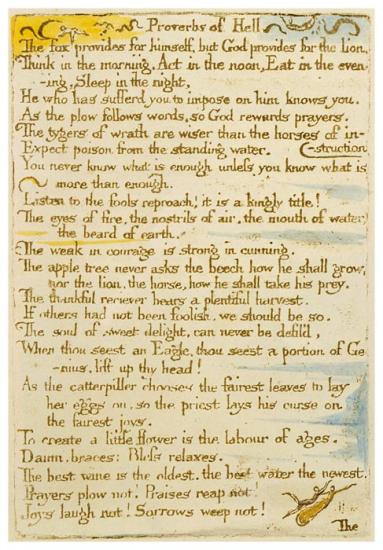
The Marriage of Heaven and Hell
[Lambeth, ca. 1794].
Relief and white line etching, with color printing and hand coloring
Copy F, printed ca. 1794
Gift of Mrs. Landon K. Thorne, 1973
William Blake (1757–1827) occupies a unique place in the history of Western art. His creativity included both the visual and literary arts. In his lifetime he was best known as an engraver; now he is also recognized for his innovative poetry, printmaking, and painting. Blake's keen perception of the political and social climate found expression throughout his work. His strong sense of independence is evident in the complex mythology that he constructed in response to the age of revolution.
Blake was already recognized as an engraver at age twenty-five, when his first volume of poems appeared. At thirty-three, in The Marriage of Heaven and Hell, he audaciously claimed that his birth had marked the origin of a "new heaven" in which his own art would exemplify the creativity prefigured by Milton and Michelangelo. By that time, Blake, in one of his most productive periods, had already produced Songs of Innocence and was at work on a series of illuminated books. In 1818 he met John Linnell, a young painter and engraver, through whom a group of young artists became Blake's followers. Calling themselves the Ancients, they helped perpetuate Blake's influence for generations.
The Morgan's Blake collection—one of this country's most distinguished—began with purchases as early as 1899 by Pierpont Morgan. During the tenure of Charles Ryskamp, director from 1969 to 1986, major gifts almost doubled the size of its Blake holdings. In recent years Ryskamp's own gifts of engravings, letters, and related materials have significantly enriched its scholarly resources.
This online exhibition is presented in conjunction with the exhibition William Blake's World: "A New Heaven Is Begun" on view September 11, 2009, through January 3, 2010.
This exhibition is made possible through the generosity of Fay and Geoffrey Elliott.
The Marriage of Heaven and Hell 10
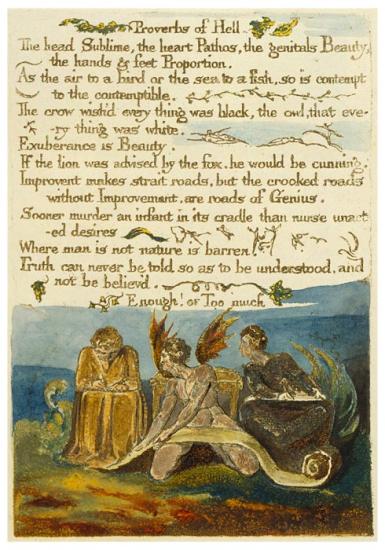
The Marriage of Heaven and Hell
[Lambeth, ca. 1794].
Relief and white line etching, with color printing and hand coloring
Copy F, printed ca. 1794
Gift of Mrs. Landon K. Thorne, 1973
William Blake (1757–1827) occupies a unique place in the history of Western art. His creativity included both the visual and literary arts. In his lifetime he was best known as an engraver; now he is also recognized for his innovative poetry, printmaking, and painting. Blake's keen perception of the political and social climate found expression throughout his work. His strong sense of independence is evident in the complex mythology that he constructed in response to the age of revolution.
Blake was already recognized as an engraver at age twenty-five, when his first volume of poems appeared. At thirty-three, in The Marriage of Heaven and Hell, he audaciously claimed that his birth had marked the origin of a "new heaven" in which his own art would exemplify the creativity prefigured by Milton and Michelangelo. By that time, Blake, in one of his most productive periods, had already produced Songs of Innocence and was at work on a series of illuminated books. In 1818 he met John Linnell, a young painter and engraver, through whom a group of young artists became Blake's followers. Calling themselves the Ancients, they helped perpetuate Blake's influence for generations.
The Morgan's Blake collection—one of this country's most distinguished—began with purchases as early as 1899 by Pierpont Morgan. During the tenure of Charles Ryskamp, director from 1969 to 1986, major gifts almost doubled the size of its Blake holdings. In recent years Ryskamp's own gifts of engravings, letters, and related materials have significantly enriched its scholarly resources.
This online exhibition is presented in conjunction with the exhibition William Blake's World: "A New Heaven Is Begun" on view September 11, 2009, through January 3, 2010.
This exhibition is made possible through the generosity of Fay and Geoffrey Elliott.
The Marriage of Heaven and Hell 5
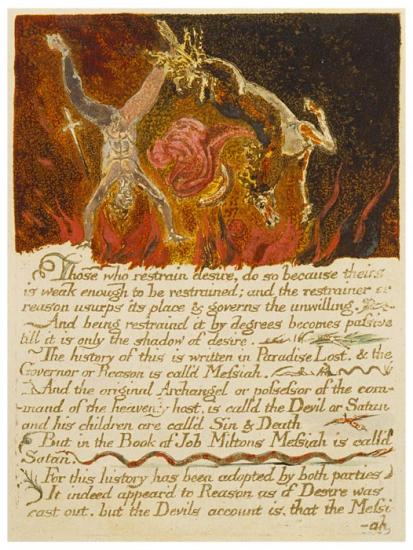
The Marriage of Heaven and Hell
[Lambeth, ca. 1794].
Relief and white line etching, with color printing and hand coloring
Copy F, printed ca. 1794
Gift of Mrs. Landon K. Thorne, 1973
William Blake (1757–1827) occupies a unique place in the history of Western art. His creativity included both the visual and literary arts. In his lifetime he was best known as an engraver; now he is also recognized for his innovative poetry, printmaking, and painting. Blake's keen perception of the political and social climate found expression throughout his work. His strong sense of independence is evident in the complex mythology that he constructed in response to the age of revolution.
Blake was already recognized as an engraver at age twenty-five, when his first volume of poems appeared. At thirty-three, in The Marriage of Heaven and Hell, he audaciously claimed that his birth had marked the origin of a "new heaven" in which his own art would exemplify the creativity prefigured by Milton and Michelangelo. By that time, Blake, in one of his most productive periods, had already produced Songs of Innocence and was at work on a series of illuminated books. In 1818 he met John Linnell, a young painter and engraver, through whom a group of young artists became Blake's followers. Calling themselves the Ancients, they helped perpetuate Blake's influence for generations.
The Morgan's Blake collection—one of this country's most distinguished—began with purchases as early as 1899 by Pierpont Morgan. During the tenure of Charles Ryskamp, director from 1969 to 1986, major gifts almost doubled the size of its Blake holdings. In recent years Ryskamp's own gifts of engravings, letters, and related materials have significantly enriched its scholarly resources.
This online exhibition is presented in conjunction with the exhibition William Blake's World: "A New Heaven Is Begun" on view September 11, 2009, through January 3, 2010.
This exhibition is made possible through the generosity of Fay and Geoffrey Elliott.
The Marriage of Heaven and Hell 11
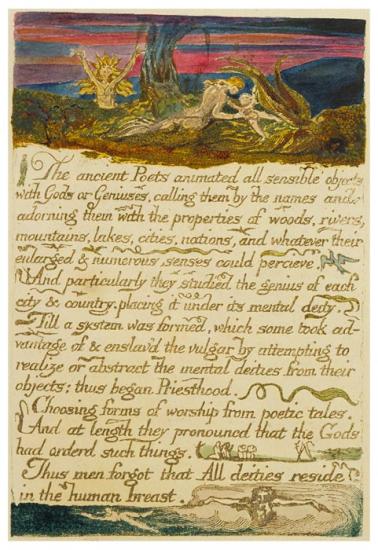
The Marriage of Heaven and Hell
[Lambeth, ca. 1794].
Relief and white line etching, with color printing and hand coloring
Copy F, printed ca. 1794
Gift of Mrs. Landon K. Thorne, 1973
William Blake (1757–1827) occupies a unique place in the history of Western art. His creativity included both the visual and literary arts. In his lifetime he was best known as an engraver; now he is also recognized for his innovative poetry, printmaking, and painting. Blake's keen perception of the political and social climate found expression throughout his work. His strong sense of independence is evident in the complex mythology that he constructed in response to the age of revolution.
Blake was already recognized as an engraver at age twenty-five, when his first volume of poems appeared. At thirty-three, in The Marriage of Heaven and Hell, he audaciously claimed that his birth had marked the origin of a "new heaven" in which his own art would exemplify the creativity prefigured by Milton and Michelangelo. By that time, Blake, in one of his most productive periods, had already produced Songs of Innocence and was at work on a series of illuminated books. In 1818 he met John Linnell, a young painter and engraver, through whom a group of young artists became Blake's followers. Calling themselves the Ancients, they helped perpetuate Blake's influence for generations.
The Morgan's Blake collection—one of this country's most distinguished—began with purchases as early as 1899 by Pierpont Morgan. During the tenure of Charles Ryskamp, director from 1969 to 1986, major gifts almost doubled the size of its Blake holdings. In recent years Ryskamp's own gifts of engravings, letters, and related materials have significantly enriched its scholarly resources.
This online exhibition is presented in conjunction with the exhibition William Blake's World: "A New Heaven Is Begun" on view September 11, 2009, through January 3, 2010.
This exhibition is made possible through the generosity of Fay and Geoffrey Elliott.
The Marriage of Heaven and Hell 6
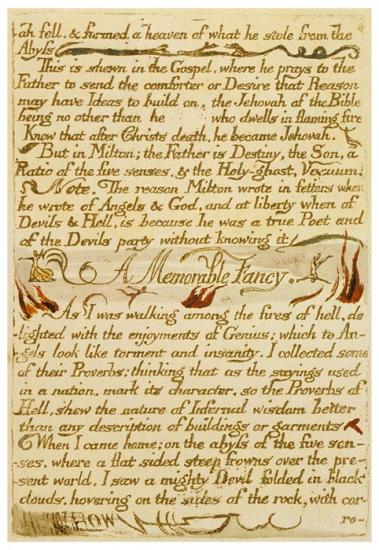
The Marriage of Heaven and Hell
[Lambeth, ca. 1794].
Relief and white line etching, with color printing and hand coloring
Copy F, printed ca. 1794
Gift of Mrs. Landon K. Thorne, 1973
William Blake (1757–1827) occupies a unique place in the history of Western art. His creativity included both the visual and literary arts. In his lifetime he was best known as an engraver; now he is also recognized for his innovative poetry, printmaking, and painting. Blake's keen perception of the political and social climate found expression throughout his work. His strong sense of independence is evident in the complex mythology that he constructed in response to the age of revolution.
Blake was already recognized as an engraver at age twenty-five, when his first volume of poems appeared. At thirty-three, in The Marriage of Heaven and Hell, he audaciously claimed that his birth had marked the origin of a "new heaven" in which his own art would exemplify the creativity prefigured by Milton and Michelangelo. By that time, Blake, in one of his most productive periods, had already produced Songs of Innocence and was at work on a series of illuminated books. In 1818 he met John Linnell, a young painter and engraver, through whom a group of young artists became Blake's followers. Calling themselves the Ancients, they helped perpetuate Blake's influence for generations.
The Morgan's Blake collection—one of this country's most distinguished—began with purchases as early as 1899 by Pierpont Morgan. During the tenure of Charles Ryskamp, director from 1969 to 1986, major gifts almost doubled the size of its Blake holdings. In recent years Ryskamp's own gifts of engravings, letters, and related materials have significantly enriched its scholarly resources.
This online exhibition is presented in conjunction with the exhibition William Blake's World: "A New Heaven Is Begun" on view September 11, 2009, through January 3, 2010.
This exhibition is made possible through the generosity of Fay and Geoffrey Elliott.
The Marriage of Heaven and Hell 12
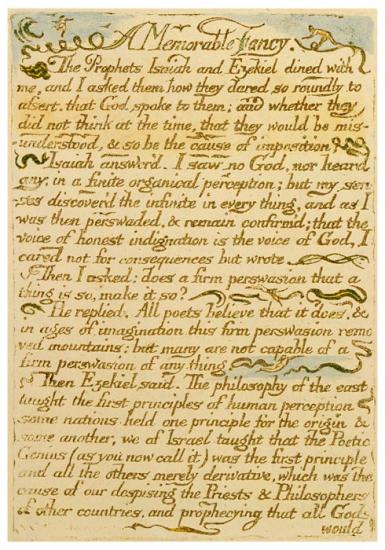
The Marriage of Heaven and Hell
[Lambeth, ca. 1794].
Relief and white line etching, with color printing and hand coloring
Copy F, printed ca. 1794
Gift of Mrs. Landon K. Thorne, 1973
William Blake (1757–1827) occupies a unique place in the history of Western art. His creativity included both the visual and literary arts. In his lifetime he was best known as an engraver; now he is also recognized for his innovative poetry, printmaking, and painting. Blake's keen perception of the political and social climate found expression throughout his work. His strong sense of independence is evident in the complex mythology that he constructed in response to the age of revolution.
Blake was already recognized as an engraver at age twenty-five, when his first volume of poems appeared. At thirty-three, in The Marriage of Heaven and Hell, he audaciously claimed that his birth had marked the origin of a "new heaven" in which his own art would exemplify the creativity prefigured by Milton and Michelangelo. By that time, Blake, in one of his most productive periods, had already produced Songs of Innocence and was at work on a series of illuminated books. In 1818 he met John Linnell, a young painter and engraver, through whom a group of young artists became Blake's followers. Calling themselves the Ancients, they helped perpetuate Blake's influence for generations.
The Morgan's Blake collection—one of this country's most distinguished—began with purchases as early as 1899 by Pierpont Morgan. During the tenure of Charles Ryskamp, director from 1969 to 1986, major gifts almost doubled the size of its Blake holdings. In recent years Ryskamp's own gifts of engravings, letters, and related materials have significantly enriched its scholarly resources.
This online exhibition is presented in conjunction with the exhibition William Blake's World: "A New Heaven Is Begun" on view September 11, 2009, through January 3, 2010.
This exhibition is made possible through the generosity of Fay and Geoffrey Elliott.
The Marriage of Heaven and Hell 13
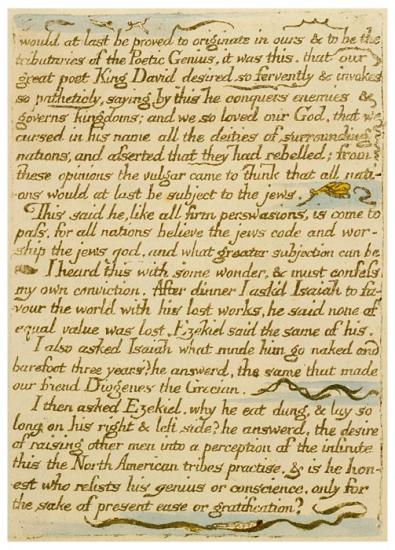
The Marriage of Heaven and Hell
[Lambeth, ca. 1794].
Relief and white line etching, with color printing and hand coloring
Copy F, printed ca. 1794
Gift of Mrs. Landon K. Thorne, 1973
William Blake (1757–1827) occupies a unique place in the history of Western art. His creativity included both the visual and literary arts. In his lifetime he was best known as an engraver; now he is also recognized for his innovative poetry, printmaking, and painting. Blake's keen perception of the political and social climate found expression throughout his work. His strong sense of independence is evident in the complex mythology that he constructed in response to the age of revolution.
Blake was already recognized as an engraver at age twenty-five, when his first volume of poems appeared. At thirty-three, in The Marriage of Heaven and Hell, he audaciously claimed that his birth had marked the origin of a "new heaven" in which his own art would exemplify the creativity prefigured by Milton and Michelangelo. By that time, Blake, in one of his most productive periods, had already produced Songs of Innocence and was at work on a series of illuminated books. In 1818 he met John Linnell, a young painter and engraver, through whom a group of young artists became Blake's followers. Calling themselves the Ancients, they helped perpetuate Blake's influence for generations.
The Morgan's Blake collection—one of this country's most distinguished—began with purchases as early as 1899 by Pierpont Morgan. During the tenure of Charles Ryskamp, director from 1969 to 1986, major gifts almost doubled the size of its Blake holdings. In recent years Ryskamp's own gifts of engravings, letters, and related materials have significantly enriched its scholarly resources.
This online exhibition is presented in conjunction with the exhibition William Blake's World: "A New Heaven Is Begun" on view September 11, 2009, through January 3, 2010.
This exhibition is made possible through the generosity of Fay and Geoffrey Elliott.
The Marriage of Heaven and Hell 14
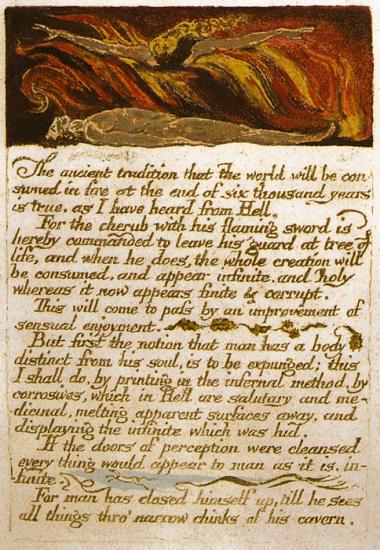
The Marriage of Heaven and Hell
[Lambeth, ca. 1794].
Relief and white line etching, with color printing and hand coloring
Copy F, printed ca. 1794
Gift of Mrs. Landon K. Thorne, 1973
William Blake (1757–1827) occupies a unique place in the history of Western art. His creativity included both the visual and literary arts. In his lifetime he was best known as an engraver; now he is also recognized for his innovative poetry, printmaking, and painting. Blake's keen perception of the political and social climate found expression throughout his work. His strong sense of independence is evident in the complex mythology that he constructed in response to the age of revolution.
Blake was already recognized as an engraver at age twenty-five, when his first volume of poems appeared. At thirty-three, in The Marriage of Heaven and Hell, he audaciously claimed that his birth had marked the origin of a "new heaven" in which his own art would exemplify the creativity prefigured by Milton and Michelangelo. By that time, Blake, in one of his most productive periods, had already produced Songs of Innocence and was at work on a series of illuminated books. In 1818 he met John Linnell, a young painter and engraver, through whom a group of young artists became Blake's followers. Calling themselves the Ancients, they helped perpetuate Blake's influence for generations.
The Morgan's Blake collection—one of this country's most distinguished—began with purchases as early as 1899 by Pierpont Morgan. During the tenure of Charles Ryskamp, director from 1969 to 1986, major gifts almost doubled the size of its Blake holdings. In recent years Ryskamp's own gifts of engravings, letters, and related materials have significantly enriched its scholarly resources.
This online exhibition is presented in conjunction with the exhibition William Blake's World: "A New Heaven Is Begun" on view September 11, 2009, through January 3, 2010.
This exhibition is made possible through the generosity of Fay and Geoffrey Elliott.
The Marriage of Heaven and Hell 15
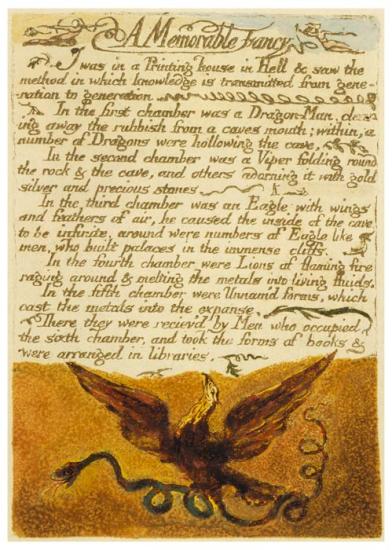
The Marriage of Heaven and Hell
[Lambeth, ca. 1794].
Relief and white line etching, with color printing and hand coloring
Copy F, printed ca. 1794
Gift of Mrs. Landon K. Thorne, 1973
William Blake (1757–1827) occupies a unique place in the history of Western art. His creativity included both the visual and literary arts. In his lifetime he was best known as an engraver; now he is also recognized for his innovative poetry, printmaking, and painting. Blake's keen perception of the political and social climate found expression throughout his work. His strong sense of independence is evident in the complex mythology that he constructed in response to the age of revolution.
Blake was already recognized as an engraver at age twenty-five, when his first volume of poems appeared. At thirty-three, in The Marriage of Heaven and Hell, he audaciously claimed that his birth had marked the origin of a "new heaven" in which his own art would exemplify the creativity prefigured by Milton and Michelangelo. By that time, Blake, in one of his most productive periods, had already produced Songs of Innocence and was at work on a series of illuminated books. In 1818 he met John Linnell, a young painter and engraver, through whom a group of young artists became Blake's followers. Calling themselves the Ancients, they helped perpetuate Blake's influence for generations.
The Morgan's Blake collection—one of this country's most distinguished—began with purchases as early as 1899 by Pierpont Morgan. During the tenure of Charles Ryskamp, director from 1969 to 1986, major gifts almost doubled the size of its Blake holdings. In recent years Ryskamp's own gifts of engravings, letters, and related materials have significantly enriched its scholarly resources.
This online exhibition is presented in conjunction with the exhibition William Blake's World: "A New Heaven Is Begun" on view September 11, 2009, through January 3, 2010.
This exhibition is made possible through the generosity of Fay and Geoffrey Elliott.
The Marriage of Heaven and Hell 16

The Marriage of Heaven and Hell
[Lambeth, ca. 1794].
Relief and white line etching, with color printing and hand coloring
Copy F, printed ca. 1794
Gift of Mrs. Landon K. Thorne, 1973
William Blake (1757–1827) occupies a unique place in the history of Western art. His creativity included both the visual and literary arts. In his lifetime he was best known as an engraver; now he is also recognized for his innovative poetry, printmaking, and painting. Blake's keen perception of the political and social climate found expression throughout his work. His strong sense of independence is evident in the complex mythology that he constructed in response to the age of revolution.
Blake was already recognized as an engraver at age twenty-five, when his first volume of poems appeared. At thirty-three, in The Marriage of Heaven and Hell, he audaciously claimed that his birth had marked the origin of a "new heaven" in which his own art would exemplify the creativity prefigured by Milton and Michelangelo. By that time, Blake, in one of his most productive periods, had already produced Songs of Innocence and was at work on a series of illuminated books. In 1818 he met John Linnell, a young painter and engraver, through whom a group of young artists became Blake's followers. Calling themselves the Ancients, they helped perpetuate Blake's influence for generations.
The Morgan's Blake collection—one of this country's most distinguished—began with purchases as early as 1899 by Pierpont Morgan. During the tenure of Charles Ryskamp, director from 1969 to 1986, major gifts almost doubled the size of its Blake holdings. In recent years Ryskamp's own gifts of engravings, letters, and related materials have significantly enriched its scholarly resources.
This online exhibition is presented in conjunction with the exhibition William Blake's World: "A New Heaven Is Begun" on view September 11, 2009, through January 3, 2010.
This exhibition is made possible through the generosity of Fay and Geoffrey Elliott.
The Marriage of Heaven and Hell 17
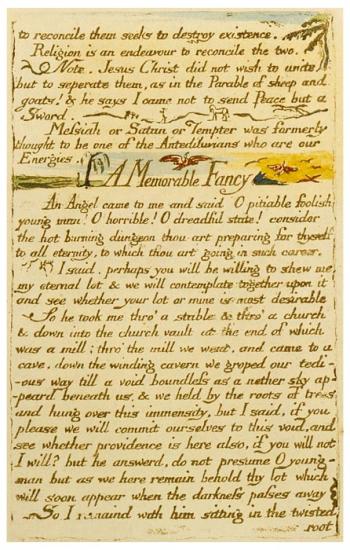
The Marriage of Heaven and Hell
[Lambeth, ca. 1794].
Relief and white line etching, with color printing and hand coloring
Copy F, printed ca. 1794
Gift of Mrs. Landon K. Thorne, 1973
William Blake (1757–1827) occupies a unique place in the history of Western art. His creativity included both the visual and literary arts. In his lifetime he was best known as an engraver; now he is also recognized for his innovative poetry, printmaking, and painting. Blake's keen perception of the political and social climate found expression throughout his work. His strong sense of independence is evident in the complex mythology that he constructed in response to the age of revolution.
Blake was already recognized as an engraver at age twenty-five, when his first volume of poems appeared. At thirty-three, in The Marriage of Heaven and Hell, he audaciously claimed that his birth had marked the origin of a "new heaven" in which his own art would exemplify the creativity prefigured by Milton and Michelangelo. By that time, Blake, in one of his most productive periods, had already produced Songs of Innocence and was at work on a series of illuminated books. In 1818 he met John Linnell, a young painter and engraver, through whom a group of young artists became Blake's followers. Calling themselves the Ancients, they helped perpetuate Blake's influence for generations.
The Morgan's Blake collection—one of this country's most distinguished—began with purchases as early as 1899 by Pierpont Morgan. During the tenure of Charles Ryskamp, director from 1969 to 1986, major gifts almost doubled the size of its Blake holdings. In recent years Ryskamp's own gifts of engravings, letters, and related materials have significantly enriched its scholarly resources.
This online exhibition is presented in conjunction with the exhibition William Blake's World: "A New Heaven Is Begun" on view September 11, 2009, through January 3, 2010.
This exhibition is made possible through the generosity of Fay and Geoffrey Elliott.
The Marriage of Heaven and Hell 18

The Marriage of Heaven and Hell
[Lambeth, ca. 1794].
Relief and white line etching, with color printing and hand coloring
Copy F, printed ca. 1794
Gift of Mrs. Landon K. Thorne, 1973
William Blake (1757–1827) occupies a unique place in the history of Western art. His creativity included both the visual and literary arts. In his lifetime he was best known as an engraver; now he is also recognized for his innovative poetry, printmaking, and painting. Blake's keen perception of the political and social climate found expression throughout his work. His strong sense of independence is evident in the complex mythology that he constructed in response to the age of revolution.
Blake was already recognized as an engraver at age twenty-five, when his first volume of poems appeared. At thirty-three, in The Marriage of Heaven and Hell, he audaciously claimed that his birth had marked the origin of a "new heaven" in which his own art would exemplify the creativity prefigured by Milton and Michelangelo. By that time, Blake, in one of his most productive periods, had already produced Songs of Innocence and was at work on a series of illuminated books. In 1818 he met John Linnell, a young painter and engraver, through whom a group of young artists became Blake's followers. Calling themselves the Ancients, they helped perpetuate Blake's influence for generations.
The Morgan's Blake collection—one of this country's most distinguished—began with purchases as early as 1899 by Pierpont Morgan. During the tenure of Charles Ryskamp, director from 1969 to 1986, major gifts almost doubled the size of its Blake holdings. In recent years Ryskamp's own gifts of engravings, letters, and related materials have significantly enriched its scholarly resources.
This online exhibition is presented in conjunction with the exhibition William Blake's World: "A New Heaven Is Begun" on view September 11, 2009, through January 3, 2010.
This exhibition is made possible through the generosity of Fay and Geoffrey Elliott.
The Marriage of Heaven and Hell 19

The Marriage of Heaven and Hell
[Lambeth, ca. 1794].
Relief and white line etching, with color printing and hand coloring
Copy F, printed ca. 1794
Gift of Mrs. Landon K. Thorne, 1973
William Blake (1757–1827) occupies a unique place in the history of Western art. His creativity included both the visual and literary arts. In his lifetime he was best known as an engraver; now he is also recognized for his innovative poetry, printmaking, and painting. Blake's keen perception of the political and social climate found expression throughout his work. His strong sense of independence is evident in the complex mythology that he constructed in response to the age of revolution.
Blake was already recognized as an engraver at age twenty-five, when his first volume of poems appeared. At thirty-three, in The Marriage of Heaven and Hell, he audaciously claimed that his birth had marked the origin of a "new heaven" in which his own art would exemplify the creativity prefigured by Milton and Michelangelo. By that time, Blake, in one of his most productive periods, had already produced Songs of Innocence and was at work on a series of illuminated books. In 1818 he met John Linnell, a young painter and engraver, through whom a group of young artists became Blake's followers. Calling themselves the Ancients, they helped perpetuate Blake's influence for generations.
The Morgan's Blake collection—one of this country's most distinguished—began with purchases as early as 1899 by Pierpont Morgan. During the tenure of Charles Ryskamp, director from 1969 to 1986, major gifts almost doubled the size of its Blake holdings. In recent years Ryskamp's own gifts of engravings, letters, and related materials have significantly enriched its scholarly resources.
This online exhibition is presented in conjunction with the exhibition William Blake's World: "A New Heaven Is Begun" on view September 11, 2009, through January 3, 2010.
This exhibition is made possible through the generosity of Fay and Geoffrey Elliott.
The Marriage of Heaven and Hell 20
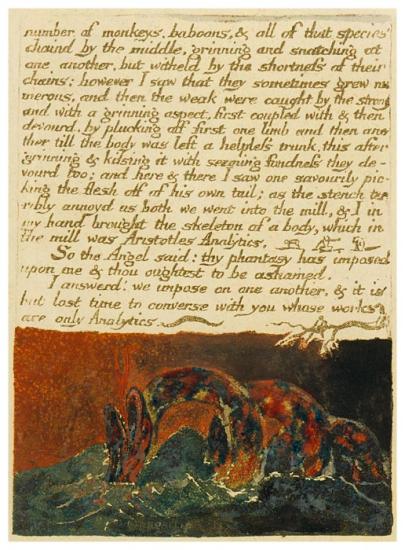
The Marriage of Heaven and Hell
[Lambeth, ca. 1794].
Relief and white line etching, with color printing and hand coloring
Copy F, printed ca. 1794
Gift of Mrs. Landon K. Thorne, 1973
William Blake (1757–1827) occupies a unique place in the history of Western art. His creativity included both the visual and literary arts. In his lifetime he was best known as an engraver; now he is also recognized for his innovative poetry, printmaking, and painting. Blake's keen perception of the political and social climate found expression throughout his work. His strong sense of independence is evident in the complex mythology that he constructed in response to the age of revolution.
Blake was already recognized as an engraver at age twenty-five, when his first volume of poems appeared. At thirty-three, in The Marriage of Heaven and Hell, he audaciously claimed that his birth had marked the origin of a "new heaven" in which his own art would exemplify the creativity prefigured by Milton and Michelangelo. By that time, Blake, in one of his most productive periods, had already produced Songs of Innocence and was at work on a series of illuminated books. In 1818 he met John Linnell, a young painter and engraver, through whom a group of young artists became Blake's followers. Calling themselves the Ancients, they helped perpetuate Blake's influence for generations.
The Morgan's Blake collection—one of this country's most distinguished—began with purchases as early as 1899 by Pierpont Morgan. During the tenure of Charles Ryskamp, director from 1969 to 1986, major gifts almost doubled the size of its Blake holdings. In recent years Ryskamp's own gifts of engravings, letters, and related materials have significantly enriched its scholarly resources.
This online exhibition is presented in conjunction with the exhibition William Blake's World: "A New Heaven Is Begun" on view September 11, 2009, through January 3, 2010.
This exhibition is made possible through the generosity of Fay and Geoffrey Elliott.
The Marriage of Heaven and Hell 21

The Marriage of Heaven and Hell
[Lambeth, ca. 1794].
Relief and white line etching, with color printing and hand coloring
Copy F, printed ca. 1794
Gift of Mrs. Landon K. Thorne, 1973
William Blake (1757–1827) occupies a unique place in the history of Western art. His creativity included both the visual and literary arts. In his lifetime he was best known as an engraver; now he is also recognized for his innovative poetry, printmaking, and painting. Blake's keen perception of the political and social climate found expression throughout his work. His strong sense of independence is evident in the complex mythology that he constructed in response to the age of revolution.
Blake was already recognized as an engraver at age twenty-five, when his first volume of poems appeared. At thirty-three, in The Marriage of Heaven and Hell, he audaciously claimed that his birth had marked the origin of a "new heaven" in which his own art would exemplify the creativity prefigured by Milton and Michelangelo. By that time, Blake, in one of his most productive periods, had already produced Songs of Innocence and was at work on a series of illuminated books. In 1818 he met John Linnell, a young painter and engraver, through whom a group of young artists became Blake's followers. Calling themselves the Ancients, they helped perpetuate Blake's influence for generations.
The Morgan's Blake collection—one of this country's most distinguished—began with purchases as early as 1899 by Pierpont Morgan. During the tenure of Charles Ryskamp, director from 1969 to 1986, major gifts almost doubled the size of its Blake holdings. In recent years Ryskamp's own gifts of engravings, letters, and related materials have significantly enriched its scholarly resources.
This online exhibition is presented in conjunction with the exhibition William Blake's World: "A New Heaven Is Begun" on view September 11, 2009, through January 3, 2010.
This exhibition is made possible through the generosity of Fay and Geoffrey Elliott.
The Marriage of Heaven and Hell 22
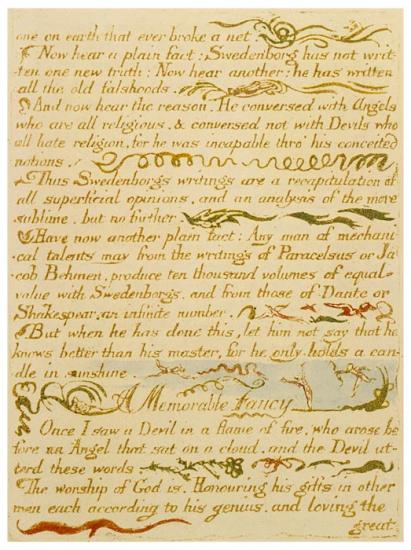
The Marriage of Heaven and Hell
[Lambeth, ca. 1794].
Relief and white line etching, with color printing and hand coloring
Copy F, printed ca. 1794
Gift of Mrs. Landon K. Thorne, 1973
William Blake (1757–1827) occupies a unique place in the history of Western art. His creativity included both the visual and literary arts. In his lifetime he was best known as an engraver; now he is also recognized for his innovative poetry, printmaking, and painting. Blake's keen perception of the political and social climate found expression throughout his work. His strong sense of independence is evident in the complex mythology that he constructed in response to the age of revolution.
Blake was already recognized as an engraver at age twenty-five, when his first volume of poems appeared. At thirty-three, in The Marriage of Heaven and Hell, he audaciously claimed that his birth had marked the origin of a "new heaven" in which his own art would exemplify the creativity prefigured by Milton and Michelangelo. By that time, Blake, in one of his most productive periods, had already produced Songs of Innocence and was at work on a series of illuminated books. In 1818 he met John Linnell, a young painter and engraver, through whom a group of young artists became Blake's followers. Calling themselves the Ancients, they helped perpetuate Blake's influence for generations.
The Morgan's Blake collection—one of this country's most distinguished—began with purchases as early as 1899 by Pierpont Morgan. During the tenure of Charles Ryskamp, director from 1969 to 1986, major gifts almost doubled the size of its Blake holdings. In recent years Ryskamp's own gifts of engravings, letters, and related materials have significantly enriched its scholarly resources.
This online exhibition is presented in conjunction with the exhibition William Blake's World: "A New Heaven Is Begun" on view September 11, 2009, through January 3, 2010.
This exhibition is made possible through the generosity of Fay and Geoffrey Elliott.
The Marriage of Heaven and Hell 23

The Marriage of Heaven and Hell
[Lambeth, ca. 1794].
Relief and white line etching, with color printing and hand coloring
Copy F, printed ca. 1794
Gift of Mrs. Landon K. Thorne, 1973
William Blake (1757–1827) occupies a unique place in the history of Western art. His creativity included both the visual and literary arts. In his lifetime he was best known as an engraver; now he is also recognized for his innovative poetry, printmaking, and painting. Blake's keen perception of the political and social climate found expression throughout his work. His strong sense of independence is evident in the complex mythology that he constructed in response to the age of revolution.
Blake was already recognized as an engraver at age twenty-five, when his first volume of poems appeared. At thirty-three, in The Marriage of Heaven and Hell, he audaciously claimed that his birth had marked the origin of a "new heaven" in which his own art would exemplify the creativity prefigured by Milton and Michelangelo. By that time, Blake, in one of his most productive periods, had already produced Songs of Innocence and was at work on a series of illuminated books. In 1818 he met John Linnell, a young painter and engraver, through whom a group of young artists became Blake's followers. Calling themselves the Ancients, they helped perpetuate Blake's influence for generations.
The Morgan's Blake collection—one of this country's most distinguished—began with purchases as early as 1899 by Pierpont Morgan. During the tenure of Charles Ryskamp, director from 1969 to 1986, major gifts almost doubled the size of its Blake holdings. In recent years Ryskamp's own gifts of engravings, letters, and related materials have significantly enriched its scholarly resources.
This online exhibition is presented in conjunction with the exhibition William Blake's World: "A New Heaven Is Begun" on view September 11, 2009, through January 3, 2010.
This exhibition is made possible through the generosity of Fay and Geoffrey Elliott.
The Marriage of Heaven and Hell 24

The Marriage of Heaven and Hell
[Lambeth, ca. 1794].
Relief and white line etching, with color printing and hand coloring
Copy F, printed ca. 1794
Gift of Mrs. Landon K. Thorne, 1973
William Blake (1757–1827) occupies a unique place in the history of Western art. His creativity included both the visual and literary arts. In his lifetime he was best known as an engraver; now he is also recognized for his innovative poetry, printmaking, and painting. Blake's keen perception of the political and social climate found expression throughout his work. His strong sense of independence is evident in the complex mythology that he constructed in response to the age of revolution.
Blake was already recognized as an engraver at age twenty-five, when his first volume of poems appeared. At thirty-three, in The Marriage of Heaven and Hell, he audaciously claimed that his birth had marked the origin of a "new heaven" in which his own art would exemplify the creativity prefigured by Milton and Michelangelo. By that time, Blake, in one of his most productive periods, had already produced Songs of Innocence and was at work on a series of illuminated books. In 1818 he met John Linnell, a young painter and engraver, through whom a group of young artists became Blake's followers. Calling themselves the Ancients, they helped perpetuate Blake's influence for generations.
The Morgan's Blake collection—one of this country's most distinguished—began with purchases as early as 1899 by Pierpont Morgan. During the tenure of Charles Ryskamp, director from 1969 to 1986, major gifts almost doubled the size of its Blake holdings. In recent years Ryskamp's own gifts of engravings, letters, and related materials have significantly enriched its scholarly resources.
This online exhibition is presented in conjunction with the exhibition William Blake's World: "A New Heaven Is Begun" on view September 11, 2009, through January 3, 2010.
This exhibition is made possible through the generosity of Fay and Geoffrey Elliott.
The Marriage of Heaven and Hell 25
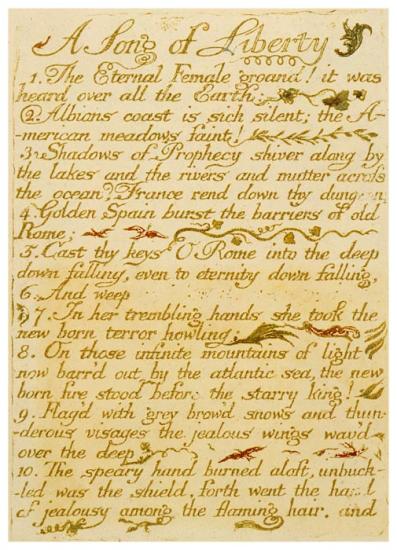
The Marriage of Heaven and Hell
[Lambeth, ca. 1794].
Relief and white line etching, with color printing and hand coloring
Copy F, printed ca. 1794
Gift of Mrs. Landon K. Thorne, 1973
William Blake (1757–1827) occupies a unique place in the history of Western art. His creativity included both the visual and literary arts. In his lifetime he was best known as an engraver; now he is also recognized for his innovative poetry, printmaking, and painting. Blake's keen perception of the political and social climate found expression throughout his work. His strong sense of independence is evident in the complex mythology that he constructed in response to the age of revolution.
Blake was already recognized as an engraver at age twenty-five, when his first volume of poems appeared. At thirty-three, in The Marriage of Heaven and Hell, he audaciously claimed that his birth had marked the origin of a "new heaven" in which his own art would exemplify the creativity prefigured by Milton and Michelangelo. By that time, Blake, in one of his most productive periods, had already produced Songs of Innocence and was at work on a series of illuminated books. In 1818 he met John Linnell, a young painter and engraver, through whom a group of young artists became Blake's followers. Calling themselves the Ancients, they helped perpetuate Blake's influence for generations.
The Morgan's Blake collection—one of this country's most distinguished—began with purchases as early as 1899 by Pierpont Morgan. During the tenure of Charles Ryskamp, director from 1969 to 1986, major gifts almost doubled the size of its Blake holdings. In recent years Ryskamp's own gifts of engravings, letters, and related materials have significantly enriched its scholarly resources.
This online exhibition is presented in conjunction with the exhibition William Blake's World: "A New Heaven Is Begun" on view September 11, 2009, through January 3, 2010.
This exhibition is made possible through the generosity of Fay and Geoffrey Elliott.
The Marriage of Heaven and Hell 26

The Marriage of Heaven and Hell
[Lambeth, ca. 1794].
Relief and white line etching, with color printing and hand coloring
Copy F, printed ca. 1794
Gift of Mrs. Landon K. Thorne, 1973
William Blake (1757–1827) occupies a unique place in the history of Western art. His creativity included both the visual and literary arts. In his lifetime he was best known as an engraver; now he is also recognized for his innovative poetry, printmaking, and painting. Blake's keen perception of the political and social climate found expression throughout his work. His strong sense of independence is evident in the complex mythology that he constructed in response to the age of revolution.
Blake was already recognized as an engraver at age twenty-five, when his first volume of poems appeared. At thirty-three, in The Marriage of Heaven and Hell, he audaciously claimed that his birth had marked the origin of a "new heaven" in which his own art would exemplify the creativity prefigured by Milton and Michelangelo. By that time, Blake, in one of his most productive periods, had already produced Songs of Innocence and was at work on a series of illuminated books. In 1818 he met John Linnell, a young painter and engraver, through whom a group of young artists became Blake's followers. Calling themselves the Ancients, they helped perpetuate Blake's influence for generations.
The Morgan's Blake collection—one of this country's most distinguished—began with purchases as early as 1899 by Pierpont Morgan. During the tenure of Charles Ryskamp, director from 1969 to 1986, major gifts almost doubled the size of its Blake holdings. In recent years Ryskamp's own gifts of engravings, letters, and related materials have significantly enriched its scholarly resources.
This online exhibition is presented in conjunction with the exhibition William Blake's World: "A New Heaven Is Begun" on view September 11, 2009, through January 3, 2010.
This exhibition is made possible through the generosity of Fay and Geoffrey Elliott.
The Marriage of Heaven and Hell 27

The Marriage of Heaven and Hell
[Lambeth, ca. 1794].
Relief and white line etching, with color printing and hand coloring
Copy F, printed ca. 1794
Gift of Mrs. Landon K. Thorne, 1973
William Blake (1757–1827) occupies a unique place in the history of Western art. His creativity included both the visual and literary arts. In his lifetime he was best known as an engraver; now he is also recognized for his innovative poetry, printmaking, and painting. Blake's keen perception of the political and social climate found expression throughout his work. His strong sense of independence is evident in the complex mythology that he constructed in response to the age of revolution.
Blake was already recognized as an engraver at age twenty-five, when his first volume of poems appeared. At thirty-three, in The Marriage of Heaven and Hell, he audaciously claimed that his birth had marked the origin of a "new heaven" in which his own art would exemplify the creativity prefigured by Milton and Michelangelo. By that time, Blake, in one of his most productive periods, had already produced Songs of Innocence and was at work on a series of illuminated books. In 1818 he met John Linnell, a young painter and engraver, through whom a group of young artists became Blake's followers. Calling themselves the Ancients, they helped perpetuate Blake's influence for generations.
The Morgan's Blake collection—one of this country's most distinguished—began with purchases as early as 1899 by Pierpont Morgan. During the tenure of Charles Ryskamp, director from 1969 to 1986, major gifts almost doubled the size of its Blake holdings. In recent years Ryskamp's own gifts of engravings, letters, and related materials have significantly enriched its scholarly resources.
This online exhibition is presented in conjunction with the exhibition William Blake's World: "A New Heaven Is Begun" on view September 11, 2009, through January 3, 2010.
This exhibition is made possible through the generosity of Fay and Geoffrey Elliott.
The Pickering Manuscript
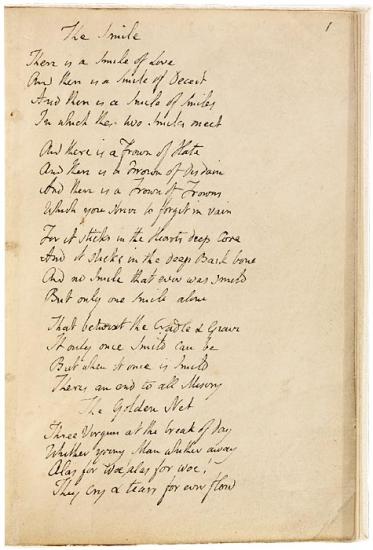
The Pickering Manuscript
[Autograph fair copy].
Gift of Mrs. Landon K. Thorne, 1971
This volume of ten poems in Blake's hand is the unique source for seven of his poetic works, including "Auguries of Innocence."
A dog starved at his master's gate
Predicts the ruin of the state.
The manuscript is named for a previous owner, B. M. Pickering, who acquired it in 1866 and published it for the first time that year. The poems probably date from about 1801 to 1804. As a "fair copy," it shows that Blake had copied all of the poems into a neat form with few corrections. Based on its paper stock and internal references, the manuscript has been dated to about 1807.
William Blake (1757–1827) occupies a unique place in the history of Western art. His creativity included both the visual and literary arts. In his lifetime he was best known as an engraver; now he is also recognized for his innovative poetry, printmaking, and painting. Blake's keen perception of the political and social climate found expression throughout his work. His strong sense of independence is evident in the complex mythology that he constructed in response to the age of revolution.
Blake was already recognized as an engraver at age twenty-five, when his first volume of poems appeared. At thirty-three, in The Marriage of Heaven and Hell, he audaciously claimed that his birth had marked the origin of a "new heaven" in which his own art would exemplify the creativity prefigured by Milton and Michelangelo. By that time, Blake, in one of his most productive periods, had already produced Songs of Innocence and was at work on a series of illuminated books. In 1818 he met John Linnell, a young painter and engraver, through whom a group of young artists became Blake's followers. Calling themselves the Ancients, they helped perpetuate Blake's influence for generations.
The Morgan's Blake collection—one of this country's most distinguished—began with purchases as early as 1899 by Pierpont Morgan. During the tenure of Charles Ryskamp, director from 1969 to 1986, major gifts almost doubled the size of its Blake holdings. In recent years Ryskamp's own gifts of engravings, letters, and related materials have significantly enriched its scholarly resources.
The Smile
There is a Smile of Love
And there is a Smile of Deceit
And there is a Smile of Smiles
In which these two Smiles meet
And there is a Frown of Hate
And there is a Frown of Disdain
And there is a Frown of Frowns
Which you strive to forget in vain
For it sticks in the Hearts deep Core
And it sticks in the deep Back bone
And no Smile that ever was smild
But only one Smile alone
That betwixt the Cradle & Grave
It only once Smild can be
But when it once is Smild
Theres an end to all Misery
The Golden Net
Three Virgins at the break of day
Whither young Man whither away
Alas for woe! alas for woe!
They cry & tears for ever flow
This online exhibition is presented in conjunction with the exhibition William Blake's World: "A New Heaven Is Begun" on view September 11, 2009, through January 3, 2010.
This exhibition is made possible through the generosity of Fay and Geoffrey Elliott.
The Pickering Manuscript 2
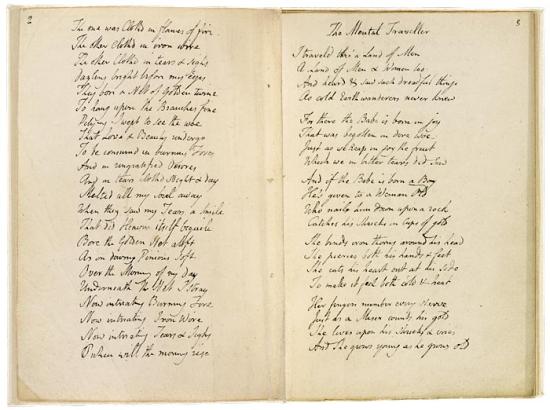
The Pickering Manuscript
[Autograph fair copy].
Gift of Mrs. Landon K. Thorne, 1971
This volume of ten poems in Blake's hand is the unique source for seven of his poetic works, including "Auguries of Innocence."
A dog starved at his master's gate
Predicts the ruin of the state.
The manuscript is named for a previous owner, B. M. Pickering, who acquired it in 1866 and published it for the first time that year. The poems probably date from about 1801 to 1804. As a "fair copy," it shows that Blake had copied all of the poems into a neat form with few corrections. Based on its paper stock and internal references, the manuscript has been dated to about 1807.
William Blake (1757–1827) occupies a unique place in the history of Western art. His creativity included both the visual and literary arts. In his lifetime he was best known as an engraver; now he is also recognized for his innovative poetry, printmaking, and painting. Blake's keen perception of the political and social climate found expression throughout his work. His strong sense of independence is evident in the complex mythology that he constructed in response to the age of revolution.
Blake was already recognized as an engraver at age twenty-five, when his first volume of poems appeared. At thirty-three, in The Marriage of Heaven and Hell, he audaciously claimed that his birth had marked the origin of a "new heaven" in which his own art would exemplify the creativity prefigured by Milton and Michelangelo. By that time, Blake, in one of his most productive periods, had already produced Songs of Innocence and was at work on a series of illuminated books. In 1818 he met John Linnell, a young painter and engraver, through whom a group of young artists became Blake's followers. Calling themselves the Ancients, they helped perpetuate Blake's influence for generations.
The Morgan's Blake collection—one of this country's most distinguished—began with purchases as early as 1899 by Pierpont Morgan. During the tenure of Charles Ryskamp, director from 1969 to 1986, major gifts almost doubled the size of its Blake holdings. In recent years Ryskamp's own gifts of engravings, letters, and related materials have significantly enriched its scholarly resources.
The one was Clothd in flames of fire
The other Clothd in iron wire
The other Clothd in tears & sighs
Dazling bright before my Eyes
They bore a Net of Golden twine
To hang upon the Branches fine
Pitying I wept to see the woe
That Love & Beauty undergo
To be consumd in burning Fires
And in ungratified Desires
And in tears clothd Night & day
Melted all my Soul away
When they saw my Tears a Smile
That did Heaven itself beguile
Bore the Golden Net aloft
As on downy Pinions soft
Over the Morning of my Day
Underneath the Net I stray
Now intreating Burning Fire
Now intreating Iron Wire
Now intreating Tears & Sighs
O when will the morning rise
The Mental Traveller
I traveld thro' a Land of Men
A Land of Men & Women too
And heard & saw such dreadful things
As cold Earth wanderers never knew
For there the Babe is born in joy
That was begotten in dire woe
Just as we Reap in joy the fruit
Which we in bitter tears did sow
And if the Babe is born a Boy
He's given to a Woman Old
Who nails him down upon a rock
Catches his Shrieks in Cups of gold
She binds iron thorns around his head
She pierces both his hands & feet
She cuts his heart out at his side
To make it feel both cold & heat
Her fingers number every Nerve
just as a Miser counts his gold
She lives upon his shrieks & cries
And She grows young as he grows old
This online exhibition is presented in conjunction with the exhibition William Blake's World: "A New Heaven Is Begun" on view September 11, 2009, through January 3, 2010.
This exhibition is made possible through the generosity of Fay and Geoffrey Elliott.
The Pickering Manuscript 3

The Pickering Manuscript
[Autograph fair copy].
Gift of Mrs. Landon K. Thorne, 1971
This volume of ten poems in Blake's hand is the unique source for seven of his poetic works, including "Auguries of Innocence."
A dog starved at his master's gate
Predicts the ruin of the state.
The manuscript is named for a previous owner, B. M. Pickering, who acquired it in 1866 and published it for the first time that year. The poems probably date from about 1801 to 1804. As a "fair copy," it shows that Blake had copied all of the poems into a neat form with few corrections. Based on its paper stock and internal references, the manuscript has been dated to about 1807.
William Blake (1757–1827) occupies a unique place in the history of Western art. His creativity included both the visual and literary arts. In his lifetime he was best known as an engraver; now he is also recognized for his innovative poetry, printmaking, and painting. Blake's keen perception of the political and social climate found expression throughout his work. His strong sense of independence is evident in the complex mythology that he constructed in response to the age of revolution.
Blake was already recognized as an engraver at age twenty-five, when his first volume of poems appeared. At thirty-three, in The Marriage of Heaven and Hell, he audaciously claimed that his birth had marked the origin of a "new heaven" in which his own art would exemplify the creativity prefigured by Milton and Michelangelo. By that time, Blake, in one of his most productive periods, had already produced Songs of Innocence and was at work on a series of illuminated books. In 1818 he met John Linnell, a young painter and engraver, through whom a group of young artists became Blake's followers. Calling themselves the Ancients, they helped perpetuate Blake's influence for generations.
The Morgan's Blake collection—one of this country's most distinguished—began with purchases as early as 1899 by Pierpont Morgan. During the tenure of Charles Ryskamp, director from 1969 to 1986, major gifts almost doubled the size of its Blake holdings. In recent years Ryskamp's own gifts of engravings, letters, and related materials have significantly enriched its scholarly resources.
Till he becomes a bleeding youth
And she becomes a Virgin bright
Then he rends up his Manacles
And binds her down for his delight
He plants himself in all her Nerves
Just as a Husbandman his mould
And She becomes his dwelling place
And Garden fruitful Seventy fold
An aged Shadow soon he fades
Wandring round an Earthly Cot
Full filled all with gems & gold
Which he by industry had got
And these are the gems of the Human Soul
The rubies & pearls of a lovesick eye
The countless gold of the akeing heart
The martyrs groan & the lovers sigh
They are his meat they are his drink
He feeds the Beggar & the Poor
And the way faring Traveller
For ever open is his door
His grief is their eternal joy
They make the roofs & walls to ring
Till from the fire on the hearth
A little Female Babe does spring
And she is all of solid fire
And gems & gold that none his hand
Dares stretch to touch her Baby form
Or wrap her in his swaddling-band
But She comes to the Man she loves
If young or old or rich or poor
They soon drive out the aged Host
A Begger at anothers door
He wanders weeping far away
Untill some other take him in
Oft blind & age-bent sore distrest
Untill he can a Maiden win
And to Allay his freezing Age
The Poor Man takes her in his arms
The Cottage fades before his Sight
The Garden & its lovely Charms
The Guests are scatterd thro' the land
For the Eye altering alters all
The Senses roll themselves in fear
And the flat Earth becomes a Ball
The Stars Sun Moon all shrink away
A desart vast without a bound
And nothing left to eat or drink
And a dark desart all around
This online exhibition is presented in conjunction with the exhibition William Blake's World: "A New Heaven Is Begun" on view September 11, 2009, through January 3, 2010.
This exhibition is made possible through the generosity of Fay and Geoffrey Elliott.
The Pickering Manuscript 4
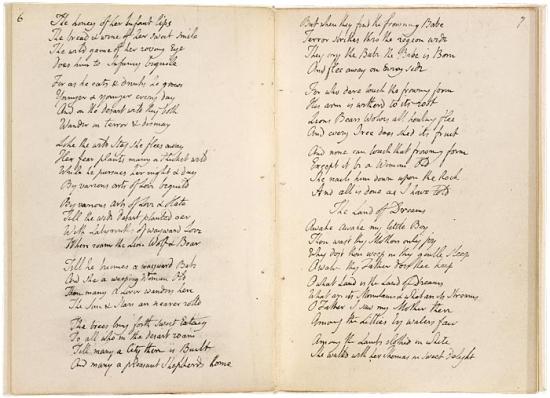
The Pickering Manuscript
[Autograph fair copy].
Gift of Mrs. Landon K. Thorne, 1971
This volume of ten poems in Blake's hand is the unique source for seven of his poetic works, including "Auguries of Innocence."
A dog starved at his master's gate
Predicts the ruin of the state.
The manuscript is named for a previous owner, B. M. Pickering, who acquired it in 1866 and published it for the first time that year. The poems probably date from about 1801 to 1804. As a "fair copy," it shows that Blake had copied all of the poems into a neat form with few corrections. Based on its paper stock and internal references, the manuscript has been dated to about 1807.
William Blake (1757–1827) occupies a unique place in the history of Western art. His creativity included both the visual and literary arts. In his lifetime he was best known as an engraver; now he is also recognized for his innovative poetry, printmaking, and painting. Blake's keen perception of the political and social climate found expression throughout his work. His strong sense of independence is evident in the complex mythology that he constructed in response to the age of revolution.
Blake was already recognized as an engraver at age twenty-five, when his first volume of poems appeared. At thirty-three, in The Marriage of Heaven and Hell, he audaciously claimed that his birth had marked the origin of a "new heaven" in which his own art would exemplify the creativity prefigured by Milton and Michelangelo. By that time, Blake, in one of his most productive periods, had already produced Songs of Innocence and was at work on a series of illuminated books. In 1818 he met John Linnell, a young painter and engraver, through whom a group of young artists became Blake's followers. Calling themselves the Ancients, they helped perpetuate Blake's influence for generations.
The Morgan's Blake collection—one of this country's most distinguished—began with purchases as early as 1899 by Pierpont Morgan. During the tenure of Charles Ryskamp, director from 1969 to 1986, major gifts almost doubled the size of its Blake holdings. In recent years Ryskamp's own gifts of engravings, letters, and related materials have significantly enriched its scholarly resources.
The honey of her Infant lips
The bread & wine of her sweet smile
The wild game of her roving Eye
Does him to Infancy beguile
For as he eats & drinks he grows
Younger & younger every day
And on the desart wild they both
Wander in terror & dismay
Like the wild Stag she flees away
Her fear plants many a thicket wild
While he pursues her night & day
By various arts of Love beguild
By various arts of Love & Hate
Till the wide desart planted oer
With Labyrinths of wayward Love
Where roams the Lion Wolf & Boar
Till he becomes a wayward Babe
And she a weeping Woman Old
Then many a Lover wanders here
The Sun & Stars are nearer rolld
The trees bring forth sweet Extacy
To all who in the desart roam
Till many a City there is Built
And many a pleasant Shepherds home
But when they find the frowning Babe
Terror strikes thro the region wide
They cry the Babe the Babe is Born
And flee away on Every side
For who dare touch the frowning form
His arm is witherd to its root
Lions Boars Wolves all howling flee
And every Tree does shed its fruit
And none can touch that frowning form
Except it be a Woman Old
She nails him down upon the Rock
And all is done as I have told
The Land of Dreams
Awake awake my little Boy
Thou wast thy Mothers only joy
Why dost thou weep in thy gentle sleep
Awake thy Father does thee keep
O what Land is the Land of Dreams
What are its Mountains & what are its Streams
O Father I saw my Mother there
Among the Lillies by waters fair
Among the Lambs clothed in white
She walkd with her Thomas in sweet delight
This online exhibition is presented in conjunction with the exhibition William Blake's World: "A New Heaven Is Begun" on view September 11, 2009, through January 3, 2010.
This exhibition is made possible through the generosity of Fay and Geoffrey Elliott.
The Pickering Manuscript 5
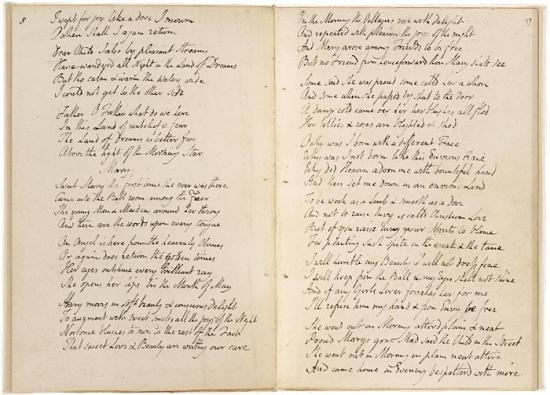
The Pickering Manuscript
[Autograph fair copy].
Gift of Mrs. Landon K. Thorne, 1971
This volume of ten poems in Blake's hand is the unique source for seven of his poetic works, including "Auguries of Innocence."
A dog starved at his master's gate
Predicts the ruin of the state.
The manuscript is named for a previous owner, B. M. Pickering, who acquired it in 1866 and published it for the first time that year. The poems probably date from about 1801 to 1804. As a "fair copy," it shows that Blake had copied all of the poems into a neat form with few corrections. Based on its paper stock and internal references, the manuscript has been dated to about 1807.
William Blake (1757–1827) occupies a unique place in the history of Western art. His creativity included both the visual and literary arts. In his lifetime he was best known as an engraver; now he is also recognized for his innovative poetry, printmaking, and painting. Blake's keen perception of the political and social climate found expression throughout his work. His strong sense of independence is evident in the complex mythology that he constructed in response to the age of revolution.
Blake was already recognized as an engraver at age twenty-five, when his first volume of poems appeared. At thirty-three, in The Marriage of Heaven and Hell, he audaciously claimed that his birth had marked the origin of a "new heaven" in which his own art would exemplify the creativity prefigured by Milton and Michelangelo. By that time, Blake, in one of his most productive periods, had already produced Songs of Innocence and was at work on a series of illuminated books. In 1818 he met John Linnell, a young painter and engraver, through whom a group of young artists became Blake's followers. Calling themselves the Ancients, they helped perpetuate Blake's influence for generations.
The Morgan's Blake collection—one of this country's most distinguished—began with purchases as early as 1899 by Pierpont Morgan. During the tenure of Charles Ryskamp, director from 1969 to 1986, major gifts almost doubled the size of its Blake holdings. In recent years Ryskamp's own gifts of engravings, letters, and related materials have significantly enriched its scholarly resources.
I wept for joy like a dove I mourn
O when shall I again return
Dear Child I also by pleasant Streams
Have wanderd all Night in the Land of Dreams
But tho calm & warm the Waters wide
1 could not get to the other side
Father O Father what do we here
In this Land of unbelief & fear
The Land of Dreams is better far
Above the light of the Morning Star
Mary
Sweet Mary the first time she ever was there
Came into the Ball room among the Fair
The young Men & Maidens around her throng
And these are the words upon every tongue
An Angel is here from the heavenly Climes
Or again does return the Golden times t1237
Her eyes outshine every brilliant ray
She opens her lips tis the Month of May
Mary moves in soft beauty & conscious delight
To augment with sweet smiles all the joys of the Night
Nor once blushes to own to the rest of the Fair
That sweet Love & Beauty are worthy our care
In the Morning the Villagers rose with delight
And repeated with pleasure the joys of the night
And Mary arose among Friends to be free
But no Friend from henceforward thou Mary shalt see
Some said she was proud some calld her a whore
And some when she passed by shut to the door
A damp cold came oer her her blushes all fled
Her lillies & roses are blighted & shed
O why was I born with a different Face
Why was I not born like this Envious Race
Why did Heaven adorn me with bountiful hand
And then set me down in an envious Land
To be weak as a Lamb & smooth as a Dove
And not to raise Envy is calld Christian Love
But if you raise Envy your Merits to blame
For planting such spite in the weak & the tame
I will humble my Beauty I will not dress fine
I will keep from the Ball & my Eyes shall not shine
And if any Girls Lover forsakes her for me
I'll refuse him my hand & from Envy be free
She went out in Morning attird plain & neat
Proud Marys gone Mad said the Child in the Street
She went out in Morning in plain neat attire
And came home in Evening bespatterd with mire
This online exhibition is presented in conjunction with the exhibition William Blake's World: "A New Heaven Is Begun" on view September 11, 2009, through January 3, 2010.
This exhibition is made possible through the generosity of Fay and Geoffrey Elliott.
The Pickering Manuscript 6
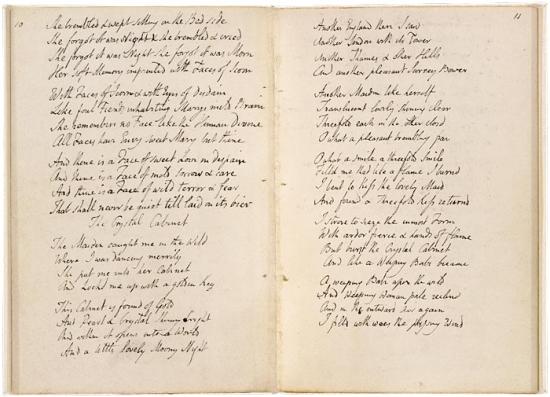
The Pickering Manuscript
[Autograph fair copy].
Gift of Mrs. Landon K. Thorne, 1971
This volume of ten poems in Blake's hand is the unique source for seven of his poetic works, including "Auguries of Innocence."
A dog starved at his master's gate
Predicts the ruin of the state.
The manuscript is named for a previous owner, B. M. Pickering, who acquired it in 1866 and published it for the first time that year. The poems probably date from about 1801 to 1804. As a "fair copy," it shows that Blake had copied all of the poems into a neat form with few corrections. Based on its paper stock and internal references, the manuscript has been dated to about 1807.
William Blake (1757–1827) occupies a unique place in the history of Western art. His creativity included both the visual and literary arts. In his lifetime he was best known as an engraver; now he is also recognized for his innovative poetry, printmaking, and painting. Blake's keen perception of the political and social climate found expression throughout his work. His strong sense of independence is evident in the complex mythology that he constructed in response to the age of revolution.
Blake was already recognized as an engraver at age twenty-five, when his first volume of poems appeared. At thirty-three, in The Marriage of Heaven and Hell, he audaciously claimed that his birth had marked the origin of a "new heaven" in which his own art would exemplify the creativity prefigured by Milton and Michelangelo. By that time, Blake, in one of his most productive periods, had already produced Songs of Innocence and was at work on a series of illuminated books. In 1818 he met John Linnell, a young painter and engraver, through whom a group of young artists became Blake's followers. Calling themselves the Ancients, they helped perpetuate Blake's influence for generations.
The Morgan's Blake collection—one of this country's most distinguished—began with purchases as early as 1899 by Pierpont Morgan. During the tenure of Charles Ryskamp, director from 1969 to 1986, major gifts almost doubled the size of its Blake holdings. In recent years Ryskamp's own gifts of engravings, letters, and related materials have significantly enriched its scholarly resources.
She trembled & wept sitting on the Bed side
She forgot it was Night & she trembled & cried
She forgot it was Night she forgot it was Morn
Her soft Memory imprinted with Faces of Scorn
With Faces of Scorn & with Eyes of disdain
Like foul Fiends inhabiting Marys mild Brain
She remembers no Face like the Human Divine
All Faces have Envy sweet Mary but thine
And thine is a Face of sweet Love in Despair
And thine is a Face of mild sorrow & care
And thine is a Face of wild terror & fear
That shall never be quiet till laid on its bier
The Crystal Cabinet
The Maiden caught me in the Wild
Where I was dancing merrily
She put me into her Cabinet
And Lockd me up with a golden Key
This Cabinet is formd of Gold
And Pearl & Crystal shining bright
And within it opens into a World
And a little lovely Moony Night
Another England there I saw
Another London with its Tower
Another Thames & other Hills
And another pleasant Surrey Bower
Another Maiden like herself
Translucent lovely shining clear
Threefold each in the other closd
O what a pleasant trembling fear
O what a smile a threefold Smile
Filld me that like a flame I burnd
I bent to Kiss the lovely Maid
And found a Threefold Kiss returnd
I strove to sieze the inmost Form
With ardor fierce & hands of flame
But burst the Crystal Cabinet
And like a Weeping Babe became
A weeping Babe upon the wild
And Weeping Woman pale reclind
And in the outward air again
I filld with woes the passing Wind
This online exhibition is presented in conjunction with the exhibition William Blake's World: "A New Heaven Is Begun" on view September 11, 2009, through January 3, 2010.
This exhibition is made possible through the generosity of Fay and Geoffrey Elliott.
The Pickering Manuscript 7
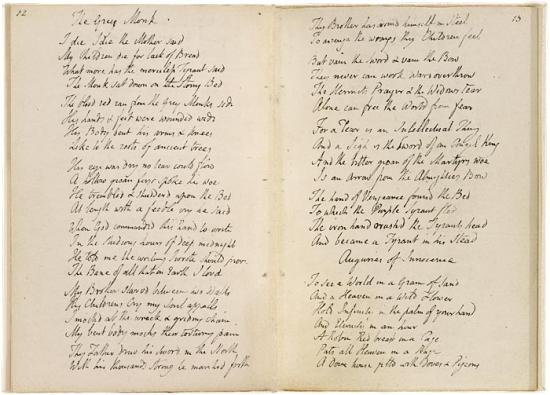
The Pickering Manuscript
[Autograph fair copy].
Gift of Mrs. Landon K. Thorne, 1971
To see a World in a Grain of Sand
And a Heaven in a Wild Flower
Hold Infinity in the palm of your hand
And Eternity in an hour
This volume of ten poems in Blake's hand is the unique source for seven of his poetic works, including "Auguries of Innocence." Some of its other lines illustrate the relationship between public and private acts that destroy the innocence of nature, for example:
A dog starved at his master's gate
Predicts the ruin of the state.
The manuscript is named for a previous owner, B. M. Pickering, who acquired it in 1866 and published it for the first time that year. The poems probably date from about 1801 to 1804. As a "fair copy," it shows that Blake had copied all of the poems into a neat form with few corrections. Based on its paper stock and internal references, the manuscript has been dated to about 1807.
William Blake (1757–1827) occupies a unique place in the history of Western art. His creativity included both the visual and literary arts. In his lifetime he was best known as an engraver; now he is also recognized for his innovative poetry, printmaking, and painting. Blake's keen perception of the political and social climate found expression throughout his work. His strong sense of independence is evident in the complex mythology that he constructed in response to the age of revolution.
Blake was already recognized as an engraver at age twenty-five, when his first volume of poems appeared. At thirty-three, in The Marriage of Heaven and Hell, he audaciously claimed that his birth had marked the origin of a "new heaven" in which his own art would exemplify the creativity prefigured by Milton and Michelangelo. By that time, Blake, in one of his most productive periods, had already produced Songs of Innocence and was at work on a series of illuminated books. In 1818 he met John Linnell, a young painter and engraver, through whom a group of young artists became Blake's followers. Calling themselves the Ancients, they helped perpetuate Blake's influence for generations.
The Morgan's Blake collection—one of this country's most distinguished—began with purchases as early as 1899 by Pierpont Morgan. During the tenure of Charles Ryskamp, director from 1969 to 1986, major gifts almost doubled the size of its Blake holdings. In recent years Ryskamp's own gifts of engravings, letters, and related materials have significantly enriched its scholarly resources.
The blood red ran from the Grey Monks side
His hands & feet were wounded wide
His Body bent his arms & knees
Like to the roots of ancient trees
His eye was dry no tear could flow
A hollow groan first spoke his woe
He trembled & shudderd upon the Bed
At length with a feeble cry he said
When God commanded this hand to write
In the studious hours of deep midnight
He told me the writing I wrote should prove
The Bane of all that on Earth I lovd
My Brother starvd between two Walls
His Childrens Cry my Soul appalls
I mockd at the wrack & griding chain
My bent body mocks their torturing pain
Thy Father drew his sword in the North
With his thousands strong he marched forth
Thy Brother has armd himself in Steel
To avenge the wrongs thy Children feel
But vain the Sword & vain the Bow
They never can work Wars overthrow
The Hermits Prayer & the Widows tear
Alone can free the World from fear
For a Tear is an Intellectual Thing
And a Sigh is the Sword of an Angel King
And the bitter groan of the Martyrs woe
Is an Arrow from the Almighties Bow
The hand of Vengeance found the Bed
To which the Purple Tyrant fled
The iron hand crushd the Tyrants head
And became a Tyrant in his stead
Auguries of Innocence
To see a World in a Grain of Sand
And a Heaven in a Wild Flower
Hold Infinity in the palm of your hand
And Eternity in an hour
A Robin Red breast in a Cage
Puts all Heaven in a Rage
A Dove house filld with doves & Pigeons
This online exhibition is presented in conjunction with the exhibition William Blake's World: "A New Heaven Is Begun" on view September 11, 2009, through January 3, 2010.
This exhibition is made possible through the generosity of Fay and Geoffrey Elliott.
The Pickering Manuscript 8
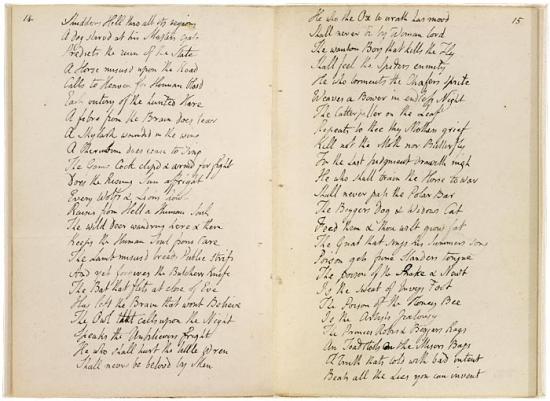
The Pickering Manuscript
[Autograph fair copy].
Gift of Mrs. Landon K. Thorne, 1971
This volume of ten poems in Blake's hand is the unique source for seven of his poetic works, including "Auguries of Innocence."
A dog starved at his master's gate
Predicts the ruin of the state.
The manuscript is named for a previous owner, B. M. Pickering, who acquired it in 1866 and published it for the first time that year. The poems probably date from about 1801 to 1804. As a "fair copy," it shows that Blake had copied all of the poems into a neat form with few corrections. Based on its paper stock and internal references, the manuscript has been dated to about 1807.
William Blake (1757–1827) occupies a unique place in the history of Western art. His creativity included both the visual and literary arts. In his lifetime he was best known as an engraver; now he is also recognized for his innovative poetry, printmaking, and painting. Blake's keen perception of the political and social climate found expression throughout his work. His strong sense of independence is evident in the complex mythology that he constructed in response to the age of revolution.
Blake was already recognized as an engraver at age twenty-five, when his first volume of poems appeared. At thirty-three, in The Marriage of Heaven and Hell, he audaciously claimed that his birth had marked the origin of a "new heaven" in which his own art would exemplify the creativity prefigured by Milton and Michelangelo. By that time, Blake, in one of his most productive periods, had already produced Songs of Innocence and was at work on a series of illuminated books. In 1818 he met John Linnell, a young painter and engraver, through whom a group of young artists became Blake's followers. Calling themselves the Ancients, they helped perpetuate Blake's influence for generations.
The Morgan's Blake collection—one of this country's most distinguished—began with purchases as early as 1899 by Pierpont Morgan. During the tenure of Charles Ryskamp, director from 1969 to 1986, major gifts almost doubled the size of its Blake holdings. In recent years Ryskamp's own gifts of engravings, letters, and related materials have significantly enriched its scholarly resources.
Shudders Hell thro all its regions
A dog starvd at his Masters Gate
Predicts the ruin of the State
A Horse misusd upon the Road
Calls to Heaven for Human blood
Each outcry of the hunted Hare
A fibre from the Brain does tear
A Skylark wounded in the wing
A Cherubim does cease to sing
The Game Cock clipd & armd for fight
Does the Rising Sun affright
Every Wolfs & Lions howl
Raises from Hell a Human Soul
The wild deer wandring here & there
Keeps the Human Soul from Care
The Lamb misusd breeds Public strife
And yet forgives the Butchers Knife
The Bat that flits at close of Eve
Has left the Brain that wont Believe
The Owl that calls upon the Night
Speaks the Unbelievers fright
He who shall hurt the little Wren
Shall never be belovd by Men
He who the Ox to wrath has movd
Shall never be by Woman lovd
The wanton Boy that kills the Fly
Shall feel the Spiders enmity
He who torments the Chafers sprite
Weaves a Bower in endless Night
The Catterpiller on the Leaf
Repeats to thee thy Mothers grief
Kill not the Moth nor Butterfly
For the Last judgment draweth nigh
He who shall train the Horse to War
Shall never pass the Polar Bar
The Beggers Dog & Widows Cat
Feed them & thou wilt grow fat
The Gnat that sings his Summers song
Poison gets from Slanders tongue
The poison of the Snake & Newt
Is the sweat of Envys Foot
The Poison of the Honey Bee
Is the Artists jealousy
The Princes Robes & Beggars Rags
Are Toadstools on the Misers Bags
A truth thats told with bad intent
Beats all the Lies you can invent
This online exhibition is presented in conjunction with the exhibition William Blake's World: "A New Heaven Is Begun" on view September 11, 2009, through January 3, 2010.
This exhibition is made possible through the generosity of Fay and Geoffrey Elliott.
The Pickering Manuscript 9
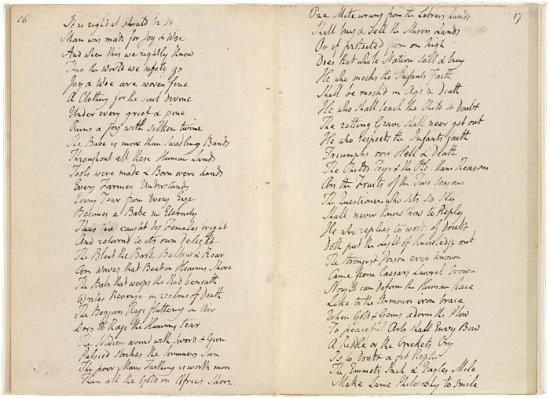
The Pickering Manuscript
[Autograph fair copy].
Gift of Mrs. Landon K. Thorne, 1971
This volume of ten poems in Blake's hand is the unique source for seven of his poetic works, including "Auguries of Innocence."
A dog starved at his master's gate
Predicts the ruin of the state.
The manuscript is named for a previous owner, B. M. Pickering, who acquired it in 1866 and published it for the first time that year. The poems probably date from about 1801 to 1804. As a "fair copy," it shows that Blake had copied all of the poems into a neat form with few corrections. Based on its paper stock and internal references, the manuscript has been dated to about 1807.
William Blake (1757–1827) occupies a unique place in the history of Western art. His creativity included both the visual and literary arts. In his lifetime he was best known as an engraver; now he is also recognized for his innovative poetry, printmaking, and painting. Blake's keen perception of the political and social climate found expression throughout his work. His strong sense of independence is evident in the complex mythology that he constructed in response to the age of revolution.
Blake was already recognized as an engraver at age twenty-five, when his first volume of poems appeared. At thirty-three, in The Marriage of Heaven and Hell, he audaciously claimed that his birth had marked the origin of a "new heaven" in which his own art would exemplify the creativity prefigured by Milton and Michelangelo. By that time, Blake, in one of his most productive periods, had already produced Songs of Innocence and was at work on a series of illuminated books. In 1818 he met John Linnell, a young painter and engraver, through whom a group of young artists became Blake's followers. Calling themselves the Ancients, they helped perpetuate Blake's influence for generations.
The Morgan's Blake collection—one of this country's most distinguished—began with purchases as early as 1899 by Pierpont Morgan. During the tenure of Charles Ryskamp, director from 1969 to 1986, major gifts almost doubled the size of its Blake holdings. In recent years Ryskamp's own gifts of engravings, letters, and related materials have significantly enriched its scholarly resources.
It is right it should be so
Man was made for Joy & Woe
And when this we rightly know
Thro the World we safely go
Joy & Woe are woven fine
A Clothing for the soul divine
Under every grief & pine
Runs a joy with silken twine
The Babe is more than swadling Bands
Throughout all these Human Lands
Tools were made & Born were hands
Every Farmer Understands
Every Tear from Every Eye
Becomes a Babe in Eternity
This is caught by Females bright
And returnd to its own delight
The Bleat the Bark Bellow & Roar
Are Waves that Beat on Heavens Shore
The Babe that weeps the Rod beneath
Writes Revenge in realms of death
The Beggars Rags fluttering in Air
Does to Rags the Heavens tear
The Soldier armd with Sword & Gun
Palsied strikes the Summers Sun
The poor Mans Farthing is worth more
Than all the Gold on Africs Shore.
One Mite wrung from the Labrers hands
Shall buy & sell the Misers Lands
Or if protected from on high
Does that whole Nation sell & buy
He who mocks the Infants Faith
Shall be mock'd in Age & Death
He who shall teach the Child to Doubt
The rotting Grave shall neer get out
He who respects the Infants faith
Triumphs over Hell & Death
The Childs Toys & the Old Mans Reasons
Are the Fruits of the Two seasons
The Questioner who sits so sly
Shall never know how to Reply
He who replies to words of Doubt
Doth put the Light of Knowledge out
The Strongest Poison ever known
Came from Caesars Laurel Crown
Nought can Deform the Human Race
Like to the Armours iron brace
When Gold & Gems adorn the Plow
To peaceful Arts shall Envy Bow
A Riddle or the Crickets Cry
Is to Doubt a fit Reply
The Emmets Inch & Eagles Mile
Make Lame Philosophy to smile
This online exhibition is presented in conjunction with the exhibition William Blake's World: "A New Heaven Is Begun" on view September 11, 2009, through January 3, 2010.
This exhibition is made possible through the generosity of Fay and Geoffrey Elliott.
The Pickering Manuscript 10
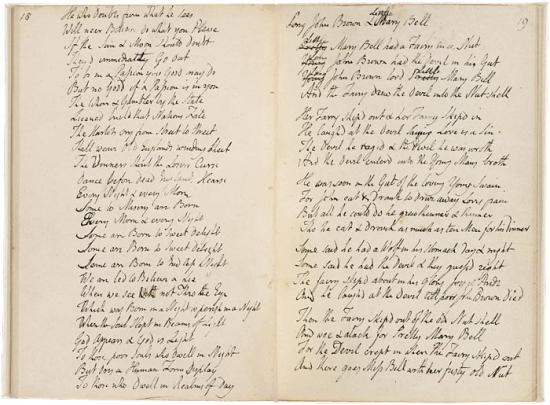
The Pickering Manuscript
[Autograph fair copy].
Gift of Mrs. Landon K. Thorne, 1971
This volume of ten poems in Blake's hand is the unique source for seven of his poetic works, including "Auguries of Innocence."
A dog starved at his master's gate
Predicts the ruin of the state.
The manuscript is named for a previous owner, B. M. Pickering, who acquired it in 1866 and published it for the first time that year. The poems probably date from about 1801 to 1804. As a "fair copy," it shows that Blake had copied all of the poems into a neat form with few corrections. Based on its paper stock and internal references, the manuscript has been dated to about 1807.
William Blake (1757–1827) occupies a unique place in the history of Western art. His creativity included both the visual and literary arts. In his lifetime he was best known as an engraver; now he is also recognized for his innovative poetry, printmaking, and painting. Blake's keen perception of the political and social climate found expression throughout his work. His strong sense of independence is evident in the complex mythology that he constructed in response to the age of revolution.
Blake was already recognized as an engraver at age twenty-five, when his first volume of poems appeared. At thirty-three, in The Marriage of Heaven and Hell, he audaciously claimed that his birth had marked the origin of a "new heaven" in which his own art would exemplify the creativity prefigured by Milton and Michelangelo. By that time, Blake, in one of his most productive periods, had already produced Songs of Innocence and was at work on a series of illuminated books. In 1818 he met John Linnell, a young painter and engraver, through whom a group of young artists became Blake's followers. Calling themselves the Ancients, they helped perpetuate Blake's influence for generations.
The Morgan's Blake collection—one of this country's most distinguished—began with purchases as early as 1899 by Pierpont Morgan. During the tenure of Charles Ryskamp, director from 1969 to 1986, major gifts almost doubled the size of its Blake holdings. In recent years Ryskamp's own gifts of engravings, letters, and related materials have significantly enriched its scholarly resources.
He who Doubts from what he sees
Will neer Believe do what you Please
If the Sun & Moon should Doubt
Theyd immediately Go out
To be in a Passion you Good may Do
But no Good if a Passion is in you
The Whore & Gambler by the State
Licencd build that Nations Fate
The Harlots cry from Street to Street
Shall weave Old Englands winding Sheet
The Winners Shout the Losers Curse
Dance before dead Englands Hearse
Every Night & every Morn
Some to Misery are Born
Every Morn & every Night
Some are Born to sweet delight
Some are Born to sweet delight
Some are Born to Endless Night
We are led to Believe a Lie
When we see not Thro the Eye
Which was Born in a Night to perish in a Night
When the Soul Slept in Beams of Light
God Appears & God is Light
To those poor Souls who dwell in Night
But does a Human Form Display
To those who Dwell in Realms of day
Long John Brown & Little Mary Bell
Little Mary Bell had a Fairy in a Nut
Long John Brown had the Devil in his Gut
Long John Brown lovd Little Mary Bell
And the Fairy drew the Devil into the Nut-shell
Her Fairy skipd out & her Fairy skipd in
He laughd at the Devil saying Love is a Sin
The devil he raged & the Devil he was wroth
And the devil enterd into the Young Mans broth
He was soon in the Gut of the loving Young Swain
For John eat & drank to drive away Loves pain
But all he could do he grew thinner & thinner
Tho he eat & drank as much as ten Men for his dinner
Some said he had a Wolf in his stomach day & night
Some said he had the Devil & they guessd right
The fairy skipd about in his glory Joy & Pride
And he laughd at the Devil till poor John Brown died
Then the Fairy skipd out of the old Nut shell
And woe & alack for Pretty Mary Bell
For the Devil crept in when The Fairy skipd out
And there goes Miss Bell with her fusty old Nut
This online exhibition is presented in conjunction with the exhibition William Blake's World: "A New Heaven Is Begun" on view September 11, 2009, through January 3, 2010.
This exhibition is made possible through the generosity of Fay and Geoffrey Elliott.
The Pickering Manuscript 11
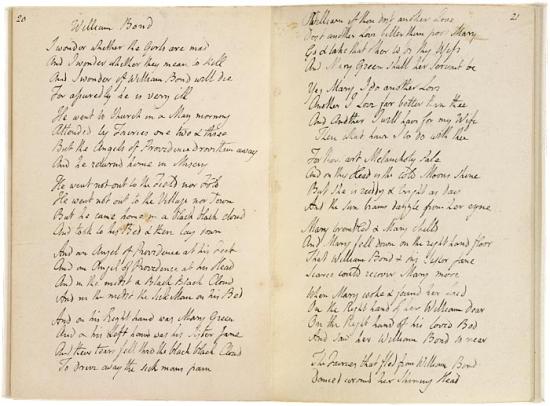
The Pickering Manuscript
[Autograph fair copy].
Gift of Mrs. Landon K. Thorne, 1971
This volume of ten poems in Blake's hand is the unique source for seven of his poetic works, including "Auguries of Innocence."
A dog starved at his master's gate
Predicts the ruin of the state.
The manuscript is named for a previous owner, B. M. Pickering, who acquired it in 1866 and published it for the first time that year. The poems probably date from about 1801 to 1804. As a "fair copy," it shows that Blake had copied all of the poems into a neat form with few corrections. Based on its paper stock and internal references, the manuscript has been dated to about 1807.
William Blake (1757–1827) occupies a unique place in the history of Western art. His creativity included both the visual and literary arts. In his lifetime he was best known as an engraver; now he is also recognized for his innovative poetry, printmaking, and painting. Blake's keen perception of the political and social climate found expression throughout his work. His strong sense of independence is evident in the complex mythology that he constructed in response to the age of revolution.
Blake was already recognized as an engraver at age twenty-five, when his first volume of poems appeared. At thirty-three, in The Marriage of Heaven and Hell, he audaciously claimed that his birth had marked the origin of a "new heaven" in which his own art would exemplify the creativity prefigured by Milton and Michelangelo. By that time, Blake, in one of his most productive periods, had already produced Songs of Innocence and was at work on a series of illuminated books. In 1818 he met John Linnell, a young painter and engraver, through whom a group of young artists became Blake's followers. Calling themselves the Ancients, they helped perpetuate Blake's influence for generations.
The Morgan's Blake collection—one of this country's most distinguished—began with purchases as early as 1899 by Pierpont Morgan. During the tenure of Charles Ryskamp, director from 1969 to 1986, major gifts almost doubled the size of its Blake holdings. In recent years Ryskamp's own gifts of engravings, letters, and related materials have significantly enriched its scholarly resources.
I wonder whether the Girls are mad
And I wonder whether they mean to kill
And I wonder if William Bond will die
For assuredly he is very ill
He went to Church in a May morning
Attended by Fairies one two & three
But the Angels Of Providence drove them away
And he returnd home in Misery
He went not out to the Field nor Fold
He went not out to the Village nor Town
But he came home in a black black cloud
And took to his Bed & there lay down
And an Angel of Providence at his Feet
And an Angel of Providence at his Head
And in the midst a Black Black Cloud
And in the midst the Sick Man on his Bed
And on his Right hand was Mary Green
And on his Left hand was his Sister Jane
And their tears fell thro the black black Cloud
To drive away the sick mans pain
O William if thou dost another Love
Dost another Love better than poor Mary
Go & take that other to be thy Wife
And Mary Green shall her Servant be
Yes Mary I do another Love
Another I Love far better than thee
And Another I will have for my Wife
Then what have I to do with thee
For thou art Melancholy Pale
And on thy Head is the cold Moons shine
But she is ruddy & bright as day
And the sun beams dazzle from her eyne
Mary trembled & Mary chilld
And Mary fell down on the right hand floor
That William Bond & his Sister Jane
Scarce could recover Mary more
When Mary woke & found her Laid
On the Right hand of her William dear
On the Right hand of his loved Bed
And saw her William Bond so near
The Fairies that fled from William Bond
Danced around her Shining Head
This online exhibition is presented in conjunction with the exhibition William Blake's World: "A New Heaven Is Begun" on view September 11, 2009, through January 3, 2010.
This exhibition is made possible through the generosity of Fay and Geoffrey Elliott.
The Pickering Manuscript 12
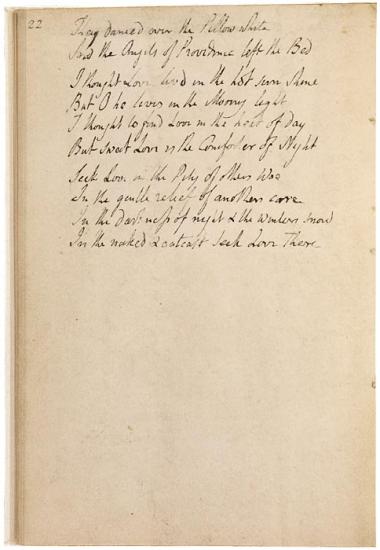
The Pickering Manuscript
[Autograph fair copy].
Gift of Mrs. Landon K. Thorne, 1971
This volume of ten poems in Blake's hand is the unique source for seven of his poetic works, including "Auguries of Innocence."
A dog starved at his master's gate
Predicts the ruin of the state.
The manuscript is named for a previous owner, B. M. Pickering, who acquired it in 1866 and published it for the first time that year. The poems probably date from about 1801 to 1804. As a "fair copy," it shows that Blake had copied all of the poems into a neat form with few corrections. Based on its paper stock and internal references, the manuscript has been dated to about 1807.
William Blake (1757–1827) occupies a unique place in the history of Western art. His creativity included both the visual and literary arts. In his lifetime he was best known as an engraver; now he is also recognized for his innovative poetry, printmaking, and painting. Blake's keen perception of the political and social climate found expression throughout his work. His strong sense of independence is evident in the complex mythology that he constructed in response to the age of revolution.
Blake was already recognized as an engraver at age twenty-five, when his first volume of poems appeared. At thirty-three, in The Marriage of Heaven and Hell, he audaciously claimed that his birth had marked the origin of a "new heaven" in which his own art would exemplify the creativity prefigured by Milton and Michelangelo. By that time, Blake, in one of his most productive periods, had already produced Songs of Innocence and was at work on a series of illuminated books. In 1818 he met John Linnell, a young painter and engraver, through whom a group of young artists became Blake's followers. Calling themselves the Ancients, they helped perpetuate Blake's influence for generations.
The Morgan's Blake collection—one of this country's most distinguished—began with purchases as early as 1899 by Pierpont Morgan. During the tenure of Charles Ryskamp, director from 1969 to 1986, major gifts almost doubled the size of its Blake holdings. In recent years Ryskamp's own gifts of engravings, letters, and related materials have significantly enriched its scholarly resources.
They danced over the Pillow white
And the Angels of Providence left the Bed
I thought Love livd in the hot sun Shine
But O he lives in the Moony light
I thought to find Love in the heat of day
But sweet Love is the Comforter of Night
Seek Love in the Pity of others Woe
In the gentle relief of anothers care
In the darkness of night & the winters snow
In the naked & outcast Seek Love there
This online exhibition is presented in conjunction with the exhibition William Blake's World: "A New Heaven Is Begun" on view September 11, 2009, through January 3, 2010.
This exhibition is made possible through the generosity of Fay and Geoffrey Elliott.
Poetical Sketches

Poetical Sketches.
London: Printed in the year MDCCLXXXIII [1783].
Copy X
Purchased as the gift of the Fellows with the special assistance of the Thorne Foundation, 1971
One of twenty-three copies, this earliest publication of Blake's poetry was set in conventional type. The introduction notes that Blake composed many of the poems between the ages of twelve and twenty. The two songs here exemplify his early use of rural scenery. The turtledoves nesting in the branches of a tree, for example, represent love and harmony. More than thirty years later, this imagery was admired by the Ancients, who were moving from the symbolic use of nature to a more realistic style.
William Blake (1757–1827) occupies a unique place in the history of Western art. His creativity included both the visual and literary arts. In his lifetime he was best known as an engraver; now he is also recognized for his innovative poetry, printmaking, and painting. Blake's keen perception of the political and social climate found expression throughout his work. His strong sense of independence is evident in the complex mythology that he constructed in response to the age of revolution.
Blake was already recognized as an engraver at age twenty-five, when his first volume of poems appeared. At thirty-three, in The Marriage of Heaven and Hell, he audaciously claimed that his birth had marked the origin of a "new heaven" in which his own art would exemplify the creativity prefigured by Milton and Michelangelo. By that time, Blake, in one of his most productive periods, had already produced Songs of Innocence and was at work on a series of illuminated books. In 1818 he met John Linnell, a young painter and engraver, through whom a group of young artists became Blake's followers. Calling themselves the Ancients, they helped perpetuate Blake's influence for generations.
The Morgan's Blake collection—one of this country's most distinguished—began with purchases as early as 1899 by Pierpont Morgan. During the tenure of Charles Ryskamp, director from 1969 to 1986, major gifts almost doubled the size of its Blake holdings. In recent years Ryskamp's own gifts of engravings, letters, and related materials have significantly enriched its scholarly resources.
This online exhibition is presented in conjunction with the exhibition William Blake's World: "A New Heaven Is Begun" on view September 11, 2009, through January 3, 2010.
This exhibition is made possible through the generosity of Fay and Geoffrey Elliott.
Jerusalem: The Emanation of the Giant Albion

Jerusalem: The Emanation of the Giant Albion.
[London]: Printed by W. Blake, S[outh] Molton St., 1804.
Relief and white line etching
100 plates, created between 1804 and 1820
Copy F, printed about 1827
Purchased with the Toovey collection, 1899
The longest, and last, of Blake's illuminated books was Jerusalem. As its title page shows, it was begun in 1804, but no copy was issued prior to about 1820. This copy had been printed but not collated when Blake died in 1827. It is one of six he is known to have produced, only two of which were colored.
The figure of the London night watchman on the frontispiece is Los, who represents creative imagination in the material world. At lower left Jerusalem (the female figure of humanity, often signifying liberty) rests upon her six diaphanous wings; the fairies and insects above symbolize freedom.
William Blake (1757–1827) occupies a unique place in the history of Western art. His creativity included both the visual and literary arts. In his lifetime he was best known as an engraver; now he is also recognized for his innovative poetry, printmaking, and painting. Blake's keen perception of the political and social climate found expression throughout his work. His strong sense of independence is evident in the complex mythology that he constructed in response to the age of revolution.
Blake was already recognized as an engraver at age twenty-five, when his first volume of poems appeared. At thirty-three, in The Marriage of Heaven and Hell, he audaciously claimed that his birth had marked the origin of a "new heaven" in which his own art would exemplify the creativity prefigured by Milton and Michelangelo. By that time, Blake, in one of his most productive periods, had already produced Songs of Innocence and was at work on a series of illuminated books. In 1818 he met John Linnell, a young painter and engraver, through whom a group of young artists became Blake's followers. Calling themselves the Ancients, they helped perpetuate Blake's influence for generations.
The Morgan's Blake collection—one of this country's most distinguished—began with purchases as early as 1899 by Pierpont Morgan. During the tenure of Charles Ryskamp, director from 1969 to 1986, major gifts almost doubled the size of its Blake holdings. In recent years Ryskamp's own gifts of engravings, letters, and related materials have significantly enriched its scholarly resources.
This online exhibition is presented in conjunction with the exhibition William Blake's World: "A New Heaven Is Begun" on view September 11, 2009, through January 3, 2010.
This exhibition is made possible through the generosity of Fay and Geoffrey Elliott.
The Grave: A Poem
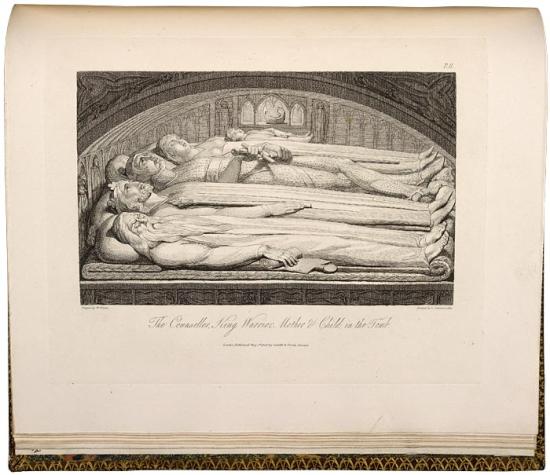
The Grave: A Poem.
London: Printed by T. Bensley for R. H. Cromek . . . , 1808.
Plate 4 (of 12).
The Counsellor, King, Warrior, Mother, and Child.
Inscribed below, Drawn by W. Blake Etched by L. Schiavonetti
London: Published May 1st 1808 by Cadell & Davis. Strand.
Bequest of Julia P. Wightman, 1994
Poems featuring a narrator's melancholy musings on the nature of mortality were very popular during the eighteenth century. A prominent example of the Graveyard genre, Blair's poem, although published in 1743, had never appeared in a special edition. As the inaugural project of R. H. Cromek, an engraver turned publisher, it became a disaster for Blake. Although he created the drawings, Cromek paid him poorly and hired Louis Schiavonetti to engrave them. The loss of the engraving fees and the book's poor reception deprived Blake of new work and initiated several years of penury.
William Blake (1757–1827) occupies a unique place in the history of Western art. His creativity included both the visual and literary arts. In his lifetime he was best known as an engraver; now he is also recognized for his innovative poetry, printmaking, and painting. Blake's keen perception of the political and social climate found expression throughout his work. His strong sense of independence is evident in the complex mythology that he constructed in response to the age of revolution.
Blake was already recognized as an engraver at age twenty-five, when his first volume of poems appeared. At thirty-three, in The Marriage of Heaven and Hell, he audaciously claimed that his birth had marked the origin of a "new heaven" in which his own art would exemplify the creativity prefigured by Milton and Michelangelo. By that time, Blake, in one of his most productive periods, had already produced Songs of Innocence and was at work on a series of illuminated books. In 1818 he met John Linnell, a young painter and engraver, through whom a group of young artists became Blake's followers. Calling themselves the Ancients, they helped perpetuate Blake's influence for generations.
The Morgan's Blake collection—one of this country's most distinguished—began with purchases as early as 1899 by Pierpont Morgan. During the tenure of Charles Ryskamp, director from 1969 to 1986, major gifts almost doubled the size of its Blake holdings. In recent years Ryskamp's own gifts of engravings, letters, and related materials have significantly enriched its scholarly resources.
This online exhibition is presented in conjunction with the exhibition William Blake's World: "A New Heaven Is Begun" on view September 11, 2009, through January 3, 2010.
This exhibition is made possible through the generosity of Fay and Geoffrey Elliott.
The Wit's Magazine; or, Library of Momus
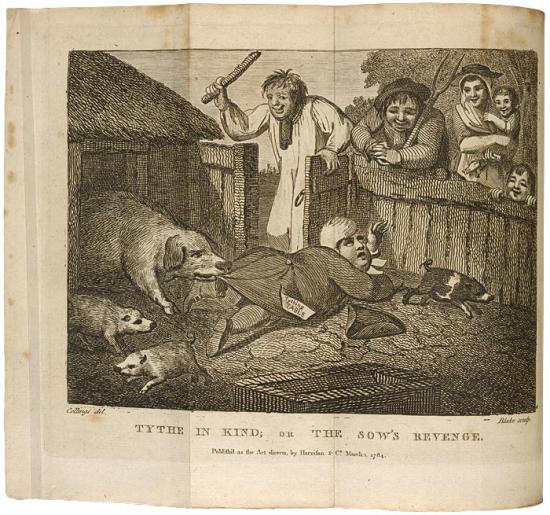
The Wit's Magazine; or, Library of Momus.
London: Printed for Harrison and Co. No. 18, Paternoster Row, [1784–85]. Vol. 1 (of 2).
Tythe in Kind; or The Sow's Revenge
Inscribed at left, Collings del., at right, Blake sculp., Publish'd as the Act directs, by Harrison & Co. March 1. 1784.
Gift of Charles Ryskamp in honor of Marianne and Paul Gourary, 2006
The subtitle of this annual—"a compleat repository of mirth, humour, and entertainment"—sets the tone. This was obviously only a commercial project for Blake, who was twenty-six at the time, newly married (August 1782), and planning to open a print shop with James Parker in the fall.
William Blake (1757–1827) occupies a unique place in the history of Western art. His creativity included both the visual and literary arts. In his lifetime he was best known as an engraver; now he is also recognized for his innovative poetry, printmaking, and painting. Blake's keen perception of the political and social climate found expression throughout his work. His strong sense of independence is evident in the complex mythology that he constructed in response to the age of revolution.
Blake was already recognized as an engraver at age twenty-five, when his first volume of poems appeared. At thirty-three, in The Marriage of Heaven and Hell, he audaciously claimed that his birth had marked the origin of a "new heaven" in which his own art would exemplify the creativity prefigured by Milton and Michelangelo. By that time, Blake, in one of his most productive periods, had already produced Songs of Innocence and was at work on a series of illuminated books. In 1818 he met John Linnell, a young painter and engraver, through whom a group of young artists became Blake's followers. Calling themselves the Ancients, they helped perpetuate Blake's influence for generations.
The Morgan's Blake collection—one of this country's most distinguished—began with purchases as early as 1899 by Pierpont Morgan. During the tenure of Charles Ryskamp, director from 1969 to 1986, major gifts almost doubled the size of its Blake holdings. In recent years Ryskamp's own gifts of engravings, letters, and related materials have significantly enriched its scholarly resources.
This online exhibition is presented in conjunction with the exhibition William Blake's World: "A New Heaven Is Begun" on view September 11, 2009, through January 3, 2010.
This exhibition is made possible through the generosity of Fay and Geoffrey Elliott.
The Botanic Garden: A Poem, in Two Parts . . . with Philosophical Notes
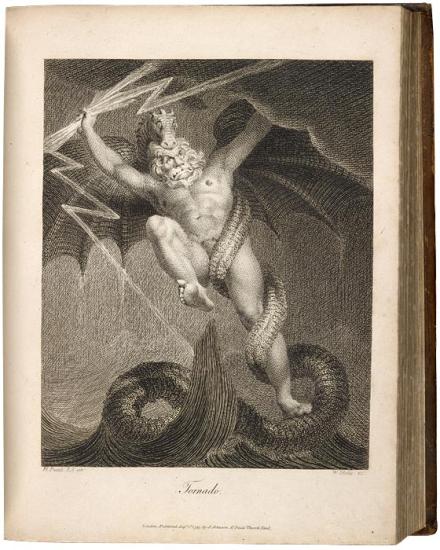
The Botanic Garden: A Poem, in Two Parts . . . with Philosophical Notes.
London: Printed for J. Johnson . . . , 1795. Third edition.
Tornado
Inscribed at lower left, H. Fuseli R.A.: inv:, at lower right,
W. Blake: sc:, London: Published Augt. 1st. 1795, by J. Johnson, St. Paul's Church Yard.
Gift of Charles Ryskamp in memory of Michael S. Currier, 1998
This example of Blake's commercial work is an engraving after Fuseli. It documents the skills Blake attained during his apprenticeship to Basire, which were amplified by his own maturity. Tornado appeared for the first time in this third edition. Two of Blake's engravings in this book are after Fuseli. The 1791 edition also contains Blake's four unsigned engravings of the Roman cameo-glass vase then belonging to the Duke of Portland. Darwin's poetical natural history and mythology influenced Blake's thought, as it had that of other Romantic poets.
William Blake (1757–1827) occupies a unique place in the history of Western art. His creativity included both the visual and literary arts. In his lifetime he was best known as an engraver; now he is also recognized for his innovative poetry, printmaking, and painting. Blake's keen perception of the political and social climate found expression throughout his work. His strong sense of independence is evident in the complex mythology that he constructed in response to the age of revolution.
Blake was already recognized as an engraver at age twenty-five, when his first volume of poems appeared. At thirty-three, in The Marriage of Heaven and Hell, he audaciously claimed that his birth had marked the origin of a "new heaven" in which his own art would exemplify the creativity prefigured by Milton and Michelangelo. By that time, Blake, in one of his most productive periods, had already produced Songs of Innocence and was at work on a series of illuminated books. In 1818 he met John Linnell, a young painter and engraver, through whom a group of young artists became Blake's followers. Calling themselves the Ancients, they helped perpetuate Blake's influence for generations.
The Morgan's Blake collection—one of this country's most distinguished—began with purchases as early as 1899 by Pierpont Morgan. During the tenure of Charles Ryskamp, director from 1969 to 1986, major gifts almost doubled the size of its Blake holdings. In recent years Ryskamp's own gifts of engravings, letters, and related materials have significantly enriched its scholarly resources.
This online exhibition is presented in conjunction with the exhibition William Blake's World: "A New Heaven Is Begun" on view September 11, 2009, through January 3, 2010.
This exhibition is made possible through the generosity of Fay and Geoffrey Elliott.
A Select Collection of English Songs
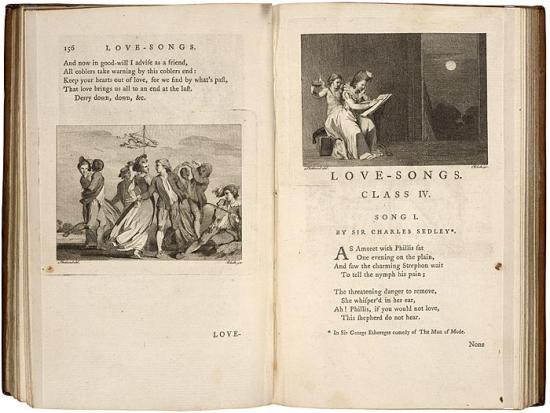
A Select Collection of English Songs
London: Printed for J. Johnson in St. Pauls [sic]
Church-yard, 1783. Vol. 1 of 3.
Gift of Charles Ryskamp in memory of Michael S. Currier, 1998
The antiquarian Joseph Ritson included in this selection several engravings by Blake after work by Thomas Stothard. Two are shown here. The book was published by Joseph Johnson (1738–1809), who also published work by Mary Wollstonecraft and other radical writers of the day. Johnson published many of Blake's early engravings after other artists and is thought to have been the anonymous publisher, the same year, of Poetical Sketches, Blake's first book of poetry. Between 1770 and 1801 he published more than a hundred engraved plates by Blake.
William Blake (1757–1827) occupies a unique place in the history of Western art. His creativity included both the visual and literary arts. In his lifetime he was best known as an engraver; now he is also recognized for his innovative poetry, printmaking, and painting. Blake's keen perception of the political and social climate found expression throughout his work. His strong sense of independence is evident in the complex mythology that he constructed in response to the age of revolution.
Blake was already recognized as an engraver at age twenty-five, when his first volume of poems appeared. At thirty-three, in The Marriage of Heaven and Hell, he audaciously claimed that his birth had marked the origin of a "new heaven" in which his own art would exemplify the creativity prefigured by Milton and Michelangelo. By that time, Blake, in one of his most productive periods, had already produced Songs of Innocence and was at work on a series of illuminated books. In 1818 he met John Linnell, a young painter and engraver, through whom a group of young artists became Blake's followers. Calling themselves the Ancients, they helped perpetuate Blake's influence for generations.
The Morgan's Blake collection—one of this country's most distinguished—began with purchases as early as 1899 by Pierpont Morgan. During the tenure of Charles Ryskamp, director from 1969 to 1986, major gifts almost doubled the size of its Blake holdings. In recent years Ryskamp's own gifts of engravings, letters, and related materials have significantly enriched its scholarly resources.
This online exhibition is presented in conjunction with the exhibition William Blake's World: "A New Heaven Is Begun" on view September 11, 2009, through January 3, 2010.
This exhibition is made possible through the generosity of Fay and Geoffrey Elliott.
There Is No Natural Religion

There Is No Natural Religion.
[London]: The author and printer W. Blake, [1788].
Relief etching printed in three colors, some plates heightened with watercolor
Copy G, ca. 1794
Purchased as the gift of Mrs. Landon K. Thorne
This early work in relief etching was once thought to predate Blake's illuminated books. Current scholarship, however, dates it to about 1794. Rather than a sequential narrative, it is a series of aphorisms with emblematic images. Blake developed this relief etching technique for incorporating text and image on one printing surface. In addition to two copies of this work, the Morgan owns one unique plate from copy L, presented by Sir Geoffrey Keynes in 1977. This copy once belonged to Blake's follower Frederick Tatham.
William Blake (1757–1827) occupies a unique place in the history of Western art. His creativity included both the visual and literary arts. In his lifetime he was best known as an engraver; now he is also recognized for his innovative poetry, printmaking, and painting. Blake's keen perception of the political and social climate found expression throughout his work. His strong sense of independence is evident in the complex mythology that he constructed in response to the age of revolution.
Blake was already recognized as an engraver at age twenty-five, when his first volume of poems appeared. At thirty-three, in The Marriage of Heaven and Hell, he audaciously claimed that his birth had marked the origin of a "new heaven" in which his own art would exemplify the creativity prefigured by Milton and Michelangelo. By that time, Blake, in one of his most productive periods, had already produced Songs of Innocence and was at work on a series of illuminated books. In 1818 he met John Linnell, a young painter and engraver, through whom a group of young artists became Blake's followers. Calling themselves the Ancients, they helped perpetuate Blake's influence for generations.
The Morgan's Blake collection—one of this country's most distinguished—began with purchases as early as 1899 by Pierpont Morgan. During the tenure of Charles Ryskamp, director from 1969 to 1986, major gifts almost doubled the size of its Blake holdings. In recent years Ryskamp's own gifts of engravings, letters, and related materials have significantly enriched its scholarly resources.
This online exhibition is presented in conjunction with the exhibition William Blake's World: "A New Heaven Is Begun" on view September 11, 2009, through January 3, 2010.
This exhibition is made possible through the generosity of Fay and Geoffrey Elliott.
There Is No Natural Religion 2
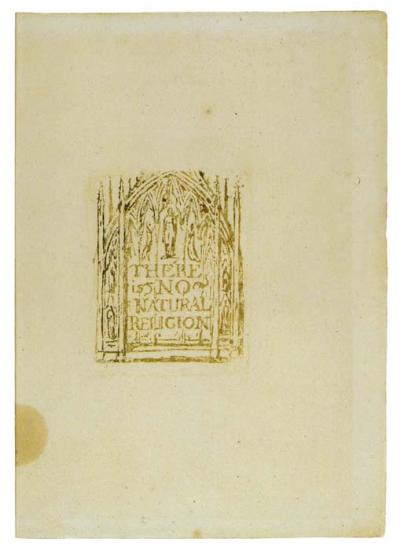
There Is No Natural Religion.
[London]: The author and printer W. Blake, [1788].
Relief etching printed in three colors, some plates heightened with watercolor
Copy G, ca. 1794
Purchased as the gift of Mrs. Landon K. Thorne
This early work in relief etching was once thought to predate Blake's illuminated books. Current scholarship, however, dates it to about 1794. Rather than a sequential narrative, it is a series of aphorisms with emblematic images. Blake developed this relief etching technique for incorporating text and image on one printing surface. In addition to two copies of this work, the Morgan owns one unique plate from copy L, presented by Sir Geoffrey Keynes in 1977. This copy once belonged to Blake's follower Frederick Tatham.
William Blake (1757–1827) occupies a unique place in the history of Western art. His creativity included both the visual and literary arts. In his lifetime he was best known as an engraver; now he is also recognized for his innovative poetry, printmaking, and painting. Blake's keen perception of the political and social climate found expression throughout his work. His strong sense of independence is evident in the complex mythology that he constructed in response to the age of revolution.
Blake was already recognized as an engraver at age twenty-five, when his first volume of poems appeared. At thirty-three, in The Marriage of Heaven and Hell, he audaciously claimed that his birth had marked the origin of a "new heaven" in which his own art would exemplify the creativity prefigured by Milton and Michelangelo. By that time, Blake, in one of his most productive periods, had already produced Songs of Innocence and was at work on a series of illuminated books. In 1818 he met John Linnell, a young painter and engraver, through whom a group of young artists became Blake's followers. Calling themselves the Ancients, they helped perpetuate Blake's influence for generations.
The Morgan's Blake collection—one of this country's most distinguished—began with purchases as early as 1899 by Pierpont Morgan. During the tenure of Charles Ryskamp, director from 1969 to 1986, major gifts almost doubled the size of its Blake holdings. In recent years Ryskamp's own gifts of engravings, letters, and related materials have significantly enriched its scholarly resources.
This online exhibition is presented in conjunction with the exhibition William Blake's World: "A New Heaven Is Begun" on view September 11, 2009, through January 3, 2010.
This exhibition is made possible through the generosity of Fay and Geoffrey Elliott.
There Is No Natural Religion 3
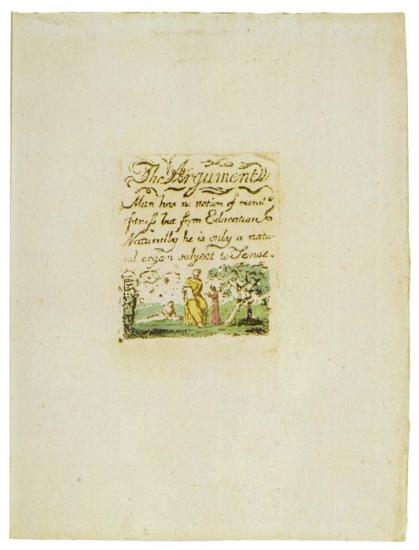
There Is No Natural Religion.
[London]: The author and printer W. Blake, [1788].
Relief etching printed in three colors, some plates heightened with watercolor
Copy G, ca. 1794
Purchased as the gift of Mrs. Landon K. Thorne
This early work in relief etching was once thought to predate Blake's illuminated books. Current scholarship, however, dates it to about 1794. Rather than a sequential narrative, it is a series of aphorisms with emblematic images. Blake developed this relief etching technique for incorporating text and image on one printing surface. In addition to two copies of this work, the Morgan owns one unique plate from copy L, presented by Sir Geoffrey Keynes in 1977. This copy once belonged to Blake's follower Frederick Tatham.
William Blake (1757–1827) occupies a unique place in the history of Western art. His creativity included both the visual and literary arts. In his lifetime he was best known as an engraver; now he is also recognized for his innovative poetry, printmaking, and painting. Blake's keen perception of the political and social climate found expression throughout his work. His strong sense of independence is evident in the complex mythology that he constructed in response to the age of revolution.
Blake was already recognized as an engraver at age twenty-five, when his first volume of poems appeared. At thirty-three, in The Marriage of Heaven and Hell, he audaciously claimed that his birth had marked the origin of a "new heaven" in which his own art would exemplify the creativity prefigured by Milton and Michelangelo. By that time, Blake, in one of his most productive periods, had already produced Songs of Innocence and was at work on a series of illuminated books. In 1818 he met John Linnell, a young painter and engraver, through whom a group of young artists became Blake's followers. Calling themselves the Ancients, they helped perpetuate Blake's influence for generations.
The Morgan's Blake collection—one of this country's most distinguished—began with purchases as early as 1899 by Pierpont Morgan. During the tenure of Charles Ryskamp, director from 1969 to 1986, major gifts almost doubled the size of its Blake holdings. In recent years Ryskamp's own gifts of engravings, letters, and related materials have significantly enriched its scholarly resources.
This online exhibition is presented in conjunction with the exhibition William Blake's World: "A New Heaven Is Begun" on view September 11, 2009, through January 3, 2010.
This exhibition is made possible through the generosity of Fay and Geoffrey Elliott.
There Is No Natural Religion 4
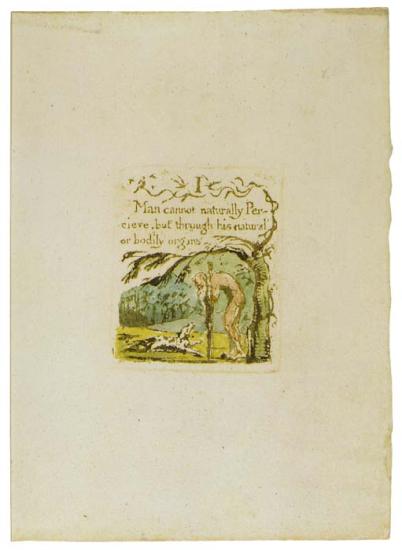
There Is No Natural Religion.
[London]: The author and printer W. Blake, [1788].
Relief etching printed in three colors, some plates heightened with watercolor
Copy G, ca. 1794
Purchased as the gift of Mrs. Landon K. Thorne
This early work in relief etching was once thought to predate Blake's illuminated books. Current scholarship, however, dates it to about 1794. Rather than a sequential narrative, it is a series of aphorisms with emblematic images. Blake developed this relief etching technique for incorporating text and image on one printing surface. In addition to two copies of this work, the Morgan owns one unique plate from copy L, presented by Sir Geoffrey Keynes in 1977. This copy once belonged to Blake's follower Frederick Tatham.
William Blake (1757–1827) occupies a unique place in the history of Western art. His creativity included both the visual and literary arts. In his lifetime he was best known as an engraver; now he is also recognized for his innovative poetry, printmaking, and painting. Blake's keen perception of the political and social climate found expression throughout his work. His strong sense of independence is evident in the complex mythology that he constructed in response to the age of revolution.
Blake was already recognized as an engraver at age twenty-five, when his first volume of poems appeared. At thirty-three, in The Marriage of Heaven and Hell, he audaciously claimed that his birth had marked the origin of a "new heaven" in which his own art would exemplify the creativity prefigured by Milton and Michelangelo. By that time, Blake, in one of his most productive periods, had already produced Songs of Innocence and was at work on a series of illuminated books. In 1818 he met John Linnell, a young painter and engraver, through whom a group of young artists became Blake's followers. Calling themselves the Ancients, they helped perpetuate Blake's influence for generations.
The Morgan's Blake collection—one of this country's most distinguished—began with purchases as early as 1899 by Pierpont Morgan. During the tenure of Charles Ryskamp, director from 1969 to 1986, major gifts almost doubled the size of its Blake holdings. In recent years Ryskamp's own gifts of engravings, letters, and related materials have significantly enriched its scholarly resources.
This online exhibition is presented in conjunction with the exhibition William Blake's World: "A New Heaven Is Begun" on view September 11, 2009, through January 3, 2010.
This exhibition is made possible through the generosity of Fay and Geoffrey Elliott.
There Is No Natural Religion 5
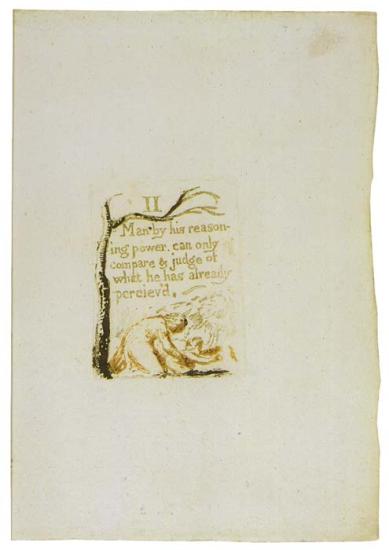
There Is No Natural Religion.
[London]: The author and printer W. Blake, [1788].
Relief etching printed in three colors, some plates heightened with watercolor
Copy G, ca. 1794
Purchased as the gift of Mrs. Landon K. Thorne
This early work in relief etching was once thought to predate Blake's illuminated books. Current scholarship, however, dates it to about 1794. Rather than a sequential narrative, it is a series of aphorisms with emblematic images. Blake developed this relief etching technique for incorporating text and image on one printing surface. In addition to two copies of this work, the Morgan owns one unique plate from copy L, presented by Sir Geoffrey Keynes in 1977. This copy once belonged to Blake's follower Frederick Tatham.
William Blake (1757–1827) occupies a unique place in the history of Western art. His creativity included both the visual and literary arts. In his lifetime he was best known as an engraver; now he is also recognized for his innovative poetry, printmaking, and painting. Blake's keen perception of the political and social climate found expression throughout his work. His strong sense of independence is evident in the complex mythology that he constructed in response to the age of revolution.
Blake was already recognized as an engraver at age twenty-five, when his first volume of poems appeared. At thirty-three, in The Marriage of Heaven and Hell, he audaciously claimed that his birth had marked the origin of a "new heaven" in which his own art would exemplify the creativity prefigured by Milton and Michelangelo. By that time, Blake, in one of his most productive periods, had already produced Songs of Innocence and was at work on a series of illuminated books. In 1818 he met John Linnell, a young painter and engraver, through whom a group of young artists became Blake's followers. Calling themselves the Ancients, they helped perpetuate Blake's influence for generations.
The Morgan's Blake collection—one of this country's most distinguished—began with purchases as early as 1899 by Pierpont Morgan. During the tenure of Charles Ryskamp, director from 1969 to 1986, major gifts almost doubled the size of its Blake holdings. In recent years Ryskamp's own gifts of engravings, letters, and related materials have significantly enriched its scholarly resources.
This online exhibition is presented in conjunction with the exhibition William Blake's World: "A New Heaven Is Begun" on view September 11, 2009, through January 3, 2010.
This exhibition is made possible through the generosity of Fay and Geoffrey Elliott.
There Is No Natural Religion 6
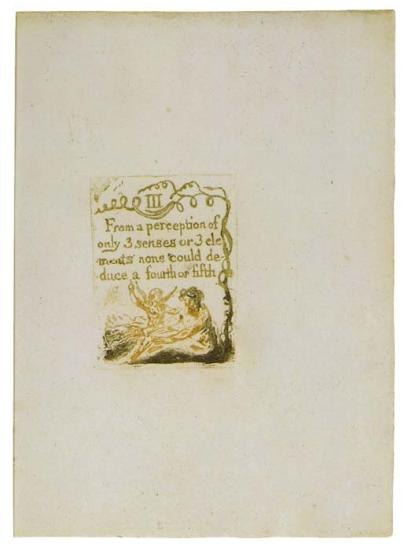
There Is No Natural Religion.
[London]: The author and printer W. Blake, [1788].
Relief etching printed in three colors, some plates heightened with watercolor
Copy G, ca. 1794
Purchased as the gift of Mrs. Landon K. Thorne
This early work in relief etching was once thought to predate Blake's illuminated books. Current scholarship, however, dates it to about 1794. Rather than a sequential narrative, it is a series of aphorisms with emblematic images. Blake developed this relief etching technique for incorporating text and image on one printing surface. In addition to two copies of this work, the Morgan owns one unique plate from copy L, presented by Sir Geoffrey Keynes in 1977. This copy once belonged to Blake's follower Frederick Tatham.
William Blake (1757–1827) occupies a unique place in the history of Western art. His creativity included both the visual and literary arts. In his lifetime he was best known as an engraver; now he is also recognized for his innovative poetry, printmaking, and painting. Blake's keen perception of the political and social climate found expression throughout his work. His strong sense of independence is evident in the complex mythology that he constructed in response to the age of revolution.
Blake was already recognized as an engraver at age twenty-five, when his first volume of poems appeared. At thirty-three, in The Marriage of Heaven and Hell, he audaciously claimed that his birth had marked the origin of a "new heaven" in which his own art would exemplify the creativity prefigured by Milton and Michelangelo. By that time, Blake, in one of his most productive periods, had already produced Songs of Innocence and was at work on a series of illuminated books. In 1818 he met John Linnell, a young painter and engraver, through whom a group of young artists became Blake's followers. Calling themselves the Ancients, they helped perpetuate Blake's influence for generations.
The Morgan's Blake collection—one of this country's most distinguished—began with purchases as early as 1899 by Pierpont Morgan. During the tenure of Charles Ryskamp, director from 1969 to 1986, major gifts almost doubled the size of its Blake holdings. In recent years Ryskamp's own gifts of engravings, letters, and related materials have significantly enriched its scholarly resources.
This online exhibition is presented in conjunction with the exhibition William Blake's World: "A New Heaven Is Begun" on view September 11, 2009, through January 3, 2010.
This exhibition is made possible through the generosity of Fay and Geoffrey Elliott.
There Is No Natural Religion 7

There Is No Natural Religion.
[London]: The author and printer W. Blake, [1788].
Relief etching printed in three colors, some plates heightened with watercolor
Copy G, ca. 1794
Purchased as the gift of Mrs. Landon K. Thorne
This early work in relief etching was once thought to predate Blake's illuminated books. Current scholarship, however, dates it to about 1794. Rather than a sequential narrative, it is a series of aphorisms with emblematic images. Blake developed this relief etching technique for incorporating text and image on one printing surface. In addition to two copies of this work, the Morgan owns one unique plate from copy L, presented by Sir Geoffrey Keynes in 1977. This copy once belonged to Blake's follower Frederick Tatham.
William Blake (1757–1827) occupies a unique place in the history of Western art. His creativity included both the visual and literary arts. In his lifetime he was best known as an engraver; now he is also recognized for his innovative poetry, printmaking, and painting. Blake's keen perception of the political and social climate found expression throughout his work. His strong sense of independence is evident in the complex mythology that he constructed in response to the age of revolution.
Blake was already recognized as an engraver at age twenty-five, when his first volume of poems appeared. At thirty-three, in The Marriage of Heaven and Hell, he audaciously claimed that his birth had marked the origin of a "new heaven" in which his own art would exemplify the creativity prefigured by Milton and Michelangelo. By that time, Blake, in one of his most productive periods, had already produced Songs of Innocence and was at work on a series of illuminated books. In 1818 he met John Linnell, a young painter and engraver, through whom a group of young artists became Blake's followers. Calling themselves the Ancients, they helped perpetuate Blake's influence for generations.
The Morgan's Blake collection—one of this country's most distinguished—began with purchases as early as 1899 by Pierpont Morgan. During the tenure of Charles Ryskamp, director from 1969 to 1986, major gifts almost doubled the size of its Blake holdings. In recent years Ryskamp's own gifts of engravings, letters, and related materials have significantly enriched its scholarly resources.
This online exhibition is presented in conjunction with the exhibition William Blake's World: "A New Heaven Is Begun" on view September 11, 2009, through January 3, 2010.
This exhibition is made possible through the generosity of Fay and Geoffrey Elliott.
There Is No Natural Religion 8
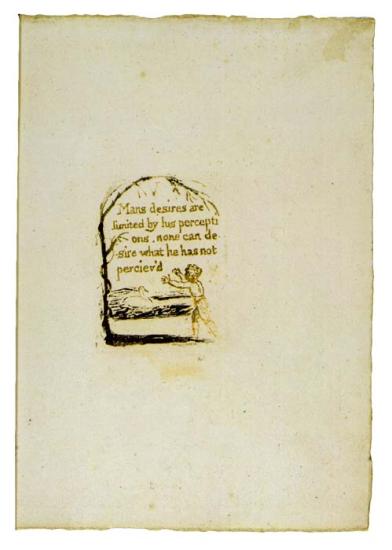
There Is No Natural Religion.
[London]: The author and printer W. Blake, [1788].
Relief etching printed in three colors, some plates heightened with watercolor
Copy G, ca. 1794
Purchased as the gift of Mrs. Landon K. Thorne
This early work in relief etching was once thought to predate Blake's illuminated books. Current scholarship, however, dates it to about 1794. Rather than a sequential narrative, it is a series of aphorisms with emblematic images. Blake developed this relief etching technique for incorporating text and image on one printing surface. In addition to two copies of this work, the Morgan owns one unique plate from copy L, presented by Sir Geoffrey Keynes in 1977. This copy once belonged to Blake's follower Frederick Tatham.
William Blake (1757–1827) occupies a unique place in the history of Western art. His creativity included both the visual and literary arts. In his lifetime he was best known as an engraver; now he is also recognized for his innovative poetry, printmaking, and painting. Blake's keen perception of the political and social climate found expression throughout his work. His strong sense of independence is evident in the complex mythology that he constructed in response to the age of revolution.
Blake was already recognized as an engraver at age twenty-five, when his first volume of poems appeared. At thirty-three, in The Marriage of Heaven and Hell, he audaciously claimed that his birth had marked the origin of a "new heaven" in which his own art would exemplify the creativity prefigured by Milton and Michelangelo. By that time, Blake, in one of his most productive periods, had already produced Songs of Innocence and was at work on a series of illuminated books. In 1818 he met John Linnell, a young painter and engraver, through whom a group of young artists became Blake's followers. Calling themselves the Ancients, they helped perpetuate Blake's influence for generations.
The Morgan's Blake collection—one of this country's most distinguished—began with purchases as early as 1899 by Pierpont Morgan. During the tenure of Charles Ryskamp, director from 1969 to 1986, major gifts almost doubled the size of its Blake holdings. In recent years Ryskamp's own gifts of engravings, letters, and related materials have significantly enriched its scholarly resources.
This online exhibition is presented in conjunction with the exhibition William Blake's World: "A New Heaven Is Begun" on view September 11, 2009, through January 3, 2010.
This exhibition is made possible through the generosity of Fay and Geoffrey Elliott.
There Is No Natural Religion 9
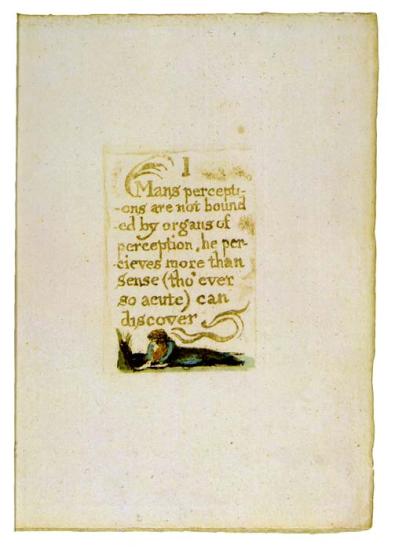
There Is No Natural Religion.
[London]: The author and printer W. Blake, [1788].
Relief etching printed in three colors, some plates heightened with watercolor
Copy G, ca. 1794
Purchased as the gift of Mrs. Landon K. Thorne
This early work in relief etching was once thought to predate Blake's illuminated books. Current scholarship, however, dates it to about 1794. Rather than a sequential narrative, it is a series of aphorisms with emblematic images. Blake developed this relief etching technique for incorporating text and image on one printing surface. In addition to two copies of this work, the Morgan owns one unique plate from copy L, presented by Sir Geoffrey Keynes in 1977. This copy once belonged to Blake's follower Frederick Tatham.
William Blake (1757–1827) occupies a unique place in the history of Western art. His creativity included both the visual and literary arts. In his lifetime he was best known as an engraver; now he is also recognized for his innovative poetry, printmaking, and painting. Blake's keen perception of the political and social climate found expression throughout his work. His strong sense of independence is evident in the complex mythology that he constructed in response to the age of revolution.
Blake was already recognized as an engraver at age twenty-five, when his first volume of poems appeared. At thirty-three, in The Marriage of Heaven and Hell, he audaciously claimed that his birth had marked the origin of a "new heaven" in which his own art would exemplify the creativity prefigured by Milton and Michelangelo. By that time, Blake, in one of his most productive periods, had already produced Songs of Innocence and was at work on a series of illuminated books. In 1818 he met John Linnell, a young painter and engraver, through whom a group of young artists became Blake's followers. Calling themselves the Ancients, they helped perpetuate Blake's influence for generations.
The Morgan's Blake collection—one of this country's most distinguished—began with purchases as early as 1899 by Pierpont Morgan. During the tenure of Charles Ryskamp, director from 1969 to 1986, major gifts almost doubled the size of its Blake holdings. In recent years Ryskamp's own gifts of engravings, letters, and related materials have significantly enriched its scholarly resources.
This online exhibition is presented in conjunction with the exhibition William Blake's World: "A New Heaven Is Begun" on view September 11, 2009, through January 3, 2010.
This exhibition is made possible through the generosity of Fay and Geoffrey Elliott.
There Is No Natural Religion 10
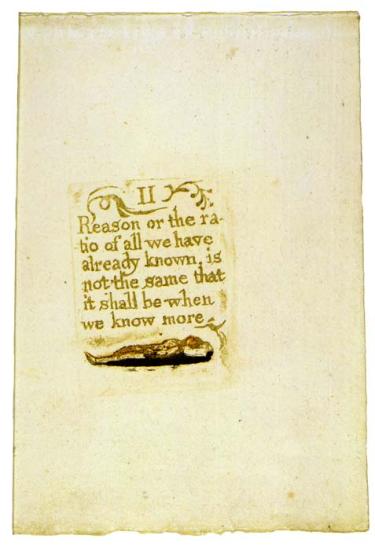
There Is No Natural Religion.
[London]: The author and printer W. Blake, [1788].
Relief etching printed in three colors, some plates heightened with watercolor
Copy G, ca. 1794
Purchased as the gift of Mrs. Landon K. Thorne
This early work in relief etching was once thought to predate Blake's illuminated books. Current scholarship, however, dates it to about 1794. Rather than a sequential narrative, it is a series of aphorisms with emblematic images. Blake developed this relief etching technique for incorporating text and image on one printing surface. In addition to two copies of this work, the Morgan owns one unique plate from copy L, presented by Sir Geoffrey Keynes in 1977. This copy once belonged to Blake's follower Frederick Tatham.
William Blake (1757–1827) occupies a unique place in the history of Western art. His creativity included both the visual and literary arts. In his lifetime he was best known as an engraver; now he is also recognized for his innovative poetry, printmaking, and painting. Blake's keen perception of the political and social climate found expression throughout his work. His strong sense of independence is evident in the complex mythology that he constructed in response to the age of revolution.
Blake was already recognized as an engraver at age twenty-five, when his first volume of poems appeared. At thirty-three, in The Marriage of Heaven and Hell, he audaciously claimed that his birth had marked the origin of a "new heaven" in which his own art would exemplify the creativity prefigured by Milton and Michelangelo. By that time, Blake, in one of his most productive periods, had already produced Songs of Innocence and was at work on a series of illuminated books. In 1818 he met John Linnell, a young painter and engraver, through whom a group of young artists became Blake's followers. Calling themselves the Ancients, they helped perpetuate Blake's influence for generations.
The Morgan's Blake collection—one of this country's most distinguished—began with purchases as early as 1899 by Pierpont Morgan. During the tenure of Charles Ryskamp, director from 1969 to 1986, major gifts almost doubled the size of its Blake holdings. In recent years Ryskamp's own gifts of engravings, letters, and related materials have significantly enriched its scholarly resources.
This online exhibition is presented in conjunction with the exhibition William Blake's World: "A New Heaven Is Begun" on view September 11, 2009, through January 3, 2010.
This exhibition is made possible through the generosity of Fay and Geoffrey Elliott.
There Is No Natural Religion 11
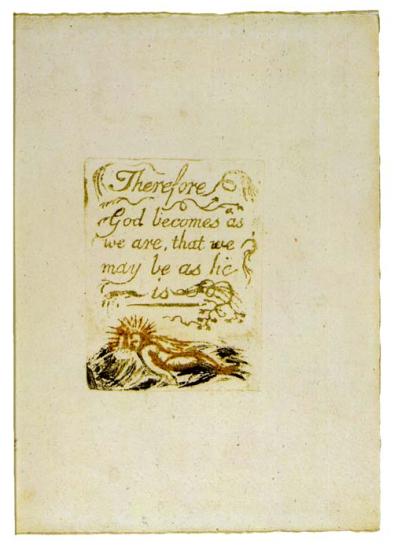
There Is No Natural Religion.
[London]: The author and printer W. Blake, [1788].
Relief etching printed in three colors, some plates heightened with watercolor
Copy G, ca. 1794
Purchased as the gift of Mrs. Landon K. Thorne
This early work in relief etching was once thought to predate Blake's illuminated books. Current scholarship, however, dates it to about 1794. Rather than a sequential narrative, it is a series of aphorisms with emblematic images. Blake developed this relief etching technique for incorporating text and image on one printing surface. In addition to two copies of this work, the Morgan owns one unique plate from copy L, presented by Sir Geoffrey Keynes in 1977. This copy once belonged to Blake's follower Frederick Tatham.
William Blake (1757–1827) occupies a unique place in the history of Western art. His creativity included both the visual and literary arts. In his lifetime he was best known as an engraver; now he is also recognized for his innovative poetry, printmaking, and painting. Blake's keen perception of the political and social climate found expression throughout his work. His strong sense of independence is evident in the complex mythology that he constructed in response to the age of revolution.
Blake was already recognized as an engraver at age twenty-five, when his first volume of poems appeared. At thirty-three, in The Marriage of Heaven and Hell, he audaciously claimed that his birth had marked the origin of a "new heaven" in which his own art would exemplify the creativity prefigured by Milton and Michelangelo. By that time, Blake, in one of his most productive periods, had already produced Songs of Innocence and was at work on a series of illuminated books. In 1818 he met John Linnell, a young painter and engraver, through whom a group of young artists became Blake's followers. Calling themselves the Ancients, they helped perpetuate Blake's influence for generations.
The Morgan's Blake collection—one of this country's most distinguished—began with purchases as early as 1899 by Pierpont Morgan. During the tenure of Charles Ryskamp, director from 1969 to 1986, major gifts almost doubled the size of its Blake holdings. In recent years Ryskamp's own gifts of engravings, letters, and related materials have significantly enriched its scholarly resources.
This online exhibition is presented in conjunction with the exhibition William Blake's World: "A New Heaven Is Begun" on view September 11, 2009, through January 3, 2010.
This exhibition is made possible through the generosity of Fay and Geoffrey Elliott.
There Is No Natural Religion 12
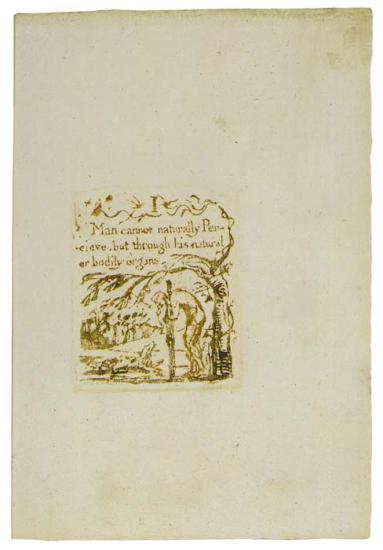
There Is No Natural Religion.
[London]: The author and printer W. Blake, [1788].
Relief etching printed in three colors, some plates heightened with watercolor
Copy G, ca. 1794
Purchased as the gift of Mrs. Landon K. Thorne
This early work in relief etching was once thought to predate Blake's illuminated books. Current scholarship, however, dates it to about 1794. Rather than a sequential narrative, it is a series of aphorisms with emblematic images. Blake developed this relief etching technique for incorporating text and image on one printing surface. In addition to two copies of this work, the Morgan owns one unique plate from copy L, presented by Sir Geoffrey Keynes in 1977. This copy once belonged to Blake's follower Frederick Tatham.
William Blake (1757–1827) occupies a unique place in the history of Western art. His creativity included both the visual and literary arts. In his lifetime he was best known as an engraver; now he is also recognized for his innovative poetry, printmaking, and painting. Blake's keen perception of the political and social climate found expression throughout his work. His strong sense of independence is evident in the complex mythology that he constructed in response to the age of revolution.
Blake was already recognized as an engraver at age twenty-five, when his first volume of poems appeared. At thirty-three, in The Marriage of Heaven and Hell, he audaciously claimed that his birth had marked the origin of a "new heaven" in which his own art would exemplify the creativity prefigured by Milton and Michelangelo. By that time, Blake, in one of his most productive periods, had already produced Songs of Innocence and was at work on a series of illuminated books. In 1818 he met John Linnell, a young painter and engraver, through whom a group of young artists became Blake's followers. Calling themselves the Ancients, they helped perpetuate Blake's influence for generations.
The Morgan's Blake collection—one of this country's most distinguished—began with purchases as early as 1899 by Pierpont Morgan. During the tenure of Charles Ryskamp, director from 1969 to 1986, major gifts almost doubled the size of its Blake holdings. In recent years Ryskamp's own gifts of engravings, letters, and related materials have significantly enriched its scholarly resources.
This online exhibition is presented in conjunction with the exhibition William Blake's World: "A New Heaven Is Begun" on view September 11, 2009, through January 3, 2010.
This exhibition is made possible through the generosity of Fay and Geoffrey Elliott.
The Book of Thel

The Book of Thel.
[London]: The Author & Printer, Willm Blake, 1789.
Relief etchings printed in raw umber with added watercolor
Copy C, printed ca. 1790
Gift of Mrs. Landon K. Thorne, 1972
Although the imprint is dated 1789, scholars believe Thel was unlikely to have been finished before late 1790 or 1791. This is one of seventeen traced copies. The tale of Thel, the virgin shepherdess interviewing a cloud, a lily, a worm, and a clod of clay about the transience of life, is the first of Blake's poems written in lines of fourteen syllables, which became his primary meter thereafter.
William Blake (1757–1827) occupies a unique place in the history of Western art. His creativity included both the visual and literary arts. In his lifetime he was best known as an engraver; now he is also recognized for his innovative poetry, printmaking, and painting. Blake's keen perception of the political and social climate found expression throughout his work. His strong sense of independence is evident in the complex mythology that he constructed in response to the age of revolution.
Blake was already recognized as an engraver at age twenty-five, when his first volume of poems appeared. At thirty-three, in The Marriage of Heaven and Hell, he audaciously claimed that his birth had marked the origin of a "new heaven" in which his own art would exemplify the creativity prefigured by Milton and Michelangelo. By that time, Blake, in one of his most productive periods, had already produced Songs of Innocence and was at work on a series of illuminated books. In 1818 he met John Linnell, a young painter and engraver, through whom a group of young artists became Blake's followers. Calling themselves the Ancients, they helped perpetuate Blake's influence for generations.
The Morgan's Blake collection—one of this country's most distinguished—began with purchases as early as 1899 by Pierpont Morgan. During the tenure of Charles Ryskamp, director from 1969 to 1986, major gifts almost doubled the size of its Blake holdings. In recent years Ryskamp's own gifts of engravings, letters, and related materials have significantly enriched its scholarly resources.
This online exhibition is presented in conjunction with the exhibition William Blake's World: "A New Heaven Is Begun" on view September 11, 2009, through January 3, 2010.
This exhibition is made possible through the generosity of Fay and Geoffrey Elliott.
The Book of Thel 2

The Book of Thel.
[London]: The Author & Printer, Willm Blake, 1789.
Relief etchings printed in raw umber with added watercolor
Copy C, printed ca. 1790
Gift of Mrs. Landon K. Thorne, 1972
Although the imprint is dated 1789, scholars believe Thel was unlikely to have been finished before late 1790 or 1791. This is one of seventeen traced copies. The tale of Thel, the virgin shepherdess interviewing a cloud, a lily, a worm, and a clod of clay about the transience of life, is the first of Blake's poems written in lines of fourteen syllables, which became his primary meter thereafter.
William Blake (1757–1827) occupies a unique place in the history of Western art. His creativity included both the visual and literary arts. In his lifetime he was best known as an engraver; now he is also recognized for his innovative poetry, printmaking, and painting. Blake's keen perception of the political and social climate found expression throughout his work. His strong sense of independence is evident in the complex mythology that he constructed in response to the age of revolution.
Blake was already recognized as an engraver at age twenty-five, when his first volume of poems appeared. At thirty-three, in The Marriage of Heaven and Hell, he audaciously claimed that his birth had marked the origin of a "new heaven" in which his own art would exemplify the creativity prefigured by Milton and Michelangelo. By that time, Blake, in one of his most productive periods, had already produced Songs of Innocence and was at work on a series of illuminated books. In 1818 he met John Linnell, a young painter and engraver, through whom a group of young artists became Blake's followers. Calling themselves the Ancients, they helped perpetuate Blake's influence for generations.
The Morgan's Blake collection—one of this country's most distinguished—began with purchases as early as 1899 by Pierpont Morgan. During the tenure of Charles Ryskamp, director from 1969 to 1986, major gifts almost doubled the size of its Blake holdings. In recent years Ryskamp's own gifts of engravings, letters, and related materials have significantly enriched its scholarly resources.
This online exhibition is presented in conjunction with the exhibition William Blake's World: "A New Heaven Is Begun" on view September 11, 2009, through January 3, 2010.
This exhibition is made possible through the generosity of Fay and Geoffrey Elliott.
The Book of Thel 3

The Book of Thel.
[London]: The Author & Printer, Willm Blake, 1789.
Relief etchings printed in raw umber with added watercolor
Copy C, printed ca. 1790
Gift of Mrs. Landon K. Thorne, 1972
Although the imprint is dated 1789, scholars believe Thel was unlikely to have been finished before late 1790 or 1791. This is one of seventeen traced copies. The tale of Thel, the virgin shepherdess interviewing a cloud, a lily, a worm, and a clod of clay about the transience of life, is the first of Blake's poems written in lines of fourteen syllables, which became his primary meter thereafter.
William Blake (1757–1827) occupies a unique place in the history of Western art. His creativity included both the visual and literary arts. In his lifetime he was best known as an engraver; now he is also recognized for his innovative poetry, printmaking, and painting. Blake's keen perception of the political and social climate found expression throughout his work. His strong sense of independence is evident in the complex mythology that he constructed in response to the age of revolution.
Blake was already recognized as an engraver at age twenty-five, when his first volume of poems appeared. At thirty-three, in The Marriage of Heaven and Hell, he audaciously claimed that his birth had marked the origin of a "new heaven" in which his own art would exemplify the creativity prefigured by Milton and Michelangelo. By that time, Blake, in one of his most productive periods, had already produced Songs of Innocence and was at work on a series of illuminated books. In 1818 he met John Linnell, a young painter and engraver, through whom a group of young artists became Blake's followers. Calling themselves the Ancients, they helped perpetuate Blake's influence for generations.
The Morgan's Blake collection—one of this country's most distinguished—began with purchases as early as 1899 by Pierpont Morgan. During the tenure of Charles Ryskamp, director from 1969 to 1986, major gifts almost doubled the size of its Blake holdings. In recent years Ryskamp's own gifts of engravings, letters, and related materials have significantly enriched its scholarly resources.
This online exhibition is presented in conjunction with the exhibition William Blake's World: "A New Heaven Is Begun" on view September 11, 2009, through January 3, 2010.
This exhibition is made possible through the generosity of Fay and Geoffrey Elliott.
The Book of Thel 4
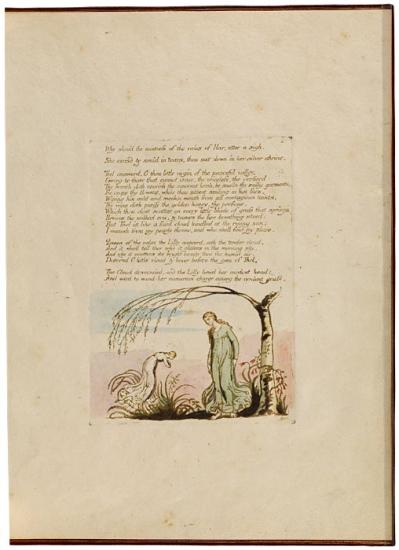
The Book of Thel.
[London]: The Author & Printer, Willm Blake, 1789.
Relief etchings printed in raw umber with added watercolor
Copy C, printed ca. 1790
Gift of Mrs. Landon K. Thorne, 1972
Although the imprint is dated 1789, scholars believe Thel was unlikely to have been finished before late 1790 or 1791. This is one of seventeen traced copies. The tale of Thel, the virgin shepherdess interviewing a cloud, a lily, a worm, and a clod of clay about the transience of life, is the first of Blake's poems written in lines of fourteen syllables, which became his primary meter thereafter.
William Blake (1757–1827) occupies a unique place in the history of Western art. His creativity included both the visual and literary arts. In his lifetime he was best known as an engraver; now he is also recognized for his innovative poetry, printmaking, and painting. Blake's keen perception of the political and social climate found expression throughout his work. His strong sense of independence is evident in the complex mythology that he constructed in response to the age of revolution.
Blake was already recognized as an engraver at age twenty-five, when his first volume of poems appeared. At thirty-three, in The Marriage of Heaven and Hell, he audaciously claimed that his birth had marked the origin of a "new heaven" in which his own art would exemplify the creativity prefigured by Milton and Michelangelo. By that time, Blake, in one of his most productive periods, had already produced Songs of Innocence and was at work on a series of illuminated books. In 1818 he met John Linnell, a young painter and engraver, through whom a group of young artists became Blake's followers. Calling themselves the Ancients, they helped perpetuate Blake's influence for generations.
The Morgan's Blake collection—one of this country's most distinguished—began with purchases as early as 1899 by Pierpont Morgan. During the tenure of Charles Ryskamp, director from 1969 to 1986, major gifts almost doubled the size of its Blake holdings. In recent years Ryskamp's own gifts of engravings, letters, and related materials have significantly enriched its scholarly resources.
This online exhibition is presented in conjunction with the exhibition William Blake's World: "A New Heaven Is Begun" on view September 11, 2009, through January 3, 2010.
This exhibition is made possible through the generosity of Fay and Geoffrey Elliott.
The Book of Thel 5
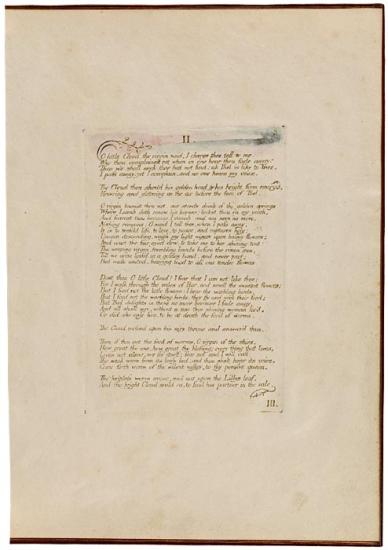
The Book of Thel.
[London]: The Author & Printer, Willm Blake, 1789.
Relief etchings printed in raw umber with added watercolor
Copy C, printed ca. 1790
Gift of Mrs. Landon K. Thorne, 1972
Although the imprint is dated 1789, scholars believe Thel was unlikely to have been finished before late 1790 or 1791. This is one of seventeen traced copies. The tale of Thel, the virgin shepherdess interviewing a cloud, a lily, a worm, and a clod of clay about the transience of life, is the first of Blake's poems written in lines of fourteen syllables, which became his primary meter thereafter.
William Blake (1757–1827) occupies a unique place in the history of Western art. His creativity included both the visual and literary arts. In his lifetime he was best known as an engraver; now he is also recognized for his innovative poetry, printmaking, and painting. Blake's keen perception of the political and social climate found expression throughout his work. His strong sense of independence is evident in the complex mythology that he constructed in response to the age of revolution.
Blake was already recognized as an engraver at age twenty-five, when his first volume of poems appeared. At thirty-three, in The Marriage of Heaven and Hell, he audaciously claimed that his birth had marked the origin of a "new heaven" in which his own art would exemplify the creativity prefigured by Milton and Michelangelo. By that time, Blake, in one of his most productive periods, had already produced Songs of Innocence and was at work on a series of illuminated books. In 1818 he met John Linnell, a young painter and engraver, through whom a group of young artists became Blake's followers. Calling themselves the Ancients, they helped perpetuate Blake's influence for generations.
The Morgan's Blake collection—one of this country's most distinguished—began with purchases as early as 1899 by Pierpont Morgan. During the tenure of Charles Ryskamp, director from 1969 to 1986, major gifts almost doubled the size of its Blake holdings. In recent years Ryskamp's own gifts of engravings, letters, and related materials have significantly enriched its scholarly resources.
This online exhibition is presented in conjunction with the exhibition William Blake's World: "A New Heaven Is Begun" on view September 11, 2009, through January 3, 2010.
This exhibition is made possible through the generosity of Fay and Geoffrey Elliott.
The Book of Thel 6
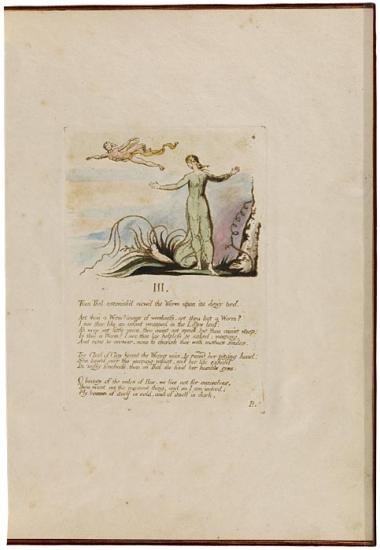
The Book of Thel.
[London]: The Author & Printer, Willm Blake, 1789.
Relief etchings printed in raw umber with added watercolor
Copy C, printed ca. 1790
Gift of Mrs. Landon K. Thorne, 1972
Although the imprint is dated 1789, scholars believe Thel was unlikely to have been finished before late 1790 or 1791. This is one of seventeen traced copies. The tale of Thel, the virgin shepherdess interviewing a cloud, a lily, a worm, and a clod of clay about the transience of life, is the first of Blake's poems written in lines of fourteen syllables, which became his primary meter thereafter.
William Blake (1757–1827) occupies a unique place in the history of Western art. His creativity included both the visual and literary arts. In his lifetime he was best known as an engraver; now he is also recognized for his innovative poetry, printmaking, and painting. Blake's keen perception of the political and social climate found expression throughout his work. His strong sense of independence is evident in the complex mythology that he constructed in response to the age of revolution.
Blake was already recognized as an engraver at age twenty-five, when his first volume of poems appeared. At thirty-three, in The Marriage of Heaven and Hell, he audaciously claimed that his birth had marked the origin of a "new heaven" in which his own art would exemplify the creativity prefigured by Milton and Michelangelo. By that time, Blake, in one of his most productive periods, had already produced Songs of Innocence and was at work on a series of illuminated books. In 1818 he met John Linnell, a young painter and engraver, through whom a group of young artists became Blake's followers. Calling themselves the Ancients, they helped perpetuate Blake's influence for generations.
The Morgan's Blake collection—one of this country's most distinguished—began with purchases as early as 1899 by Pierpont Morgan. During the tenure of Charles Ryskamp, director from 1969 to 1986, major gifts almost doubled the size of its Blake holdings. In recent years Ryskamp's own gifts of engravings, letters, and related materials have significantly enriched its scholarly resources.
This online exhibition is presented in conjunction with the exhibition William Blake's World: "A New Heaven Is Begun" on view September 11, 2009, through January 3, 2010.
This exhibition is made possible through the generosity of Fay and Geoffrey Elliott.
The Book of Thel 7
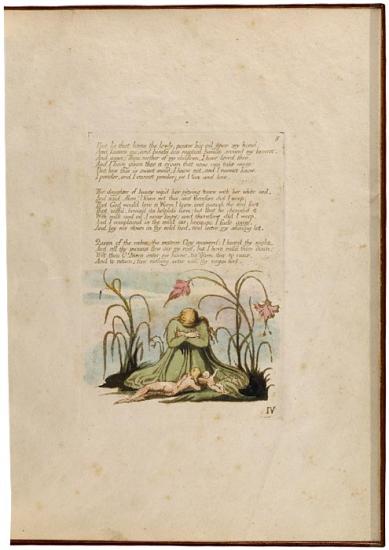
The Book of Thel.
[London]: The Author & Printer, Willm Blake, 1789.
Relief etchings printed in raw umber with added watercolor
Copy C, printed ca. 1790
Gift of Mrs. Landon K. Thorne, 1972
Although the imprint is dated 1789, scholars believe Thel was unlikely to have been finished before late 1790 or 1791. This is one of seventeen traced copies. The tale of Thel, the virgin shepherdess interviewing a cloud, a lily, a worm, and a clod of clay about the transience of life, is the first of Blake's poems written in lines of fourteen syllables, which became his primary meter thereafter.
William Blake (1757–1827) occupies a unique place in the history of Western art. His creativity included both the visual and literary arts. In his lifetime he was best known as an engraver; now he is also recognized for his innovative poetry, printmaking, and painting. Blake's keen perception of the political and social climate found expression throughout his work. His strong sense of independence is evident in the complex mythology that he constructed in response to the age of revolution.
Blake was already recognized as an engraver at age twenty-five, when his first volume of poems appeared. At thirty-three, in The Marriage of Heaven and Hell, he audaciously claimed that his birth had marked the origin of a "new heaven" in which his own art would exemplify the creativity prefigured by Milton and Michelangelo. By that time, Blake, in one of his most productive periods, had already produced Songs of Innocence and was at work on a series of illuminated books. In 1818 he met John Linnell, a young painter and engraver, through whom a group of young artists became Blake's followers. Calling themselves the Ancients, they helped perpetuate Blake's influence for generations.
The Morgan's Blake collection—one of this country's most distinguished—began with purchases as early as 1899 by Pierpont Morgan. During the tenure of Charles Ryskamp, director from 1969 to 1986, major gifts almost doubled the size of its Blake holdings. In recent years Ryskamp's own gifts of engravings, letters, and related materials have significantly enriched its scholarly resources.
This online exhibition is presented in conjunction with the exhibition William Blake's World: "A New Heaven Is Begun" on view September 11, 2009, through January 3, 2010.
This exhibition is made possible through the generosity of Fay and Geoffrey Elliott.
The Book of Thel 8

The Book of Thel.
[London]: The Author & Printer, Willm Blake, 1789.
Relief etchings printed in raw umber with added watercolor
Copy C, printed ca. 1790
Gift of Mrs. Landon K. Thorne, 1972
Although the imprint is dated 1789, scholars believe Thel was unlikely to have been finished before late 1790 or 1791. This is one of seventeen traced copies. The tale of Thel, the virgin shepherdess interviewing a cloud, a lily, a worm, and a clod of clay about the transience of life, is the first of Blake's poems written in lines of fourteen syllables, which became his primary meter thereafter.
William Blake (1757–1827) occupies a unique place in the history of Western art. His creativity included both the visual and literary arts. In his lifetime he was best known as an engraver; now he is also recognized for his innovative poetry, printmaking, and painting. Blake's keen perception of the political and social climate found expression throughout his work. His strong sense of independence is evident in the complex mythology that he constructed in response to the age of revolution.
Blake was already recognized as an engraver at age twenty-five, when his first volume of poems appeared. At thirty-three, in The Marriage of Heaven and Hell, he audaciously claimed that his birth had marked the origin of a "new heaven" in which his own art would exemplify the creativity prefigured by Milton and Michelangelo. By that time, Blake, in one of his most productive periods, had already produced Songs of Innocence and was at work on a series of illuminated books. In 1818 he met John Linnell, a young painter and engraver, through whom a group of young artists became Blake's followers. Calling themselves the Ancients, they helped perpetuate Blake's influence for generations.
The Morgan's Blake collection—one of this country's most distinguished—began with purchases as early as 1899 by Pierpont Morgan. During the tenure of Charles Ryskamp, director from 1969 to 1986, major gifts almost doubled the size of its Blake holdings. In recent years Ryskamp's own gifts of engravings, letters, and related materials have significantly enriched its scholarly resources.
This online exhibition is presented in conjunction with the exhibition William Blake's World: "A New Heaven Is Begun" on view September 11, 2009, through January 3, 2010.
This exhibition is made possible through the generosity of Fay and Geoffrey Elliott.
The Tyger
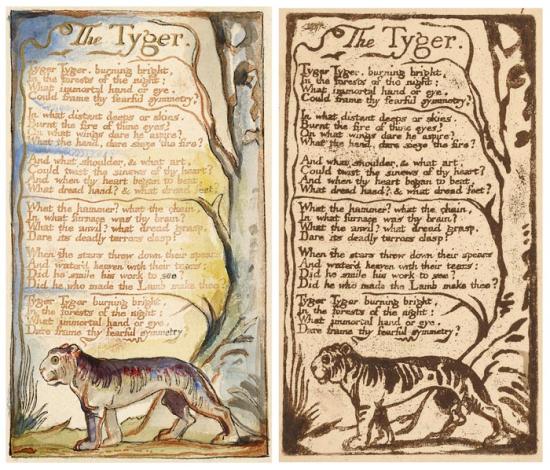
The Tyger.
Plates from two copies of Songs of Innocence and of Experience
Copy K, ca. 1795
Purchased by Pierpont Morgan with the Toovey collection, 1899
"The Tyger" was one of Blake's poems that was known and admired during his lifetime. These two plates are from a copy of Songs of Innocence and of Experience that has plates from two different sets. Blake himself printed and numbered the plate in brown. It is a good example of a relief etching print containing both text and image that also demonstrates the manner in which a plate would be printed in a base color to which watercolor might be added. The second, elaborately colored copy was printed and colored after Blake's death by an unidentified person.
William Blake (1757–1827) occupies a unique place in the history of Western art. His creativity included both the visual and literary arts. In his lifetime he was best known as an engraver; now he is also recognized for his innovative poetry, printmaking, and painting. Blake's keen perception of the political and social climate found expression throughout his work. His strong sense of independence is evident in the complex mythology that he constructed in response to the age of revolution.
Blake was already recognized as an engraver at age twenty-five, when his first volume of poems appeared. At thirty-three, in The Marriage of Heaven and Hell, he audaciously claimed that his birth had marked the origin of a "new heaven" in which his own art would exemplify the creativity prefigured by Milton and Michelangelo. By that time, Blake, in one of his most productive periods, had already produced Songs of Innocence and was at work on a series of illuminated books. In 1818 he met John Linnell, a young painter and engraver, through whom a group of young artists became Blake's followers. Calling themselves the Ancients, they helped perpetuate Blake's influence for generations.
The Morgan's Blake collection—one of this country's most distinguished—began with purchases as early as 1899 by Pierpont Morgan. During the tenure of Charles Ryskamp, director from 1969 to 1986, major gifts almost doubled the size of its Blake holdings. In recent years Ryskamp's own gifts of engravings, letters, and related materials have significantly enriched its scholarly resources.
This online exhibition is presented in conjunction with the exhibition William Blake's World: "A New Heaven Is Begun" on view September 11, 2009, through January 3, 2010.
This exhibition is made possible through the generosity of Fay and Geoffrey Elliott.
The Book of Los
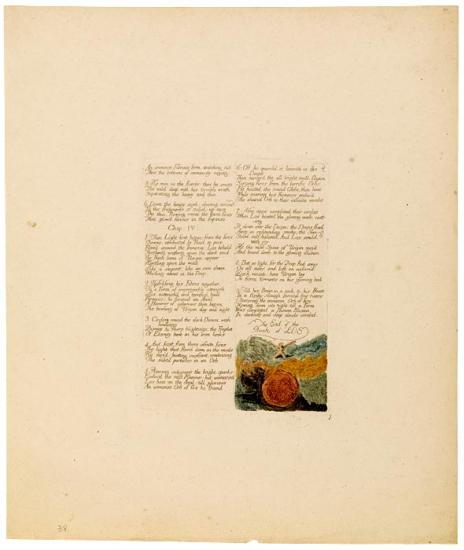
The Book of Los
Intaglio etching, 1795
Plate 5
Purchased as the gift of the Thorne Family and Fellows Fund in memory of Mrs. Landon K. Thorne, 1976
Three works make up the trilogy known as the Bibles of Hell. The other titles in this series are The First Book of Urizen and The Book of Ahania. This single plate is from the Book of Los, whose topic is the creation from Los's point of view. The double-column text is also characteristic of Urizen, which hangs nearby. The only complete copy of The Book of Los is in the British Museum. The Morgan has two plates—this one and plate 4—and a single plate from Ahania.
William Blake (1757–1827) occupies a unique place in the history of Western art. His creativity included both the visual and literary arts. In his lifetime he was best known as an engraver; now he is also recognized for his innovative poetry, printmaking, and painting. Blake's keen perception of the political and social climate found expression throughout his work. His strong sense of independence is evident in the complex mythology that he constructed in response to the age of revolution.
Blake was already recognized as an engraver at age twenty-five, when his first volume of poems appeared. At thirty-three, in The Marriage of Heaven and Hell, he audaciously claimed that his birth had marked the origin of a "new heaven" in which his own art would exemplify the creativity prefigured by Milton and Michelangelo. By that time, Blake, in one of his most productive periods, had already produced Songs of Innocence and was at work on a series of illuminated books. In 1818 he met John Linnell, a young painter and engraver, through whom a group of young artists became Blake's followers. Calling themselves the Ancients, they helped perpetuate Blake's influence for generations.
The Morgan's Blake collection—one of this country's most distinguished—began with purchases as early as 1899 by Pierpont Morgan. During the tenure of Charles Ryskamp, director from 1969 to 1986, major gifts almost doubled the size of its Blake holdings. In recent years Ryskamp's own gifts of engravings, letters, and related materials have significantly enriched its scholarly resources.
This online exhibition is presented in conjunction with the exhibition William Blake's World: "A New Heaven Is Begun" on view September 11, 2009, through January 3, 2010.
This exhibition is made possible through the generosity of Fay and Geoffrey Elliott.
A Descriptive Catalogue of Pictures, Poetical and Historical Inventions Painted by William Blake

A Descriptive Catalogue of Pictures, Poetical and Historical Inventions Painted by William Blake
. . . . London: Printed by D.N. Shury . . . for J. Blake, 1809.
Copy P
Gift of Mrs. Landon K. Thorne, 1972
Shortly after a quarrel with the publisher R. H. Cromek regarding a commission for an engraving of the Canterbury Pilgrims, Blake painted his own version and announced that he planned to engrave it. He exhibited it along with fifteen other drawings at his brother's shop in Soho in spring 1809. This slight catalogue of the exhibition contains descriptions of each work. For the Pilgrims, however, he devoted a twenty-eight page analysis of the characters as he understood Chaucer's descriptions; Charles Lamb (1775–1834) thought it very good Chaucer criticism. Only sixteen copies of this booklet survive. This copy was given to the Ancient Frederick Tatham some fifteen years later, when he and Blake met.
William Blake (1757–1827) occupies a unique place in the history of Western art. His creativity included both the visual and literary arts. In his lifetime he was best known as an engraver; now he is also recognized for his innovative poetry, printmaking, and painting. Blake's keen perception of the political and social climate found expression throughout his work. His strong sense of independence is evident in the complex mythology that he constructed in response to the age of revolution.
Blake was already recognized as an engraver at age twenty-five, when his first volume of poems appeared. At thirty-three, in The Marriage of Heaven and Hell, he audaciously claimed that his birth had marked the origin of a "new heaven" in which his own art would exemplify the creativity prefigured by Milton and Michelangelo. By that time, Blake, in one of his most productive periods, had already produced Songs of Innocence and was at work on a series of illuminated books. In 1818 he met John Linnell, a young painter and engraver, through whom a group of young artists became Blake's followers. Calling themselves the Ancients, they helped perpetuate Blake's influence for generations.
The Morgan's Blake collection—one of this country's most distinguished—began with purchases as early as 1899 by Pierpont Morgan. During the tenure of Charles Ryskamp, director from 1969 to 1986, major gifts almost doubled the size of its Blake holdings. In recent years Ryskamp's own gifts of engravings, letters, and related materials have significantly enriched its scholarly resources.
This online exhibition is presented in conjunction with the exhibition William Blake's World: "A New Heaven Is Begun" on view September 11, 2009, through January 3, 2010.
This exhibition is made possible through the generosity of Fay and Geoffrey Elliott.
The Prologue and Characters of Chaucer's Pilgrims
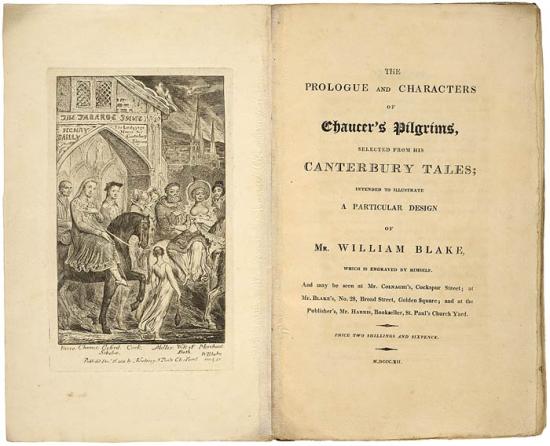
The Prologue and Characters of Chaucer's Pilgrims . . . intended to illustrate a particular design of Mr. William Blake which is Engraved by Himself.
[London: G. Smeeton], M.DCCC.XII, [1812].
Gift of Mrs. Landon K. Thorne, 1972
This slight work was an effort to build a market for the Canterbury Pilgrims engraving. It presents the Prologue to the Canterbury Tales and the descriptions of each of the twenty-nine pilgrims, along with contemporary translations. "The Editor" offered readers the opportunity to compare "the heads, as represented by Mr. Blake . . . with the lineaments drawn by Chaucer, and . . . the merit of the Artist will be generally acknowledged." The goal was to bring the print "to the notice of the Encouragers of Art." At least four states of the engraving were produced from about 1810 to 1823. Nevertheless, there were few buyers.
William Blake (1757–1827) occupies a unique place in the history of Western art. His creativity included both the visual and literary arts. In his lifetime he was best known as an engraver; now he is also recognized for his innovative poetry, printmaking, and painting. Blake's keen perception of the political and social climate found expression throughout his work. His strong sense of independence is evident in the complex mythology that he constructed in response to the age of revolution.
Blake was already recognized as an engraver at age twenty-five, when his first volume of poems appeared. At thirty-three, in The Marriage of Heaven and Hell, he audaciously claimed that his birth had marked the origin of a "new heaven" in which his own art would exemplify the creativity prefigured by Milton and Michelangelo. By that time, Blake, in one of his most productive periods, had already produced Songs of Innocence and was at work on a series of illuminated books. In 1818 he met John Linnell, a young painter and engraver, through whom a group of young artists became Blake's followers. Calling themselves the Ancients, they helped perpetuate Blake's influence for generations.
The Morgan's Blake collection—one of this country's most distinguished—began with purchases as early as 1899 by Pierpont Morgan. During the tenure of Charles Ryskamp, director from 1969 to 1986, major gifts almost doubled the size of its Blake holdings. In recent years Ryskamp's own gifts of engravings, letters, and related materials have significantly enriched its scholarly resources.
This online exhibition is presented in conjunction with the exhibition William Blake's World: "A New Heaven Is Begun" on view September 11, 2009, through January 3, 2010.
This exhibition is made possible through the generosity of Fay and Geoffrey Elliott.
On Homer's Poetry [and] On Virgil
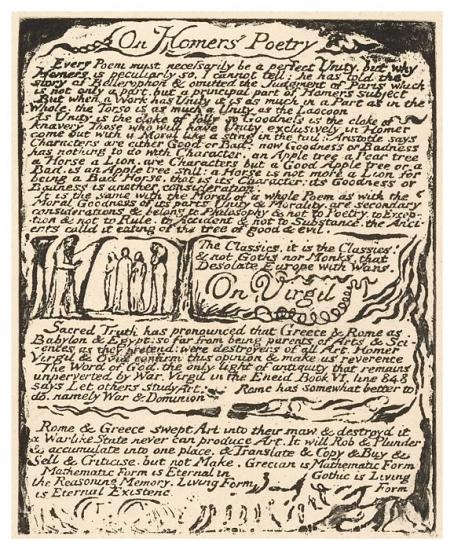
On Homer's Poetry [and] On Virgil
Relief etching
Copy F
Purchased by Pierpont Morgan in 1906
One of only six copies, this is one of Blake's late illuminated works. The first brief piece questions the impact of classical culture on morality and the arts. The second addresses the detrimental effect of war on the creative arts in ancient Greece and Rome.
William Blake (1757–1827) occupies a unique place in the history of Western art. His creativity included both the visual and literary arts. In his lifetime he was best known as an engraver; now he is also recognized for his innovative poetry, printmaking, and painting. Blake's keen perception of the political and social climate found expression throughout his work. His strong sense of independence is evident in the complex mythology that he constructed in response to the age of revolution.
Blake was already recognized as an engraver at age twenty-five, when his first volume of poems appeared. At thirty-three, in The Marriage of Heaven and Hell, he audaciously claimed that his birth had marked the origin of a "new heaven" in which his own art would exemplify the creativity prefigured by Milton and Michelangelo. By that time, Blake, in one of his most productive periods, had already produced Songs of Innocence and was at work on a series of illuminated books. In 1818 he met John Linnell, a young painter and engraver, through whom a group of young artists became Blake's followers. Calling themselves the Ancients, they helped perpetuate Blake's influence for generations.
The Morgan's Blake collection—one of this country's most distinguished—began with purchases as early as 1899 by Pierpont Morgan. During the tenure of Charles Ryskamp, director from 1969 to 1986, major gifts almost doubled the size of its Blake holdings. In recent years Ryskamp's own gifts of engravings, letters, and related materials have significantly enriched its scholarly resources.
This online exhibition is presented in conjunction with the exhibition William Blake's World: "A New Heaven Is Begun" on view September 11, 2009, through January 3, 2010.
This exhibition is made possible through the generosity of Fay and Geoffrey Elliott.
Autograph letter to Mrs. John Flaxman 1
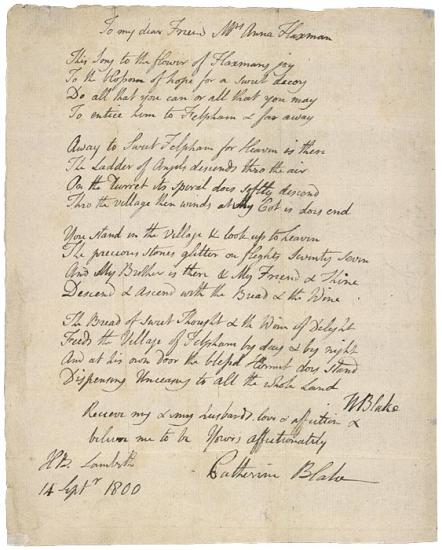
Autograph letter, dated Lambeth, 14 September 1800, to Mrs. John Flaxman, in the hand of William Blake.
Purchased by Pierpont Morgan, 1906
Blake and the sculptor John Flaxman became friends as students at the Royal Academy. This letter to Mrs. Flaxman from Mrs. Blake, who was probably illiterate, was written only a few days before the Blakes moved from Lambeth to Felpham. Blake's poem, shown on the left, is an invitation for them to come for a visit, "Away to Sweet Felpham for Heaven is there / The Ladder of angels descends thro the air."
The first page of the letter has been reproduced on old paper and laid to the side.
William Blake (1757–1827) occupies a unique place in the history of Western art. His creativity included both the visual and literary arts. In his lifetime he was best known as an engraver; now he is also recognized for his innovative poetry, printmaking, and painting. Blake's keen perception of the political and social climate found expression throughout his work. His strong sense of independence is evident in the complex mythology that he constructed in response to the age of revolution.
Blake was already recognized as an engraver at age twenty-five, when his first volume of poems appeared. At thirty-three, in The Marriage of Heaven and Hell, he audaciously claimed that his birth had marked the origin of a "new heaven" in which his own art would exemplify the creativity prefigured by Milton and Michelangelo. By that time, Blake, in one of his most productive periods, had already produced Songs of Innocence and was at work on a series of illuminated books. In 1818 he met John Linnell, a young painter and engraver, through whom a group of young artists became Blake's followers. Calling themselves the Ancients, they helped perpetuate Blake's influence for generations.
The Morgan's Blake collection—one of this country's most distinguished—began with purchases as early as 1899 by Pierpont Morgan. During the tenure of Charles Ryskamp, director from 1969 to 1986, major gifts almost doubled the size of its Blake holdings. In recent years Ryskamp's own gifts of engravings, letters, and related materials have significantly enriched its scholarly resources.
This online exhibition is presented in conjunction with the exhibition William Blake's World: "A New Heaven Is Begun" on view September 11, 2009, through January 3, 2010.
This exhibition is made possible through the generosity of Fay and Geoffrey Elliott.
Autograph letter to Mrs. John Flaxman 2
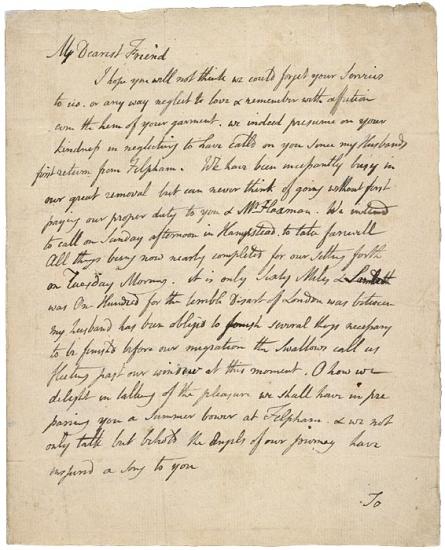
Autograph letter, dated Lambeth, 14 September 1800, to Mrs. John Flaxman, in the hand of William Blake.
Purchased by Pierpont Morgan, 1906
Blake and the sculptor John Flaxman became friends as students at the Royal Academy. This letter to Mrs. Flaxman from Mrs. Blake, who was probably illiterate, was written only a few days before the Blakes moved from Lambeth to Felpham. Blake's poem, shown on the left, is an invitation for them to come for a visit, "Away to Sweet Felpham for Heaven is there / The Ladder of angels descends thro the air."
The first page of the letter has been reproduced on old paper and laid to the side.
William Blake (1757–1827) occupies a unique place in the history of Western art. His creativity included both the visual and literary arts. In his lifetime he was best known as an engraver; now he is also recognized for his innovative poetry, printmaking, and painting. Blake's keen perception of the political and social climate found expression throughout his work. His strong sense of independence is evident in the complex mythology that he constructed in response to the age of revolution.
Blake was already recognized as an engraver at age twenty-five, when his first volume of poems appeared. At thirty-three, in The Marriage of Heaven and Hell, he audaciously claimed that his birth had marked the origin of a "new heaven" in which his own art would exemplify the creativity prefigured by Milton and Michelangelo. By that time, Blake, in one of his most productive periods, had already produced Songs of Innocence and was at work on a series of illuminated books. In 1818 he met John Linnell, a young painter and engraver, through whom a group of young artists became Blake's followers. Calling themselves the Ancients, they helped perpetuate Blake's influence for generations.
The Morgan's Blake collection—one of this country's most distinguished—began with purchases as early as 1899 by Pierpont Morgan. During the tenure of Charles Ryskamp, director from 1969 to 1986, major gifts almost doubled the size of its Blake holdings. In recent years Ryskamp's own gifts of engravings, letters, and related materials have significantly enriched its scholarly resources.
This online exhibition is presented in conjunction with the exhibition William Blake's World: "A New Heaven Is Begun" on view September 11, 2009, through January 3, 2010.
This exhibition is made possible through the generosity of Fay and Geoffrey Elliott.
Songs of Innocence

Songs of Innocence.
[London]: The Author & Printer W. Blake, [1789].
Relief-printed etchings with added watercolor
2 of 31 illustrations on 17 leaves
Copy D, assembled ca. 1794
Bequest of Tessie Jones in memory of her father, Herschel V. Jones, 1968
This copy, printed in yellow ocher with added watercolor, was assembled for the Blakes' friends John and Anna Flaxman for their return from Italy in late 1794. It is one of the sixteen (or perhaps seventeen) copies from the original printing. The pastoral world represented by children and shepherds evokes the essence of innocence. The double-page design of Spring demonstrates Blake's artistry for combining text and image.
William Blake (1757–1827) occupies a unique place in the history of Western art. His creativity included both the visual and literary arts. In his lifetime he was best known as an engraver; now he is also recognized for his innovative poetry, printmaking, and painting. Blake's keen perception of the political and social climate found expression throughout his work. His strong sense of independence is evident in the complex mythology that he constructed in response to the age of revolution.
Blake was already recognized as an engraver at age twenty-five, when his first volume of poems appeared. At thirty-three, in The Marriage of Heaven and Hell, he audaciously claimed that his birth had marked the origin of a "new heaven" in which his own art would exemplify the creativity prefigured by Milton and Michelangelo. By that time, Blake, in one of his most productive periods, had already produced Songs of Innocence and was at work on a series of illuminated books. In 1818 he met John Linnell, a young painter and engraver, through whom a group of young artists became Blake's followers. Calling themselves the Ancients, they helped perpetuate Blake's influence for generations.
The Morgan's Blake collection—one of this country's most distinguished—began with purchases as early as 1899 by Pierpont Morgan. During the tenure of Charles Ryskamp, director from 1969 to 1986, major gifts almost doubled the size of its Blake holdings. In recent years Ryskamp's own gifts of engravings, letters, and related materials have significantly enriched its scholarly resources.
This online exhibition is presented in conjunction with the exhibition William Blake's World: "A New Heaven Is Begun" on view September 11, 2009, through January 3, 2010.
This exhibition is made possible through the generosity of Fay and Geoffrey Elliott.
Songs of Innocence 2

Songs of Innocence.
[London]: The Author & Printer W. Blake, [1789].
Relief-printed etchings with added watercolor
31 illustrations on 17 leaves
Copy D, assembled ca. 1794
Bequest of Tessie Jones in memory of her father, Herschel V. Jones, 1968
This copy, printed in yellow ocher with added watercolor, was assembled for the Blakes' friends John and Anna Flaxman for their return from Italy in late 1794. It is one of the sixteen (or perhaps seventeen) copies from the original printing. The pastoral world represented by children and shepherds evokes the essence of innocence. The double-page design of Spring demonstrates Blake's artistry for combining text and image.
William Blake (1757–1827) occupies a unique place in the history of Western art. His creativity included both the visual and literary arts. In his lifetime he was best known as an engraver; now he is also recognized for his innovative poetry, printmaking, and painting. Blake's keen perception of the political and social climate found expression throughout his work. His strong sense of independence is evident in the complex mythology that he constructed in response to the age of revolution.
Blake was already recognized as an engraver at age twenty-five, when his first volume of poems appeared. At thirty-three, in The Marriage of Heaven and Hell, he audaciously claimed that his birth had marked the origin of a "new heaven" in which his own art would exemplify the creativity prefigured by Milton and Michelangelo. By that time, Blake, in one of his most productive periods, had already produced Songs of Innocence and was at work on a series of illuminated books. In 1818 he met John Linnell, a young painter and engraver, through whom a group of young artists became Blake's followers. Calling themselves the Ancients, they helped perpetuate Blake's influence for generations.
The Morgan's Blake collection—one of this country's most distinguished—began with purchases as early as 1899 by Pierpont Morgan. During the tenure of Charles Ryskamp, director from 1969 to 1986, major gifts almost doubled the size of its Blake holdings. In recent years Ryskamp's own gifts of engravings, letters, and related materials have significantly enriched its scholarly resources.
This online exhibition is presented in conjunction with the exhibition William Blake's World: "A New Heaven Is Begun" on view September 11, 2009, through January 3, 2010.
This exhibition is made possible through the generosity of Fay and Geoffrey Elliott.
Songs of Innocence 7

Songs of Innocence.
[London]: The Author & Printer W. Blake, [1789].
Relief-printed etchings with added watercolor
31 illustrations on 17 leaves
Copy D, assembled ca. 1794
Bequest of Tessie Jones in memory of her father, Herschel V. Jones, 1968
This copy, printed in yellow ocher with added watercolor, was assembled for the Blakes' friends John and Anna Flaxman for their return from Italy in late 1794. It is one of the sixteen (or perhaps seventeen) copies from the original printing. The pastoral world represented by children and shepherds evokes the essence of innocence. The double-page design of Spring demonstrates Blake's artistry for combining text and image.
William Blake (1757–1827) occupies a unique place in the history of Western art. His creativity included both the visual and literary arts. In his lifetime he was best known as an engraver; now he is also recognized for his innovative poetry, printmaking, and painting. Blake's keen perception of the political and social climate found expression throughout his work. His strong sense of independence is evident in the complex mythology that he constructed in response to the age of revolution.
Blake was already recognized as an engraver at age twenty-five, when his first volume of poems appeared. At thirty-three, in The Marriage of Heaven and Hell, he audaciously claimed that his birth had marked the origin of a "new heaven" in which his own art would exemplify the creativity prefigured by Milton and Michelangelo. By that time, Blake, in one of his most productive periods, had already produced Songs of Innocence and was at work on a series of illuminated books. In 1818 he met John Linnell, a young painter and engraver, through whom a group of young artists became Blake's followers. Calling themselves the Ancients, they helped perpetuate Blake's influence for generations.
The Morgan's Blake collection—one of this country's most distinguished—began with purchases as early as 1899 by Pierpont Morgan. During the tenure of Charles Ryskamp, director from 1969 to 1986, major gifts almost doubled the size of its Blake holdings. In recent years Ryskamp's own gifts of engravings, letters, and related materials have significantly enriched its scholarly resources.
This online exhibition is presented in conjunction with the exhibition William Blake's World: "A New Heaven Is Begun" on view September 11, 2009, through January 3, 2010.
This exhibition is made possible through the generosity of Fay and Geoffrey Elliott.
Songs of Innocence 3

Songs of Innocence.
[London]: The Author & Printer W. Blake, [1789].
Relief-printed etchings with added watercolor
31 illustrations on 17 leaves
Copy D, assembled ca. 1794
Bequest of Tessie Jones in memory of her father, Herschel V. Jones, 1968
This copy, printed in yellow ocher with added watercolor, was assembled for the Blakes' friends John and Anna Flaxman for their return from Italy in late 1794. It is one of the sixteen (or perhaps seventeen) copies from the original printing. The pastoral world represented by children and shepherds evokes the essence of innocence. The double-page design of Spring demonstrates Blake's artistry for combining text and image.
William Blake (1757–1827) occupies a unique place in the history of Western art. His creativity included both the visual and literary arts. In his lifetime he was best known as an engraver; now he is also recognized for his innovative poetry, printmaking, and painting. Blake's keen perception of the political and social climate found expression throughout his work. His strong sense of independence is evident in the complex mythology that he constructed in response to the age of revolution.
Blake was already recognized as an engraver at age twenty-five, when his first volume of poems appeared. At thirty-three, in The Marriage of Heaven and Hell, he audaciously claimed that his birth had marked the origin of a "new heaven" in which his own art would exemplify the creativity prefigured by Milton and Michelangelo. By that time, Blake, in one of his most productive periods, had already produced Songs of Innocence and was at work on a series of illuminated books. In 1818 he met John Linnell, a young painter and engraver, through whom a group of young artists became Blake's followers. Calling themselves the Ancients, they helped perpetuate Blake's influence for generations.
The Morgan's Blake collection—one of this country's most distinguished—began with purchases as early as 1899 by Pierpont Morgan. During the tenure of Charles Ryskamp, director from 1969 to 1986, major gifts almost doubled the size of its Blake holdings. In recent years Ryskamp's own gifts of engravings, letters, and related materials have significantly enriched its scholarly resources.
This online exhibition is presented in conjunction with the exhibition William Blake's World: "A New Heaven Is Begun" on view September 11, 2009, through January 3, 2010.
Songs of Innocence 8
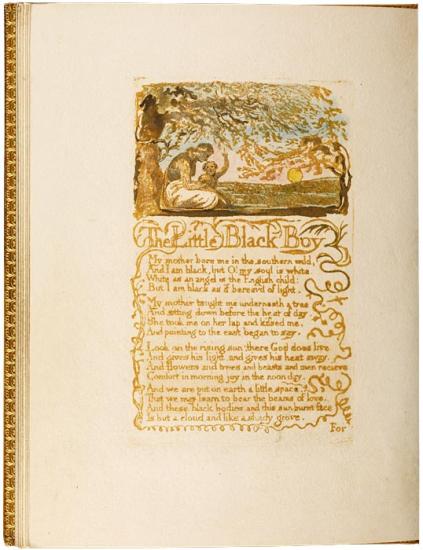
Songs of Innocence.
[London]: The Author & Printer W. Blake, [1789].
Relief-printed etchings with added watercolor
31 illustrations on 17 leaves
Copy D, assembled ca. 1794
Bequest of Tessie Jones in memory of her father, Herschel V. Jones, 1968
This copy, printed in yellow ocher with added watercolor, was assembled for the Blakes' friends John and Anna Flaxman for their return from Italy in late 1794. It is one of the sixteen (or perhaps seventeen) copies from the original printing. The pastoral world represented by children and shepherds evokes the essence of innocence. The double-page design of Spring demonstrates Blake's artistry for combining text and image.
William Blake (1757–1827) occupies a unique place in the history of Western art. His creativity included both the visual and literary arts. In his lifetime he was best known as an engraver; now he is also recognized for his innovative poetry, printmaking, and painting. Blake's keen perception of the political and social climate found expression throughout his work. His strong sense of independence is evident in the complex mythology that he constructed in response to the age of revolution.
Blake was already recognized as an engraver at age twenty-five, when his first volume of poems appeared. At thirty-three, in The Marriage of Heaven and Hell, he audaciously claimed that his birth had marked the origin of a "new heaven" in which his own art would exemplify the creativity prefigured by Milton and Michelangelo. By that time, Blake, in one of his most productive periods, had already produced Songs of Innocence and was at work on a series of illuminated books. In 1818 he met John Linnell, a young painter and engraver, through whom a group of young artists became Blake's followers. Calling themselves the Ancients, they helped perpetuate Blake's influence for generations.
The Morgan's Blake collection—one of this country's most distinguished—began with purchases as early as 1899 by Pierpont Morgan. During the tenure of Charles Ryskamp, director from 1969 to 1986, major gifts almost doubled the size of its Blake holdings. In recent years Ryskamp's own gifts of engravings, letters, and related materials have significantly enriched its scholarly resources.
This online exhibition is presented in conjunction with the exhibition William Blake's World: "A New Heaven Is Begun" on view September 11, 2009, through January 3, 2010.
This exhibition is made possible through the generosity of Fay and Geoffrey Elliott.
Songs of Innocence 4
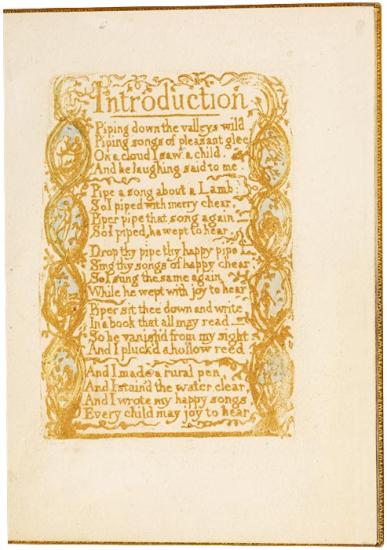
Songs of Innocence.
[London]: The Author & Printer W. Blake, [1789].
Relief-printed etchings with added watercolor
31 illustrations on 17 leaves
Copy D, assembled ca. 1794
Bequest of Tessie Jones in memory of her father, Herschel V. Jones, 1968
This copy, printed in yellow ocher with added watercolor, was assembled for the Blakes' friends John and Anna Flaxman for their return from Italy in late 1794. It is one of the sixteen (or perhaps seventeen) copies from the original printing. The pastoral world represented by children and shepherds evokes the essence of innocence. The double-page design of Spring demonstrates Blake's artistry for combining text and image.
William Blake (1757–1827) occupies a unique place in the history of Western art. His creativity included both the visual and literary arts. In his lifetime he was best known as an engraver; now he is also recognized for his innovative poetry, printmaking, and painting. Blake's keen perception of the political and social climate found expression throughout his work. His strong sense of independence is evident in the complex mythology that he constructed in response to the age of revolution.
Blake was already recognized as an engraver at age twenty-five, when his first volume of poems appeared. At thirty-three, in The Marriage of Heaven and Hell, he audaciously claimed that his birth had marked the origin of a "new heaven" in which his own art would exemplify the creativity prefigured by Milton and Michelangelo. By that time, Blake, in one of his most productive periods, had already produced Songs of Innocence and was at work on a series of illuminated books. In 1818 he met John Linnell, a young painter and engraver, through whom a group of young artists became Blake's followers. Calling themselves the Ancients, they helped perpetuate Blake's influence for generations.
The Morgan's Blake collection—one of this country's most distinguished—began with purchases as early as 1899 by Pierpont Morgan. During the tenure of Charles Ryskamp, director from 1969 to 1986, major gifts almost doubled the size of its Blake holdings. In recent years Ryskamp's own gifts of engravings, letters, and related materials have significantly enriched its scholarly resources.
This online exhibition is presented in conjunction with the exhibition William Blake's World: "A New Heaven Is Begun" on view September 11, 2009, through January 3, 2010.
This exhibition is made possible through the generosity of Fay and Geoffrey Elliott.
Songs of Innocence 9

Songs of Innocence.
[London]: The Author & Printer W. Blake, [1789].
Relief-printed etchings with added watercolor
31 illustrations on 17 leaves
Copy D, assembled ca. 1794
Bequest of Tessie Jones in memory of her father, Herschel V. Jones, 1968
This copy, printed in yellow ocher with added watercolor, was assembled for the Blakes' friends John and Anna Flaxman for their return from Italy in late 1794. It is one of the sixteen (or perhaps seventeen) copies from the original printing. The pastoral world represented by children and shepherds evokes the essence of innocence. The double-page design of Spring demonstrates Blake's artistry for combining text and image.
William Blake (1757–1827) occupies a unique place in the history of Western art. His creativity included both the visual and literary arts. In his lifetime he was best known as an engraver; now he is also recognized for his innovative poetry, printmaking, and painting. Blake's keen perception of the political and social climate found expression throughout his work. His strong sense of independence is evident in the complex mythology that he constructed in response to the age of revolution.
Blake was already recognized as an engraver at age twenty-five, when his first volume of poems appeared. At thirty-three, in The Marriage of Heaven and Hell, he audaciously claimed that his birth had marked the origin of a "new heaven" in which his own art would exemplify the creativity prefigured by Milton and Michelangelo. By that time, Blake, in one of his most productive periods, had already produced Songs of Innocence and was at work on a series of illuminated books. In 1818 he met John Linnell, a young painter and engraver, through whom a group of young artists became Blake's followers. Calling themselves the Ancients, they helped perpetuate Blake's influence for generations.
The Morgan's Blake collection—one of this country's most distinguished—began with purchases as early as 1899 by Pierpont Morgan. During the tenure of Charles Ryskamp, director from 1969 to 1986, major gifts almost doubled the size of its Blake holdings. In recent years Ryskamp's own gifts of engravings, letters, and related materials have significantly enriched its scholarly resources.
This online exhibition is presented in conjunction with the exhibition William Blake's World: "A New Heaven Is Begun" on view September 11, 2009, through January 3, 2010.
This exhibition is made possible through the generosity of Fay and Geoffrey Elliott.
Songs of Innocence 10
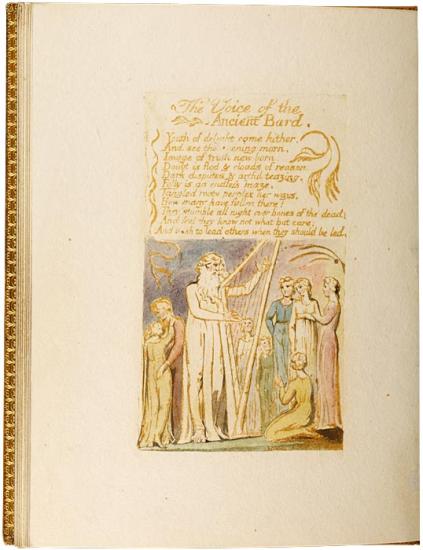
Songs of Innocence.
[London]: The Author & Printer W. Blake, [1789].
Relief-printed etchings with added watercolor
31 illustrations on 17 leaves
Copy D, assembled ca. 1794
Bequest of Tessie Jones in memory of her father, Herschel V. Jones, 1968
This copy, printed in yellow ocher with added watercolor, was assembled for the Blakes' friends John and Anna Flaxman for their return from Italy in late 1794. It is one of the sixteen (or perhaps seventeen) copies from the original printing. The pastoral world represented by children and shepherds evokes the essence of innocence. The double-page design of Spring demonstrates Blake's artistry for combining text and image.
William Blake (1757–1827) occupies a unique place in the history of Western art. His creativity included both the visual and literary arts. In his lifetime he was best known as an engraver; now he is also recognized for his innovative poetry, printmaking, and painting. Blake's keen perception of the political and social climate found expression throughout his work. His strong sense of independence is evident in the complex mythology that he constructed in response to the age of revolution.
Blake was already recognized as an engraver at age twenty-five, when his first volume of poems appeared. At thirty-three, in The Marriage of Heaven and Hell, he audaciously claimed that his birth had marked the origin of a "new heaven" in which his own art would exemplify the creativity prefigured by Milton and Michelangelo. By that time, Blake, in one of his most productive periods, had already produced Songs of Innocence and was at work on a series of illuminated books. In 1818 he met John Linnell, a young painter and engraver, through whom a group of young artists became Blake's followers. Calling themselves the Ancients, they helped perpetuate Blake's influence for generations.
The Morgan's Blake collection—one of this country's most distinguished—began with purchases as early as 1899 by Pierpont Morgan. During the tenure of Charles Ryskamp, director from 1969 to 1986, major gifts almost doubled the size of its Blake holdings. In recent years Ryskamp's own gifts of engravings, letters, and related materials have significantly enriched its scholarly resources.
This online exhibition is presented in conjunction with the exhibition William Blake's World: "A New Heaven Is Begun" on view September 11, 2009, through January 3, 2010.
This exhibition is made possible through the generosity of Fay and Geoffrey Elliott.
Songs of Innocence 5
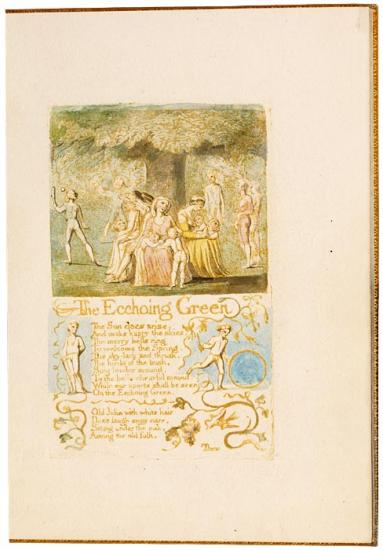
Songs of Innocence.
[London]: The Author & Printer W. Blake, [1789].
Relief-printed etchings with added watercolor
31 illustrations on 17 leaves
Copy D, assembled ca. 1794
Bequest of Tessie Jones in memory of her father, Herschel V. Jones, 1968
This copy, printed in yellow ocher with added watercolor, was assembled for the Blakes' friends John and Anna Flaxman for their return from Italy in late 1794. It is one of the sixteen (or perhaps seventeen) copies from the original printing. The pastoral world represented by children and shepherds evokes the essence of innocence. The double-page design of Spring demonstrates Blake's artistry for combining text and image.
William Blake (1757–1827) occupies a unique place in the history of Western art. His creativity included both the visual and literary arts. In his lifetime he was best known as an engraver; now he is also recognized for his innovative poetry, printmaking, and painting. Blake's keen perception of the political and social climate found expression throughout his work. His strong sense of independence is evident in the complex mythology that he constructed in response to the age of revolution.
Blake was already recognized as an engraver at age twenty-five, when his first volume of poems appeared. At thirty-three, in The Marriage of Heaven and Hell, he audaciously claimed that his birth had marked the origin of a "new heaven" in which his own art would exemplify the creativity prefigured by Milton and Michelangelo. By that time, Blake, in one of his most productive periods, had already produced Songs of Innocence and was at work on a series of illuminated books. In 1818 he met John Linnell, a young painter and engraver, through whom a group of young artists became Blake's followers. Calling themselves the Ancients, they helped perpetuate Blake's influence for generations.
The Morgan's Blake collection—one of this country's most distinguished—began with purchases as early as 1899 by Pierpont Morgan. During the tenure of Charles Ryskamp, director from 1969 to 1986, major gifts almost doubled the size of its Blake holdings. In recent years Ryskamp's own gifts of engravings, letters, and related materials have significantly enriched its scholarly resources.
This online exhibition is presented in conjunction with the exhibition William Blake's World: "A New Heaven Is Begun" on view September 11, 2009, through January 3, 2010.
This exhibition is made possible through the generosity of Fay and Geoffrey Elliott.
Songs of Innocence 11
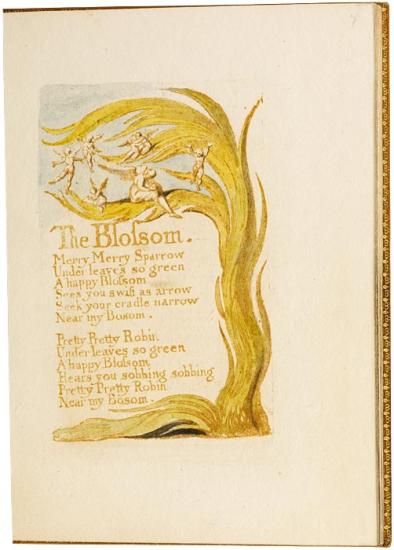
Songs of Innocence.
[London]: The Author & Printer W. Blake, [1789].
Relief-printed etchings with added watercolor
31 illustrations on 17 leaves
Copy D, assembled ca. 1794
Bequest of Tessie Jones in memory of her father, Herschel V. Jones, 1968
This copy, printed in yellow ocher with added watercolor, was assembled for the Blakes' friends John and Anna Flaxman for their return from Italy in late 1794. It is one of the sixteen (or perhaps seventeen) copies from the original printing. The pastoral world represented by children and shepherds evokes the essence of innocence. The double-page design of Spring demonstrates Blake's artistry for combining text and image.
William Blake (1757–1827) occupies a unique place in the history of Western art. His creativity included both the visual and literary arts. In his lifetime he was best known as an engraver; now he is also recognized for his innovative poetry, printmaking, and painting. Blake's keen perception of the political and social climate found expression throughout his work. His strong sense of independence is evident in the complex mythology that he constructed in response to the age of revolution.
Blake was already recognized as an engraver at age twenty-five, when his first volume of poems appeared. At thirty-three, in The Marriage of Heaven and Hell, he audaciously claimed that his birth had marked the origin of a "new heaven" in which his own art would exemplify the creativity prefigured by Milton and Michelangelo. By that time, Blake, in one of his most productive periods, had already produced Songs of Innocence and was at work on a series of illuminated books. In 1818 he met John Linnell, a young painter and engraver, through whom a group of young artists became Blake's followers. Calling themselves the Ancients, they helped perpetuate Blake's influence for generations.
The Morgan's Blake collection—one of this country's most distinguished—began with purchases as early as 1899 by Pierpont Morgan. During the tenure of Charles Ryskamp, director from 1969 to 1986, major gifts almost doubled the size of its Blake holdings. In recent years Ryskamp's own gifts of engravings, letters, and related materials have significantly enriched its scholarly resources.
This online exhibition is presented in conjunction with the exhibition William Blake's World: "A New Heaven Is Begun" on view September 11, 2009, through January 3, 2010.
This exhibition is made possible through the generosity of Fay and Geoffrey Elliott.
Songs of Innocence 6
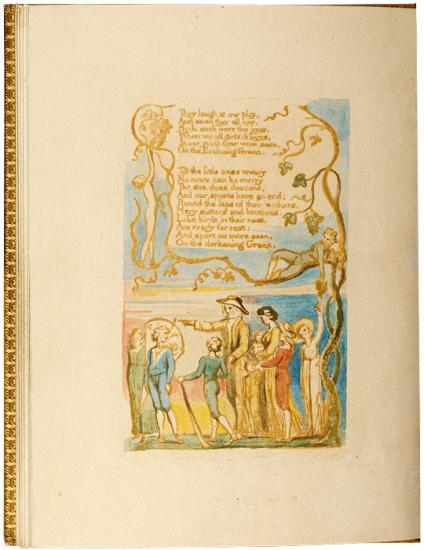
Songs of Innocence.
[London]: The Author & Printer W. Blake, [1789].
Relief-printed etchings with added watercolor
31 illustrations on 17 leaves
Copy D, assembled ca. 1794
Bequest of Tessie Jones in memory of her father, Herschel V. Jones, 1968
This copy, printed in yellow ocher with added watercolor, was assembled for the Blakes' friends John and Anna Flaxman for their return from Italy in late 1794. It is one of the sixteen (or perhaps seventeen) copies from the original printing. The pastoral world represented by children and shepherds evokes the essence of innocence. The double-page design of Spring demonstrates Blake's artistry for combining text and image.
William Blake (1757–1827) occupies a unique place in the history of Western art. His creativity included both the visual and literary arts. In his lifetime he was best known as an engraver; now he is also recognized for his innovative poetry, printmaking, and painting. Blake's keen perception of the political and social climate found expression throughout his work. His strong sense of independence is evident in the complex mythology that he constructed in response to the age of revolution.
Blake was already recognized as an engraver at age twenty-five, when his first volume of poems appeared. At thirty-three, in The Marriage of Heaven and Hell, he audaciously claimed that his birth had marked the origin of a "new heaven" in which his own art would exemplify the creativity prefigured by Milton and Michelangelo. By that time, Blake, in one of his most productive periods, had already produced Songs of Innocence and was at work on a series of illuminated books. In 1818 he met John Linnell, a young painter and engraver, through whom a group of young artists became Blake's followers. Calling themselves the Ancients, they helped perpetuate Blake's influence for generations.
The Morgan's Blake collection—one of this country's most distinguished—began with purchases as early as 1899 by Pierpont Morgan. During the tenure of Charles Ryskamp, director from 1969 to 1986, major gifts almost doubled the size of its Blake holdings. In recent years Ryskamp's own gifts of engravings, letters, and related materials have significantly enriched its scholarly resources.
This online exhibition is presented in conjunction with the exhibition William Blake's World: "A New Heaven Is Begun" on view September 11, 2009, through January 3, 2010.
This exhibition is made possible through the generosity of Fay and Geoffrey Elliott.
Songs of Innocence 12
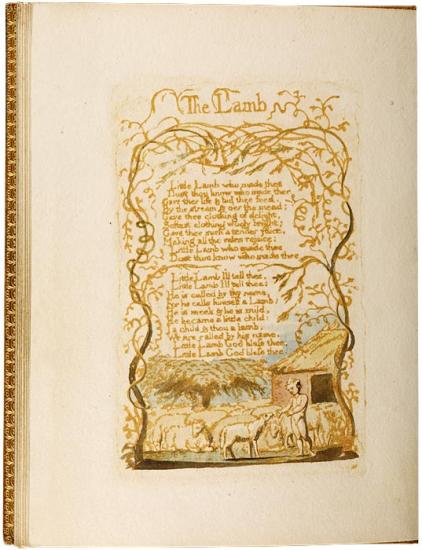
Songs of Innocence.
[London]: The Author & Printer W. Blake, [1789].
Relief-printed etchings with added watercolor
31 illustrations on 17 leaves
Copy D, assembled ca. 1794
Bequest of Tessie Jones in memory of her father, Herschel V. Jones, 1968
This copy, printed in yellow ocher with added watercolor, was assembled for the Blakes' friends John and Anna Flaxman for their return from Italy in late 1794. It is one of the sixteen (or perhaps seventeen) copies from the original printing. The pastoral world represented by children and shepherds evokes the essence of innocence. The double-page design of Spring demonstrates Blake's artistry for combining text and image.
William Blake (1757–1827) occupies a unique place in the history of Western art. His creativity included both the visual and literary arts. In his lifetime he was best known as an engraver; now he is also recognized for his innovative poetry, printmaking, and painting. Blake's keen perception of the political and social climate found expression throughout his work. His strong sense of independence is evident in the complex mythology that he constructed in response to the age of revolution.
Blake was already recognized as an engraver at age twenty-five, when his first volume of poems appeared. At thirty-three, in The Marriage of Heaven and Hell, he audaciously claimed that his birth had marked the origin of a "new heaven" in which his own art would exemplify the creativity prefigured by Milton and Michelangelo. By that time, Blake, in one of his most productive periods, had already produced Songs of Innocence and was at work on a series of illuminated books. In 1818 he met John Linnell, a young painter and engraver, through whom a group of young artists became Blake's followers. Calling themselves the Ancients, they helped perpetuate Blake's influence for generations.
The Morgan's Blake collection—one of this country's most distinguished—began with purchases as early as 1899 by Pierpont Morgan. During the tenure of Charles Ryskamp, director from 1969 to 1986, major gifts almost doubled the size of its Blake holdings. In recent years Ryskamp's own gifts of engravings, letters, and related materials have significantly enriched its scholarly resources.
This online exhibition is presented in conjunction with the exhibition William Blake's World: "A New Heaven Is Begun" on view September 11, 2009, through January 3, 2010.
This exhibition is made possible through the generosity of Fay and Geoffrey Elliott.
Songs of Innocence 13

Songs of Innocence.
[London]: The Author & Printer W. Blake, [1789].
Relief-printed etchings with added watercolor
31 illustrations on 17 leaves
Copy D, assembled ca. 1794
Bequest of Tessie Jones in memory of her father, Herschel V. Jones, 1968
This copy, printed in yellow ocher with added watercolor, was assembled for the Blakes' friends John and Anna Flaxman for their return from Italy in late 1794. It is one of the sixteen (or perhaps seventeen) copies from the original printing. The pastoral world represented by children and shepherds evokes the essence of innocence. The double-page design of Spring demonstrates Blake's artistry for combining text and image.
William Blake (1757–1827) occupies a unique place in the history of Western art. His creativity included both the visual and literary arts. In his lifetime he was best known as an engraver; now he is also recognized for his innovative poetry, printmaking, and painting. Blake's keen perception of the political and social climate found expression throughout his work. His strong sense of independence is evident in the complex mythology that he constructed in response to the age of revolution.
Blake was already recognized as an engraver at age twenty-five, when his first volume of poems appeared. At thirty-three, in The Marriage of Heaven and Hell, he audaciously claimed that his birth had marked the origin of a "new heaven" in which his own art would exemplify the creativity prefigured by Milton and Michelangelo. By that time, Blake, in one of his most productive periods, had already produced Songs of Innocence and was at work on a series of illuminated books. In 1818 he met John Linnell, a young painter and engraver, through whom a group of young artists became Blake's followers. Calling themselves the Ancients, they helped perpetuate Blake's influence for generations.
The Morgan's Blake collection—one of this country's most distinguished—began with purchases as early as 1899 by Pierpont Morgan. During the tenure of Charles Ryskamp, director from 1969 to 1986, major gifts almost doubled the size of its Blake holdings. In recent years Ryskamp's own gifts of engravings, letters, and related materials have significantly enriched its scholarly resources.
This online exhibition is presented in conjunction with the exhibition William Blake's World: "A New Heaven Is Begun" on view September 11, 2009, through January 3, 2010.
This exhibition is made possible through the generosity of Fay and Geoffrey Elliott.
Songs of Innocence 14
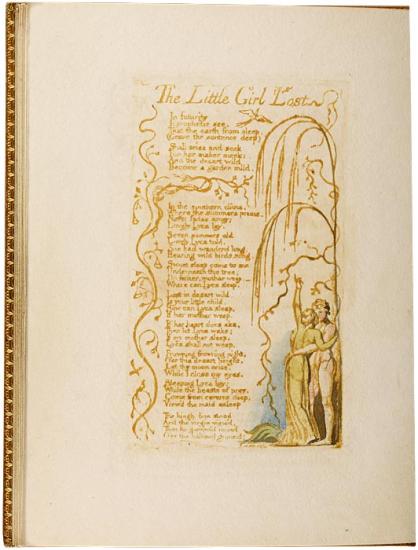
Songs of Innocence.
[London]: The Author & Printer W. Blake, [1789].
Relief-printed etchings with added watercolor
31 illustrations on 17 leaves
Copy D, assembled ca. 1794
Bequest of Tessie Jones in memory of her father, Herschel V. Jones, 1968
This copy, printed in yellow ocher with added watercolor, was assembled for the Blakes' friends John and Anna Flaxman for their return from Italy in late 1794. It is one of the sixteen (or perhaps seventeen) copies from the original printing. The pastoral world represented by children and shepherds evokes the essence of innocence. The double-page design of Spring demonstrates Blake's artistry for combining text and image.
William Blake (1757–1827) occupies a unique place in the history of Western art. His creativity included both the visual and literary arts. In his lifetime he was best known as an engraver; now he is also recognized for his innovative poetry, printmaking, and painting. Blake's keen perception of the political and social climate found expression throughout his work. His strong sense of independence is evident in the complex mythology that he constructed in response to the age of revolution.
Blake was already recognized as an engraver at age twenty-five, when his first volume of poems appeared. At thirty-three, in The Marriage of Heaven and Hell, he audaciously claimed that his birth had marked the origin of a "new heaven" in which his own art would exemplify the creativity prefigured by Milton and Michelangelo. By that time, Blake, in one of his most productive periods, had already produced Songs of Innocence and was at work on a series of illuminated books. In 1818 he met John Linnell, a young painter and engraver, through whom a group of young artists became Blake's followers. Calling themselves the Ancients, they helped perpetuate Blake's influence for generations.
The Morgan's Blake collection—one of this country's most distinguished—began with purchases as early as 1899 by Pierpont Morgan. During the tenure of Charles Ryskamp, director from 1969 to 1986, major gifts almost doubled the size of its Blake holdings. In recent years Ryskamp's own gifts of engravings, letters, and related materials have significantly enriched its scholarly resources.
This online exhibition is presented in conjunction with the exhibition William Blake's World: "A New Heaven Is Begun" on view September 11, 2009, through January 3, 2010.
This exhibition is made possible through the generosity of Fay and Geoffrey Elliott.
Songs of Innocence 15
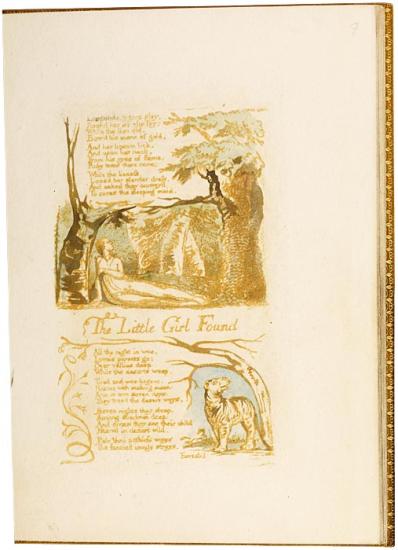
Songs of Innocence.
[London]: The Author & Printer W. Blake, [1789].
Relief-printed etchings with added watercolor
31 illustrations on 17 leaves
Copy D, assembled ca. 1794
Bequest of Tessie Jones in memory of her father, Herschel V. Jones, 1968
This copy, printed in yellow ocher with added watercolor, was assembled for the Blakes' friends John and Anna Flaxman for their return from Italy in late 1794. It is one of the sixteen (or perhaps seventeen) copies from the original printing. The pastoral world represented by children and shepherds evokes the essence of innocence. The double-page design of Spring demonstrates Blake's artistry for combining text and image.
William Blake (1757–1827) occupies a unique place in the history of Western art. His creativity included both the visual and literary arts. In his lifetime he was best known as an engraver; now he is also recognized for his innovative poetry, printmaking, and painting. Blake's keen perception of the political and social climate found expression throughout his work. His strong sense of independence is evident in the complex mythology that he constructed in response to the age of revolution.
Blake was already recognized as an engraver at age twenty-five, when his first volume of poems appeared. At thirty-three, in The Marriage of Heaven and Hell, he audaciously claimed that his birth had marked the origin of a "new heaven" in which his own art would exemplify the creativity prefigured by Milton and Michelangelo. By that time, Blake, in one of his most productive periods, had already produced Songs of Innocence and was at work on a series of illuminated books. In 1818 he met John Linnell, a young painter and engraver, through whom a group of young artists became Blake's followers. Calling themselves the Ancients, they helped perpetuate Blake's influence for generations.
The Morgan's Blake collection—one of this country's most distinguished—began with purchases as early as 1899 by Pierpont Morgan. During the tenure of Charles Ryskamp, director from 1969 to 1986, major gifts almost doubled the size of its Blake holdings. In recent years Ryskamp's own gifts of engravings, letters, and related materials have significantly enriched its scholarly resources.
This online exhibition is presented in conjunction with the exhibition William Blake's World: "A New Heaven Is Begun" on view September 11, 2009, through January 3, 2010.
Songs of Innocence 16
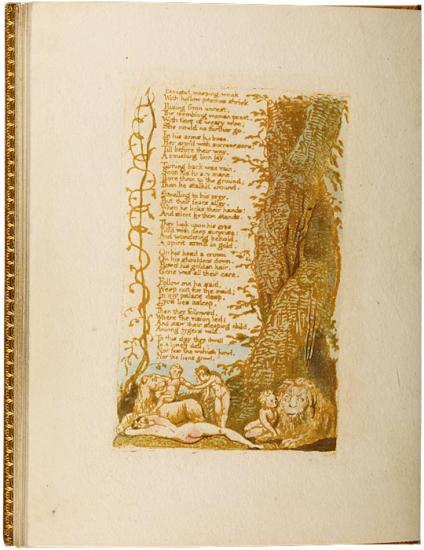
Songs of Innocence.
[London]: The Author & Printer W. Blake, [1789].
Relief-printed etchings with added watercolor
31 illustrations on 17 leaves
Copy D, assembled ca. 1794
Bequest of Tessie Jones in memory of her father, Herschel V. Jones, 1968
This copy, printed in yellow ocher with added watercolor, was assembled for the Blakes' friends John and Anna Flaxman for their return from Italy in late 1794. It is one of the sixteen (or perhaps seventeen) copies from the original printing. The pastoral world represented by children and shepherds evokes the essence of innocence. The double-page design of Spring demonstrates Blake's artistry for combining text and image.
William Blake (1757–1827) occupies a unique place in the history of Western art. His creativity included both the visual and literary arts. In his lifetime he was best known as an engraver; now he is also recognized for his innovative poetry, printmaking, and painting. Blake's keen perception of the political and social climate found expression throughout his work. His strong sense of independence is evident in the complex mythology that he constructed in response to the age of revolution.
Blake was already recognized as an engraver at age twenty-five, when his first volume of poems appeared. At thirty-three, in The Marriage of Heaven and Hell, he audaciously claimed that his birth had marked the origin of a "new heaven" in which his own art would exemplify the creativity prefigured by Milton and Michelangelo. By that time, Blake, in one of his most productive periods, had already produced Songs of Innocence and was at work on a series of illuminated books. In 1818 he met John Linnell, a young painter and engraver, through whom a group of young artists became Blake's followers. Calling themselves the Ancients, they helped perpetuate Blake's influence for generations.
The Morgan's Blake collection—one of this country's most distinguished—began with purchases as early as 1899 by Pierpont Morgan. During the tenure of Charles Ryskamp, director from 1969 to 1986, major gifts almost doubled the size of its Blake holdings. In recent years Ryskamp's own gifts of engravings, letters, and related materials have significantly enriched its scholarly resources.
This online exhibition is presented in conjunction with the exhibition William Blake's World: "A New Heaven Is Begun" on view September 11, 2009, through January 3, 2010.
This exhibition is made possible through the generosity of Fay and Geoffrey Elliott.
Songs of Innocence 17
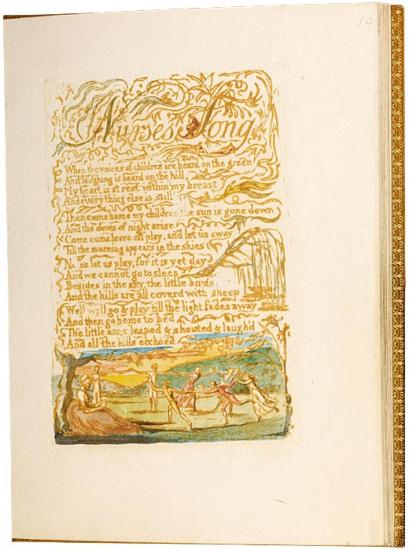
Songs of Innocence.
[London]: The Author & Printer W. Blake, [1789].
Relief-printed etchings with added watercolor
31 illustrations on 17 leaves
Copy D, assembled ca. 1794
Bequest of Tessie Jones in memory of her father, Herschel V. Jones, 1968
This copy, printed in yellow ocher with added watercolor, was assembled for the Blakes' friends John and Anna Flaxman for their return from Italy in late 1794. It is one of the sixteen (or perhaps seventeen) copies from the original printing. The pastoral world represented by children and shepherds evokes the essence of innocence. The double-page design of Spring demonstrates Blake's artistry for combining text and image.
William Blake (1757–1827) occupies a unique place in the history of Western art. His creativity included both the visual and literary arts. In his lifetime he was best known as an engraver; now he is also recognized for his innovative poetry, printmaking, and painting. Blake's keen perception of the political and social climate found expression throughout his work. His strong sense of independence is evident in the complex mythology that he constructed in response to the age of revolution.
Blake was already recognized as an engraver at age twenty-five, when his first volume of poems appeared. At thirty-three, in The Marriage of Heaven and Hell, he audaciously claimed that his birth had marked the origin of a "new heaven" in which his own art would exemplify the creativity prefigured by Milton and Michelangelo. By that time, Blake, in one of his most productive periods, had already produced Songs of Innocence and was at work on a series of illuminated books. In 1818 he met John Linnell, a young painter and engraver, through whom a group of young artists became Blake's followers. Calling themselves the Ancients, they helped perpetuate Blake's influence for generations.
The Morgan's Blake collection—one of this country's most distinguished—began with purchases as early as 1899 by Pierpont Morgan. During the tenure of Charles Ryskamp, director from 1969 to 1986, major gifts almost doubled the size of its Blake holdings. In recent years Ryskamp's own gifts of engravings, letters, and related materials have significantly enriched its scholarly resources.
This online exhibition is presented in conjunction with the exhibition William Blake's World: "A New Heaven Is Begun" on view September 11, 2009, through January 3, 2010.
This exhibition is made possible through the generosity of Fay and Geoffrey Elliott.
Songs of Innocence 18

Songs of Innocence.
[London]: The Author & Printer W. Blake, [1789].
Relief-printed etchings with added watercolor
31 illustrations on 17 leaves
Copy D, assembled ca. 1794
Bequest of Tessie Jones in memory of her father, Herschel V. Jones, 1968
This copy, printed in yellow ocher with added watercolor, was assembled for the Blakes' friends John and Anna Flaxman for their return from Italy in late 1794. It is one of the sixteen (or perhaps seventeen) copies from the original printing. The pastoral world represented by children and shepherds evokes the essence of innocence. The double-page design of Spring demonstrates Blake's artistry for combining text and image.
William Blake (1757–1827) occupies a unique place in the history of Western art. His creativity included both the visual and literary arts. In his lifetime he was best known as an engraver; now he is also recognized for his innovative poetry, printmaking, and painting. Blake's keen perception of the political and social climate found expression throughout his work. His strong sense of independence is evident in the complex mythology that he constructed in response to the age of revolution.
Blake was already recognized as an engraver at age twenty-five, when his first volume of poems appeared. At thirty-three, in The Marriage of Heaven and Hell, he audaciously claimed that his birth had marked the origin of a "new heaven" in which his own art would exemplify the creativity prefigured by Milton and Michelangelo. By that time, Blake, in one of his most productive periods, had already produced Songs of Innocence and was at work on a series of illuminated books. In 1818 he met John Linnell, a young painter and engraver, through whom a group of young artists became Blake's followers. Calling themselves the Ancients, they helped perpetuate Blake's influence for generations.
The Morgan's Blake collection—one of this country's most distinguished—began with purchases as early as 1899 by Pierpont Morgan. During the tenure of Charles Ryskamp, director from 1969 to 1986, major gifts almost doubled the size of its Blake holdings. In recent years Ryskamp's own gifts of engravings, letters, and related materials have significantly enriched its scholarly resources.
This online exhibition is presented in conjunction with the exhibition William Blake's World: "A New Heaven Is Begun" on view September 11, 2009, through January 3, 2010.
This exhibition is made possible through the generosity of Fay and Geoffrey Elliott.
Songs of Innocence 19
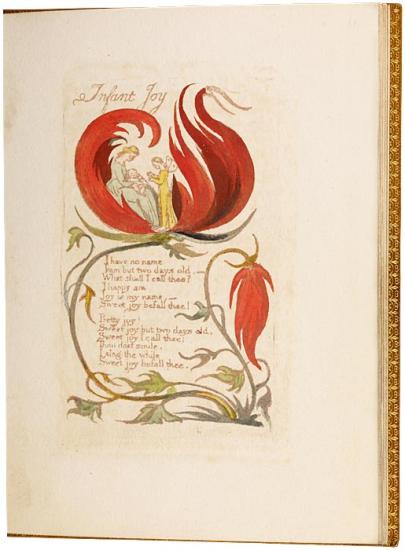
Songs of Innocence.
[London]: The Author & Printer W. Blake, [1789].
Relief-printed etchings with added watercolor
31 illustrations on 17 leaves
Copy D, assembled ca. 1794
Bequest of Tessie Jones in memory of her father, Herschel V. Jones, 1968
This copy, printed in yellow ocher with added watercolor, was assembled for the Blakes' friends John and Anna Flaxman for their return from Italy in late 1794. It is one of the sixteen (or perhaps seventeen) copies from the original printing. The pastoral world represented by children and shepherds evokes the essence of innocence. The double-page design of Spring demonstrates Blake's artistry for combining text and image.
William Blake (1757–1827) occupies a unique place in the history of Western art. His creativity included both the visual and literary arts. In his lifetime he was best known as an engraver; now he is also recognized for his innovative poetry, printmaking, and painting. Blake's keen perception of the political and social climate found expression throughout his work. His strong sense of independence is evident in the complex mythology that he constructed in response to the age of revolution.
Blake was already recognized as an engraver at age twenty-five, when his first volume of poems appeared. At thirty-three, in The Marriage of Heaven and Hell, he audaciously claimed that his birth had marked the origin of a "new heaven" in which his own art would exemplify the creativity prefigured by Milton and Michelangelo. By that time, Blake, in one of his most productive periods, had already produced Songs of Innocence and was at work on a series of illuminated books. In 1818 he met John Linnell, a young painter and engraver, through whom a group of young artists became Blake's followers. Calling themselves the Ancients, they helped perpetuate Blake's influence for generations.
The Morgan's Blake collection—one of this country's most distinguished—began with purchases as early as 1899 by Pierpont Morgan. During the tenure of Charles Ryskamp, director from 1969 to 1986, major gifts almost doubled the size of its Blake holdings. In recent years Ryskamp's own gifts of engravings, letters, and related materials have significantly enriched its scholarly resources.
This online exhibition is presented in conjunction with the exhibition William Blake's World: "A New Heaven Is Begun" on view September 11, 2009, through January 3, 2010.
This exhibition is made possible through the generosity of Fay and Geoffrey Elliott.
Songs of Innocence 20
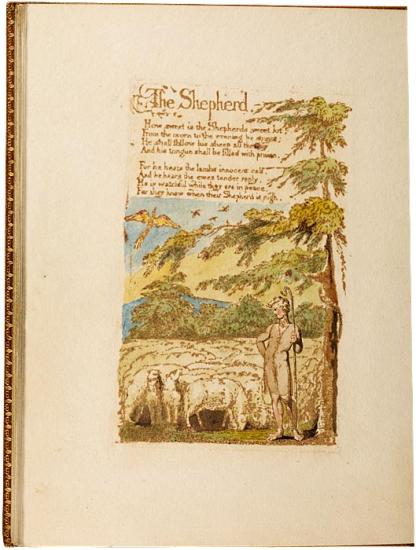
Songs of Innocence.
[London]: The Author & Printer W. Blake, [1789].
Relief-printed etchings with added watercolor
31 illustrations on 17 leaves
Copy D, assembled ca. 1794
Bequest of Tessie Jones in memory of her father, Herschel V. Jones, 1968
This copy, printed in yellow ocher with added watercolor, was assembled for the Blakes' friends John and Anna Flaxman for their return from Italy in late 1794. It is one of the sixteen (or perhaps seventeen) copies from the original printing. The pastoral world represented by children and shepherds evokes the essence of innocence. The double-page design of Spring demonstrates Blake's artistry for combining text and image.
William Blake (1757–1827) occupies a unique place in the history of Western art. His creativity included both the visual and literary arts. In his lifetime he was best known as an engraver; now he is also recognized for his innovative poetry, printmaking, and painting. Blake's keen perception of the political and social climate found expression throughout his work. His strong sense of independence is evident in the complex mythology that he constructed in response to the age of revolution.
Blake was already recognized as an engraver at age twenty-five, when his first volume of poems appeared. At thirty-three, in The Marriage of Heaven and Hell, he audaciously claimed that his birth had marked the origin of a "new heaven" in which his own art would exemplify the creativity prefigured by Milton and Michelangelo. By that time, Blake, in one of his most productive periods, had already produced Songs of Innocence and was at work on a series of illuminated books. In 1818 he met John Linnell, a young painter and engraver, through whom a group of young artists became Blake's followers. Calling themselves the Ancients, they helped perpetuate Blake's influence for generations.
The Morgan's Blake collection—one of this country's most distinguished—began with purchases as early as 1899 by Pierpont Morgan. During the tenure of Charles Ryskamp, director from 1969 to 1986, major gifts almost doubled the size of its Blake holdings. In recent years Ryskamp's own gifts of engravings, letters, and related materials have significantly enriched its scholarly resources.
This online exhibition is presented in conjunction with the exhibition William Blake's World: "A New Heaven Is Begun" on view September 11, 2009, through January 3, 2010.
This exhibition is made possible through the generosity of Fay and Geoffrey Elliott.
Songs of Innocence 21
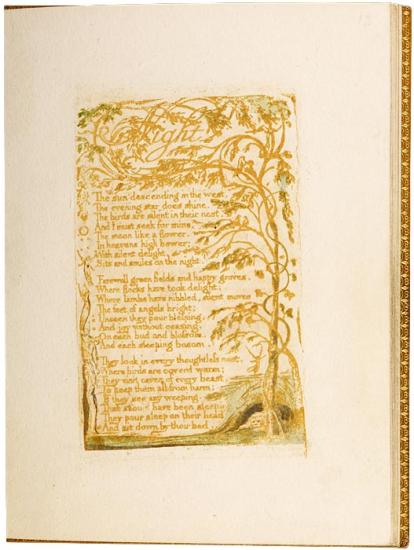
Songs of Innocence.
[London]: The Author & Printer W. Blake, [1789].
Relief-printed etchings with added watercolor
31 illustrations on 17 leaves
Copy D, assembled ca. 1794
Bequest of Tessie Jones in memory of her father, Herschel V. Jones, 1968
This copy, printed in yellow ocher with added watercolor, was assembled for the Blakes' friends John and Anna Flaxman for their return from Italy in late 1794. It is one of the sixteen (or perhaps seventeen) copies from the original printing. The pastoral world represented by children and shepherds evokes the essence of innocence. The double-page design of Spring demonstrates Blake's artistry for combining text and image.
William Blake (1757–1827) occupies a unique place in the history of Western art. His creativity included both the visual and literary arts. In his lifetime he was best known as an engraver; now he is also recognized for his innovative poetry, printmaking, and painting. Blake's keen perception of the political and social climate found expression throughout his work. His strong sense of independence is evident in the complex mythology that he constructed in response to the age of revolution.
Blake was already recognized as an engraver at age twenty-five, when his first volume of poems appeared. At thirty-three, in The Marriage of Heaven and Hell, he audaciously claimed that his birth had marked the origin of a "new heaven" in which his own art would exemplify the creativity prefigured by Milton and Michelangelo. By that time, Blake, in one of his most productive periods, had already produced Songs of Innocence and was at work on a series of illuminated books. In 1818 he met John Linnell, a young painter and engraver, through whom a group of young artists became Blake's followers. Calling themselves the Ancients, they helped perpetuate Blake's influence for generations.
The Morgan's Blake collection—one of this country's most distinguished—began with purchases as early as 1899 by Pierpont Morgan. During the tenure of Charles Ryskamp, director from 1969 to 1986, major gifts almost doubled the size of its Blake holdings. In recent years Ryskamp's own gifts of engravings, letters, and related materials have significantly enriched its scholarly resources.
This online exhibition is presented in conjunction with the exhibition William Blake's World: "A New Heaven Is Begun" on view September 11, 2009, through January 3, 2010.
This exhibition is made possible through the generosity of Fay and Geoffrey Elliott.
Songs of Innocence 22
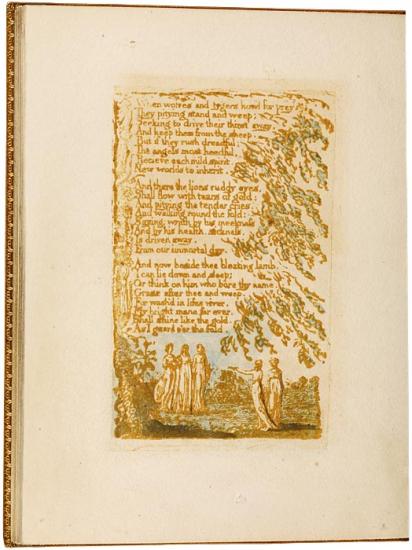
Songs of Innocence.
[London]: The Author & Printer W. Blake, [1789].
Relief-printed etchings with added watercolor
31 illustrations on 17 leaves
Copy D, assembled ca. 1794
Bequest of Tessie Jones in memory of her father, Herschel V. Jones, 1968
This copy, printed in yellow ocher with added watercolor, was assembled for the Blakes' friends John and Anna Flaxman for their return from Italy in late 1794. It is one of the sixteen (or perhaps seventeen) copies from the original printing. The pastoral world represented by children and shepherds evokes the essence of innocence. The double-page design of Spring demonstrates Blake's artistry for combining text and image.
William Blake (1757–1827) occupies a unique place in the history of Western art. His creativity included both the visual and literary arts. In his lifetime he was best known as an engraver; now he is also recognized for his innovative poetry, printmaking, and painting. Blake's keen perception of the political and social climate found expression throughout his work. His strong sense of independence is evident in the complex mythology that he constructed in response to the age of revolution.
Blake was already recognized as an engraver at age twenty-five, when his first volume of poems appeared. At thirty-three, in The Marriage of Heaven and Hell, he audaciously claimed that his birth had marked the origin of a "new heaven" in which his own art would exemplify the creativity prefigured by Milton and Michelangelo. By that time, Blake, in one of his most productive periods, had already produced Songs of Innocence and was at work on a series of illuminated books. In 1818 he met John Linnell, a young painter and engraver, through whom a group of young artists became Blake's followers. Calling themselves the Ancients, they helped perpetuate Blake's influence for generations.
The Morgan's Blake collection—one of this country's most distinguished—began with purchases as early as 1899 by Pierpont Morgan. During the tenure of Charles Ryskamp, director from 1969 to 1986, major gifts almost doubled the size of its Blake holdings. In recent years Ryskamp's own gifts of engravings, letters, and related materials have significantly enriched its scholarly resources.
This online exhibition is presented in conjunction with the exhibition William Blake's World: "A New Heaven Is Begun" on view September 11, 2009, through January 3, 2010.
This exhibition is made possible through the generosity of Fay and Geoffrey Elliott.
Songs of Innocence 23
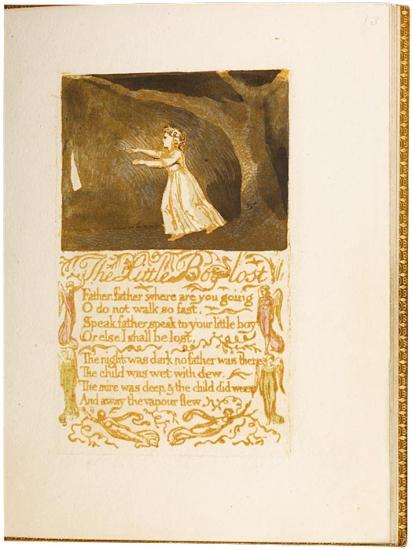
Songs of Innocence.
[London]: The Author & Printer W. Blake, [1789].
Relief-printed etchings with added watercolor
31 illustrations on 17 leaves
Copy D, assembled ca. 1794
Bequest of Tessie Jones in memory of her father, Herschel V. Jones, 1968
This copy, printed in yellow ocher with added watercolor, was assembled for the Blakes' friends John and Anna Flaxman for their return from Italy in late 1794. It is one of the sixteen (or perhaps seventeen) copies from the original printing. The pastoral world represented by children and shepherds evokes the essence of innocence. The double-page design of Spring demonstrates Blake's artistry for combining text and image.
William Blake (1757–1827) occupies a unique place in the history of Western art. His creativity included both the visual and literary arts. In his lifetime he was best known as an engraver; now he is also recognized for his innovative poetry, printmaking, and painting. Blake's keen perception of the political and social climate found expression throughout his work. His strong sense of independence is evident in the complex mythology that he constructed in response to the age of revolution.
Blake was already recognized as an engraver at age twenty-five, when his first volume of poems appeared. At thirty-three, in The Marriage of Heaven and Hell, he audaciously claimed that his birth had marked the origin of a "new heaven" in which his own art would exemplify the creativity prefigured by Milton and Michelangelo. By that time, Blake, in one of his most productive periods, had already produced Songs of Innocence and was at work on a series of illuminated books. In 1818 he met John Linnell, a young painter and engraver, through whom a group of young artists became Blake's followers. Calling themselves the Ancients, they helped perpetuate Blake's influence for generations.
The Morgan's Blake collection—one of this country's most distinguished—began with purchases as early as 1899 by Pierpont Morgan. During the tenure of Charles Ryskamp, director from 1969 to 1986, major gifts almost doubled the size of its Blake holdings. In recent years Ryskamp's own gifts of engravings, letters, and related materials have significantly enriched its scholarly resources.
This online exhibition is presented in conjunction with the exhibition William Blake's World: "A New Heaven Is Begun" on view September 11, 2009, through January 3, 2010.
This exhibition is made possible through the generosity of Fay and Geoffrey Elliott.
Songs of Innocence 24

Songs of Innocence.
[London]: The Author & Printer W. Blake, [1789].
Relief-printed etchings with added watercolor
31 illustrations on 17 leaves
Copy D, assembled ca. 1794
Bequest of Tessie Jones in memory of her father, Herschel V. Jones, 1968
This copy, printed in yellow ocher with added watercolor, was assembled for the Blakes' friends John and Anna Flaxman for their return from Italy in late 1794. It is one of the sixteen (or perhaps seventeen) copies from the original printing. The pastoral world represented by children and shepherds evokes the essence of innocence. The double-page design of Spring demonstrates Blake's artistry for combining text and image.
William Blake (1757–1827) occupies a unique place in the history of Western art. His creativity included both the visual and literary arts. In his lifetime he was best known as an engraver; now he is also recognized for his innovative poetry, printmaking, and painting. Blake's keen perception of the political and social climate found expression throughout his work. His strong sense of independence is evident in the complex mythology that he constructed in response to the age of revolution.
Blake was already recognized as an engraver at age twenty-five, when his first volume of poems appeared. At thirty-three, in The Marriage of Heaven and Hell, he audaciously claimed that his birth had marked the origin of a "new heaven" in which his own art would exemplify the creativity prefigured by Milton and Michelangelo. By that time, Blake, in one of his most productive periods, had already produced Songs of Innocence and was at work on a series of illuminated books. In 1818 he met John Linnell, a young painter and engraver, through whom a group of young artists became Blake's followers. Calling themselves the Ancients, they helped perpetuate Blake's influence for generations.
The Morgan's Blake collection—one of this country's most distinguished—began with purchases as early as 1899 by Pierpont Morgan. During the tenure of Charles Ryskamp, director from 1969 to 1986, major gifts almost doubled the size of its Blake holdings. In recent years Ryskamp's own gifts of engravings, letters, and related materials have significantly enriched its scholarly resources.
This online exhibition is presented in conjunction with the exhibition William Blake's World: "A New Heaven Is Begun" on view September 11, 2009, through January 3, 2010.
This exhibition is made possible through the generosity of Fay and Geoffrey Elliott.
Songs of Innocence 25
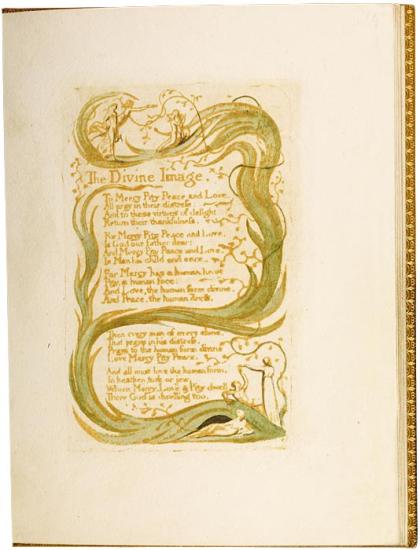
Songs of Innocence.
[London]: The Author & Printer W. Blake, [1789].
Relief-printed etchings with added watercolor
31 illustrations on 17 leaves
Copy D, assembled ca. 1794
Bequest of Tessie Jones in memory of her father, Herschel V. Jones, 1968
This copy, printed in yellow ocher with added watercolor, was assembled for the Blakes' friends John and Anna Flaxman for their return from Italy in late 1794. It is one of the sixteen (or perhaps seventeen) copies from the original printing. The pastoral world represented by children and shepherds evokes the essence of innocence. The double-page design of Spring demonstrates Blake's artistry for combining text and image.
William Blake (1757–1827) occupies a unique place in the history of Western art. His creativity included both the visual and literary arts. In his lifetime he was best known as an engraver; now he is also recognized for his innovative poetry, printmaking, and painting. Blake's keen perception of the political and social climate found expression throughout his work. His strong sense of independence is evident in the complex mythology that he constructed in response to the age of revolution.
Blake was already recognized as an engraver at age twenty-five, when his first volume of poems appeared. At thirty-three, in The Marriage of Heaven and Hell, he audaciously claimed that his birth had marked the origin of a "new heaven" in which his own art would exemplify the creativity prefigured by Milton and Michelangelo. By that time, Blake, in one of his most productive periods, had already produced Songs of Innocence and was at work on a series of illuminated books. In 1818 he met John Linnell, a young painter and engraver, through whom a group of young artists became Blake's followers. Calling themselves the Ancients, they helped perpetuate Blake's influence for generations.
The Morgan's Blake collection—one of this country's most distinguished—began with purchases as early as 1899 by Pierpont Morgan. During the tenure of Charles Ryskamp, director from 1969 to 1986, major gifts almost doubled the size of its Blake holdings. In recent years Ryskamp's own gifts of engravings, letters, and related materials have significantly enriched its scholarly resources.
This online exhibition is presented in conjunction with the exhibition William Blake's World: "A New Heaven Is Begun" on view September 11, 2009, through January 3, 2010.
This exhibition is made possible through the generosity of Fay and Geoffrey Elliott.
Songs of Innocence 26

Songs of Innocence.
[London]: The Author & Printer W. Blake, [1789].
Relief-printed etchings with added watercolor
31 illustrations on 17 leaves
Copy D, assembled ca. 1794
Bequest of Tessie Jones in memory of her father, Herschel V. Jones, 1968
This copy, printed in yellow ocher with added watercolor, was assembled for the Blakes' friends John and Anna Flaxman for their return from Italy in late 1794. It is one of the sixteen (or perhaps seventeen) copies from the original printing. The pastoral world represented by children and shepherds evokes the essence of innocence. The double-page design of Spring demonstrates Blake's artistry for combining text and image.
William Blake (1757–1827) occupies a unique place in the history of Western art. His creativity included both the visual and literary arts. In his lifetime he was best known as an engraver; now he is also recognized for his innovative poetry, printmaking, and painting. Blake's keen perception of the political and social climate found expression throughout his work. His strong sense of independence is evident in the complex mythology that he constructed in response to the age of revolution.
Blake was already recognized as an engraver at age twenty-five, when his first volume of poems appeared. At thirty-three, in The Marriage of Heaven and Hell, he audaciously claimed that his birth had marked the origin of a "new heaven" in which his own art would exemplify the creativity prefigured by Milton and Michelangelo. By that time, Blake, in one of his most productive periods, had already produced Songs of Innocence and was at work on a series of illuminated books. In 1818 he met John Linnell, a young painter and engraver, through whom a group of young artists became Blake's followers. Calling themselves the Ancients, they helped perpetuate Blake's influence for generations.
The Morgan's Blake collection—one of this country's most distinguished—began with purchases as early as 1899 by Pierpont Morgan. During the tenure of Charles Ryskamp, director from 1969 to 1986, major gifts almost doubled the size of its Blake holdings. In recent years Ryskamp's own gifts of engravings, letters, and related materials have significantly enriched its scholarly resources.
This online exhibition is presented in conjunction with the exhibition William Blake's World: "A New Heaven Is Begun" on view September 11, 2009, through January 3, 2010.
This exhibition is made possible through the generosity of Fay and Geoffrey Elliott.
Songs of Innocence 27
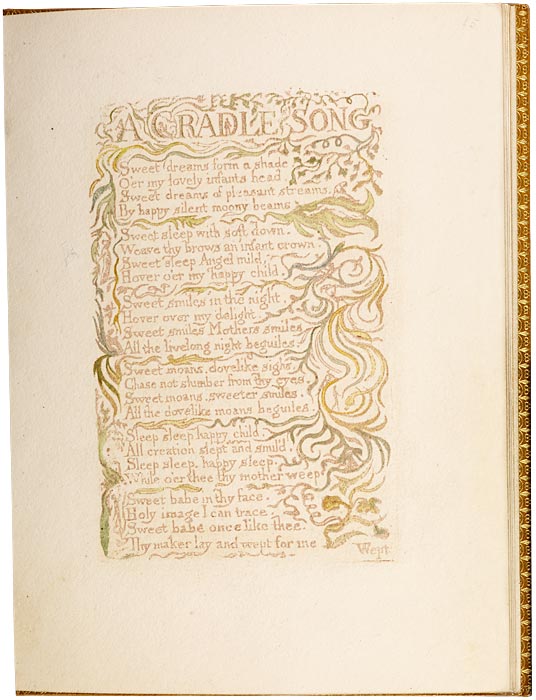
A Cradle Song from Songs of Innocence
London: The Author & Printer W. Blake, 1789
Bequest of Tessie Jones in memory of her father, Herschel V. Jones, 1968
Songs of Innocence is one of Blake's earliest illuminated books, printed by a relief etching process of his own invention. His novel printing methods assured the artistic integrity of his work, giving him complete control over the production of his limited editions and the configuration of word and image, rendered in the same medium to form an inspired synthesis of his visionary ideas. Twenty-six copies survive. One of sixteen printed in yellow ochre and raw sienna about 1789, this copy was hand-colored by Blake around 1794 for his friends Anna and John Flaxman, a prominent sculptor and illustrator who shared some of his stylistic traits and artistic views.
This online exhibition is presented in conjunction with the exhibition William Blake's World: "A New Heaven Is Begun" on view September 11, 2009, through January 3, 2010.
This exhibition is made possible through the generosity of Fay and Geoffrey Elliott.
Songs of Innocence 28

Songs of Innocence.
[London]: The Author & Printer W. Blake, [1789].
Relief-printed etchings with added watercolor
31 illustrations on 17 leaves
Copy D, assembled ca. 1794
Bequest of Tessie Jones in memory of her father, Herschel V. Jones, 1968
This copy, printed in yellow ocher with added watercolor, was assembled for the Blakes' friends John and Anna Flaxman for their return from Italy in late 1794. It is one of the sixteen (or perhaps seventeen) copies from the original printing. The pastoral world represented by children and shepherds evokes the essence of innocence. The double-page design of Spring demonstrates Blake's artistry for combining text and image.
William Blake (1757–1827) occupies a unique place in the history of Western art. His creativity included both the visual and literary arts. In his lifetime he was best known as an engraver; now he is also recognized for his innovative poetry, printmaking, and painting. Blake's keen perception of the political and social climate found expression throughout his work. His strong sense of independence is evident in the complex mythology that he constructed in response to the age of revolution.
Blake was already recognized as an engraver at age twenty-five, when his first volume of poems appeared. At thirty-three, in The Marriage of Heaven and Hell, he audaciously claimed that his birth had marked the origin of a "new heaven" in which his own art would exemplify the creativity prefigured by Milton and Michelangelo. By that time, Blake, in one of his most productive periods, had already produced Songs of Innocence and was at work on a series of illuminated books. In 1818 he met John Linnell, a young painter and engraver, through whom a group of young artists became Blake's followers. Calling themselves the Ancients, they helped perpetuate Blake's influence for generations.
The Morgan's Blake collection—one of this country's most distinguished—began with purchases as early as 1899 by Pierpont Morgan. During the tenure of Charles Ryskamp, director from 1969 to 1986, major gifts almost doubled the size of its Blake holdings. In recent years Ryskamp's own gifts of engravings, letters, and related materials have significantly enriched its scholarly resources.
This online exhibition is presented in conjunction with the exhibition William Blake's World: "A New Heaven Is Begun" on view September 11, 2009, through January 3, 2010.
This exhibition is made possible through the generosity of Fay and Geoffrey Elliott.
Songs of Innocence 29
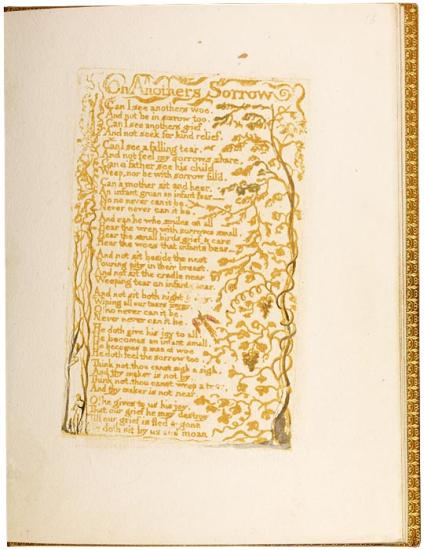
Songs of Innocence.
[London]: The Author & Printer W. Blake, [1789].
Relief-printed etchings with added watercolor
31 illustrations on 17 leaves
Copy D, assembled ca. 1794
Bequest of Tessie Jones in memory of her father, Herschel V. Jones, 1968
This copy, printed in yellow ocher with added watercolor, was assembled for the Blakes' friends John and Anna Flaxman for their return from Italy in late 1794. It is one of the sixteen (or perhaps seventeen) copies from the original printing. The pastoral world represented by children and shepherds evokes the essence of innocence. The double-page design of Spring demonstrates Blake's artistry for combining text and image.
William Blake (1757–1827) occupies a unique place in the history of Western art. His creativity included both the visual and literary arts. In his lifetime he was best known as an engraver; now he is also recognized for his innovative poetry, printmaking, and painting. Blake's keen perception of the political and social climate found expression throughout his work. His strong sense of independence is evident in the complex mythology that he constructed in response to the age of revolution.
Blake was already recognized as an engraver at age twenty-five, when his first volume of poems appeared. At thirty-three, in The Marriage of Heaven and Hell, he audaciously claimed that his birth had marked the origin of a "new heaven" in which his own art would exemplify the creativity prefigured by Milton and Michelangelo. By that time, Blake, in one of his most productive periods, had already produced Songs of Innocence and was at work on a series of illuminated books. In 1818 he met John Linnell, a young painter and engraver, through whom a group of young artists became Blake's followers. Calling themselves the Ancients, they helped perpetuate Blake's influence for generations.
The Morgan's Blake collection—one of this country's most distinguished—began with purchases as early as 1899 by Pierpont Morgan. During the tenure of Charles Ryskamp, director from 1969 to 1986, major gifts almost doubled the size of its Blake holdings. In recent years Ryskamp's own gifts of engravings, letters, and related materials have significantly enriched its scholarly resources.
This online exhibition is presented in conjunction with the exhibition William Blake's World: "A New Heaven Is Begun" on view September 11, 2009, through January 3, 2010.
This exhibition is made possible through the generosity of Fay and Geoffrey Elliott.
Songs of Innocence 30

Songs of Innocence.
[London]: The Author & Printer W. Blake, [1789].
Relief-printed etchings with added watercolor
31 illustrations on 17 leaves
Copy D, assembled ca. 1794
Bequest of Tessie Jones in memory of her father, Herschel V. Jones, 1968
This copy, printed in yellow ocher with added watercolor, was assembled for the Blakes' friends John and Anna Flaxman for their return from Italy in late 1794. It is one of the sixteen (or perhaps seventeen) copies from the original printing. The pastoral world represented by children and shepherds evokes the essence of innocence. The double-page design of Spring demonstrates Blake's artistry for combining text and image.
William Blake (1757–1827) occupies a unique place in the history of Western art. His creativity included both the visual and literary arts. In his lifetime he was best known as an engraver; now he is also recognized for his innovative poetry, printmaking, and painting. Blake's keen perception of the political and social climate found expression throughout his work. His strong sense of independence is evident in the complex mythology that he constructed in response to the age of revolution.
Blake was already recognized as an engraver at age twenty-five, when his first volume of poems appeared. At thirty-three, in The Marriage of Heaven and Hell, he audaciously claimed that his birth had marked the origin of a "new heaven" in which his own art would exemplify the creativity prefigured by Milton and Michelangelo. By that time, Blake, in one of his most productive periods, had already produced Songs of Innocence and was at work on a series of illuminated books. In 1818 he met John Linnell, a young painter and engraver, through whom a group of young artists became Blake's followers. Calling themselves the Ancients, they helped perpetuate Blake's influence for generations.
The Morgan's Blake collection—one of this country's most distinguished—began with purchases as early as 1899 by Pierpont Morgan. During the tenure of Charles Ryskamp, director from 1969 to 1986, major gifts almost doubled the size of its Blake holdings. In recent years Ryskamp's own gifts of engravings, letters, and related materials have significantly enriched its scholarly resources.
This online exhibition is presented in conjunction with the exhibition William Blake's World: "A New Heaven Is Begun" on view September 11, 2009, through January 3, 2010.
This exhibition is made possible through the generosity of Fay and Geoffrey Elliott.
Songs of Innocence 31
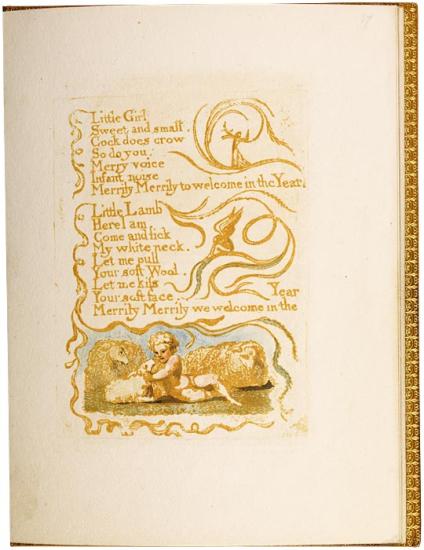
Songs of Innocence.
[London]: The Author & Printer W. Blake, [1789].
Relief-printed etchings with added watercolor
31 illustrations on 17 leaves
Copy D, assembled ca. 1794
Bequest of Tessie Jones in memory of her father, Herschel V. Jones, 1968
This copy, printed in yellow ocher with added watercolor, was assembled for the Blakes' friends John and Anna Flaxman for their return from Italy in late 1794. It is one of the sixteen (or perhaps seventeen) copies from the original printing. The pastoral world represented by children and shepherds evokes the essence of innocence. The double-page design of Spring demonstrates Blake's artistry for combining text and image.
William Blake (1757–1827) occupies a unique place in the history of Western art. His creativity included both the visual and literary arts. In his lifetime he was best known as an engraver; now he is also recognized for his innovative poetry, printmaking, and painting. Blake's keen perception of the political and social climate found expression throughout his work. His strong sense of independence is evident in the complex mythology that he constructed in response to the age of revolution.
Blake was already recognized as an engraver at age twenty-five, when his first volume of poems appeared. At thirty-three, in The Marriage of Heaven and Hell, he audaciously claimed that his birth had marked the origin of a "new heaven" in which his own art would exemplify the creativity prefigured by Milton and Michelangelo. By that time, Blake, in one of his most productive periods, had already produced Songs of Innocence and was at work on a series of illuminated books. In 1818 he met John Linnell, a young painter and engraver, through whom a group of young artists became Blake's followers. Calling themselves the Ancients, they helped perpetuate Blake's influence for generations.
The Morgan's Blake collection—one of this country's most distinguished—began with purchases as early as 1899 by Pierpont Morgan. During the tenure of Charles Ryskamp, director from 1969 to 1986, major gifts almost doubled the size of its Blake holdings. In recent years Ryskamp's own gifts of engravings, letters, and related materials have significantly enriched its scholarly resources.
This online exhibition is presented in conjunction with the exhibition William Blake's World: "A New Heaven Is Begun" on view September 11, 2009, through January 3, 2010.
This exhibition is made possible through the generosity of Fay and Geoffrey Elliott.
Songs of Innocence 32

Songs of Innocence.
[London]: The Author & Printer W. Blake, [1789].
Relief-printed etchings with added watercolor
31 illustrations on 17 leaves
Copy D, assembled ca. 1794
Bequest of Tessie Jones in memory of her father, Herschel V. Jones, 1968
This copy, printed in yellow ocher with added watercolor, was assembled for the Blakes' friends John and Anna Flaxman for their return from Italy in late 1794. It is one of the sixteen (or perhaps seventeen) copies from the original printing. The pastoral world represented by children and shepherds evokes the essence of innocence. The double-page design of Spring demonstrates Blake's artistry for combining text and image.
William Blake (1757–1827) occupies a unique place in the history of Western art. His creativity included both the visual and literary arts. In his lifetime he was best known as an engraver; now he is also recognized for his innovative poetry, printmaking, and painting. Blake's keen perception of the political and social climate found expression throughout his work. His strong sense of independence is evident in the complex mythology that he constructed in response to the age of revolution.
Blake was already recognized as an engraver at age twenty-five, when his first volume of poems appeared. At thirty-three, in The Marriage of Heaven and Hell, he audaciously claimed that his birth had marked the origin of a "new heaven" in which his own art would exemplify the creativity prefigured by Milton and Michelangelo. By that time, Blake, in one of his most productive periods, had already produced Songs of Innocence and was at work on a series of illuminated books. In 1818 he met John Linnell, a young painter and engraver, through whom a group of young artists became Blake's followers. Calling themselves the Ancients, they helped perpetuate Blake's influence for generations.
The Morgan's Blake collection—one of this country's most distinguished—began with purchases as early as 1899 by Pierpont Morgan. During the tenure of Charles Ryskamp, director from 1969 to 1986, major gifts almost doubled the size of its Blake holdings. In recent years Ryskamp's own gifts of engravings, letters, and related materials have significantly enriched its scholarly resources.
This online exhibition is presented in conjunction with the exhibition William Blake's World: "A New Heaven Is Begun" on view September 11, 2009, through January 3, 2010.
This exhibition is made possible through the generosity of Fay and Geoffrey Elliott.
Colinet and Thenot
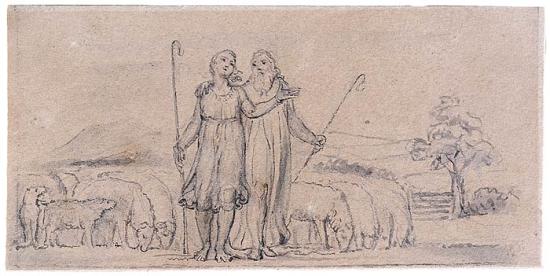
Colinet and Thenot, for The Pastorals of Virgil
Gift of Mrs. H. W. Reed in memory of Elizabeth Hudson
Blake's illustration portrays the shepherds Colinet and Thenot holding distaffs and conversing in a bucolic landscape. This small sheet is an unused design for The Pastorals of Virgil, which was adapted by Dr. Robert John Thornton in 1821. The drawing belonged to John Linnell, who was instrumental in getting Blake the commission. The Morgan also owns two other drawings for this work.
William Blake (1757–1827) occupies a unique place in the history of Western art. His creativity included both the visual and literary arts. In his lifetime he was best known as an engraver; now he is also recognized for his innovative poetry, printmaking, and painting. Blake's keen perception of the political and social climate found expression throughout his work. His strong sense of independence is evident in the complex mythology that he constructed in response to the age of revolution.
Blake was already recognized as an engraver at age twenty-five, when his first volume of poems appeared. At thirty-three, in The Marriage of Heaven and Hell, he audaciously claimed that his birth had marked the origin of a "new heaven" in which his own art would exemplify the creativity prefigured by Milton and Michelangelo. By that time, Blake, in one of his most productive periods, had already produced Songs of Innocence and was at work on a series of illuminated books. In 1818 he met John Linnell, a young painter and engraver, through whom a group of young artists became Blake's followers. Calling themselves the Ancients, they helped perpetuate Blake's influence for generations.
The Morgan's Blake collection—one of this country's most distinguished—began with purchases as early as 1899 by Pierpont Morgan. During the tenure of Charles Ryskamp, director from 1969 to 1986, major gifts almost doubled the size of its Blake holdings. In recent years Ryskamp's own gifts of engravings, letters, and related materials have significantly enriched its scholarly resources.
This online exhibition is presented in conjunction with the exhibition William Blake's World: "A New Heaven Is Begun" on view September 11, 2009, through January 3, 2010.
This exhibition is made possible through the generosity of Fay and Geoffrey Elliott.
Four wood engravings
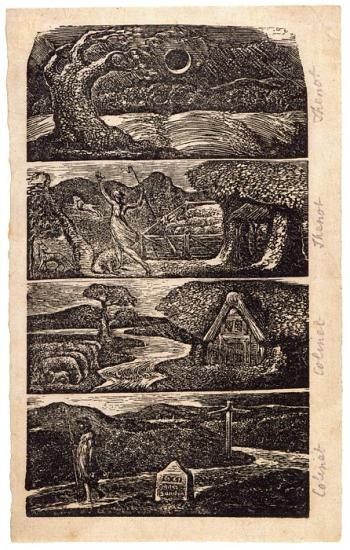
Four wood engravings printed from one block for The Pastorals of Virgil, adapted by Robert John Thornton.
London: J. McGowan for Rivington [and others], 1821.
Purchased by Pierpont Morgan in 1906
In about 1820 Blake designed seventeen small wood engravings for a textbook translation of Virgil. He engraved all but three of them himself as well as six copperplate images. A new medium for Blake, the small wood engravings were highly esteemed by the Ancients, especially Edward Calvert, several of whose small pastoral images appear in this case.
In 1825 John Linnell had purchased Blake's wood blocks (for 2 guineas) and had them printed by Calvert. Linnell and his family continued to publish them occasionally into the middle of the nineteenth century. The blocks were acquired by the British Museum in 1939.
William Blake (1757–1827) occupies a unique place in the history of Western art. His creativity included both the visual and literary arts. In his lifetime he was best known as an engraver; now he is also recognized for his innovative poetry, printmaking, and painting. Blake's keen perception of the political and social climate found expression throughout his work. His strong sense of independence is evident in the complex mythology that he constructed in response to the age of revolution.
Blake was already recognized as an engraver at age twenty-five, when his first volume of poems appeared. At thirty-three, in The Marriage of Heaven and Hell, he audaciously claimed that his birth had marked the origin of a "new heaven" in which his own art would exemplify the creativity prefigured by Milton and Michelangelo. By that time, Blake, in one of his most productive periods, had already produced Songs of Innocence and was at work on a series of illuminated books. In 1818 he met John Linnell, a young painter and engraver, through whom a group of young artists became Blake's followers. Calling themselves the Ancients, they helped perpetuate Blake's influence for generations.
The Morgan's Blake collection—one of this country's most distinguished—began with purchases as early as 1899 by Pierpont Morgan. During the tenure of Charles Ryskamp, director from 1969 to 1986, major gifts almost doubled the size of its Blake holdings. In recent years Ryskamp's own gifts of engravings, letters, and related materials have significantly enriched its scholarly resources.
This online exhibition is presented in conjunction with the exhibition William Blake's World: "A New Heaven Is Begun" on view September 11, 2009, through January 3, 2010.
This exhibition is made possible through the generosity of Fay and Geoffrey Elliott.
The Cyder Feast
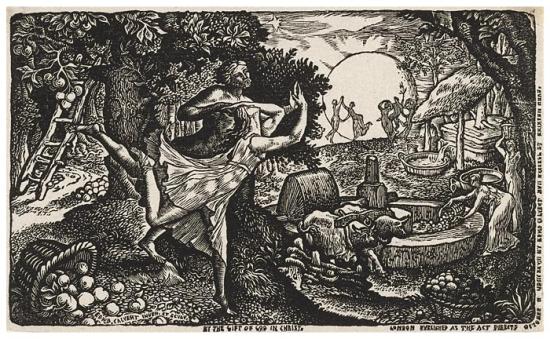
The Cyder Feast
Gift of Miss Louise Crane in memory of her mother, Mrs. W. Murray Crane
The oldest of the Ancients, Calvert, by age twenty-five, had been a sailor and enjoyed a wider experience of the world than the other young men of the group. But he shared their love of and respect for the simple life as well as the inspiration of Blake's work. These small prints were the result of his having printed Blake's wood engravings for Virgil at the behest of John Linnell.
William Blake (1757–1827) occupies a unique place in the history of Western art. His creativity included both the visual and literary arts. In his lifetime he was best known as an engraver; now he is also recognized for his innovative poetry, printmaking, and painting. Blake's keen perception of the political and social climate found expression throughout his work. His strong sense of independence is evident in the complex mythology that he constructed in response to the age of revolution.
Blake was already recognized as an engraver at age twenty-five, when his first volume of poems appeared. At thirty-three, in The Marriage of Heaven and Hell, he audaciously claimed that his birth had marked the origin of a "new heaven" in which his own art would exemplify the creativity prefigured by Milton and Michelangelo. By that time, Blake, in one of his most productive periods, had already produced Songs of Innocence and was at work on a series of illuminated books. In 1818 he met John Linnell, a young painter and engraver, through whom a group of young artists became Blake's followers. Calling themselves the Ancients, they helped perpetuate Blake's influence for generations.
The Morgan's Blake collection—one of this country's most distinguished—began with purchases as early as 1899 by Pierpont Morgan. During the tenure of Charles Ryskamp, director from 1969 to 1986, major gifts almost doubled the size of its Blake holdings. In recent years Ryskamp's own gifts of engravings, letters, and related materials have significantly enriched its scholarly resources.
This online exhibition is presented in conjunction with the exhibition William Blake's World: "A New Heaven Is Begun" on view September 11, 2009, through January 3, 2010.
This exhibition is made possible through the generosity of Fay and Geoffrey Elliott.
The Bride
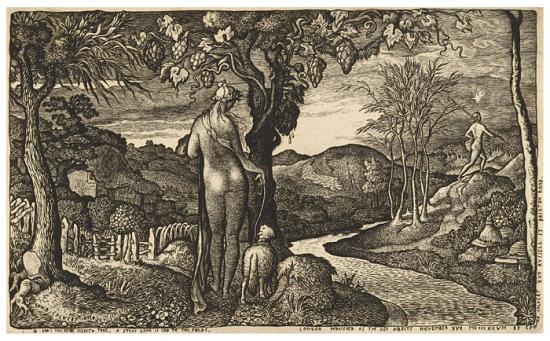
The Bride
Gift of Miss Louise Crane in memory of her mother, Mrs. W. Murray Crane
The oldest of the Ancients, Calvert, by age twenty-five, had been a sailor and enjoyed a wider experience of the world than the other young men of the group. But he shared their love of and respect for the simple life as well as the inspiration of Blake's work. These small prints were the result of his having printed Blake's wood engravings for Virgil at the behest of John Linnell.
William Blake (1757–1827) occupies a unique place in the history of Western art. His creativity included both the visual and literary arts. In his lifetime he was best known as an engraver; now he is also recognized for his innovative poetry, printmaking, and painting. Blake's keen perception of the political and social climate found expression throughout his work. His strong sense of independence is evident in the complex mythology that he constructed in response to the age of revolution.
Blake was already recognized as an engraver at age twenty-five, when his first volume of poems appeared. At thirty-three, in The Marriage of Heaven and Hell, he audaciously claimed that his birth had marked the origin of a "new heaven" in which his own art would exemplify the creativity prefigured by Milton and Michelangelo. By that time, Blake, in one of his most productive periods, had already produced Songs of Innocence and was at work on a series of illuminated books. In 1818 he met John Linnell, a young painter and engraver, through whom a group of young artists became Blake's followers. Calling themselves the Ancients, they helped perpetuate Blake's influence for generations.
The Morgan's Blake collection—one of this country's most distinguished—began with purchases as early as 1899 by Pierpont Morgan. During the tenure of Charles Ryskamp, director from 1969 to 1986, major gifts almost doubled the size of its Blake holdings. In recent years Ryskamp's own gifts of engravings, letters, and related materials have significantly enriched its scholarly resources.
This online exhibition is presented in conjunction with the exhibition William Blake's World: "A New Heaven Is Begun" on view September 11, 2009, through January 3, 2010.
This exhibition is made possible through the generosity of Fay and Geoffrey Elliott.
Ideal Pastoral Life
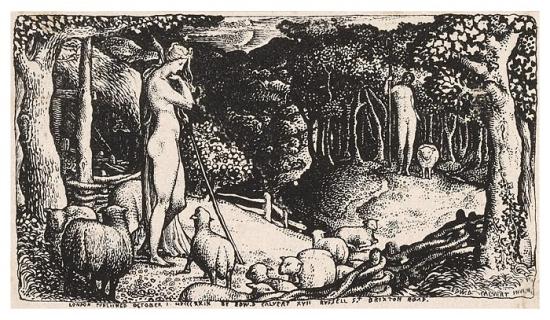
Ideal Pastoral Life
Gift of Miss Louise Crane in memory of her mother, Mrs. W. Murray Crane
The oldest of the Ancients, Calvert, by age twenty-five, had been a sailor and enjoyed a wider experience of the world than the other young men of the group. But he shared their love of and respect for the simple life as well as the inspiration of Blake's work. These small prints were the result of his having printed Blake's wood engravings for Virgil at the behest of John Linnell.
William Blake (1757–1827) occupies a unique place in the history of Western art. His creativity included both the visual and literary arts. In his lifetime he was best known as an engraver; now he is also recognized for his innovative poetry, printmaking, and painting. Blake's keen perception of the political and social climate found expression throughout his work. His strong sense of independence is evident in the complex mythology that he constructed in response to the age of revolution.
Blake was already recognized as an engraver at age twenty-five, when his first volume of poems appeared. At thirty-three, in The Marriage of Heaven and Hell, he audaciously claimed that his birth had marked the origin of a "new heaven" in which his own art would exemplify the creativity prefigured by Milton and Michelangelo. By that time, Blake, in one of his most productive periods, had already produced Songs of Innocence and was at work on a series of illuminated books. In 1818 he met John Linnell, a young painter and engraver, through whom a group of young artists became Blake's followers. Calling themselves the Ancients, they helped perpetuate Blake's influence for generations.
The Morgan's Blake collection—one of this country's most distinguished—began with purchases as early as 1899 by Pierpont Morgan. During the tenure of Charles Ryskamp, director from 1969 to 1986, major gifts almost doubled the size of its Blake holdings. In recent years Ryskamp's own gifts of engravings, letters, and related materials have significantly enriched its scholarly resources.
This online exhibition is presented in conjunction with the exhibition William Blake's World: "A New Heaven Is Begun" on view September 11, 2009, through January 3, 2010.
This exhibition is made possible through the generosity of Fay and Geoffrey Elliott.
Ballads
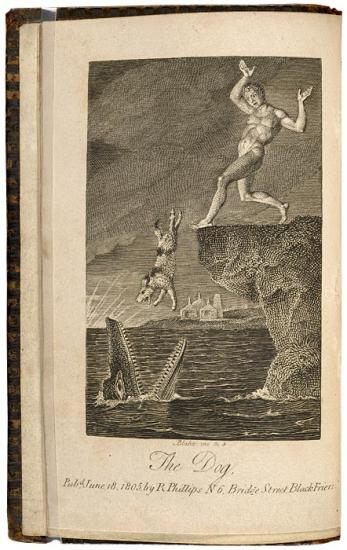
Ballads . . . Founded on Anecdotes Relating to Animals, with Prints, Designed and Engraved by William Blake.
Chichester: Printed by J. Seagrave for Richard Phillips, London, 1805.
Gift of Mrs. Landon K. Thorne, 1972
Blake designed and engraved five plates for this book, which Hayley seems to have invented as a make-work project for Blake. This copy is inscribed to Mr. Weller, a carver in Chichester. In the plate shown here, a faithful dog sacrifices himself to save his master from a crocodile. The drawing of the eagle is also for Hayley's Ballads.
William Blake (1757–1827) occupies a unique place in the history of Western art. His creativity included both the visual and literary arts. In his lifetime he was best known as an engraver; now he is also recognized for his innovative poetry, printmaking, and painting. Blake's keen perception of the political and social climate found expression throughout his work. His strong sense of independence is evident in the complex mythology that he constructed in response to the age of revolution.
Blake was already recognized as an engraver at age twenty-five, when his first volume of poems appeared. At thirty-three, in The Marriage of Heaven and Hell, he audaciously claimed that his birth had marked the origin of a "new heaven" in which his own art would exemplify the creativity prefigured by Milton and Michelangelo. By that time, Blake, in one of his most productive periods, had already produced Songs of Innocence and was at work on a series of illuminated books. In 1818 he met John Linnell, a young painter and engraver, through whom a group of young artists became Blake's followers. Calling themselves the Ancients, they helped perpetuate Blake's influence for generations.
The Morgan's Blake collection—one of this country's most distinguished—began with purchases as early as 1899 by Pierpont Morgan. During the tenure of Charles Ryskamp, director from 1969 to 1986, major gifts almost doubled the size of its Blake holdings. In recent years Ryskamp's own gifts of engravings, letters, and related materials have significantly enriched its scholarly resources.
This online exhibition is presented in conjunction with the exhibition William Blake's World: "A New Heaven Is Begun" on view September 11, 2009, through January 3, 2010.
This exhibition is made possible through the generosity of Fay and Geoffrey Elliott.
The Eagle
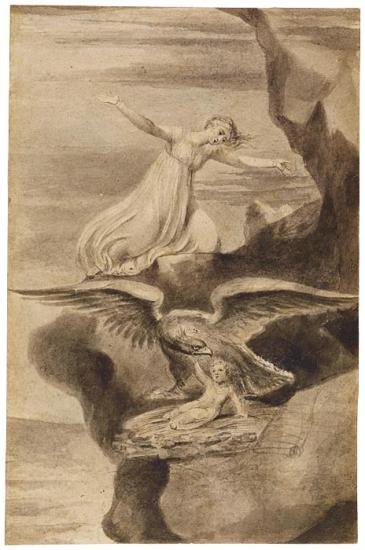
The Eagle
Gift of the Thorne Foundation in memory of Mrs. Landon K. Thorne
Blake designed and engraved five plates for this book, which Hayley seems to have invented as a make-work project for Blake. This copy is inscribed to Mr. Weller, a carver in Chichester. In the plate shown here, a faithful dog sacrifices himself to save his master from a crocodile. The drawing of the eagle is also for Hayley's Ballads.
William Blake (1757–1827) occupies a unique place in the history of Western art. His creativity included both the visual and literary arts. In his lifetime he was best known as an engraver; now he is also recognized for his innovative poetry, printmaking, and painting. Blake's keen perception of the political and social climate found expression throughout his work. His strong sense of independence is evident in the complex mythology that he constructed in response to the age of revolution.
Blake was already recognized as an engraver at age twenty-five, when his first volume of poems appeared. At thirty-three, in The Marriage of Heaven and Hell, he audaciously claimed that his birth had marked the origin of a "new heaven" in which his own art would exemplify the creativity prefigured by Milton and Michelangelo. By that time, Blake, in one of his most productive periods, had already produced Songs of Innocence and was at work on a series of illuminated books. In 1818 he met John Linnell, a young painter and engraver, through whom a group of young artists became Blake's followers. Calling themselves the Ancients, they helped perpetuate Blake's influence for generations.
The Morgan's Blake collection—one of this country's most distinguished—began with purchases as early as 1899 by Pierpont Morgan. During the tenure of Charles Ryskamp, director from 1969 to 1986, major gifts almost doubled the size of its Blake holdings. In recent years Ryskamp's own gifts of engravings, letters, and related materials have significantly enriched its scholarly resources.
This online exhibition is presented in conjunction with the exhibition William Blake's World: "A New Heaven Is Begun" on view September 11, 2009, through January 3, 2010.
This exhibition is made possible through the generosity of Fay and Geoffrey Elliott.
Autograph letter to William Hayley

Autograph letter, signed, dated 12 March 1804, to William Hayley.
Autograph letter, signed, dated 12 March 1804, to William Hayley
Hayley, a prominent poet and patron, offered the Blakes a cottage at Felpham on the southern coast of West Sussex. In this rural environment, so different from his urban London, Blake worked for three years, until autumn 1803. This letter, written from London in early 1804 to report that engravings for Hayley's biography of the visionary British poet William Cowper (1731–1800) were not quite ready to be delivered, contains Blake's description of his work. "Engraving is Eternal work; the two plates are almost finish'd. . . . I curse & bless Engraving alternately, because it takes so much time & is so untractable, tho' capable of such beauty & perfection."
The engravings under discussion appeared in Hayley's Life and Posthumous Writings of William Cowper, Esq., 1803–4.
William Blake (1757–1827) occupies a unique place in the history of Western art. His creativity included both the visual and literary arts. In his lifetime he was best known as an engraver; now he is also recognized for his innovative poetry, printmaking, and painting. Blake's keen perception of the political and social climate found expression throughout his work. His strong sense of independence is evident in the complex mythology that he constructed in response to the age of revolution.
Blake was already recognized as an engraver at age twenty-five, when his first volume of poems appeared. At thirty-three, in The Marriage of Heaven and Hell, he audaciously claimed that his birth had marked the origin of a "new heaven" in which his own art would exemplify the creativity prefigured by Milton and Michelangelo. By that time, Blake, in one of his most productive periods, had already produced Songs of Innocence and was at work on a series of illuminated books. In 1818 he met John Linnell, a young painter and engraver, through whom a group of young artists became Blake's followers. Calling themselves the Ancients, they helped perpetuate Blake's influence for generations.
The Morgan's Blake collection—one of this country's most distinguished—began with purchases as early as 1899 by Pierpont Morgan. During the tenure of Charles Ryskamp, director from 1969 to 1986, major gifts almost doubled the size of its Blake holdings. In recent years Ryskamp's own gifts of engravings, letters, and related materials have significantly enriched its scholarly resources.
This online exhibition is presented in conjunction with the exhibition William Blake's World: "A New Heaven Is Begun" on view September 11, 2009, through January 3, 2010.
This exhibition is made possible through the generosity of Fay and Geoffrey Elliott.
Autograph letter to Judith Madan
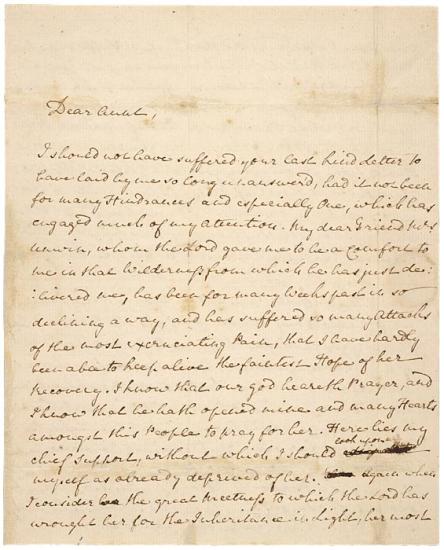
Autograph letter signed, dated 10 December 1767, to his aunt [Judith] Madan.
Gift of Charles Ryskamp in memory of Brooke Russell Astor, 2007
One of the major Hayley projects on which Blake worked was a biography of William Cowper. Subject to intense depression and occasional suicide attempts, Cowper was thought to be mad. His poetry depicts a humble life, in a style sometimes referred to as a "poetry of domesticity." A deeply religious man, he is also remembered for his hymns. This letter to his aunt contains the manuscript of one of his most famous, "Oh for a Closer Walk with God."
William Blake (1757–1827) occupies a unique place in the history of Western art. His creativity included both the visual and literary arts. In his lifetime he was best known as an engraver; now he is also recognized for his innovative poetry, printmaking, and painting. Blake's keen perception of the political and social climate found expression throughout his work. His strong sense of independence is evident in the complex mythology that he constructed in response to the age of revolution.
Blake was already recognized as an engraver at age twenty-five, when his first volume of poems appeared. At thirty-three, in The Marriage of Heaven and Hell, he audaciously claimed that his birth had marked the origin of a "new heaven" in which his own art would exemplify the creativity prefigured by Milton and Michelangelo. By that time, Blake, in one of his most productive periods, had already produced Songs of Innocence and was at work on a series of illuminated books. In 1818 he met John Linnell, a young painter and engraver, through whom a group of young artists became Blake's followers. Calling themselves the Ancients, they helped perpetuate Blake's influence for generations.
The Morgan's Blake collection—one of this country's most distinguished—began with purchases as early as 1899 by Pierpont Morgan. During the tenure of Charles Ryskamp, director from 1969 to 1986, major gifts almost doubled the size of its Blake holdings. In recent years Ryskamp's own gifts of engravings, letters, and related materials have significantly enriched its scholarly resources.
This online exhibition is presented in conjunction with the exhibition William Blake's World: "A New Heaven Is Begun" on view September 11, 2009, through January 3, 2010.
This exhibition is made possible through the generosity of Fay and Geoffrey Elliott.
Autograph letter to Judith Madan 2

Autograph letter signed, dated 10 December 1767, to his aunt [Judith] Madan.
Gift of Charles Ryskamp in memory of Brooke Russell Astor, 2007
One of the major Hayley projects on which Blake worked was a biography of William Cowper. Subject to intense depression and occasional suicide attempts, Cowper was thought to be mad. His poetry depicts a humble life, in a style sometimes referred to as a "poetry of domesticity." A deeply religious man, he is also remembered for his hymns. This letter to his aunt contains the manuscript of one of his most famous, "Oh for a Closer Walk with God."
William Blake (1757–1827) occupies a unique place in the history of Western art. His creativity included both the visual and literary arts. In his lifetime he was best known as an engraver; now he is also recognized for his innovative poetry, printmaking, and painting. Blake's keen perception of the political and social climate found expression throughout his work. His strong sense of independence is evident in the complex mythology that he constructed in response to the age of revolution.
Blake was already recognized as an engraver at age twenty-five, when his first volume of poems appeared. At thirty-three, in The Marriage of Heaven and Hell, he audaciously claimed that his birth had marked the origin of a "new heaven" in which his own art would exemplify the creativity prefigured by Milton and Michelangelo. By that time, Blake, in one of his most productive periods, had already produced Songs of Innocence and was at work on a series of illuminated books. In 1818 he met John Linnell, a young painter and engraver, through whom a group of young artists became Blake's followers. Calling themselves the Ancients, they helped perpetuate Blake's influence for generations.
The Morgan's Blake collection—one of this country's most distinguished—began with purchases as early as 1899 by Pierpont Morgan. During the tenure of Charles Ryskamp, director from 1969 to 1986, major gifts almost doubled the size of its Blake holdings. In recent years Ryskamp's own gifts of engravings, letters, and related materials have significantly enriched its scholarly resources.
This online exhibition is presented in conjunction with the exhibition William Blake's World: "A New Heaven Is Begun" on view September 11, 2009, through January 3, 2010.
This exhibition is made possible through the generosity of Fay and Geoffrey Elliott.
Autograph letter to Judith Madan 3
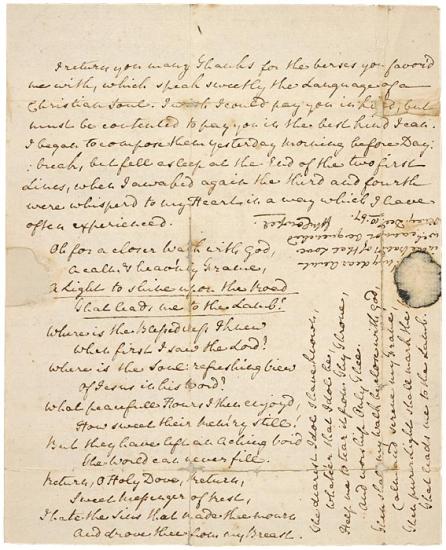
Autograph letter signed, dated 10 December 1767, to his aunt [Judith] Madan.
Gift of Charles Ryskamp in memory of Brooke Russell Astor, 2007
One of the major Hayley projects on which Blake worked was a biography of William Cowper. Subject to intense depression and occasional suicide attempts, Cowper was thought to be mad. His poetry depicts a humble life, in a style sometimes referred to as a "poetry of domesticity." A deeply religious man, he is also remembered for his hymns. This letter to his aunt contains the manuscript of one of his most famous, "Oh for a Closer Walk with God."
William Blake (1757–1827) occupies a unique place in the history of Western art. His creativity included both the visual and literary arts. In his lifetime he was best known as an engraver; now he is also recognized for his innovative poetry, printmaking, and painting. Blake's keen perception of the political and social climate found expression throughout his work. His strong sense of independence is evident in the complex mythology that he constructed in response to the age of revolution.
Blake was already recognized as an engraver at age twenty-five, when his first volume of poems appeared. At thirty-three, in The Marriage of Heaven and Hell, he audaciously claimed that his birth had marked the origin of a "new heaven" in which his own art would exemplify the creativity prefigured by Milton and Michelangelo. By that time, Blake, in one of his most productive periods, had already produced Songs of Innocence and was at work on a series of illuminated books. In 1818 he met John Linnell, a young painter and engraver, through whom a group of young artists became Blake's followers. Calling themselves the Ancients, they helped perpetuate Blake's influence for generations.
The Morgan's Blake collection—one of this country's most distinguished—began with purchases as early as 1899 by Pierpont Morgan. During the tenure of Charles Ryskamp, director from 1969 to 1986, major gifts almost doubled the size of its Blake holdings. In recent years Ryskamp's own gifts of engravings, letters, and related materials have significantly enriched its scholarly resources.
This online exhibition is presented in conjunction with the exhibition William Blake's World: "A New Heaven Is Begun" on view September 11, 2009, through January 3, 2010.
This exhibition is made possible through the generosity of Fay and Geoffrey Elliott.
Wat Tyler
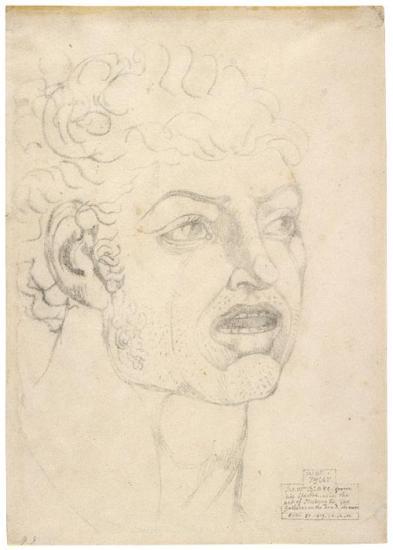
Wat Tyler
Inscribed (in the hand of John Varley) at lower right, Wat / Tyler / By Wm Blake from / his Spectre as in the act of Striking the Tax / Gatherer on the head. Drawn / Octr 30.1819 1h AM; numbered at lower left, 99.
Gift of Charles Ryskamp in memory of Michael S. Currier on the occasion of the 75th anniversary of the Morgan Library and the 50th anniversary of the Association of Fellows
Like Cowper, Blake was often considered mad because he spoke so naturally of the visions that he had experienced since childhood. Friends from later life described evenings during which they watched him drawing religious or historical figures whom he said were sitting before him. In 1819 he began to record these visions for John Varley (1778–1842). This is the last of a series of six documented during the month of October. Varley recorded the details on the drawings. The Morgan also owns a visionary head of Christ.
This sheet is Blake's portrait of the fourteenth-century rebel and leader of the revolt against the poll tax, Wat Tyler, who had been killed in 1381. Perhaps Blake felt a kinship based upon his own antimonarchical stance that had led to a trial for sedition in Felpham a few years earlier.
William Blake (1757–1827) occupies a unique place in the history of Western art. His creativity included both the visual and literary arts. In his lifetime he was best known as an engraver; now he is also recognized for his innovative poetry, printmaking, and painting. Blake's keen perception of the political and social climate found expression throughout his work. His strong sense of independence is evident in the complex mythology that he constructed in response to the age of revolution.
Blake was already recognized as an engraver at age twenty-five, when his first volume of poems appeared. At thirty-three, in The Marriage of Heaven and Hell, he audaciously claimed that his birth had marked the origin of a "new heaven" in which his own art would exemplify the creativity prefigured by Milton and Michelangelo. By that time, Blake, in one of his most productive periods, had already produced Songs of Innocence and was at work on a series of illuminated books. In 1818 he met John Linnell, a young painter and engraver, through whom a group of young artists became Blake's followers. Calling themselves the Ancients, they helped perpetuate Blake's influence for generations.
The Morgan's Blake collection—one of this country's most distinguished—began with purchases as early as 1899 by Pierpont Morgan. During the tenure of Charles Ryskamp, director from 1969 to 1986, major gifts almost doubled the size of its Blake holdings. In recent years Ryskamp's own gifts of engravings, letters, and related materials have significantly enriched its scholarly resources.
This online exhibition is presented in conjunction with the exhibition William Blake's World: "A New Heaven Is Begun" on view September 11, 2009, through January 3, 2010.
This exhibition is made possible through the generosity of Fay and Geoffrey Elliott.
Holland House, Kensington
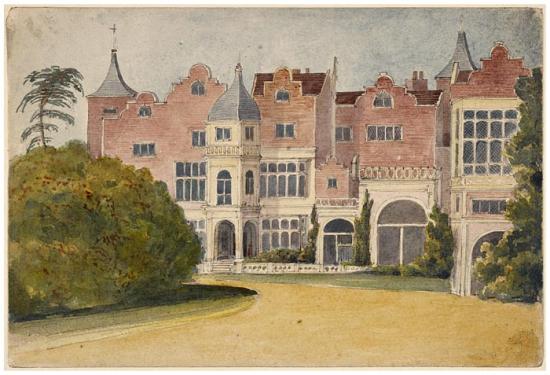
Holland House, Kensington
Gift of Charles Ryskamp
"The Little Card I will do as soon as Possible but when you Consider that I have been reduced to a Skeleton from which I am slowly recovering you will I hope have Patience with me."
–William Blake, April 1827
Blake and Cumberland's friendship dated from their youth at the Royal Academy. Cumberland became an amateur artist, reviewer, and writer on artistic subjects. His son, a student of John Linnell, was responsible for the important introduction of his teacher to Blake.
Holland House had been built about 1607 for Sir Walter Cope. By 1816 it was the home of Henry Richard Fox, third Baron Holland. It became the center of liberal political gatherings and intellectual and cultural activity, where aspiring artists and writers mingled with government and political figures. Cumberland used a rich tonal palette and dynamic contours to capture the building's elaborate horizontal facade.
Blake's plate for Cumberland's card was delivered by his widow.
William Blake (1757–1827) occupies a unique place in the history of Western art. His creativity included both the visual and literary arts. In his lifetime he was best known as an engraver; now he is also recognized for his innovative poetry, printmaking, and painting. Blake's keen perception of the political and social climate found expression throughout his work. His strong sense of independence is evident in the complex mythology that he constructed in response to the age of revolution.
Blake was already recognized as an engraver at age twenty-five, when his first volume of poems appeared. At thirty-three, in The Marriage of Heaven and Hell, he audaciously claimed that his birth had marked the origin of a "new heaven" in which his own art would exemplify the creativity prefigured by Milton and Michelangelo. By that time, Blake, in one of his most productive periods, had already produced Songs of Innocence and was at work on a series of illuminated books. In 1818 he met John Linnell, a young painter and engraver, through whom a group of young artists became Blake's followers. Calling themselves the Ancients, they helped perpetuate Blake's influence for generations.
The Morgan's Blake collection—one of this country's most distinguished—began with purchases as early as 1899 by Pierpont Morgan. During the tenure of Charles Ryskamp, director from 1969 to 1986, major gifts almost doubled the size of its Blake holdings. In recent years Ryskamp's own gifts of engravings, letters, and related materials have significantly enriched its scholarly resources.
This online exhibition is presented in conjunction with the exhibition William Blake's World: "A New Heaven Is Begun" on view September 11, 2009, through January 3, 2010.
This exhibition is made possible through the generosity of Fay and Geoffrey Elliott.
Mr. Cumberland's card
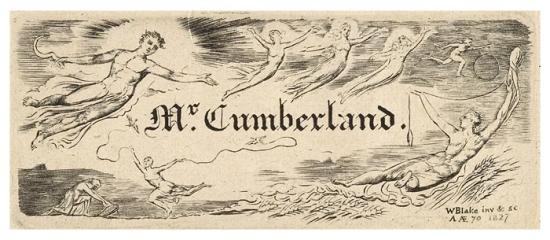
Mr. Cumberland's card
Purchased by Pierpont Morgan, 1906
"The Little Card I will do as soon as Possible but when you Consider that I have been reduced to a Skeleton from which I am slowly recovering you will I hope have Patience with me."
–William Blake, April 1827
Blake and Cumberland's friendship dated from their youth at the Royal Academy. Cumberland became an amateur artist, reviewer, and writer on artistic subjects. His son, a student of John Linnell, was responsible for the important introduction of his teacher to Blake.
Holland House had been built about 1607 for Sir Walter Cope. By 1816 it was the home of Henry Richard Fox, third Baron Holland. It became the center of liberal political gatherings and intellectual and cultural activity, where aspiring artists and writers mingled with government and political figures. Cumberland used a rich tonal palette and dynamic contours to capture the building's elaborate horizontal facade.
Blake's plate for Cumberland's card was delivered by his widow.
William Blake (1757–1827) occupies a unique place in the history of Western art. His creativity included both the visual and literary arts. In his lifetime he was best known as an engraver; now he is also recognized for his innovative poetry, printmaking, and painting. Blake's keen perception of the political and social climate found expression throughout his work. His strong sense of independence is evident in the complex mythology that he constructed in response to the age of revolution.
Blake was already recognized as an engraver at age twenty-five, when his first volume of poems appeared. At thirty-three, in The Marriage of Heaven and Hell, he audaciously claimed that his birth had marked the origin of a "new heaven" in which his own art would exemplify the creativity prefigured by Milton and Michelangelo. By that time, Blake, in one of his most productive periods, had already produced Songs of Innocence and was at work on a series of illuminated books. In 1818 he met John Linnell, a young painter and engraver, through whom a group of young artists became Blake's followers. Calling themselves the Ancients, they helped perpetuate Blake's influence for generations.
The Morgan's Blake collection—one of this country's most distinguished—began with purchases as early as 1899 by Pierpont Morgan. During the tenure of Charles Ryskamp, director from 1969 to 1986, major gifts almost doubled the size of its Blake holdings. In recent years Ryskamp's own gifts of engravings, letters, and related materials have significantly enriched its scholarly resources.
This online exhibition is presented in conjunction with the exhibition William Blake's World: "A New Heaven Is Begun" on view September 11, 2009, through January 3, 2010.
This exhibition is made possible through the generosity of Fay and Geoffrey Elliott.

